

Hello! I'm Tori.
Tori Pines Travels
creating action-packed and culture rich vacations
International , Italy · November 6, 2023
25 Best Towns & Cities in Northern Italy to Visit
Last Updated on March 26, 2024 by Tori Pines
Italy might be one of the highest tourist countries, for good reason, central Italy is the part that gets the most attention. But there are so many incredible towns and cities in Northern Italy worth exploring as well. Sure, you’ve heard of Milan and Venice, which will definitely be included here, but there are so many other fabulous destinations that you should include on your Italian itinerary as well!
Learn all about these beautiful destinations full of charm, history and of course delicious food. And find the spots that call your name to add to your next Italian getaway.
I have personally been to Northern Italy and enjoyed some of what it has to offer, but I wanted to give you even more options to explore. So, I’ve recruited travel bloggers who have personally visited each of these destinations to tell you all about their favorite towns and cities in Northern Italy. They explored the cobblestone streets and enjoyed the food. Met the locals and learned the history.
This post may contain affiliate links for activities, destinations and products that I love, and think you will too!

Map of the Towns & Cities in Northern Italy
Table of Contents
Val di funes.
- Cortina D'Ampezzo

Region of Liguria, Towns in Northern Italy
Recommended by Kim of Traveling Swansons
Manarola is one of the best cities to visit in Northern Italy. Nestled on Italy’s stunning Cinque Terre coast, this tiny village is the perfect blend of charming and breathtaking. With its vibrant buildings clinging to rugged cliffs and the crystal-clear Ligurian Sea below, you’ll have to pinch yourself to believe it’s real.
It’s very easy to get to Cinque Terre. If you’re coming from a larger city in Italy, hop on a train to La Spezia and then switch to the Cinque Terre line. It is not recommended to drive to Cinque Terre because the streets are narrow and there is nowhere to park.
Spring and early fall are the golden times to visit. The weather is just perfect, and you won’t be bumping elbows with as many tourists as you would in the summer.
Once you’re there, there’s no shortage of awesome things to do. Marvel at the ancient beauty of the Church of San Lorenzo. Take a walk through the terraced vineyards that are iconic to this region and enjoy a glass or two of the local Sciacchetrà wine. A boat tour of the five villages is also a must-do adventure to soak in the beauty of Cinque Terre.
And for the perfect end to your day, grab a seat at Nessun Dorma. This open-air restaurant sits high on a cliff, giving you the most stunning views of the village and the sea while you enjoy a drink and some light bites.
Where to Stay: Hotel Marina Piccola

Recommended by Chris of Around the World with Me
One of the most beautiful small towns in northern Italy is the old fishing village of Portofino on the Ligurian Riviera . In modern times, the sleepy little coastal fishing village has evolved into a getaway for Italy’s rich and famous. Seeing luxury yachts docked in the small bay is not uncommon.
For the average traveler, however, Portofino still offers plenty of affordable and exciting things to do. While wining and dining in Portofino is expensive, walking around the small village and along its historic promenade is totally free.
Portofino is located on the coast of Liguria, near Genoa, and the best way to get there is by car. There is no train to Portofino, so if you’re using public transportation, you’ll have to take the train to Santa Margherita Ligure and then take the bus to Portofino from there.
The best time of year to visit Portofino is April – October, with the exception of August, which, as everywhere else in Italy, is jam packed for the Italian summer holiday. The village is small and can easily be seen in half a day.
I recommend the following points of interest for your day in Portofino:
- Baia Cannone (small bay lined with massive villas that you can swim in)
- Castello Brown (a short hikes takes you to a little castle with an amazing view of the village)
- Cala Marconi promenade (a coastal promenade lined with restaurants and shops)
Where to Stay: Olives Bay Terrace in Portofino
Want more great travel articles? I have many more blog posts coming soon, so join my email list to ensure you never miss a post!

Recommended by Sarah of Life Part 2 and Beyond
Many tourists visiting Italy bypass Genoa and head straight to the more popular destinations along the Ligurian coast, like Cinque Terre and Portofino. But I’m telling you, Genoa is a great place to visit , and one of the best cities in northern Italy.
You can easily get there by train, bus, or plane, and it is a beautiful city with fewer tourists, so it feels so much more Italian and authentic.
To explore the city, I’d recommend either taking a walking tour to get your bearings and learn about the city’s history or simply just wander around the historic center, the largest in Europe.
You should visit the stunning cathedral and see its unusual interior. Take a peek at the simple home of Christopher Columbus (he was born in Genoa) and the fancy Palazzi de Rolli on Via Garibaldi, which were once homes for Genoa’s most affluent citizens.

For a fantastic view of the city and the harbor, take the Art Deco elevator up to Spianata Castelletto.
Be sure to also explore the old harbor, visit the fantastic aquarium and museums and ride the Bigo Panoramic Lift for another excellent harbor view.
If you have an extra day, I’d suggest going to the nearby colorful fishing village of Boccadasse or take a train to Nervi, a suburb of Genoa, where you can enjoy a stunning two-kilometer walk along the coast on Anita Garibaldi’s promenade.
Genoa is a beautiful city to explore any time of the year, but Spring and Autumn are my favorite months to visit as the weather is perfect for exploring.
Where to Stay: Hotel Astoria

Region of Piemonte, Towns in Northern Italy
Recommended by Carly of Fearless Female Travels
I spent several years living in Northern Italy, and my favorite town to visit for the day was always Rivoli . Located about twenty kilometers west of Turin, Rivoli is easy to reach from the busy city center but still retains its medieval, small-town charm.
You can get to Rivoli by bus from Turin’s city center (while you can take the metro halfway, it doesn’t save much time) or you can easily drive in less than half an hour. Once you arrive in Rivoli, park or get off the bus near the entrance to the historic center and then begin wandering up the hill, along the narrow pedestrian streets that lead to scenic views of the Italian Alps and, eventually, the Castello di Rivoli. Formerly one of the Savoy dynasty’s many palaces, today it is one of Europe’s best contemporary art museums.
You can visit Rivoli year-round, although the walk down from the castle can be a bit slippery in the snow. Regardless of season, I recommend visiting on a Wednesday, Thursday or Friday, as the museum is open and you’ll avoid the weekend crowds.
Where to Stay: Casa Piolti

Love to travel? Join my Facebook group to be a part of a small community of fellow travel lovers! Get inspiration for your next trip, ask and answer questions and make new friends who also love exploring the world!
Recommended by Zoe from Together In Switzerland
Cannobio is known for its beautiful waterfront promenade, lined with cafes and restaurants where one can enjoy local dishes, while enjoying breathtaking views of Lake Maggiore. It’s one of the best cities in northern Italy. The village’s cobblestone streets are a popular place to visit among tourists, but also has a strong homely vibe for locals.
It’s worth visiting on a sunny warm day so that you can walk around and explore best. You can get there easiest by car or a local bus, else you can arrive by boat (weather permitting) from many villages around the Lago Maggiore, such as Verbania in Italy or Ascona in Switzerland .
For things to do, there is a Sunday market where you can buy fresh fruits, vegetables, meats and cheeses. It’s also a great opportunity to buy something local such as a piece of clothing, leather bags and accessories. Otherwise you can join a local food and wine tasting tour!
For the adventurous types, hike up to Monte Giove at elevation 1298 meters or to the Orrido of Saint Anna scenic nature spot. Else to go swimming in the lake!
For those looking for Italian dishes, we recommend a table at Oggi Pasta . It’s a small, hidden restaurant down one of the streets, but super cozy, fast service with delicious pastas and pizzas.
Where to Stay: Hotel Pironi

Region of Valle D’Aosta, Towns in Northern Italy
Recommended by Merryl of Merryl’s Travel & Tricks
Nestled in the picturesque Aosta Valley of northern Italy, Courmayeur is among the prettiest towns in the region. This delightful destination is a haven for outdoor enthusiasts and lovers of mountain landscapes. The town can easily be reached from the city of Turin by both train and bus routes. While having a car provides flexibility, it’s not a necessity, as public transit, such as buses and cable cars, efficiently connects visitors to the town.
The best time to visit Courmayeur largely depends on your interests. Winter draws skiing and snowboarding enthusiasts, while the summer months reveal lush hiking trails, making it a year-round gem. When in Courmayeur, a visit to the famous Skyway Mont Blanc cable car is a must, offering breathtaking views of the Alps. Here, you can take a cable car from Italy into France and even spend a day visiting the charming French hamlet of Chamonix.
Additionally, explore the charming streets of the town, filled with quaint shops, cafes, and restaurants serving delectable Italian cuisine. Don’t forget to take in the stunning Mont Blanc massif, which provides a spectacular backdrop to this mountain paradise.
Where to Stay: Auberge de La Maison

Region of Lombardy, Towns in Northern Italy
Recommended by Taylor of Brown Eyed Flower Child
One of the most beautiful cities to visit in Northern Italy is Como. Located at the southern tip of Lake Como in the Lombardy region, which runs parallel to the majestic Swiss lake, Lugano, visiting the city of Como must be included in a Northern Italy and Switzerland itinerary !
Como is a thriving city with picturesque views from all around. It also has a Gothic cathedral, renowned restaurants, museums, a waterfront promenade, and luxury hotels. Because it offers a lot, it makes for a great base while you explore everything surrounding one of Northern Italy’s most beautiful lakes.
The best way to get to Como is by taking the train to Como San Giovanni station. You can easily get there from Milan. While in Como, it’s easiest to get around by walking. If you plan to explore other towns and villages around the lake, there is a ferry you can take.

Since you’ll want to spend a lot of time on the lake, visiting Como between late April and early October is best. Please note that the lake will still be too cold to swim in during the shoulder months, and you’ll need a jacket during the evenings.
One of the best things to do in Como is to book a private boat tour around the lake where you can explore the different villages like Bellagio and Varenna, along with celebrity homes like George Clooney’s Villa Oleandra, Richard Branson’s Villa La Cassinella, and Gianni Versace’s Villa Fontanelle. You must also take a cooking class in the city and ride the Como-Brunate funicular that overlooks the beautiful lake and surrounding mountains.
Where to Stay: Hilton Lake Como

Recommended by Kristin of Global Travel Escapades
If you’re craving a taste of Italian city life, a vibrant place to visit is Milan, the largest of the cities in northern Italy. Located in the Lombardy region, Milan is home to an efficient public transportation network that makes viewing all the sights and wonders easy! For example, the most famous landmark is the Duomo di Milano, which reveals stunning Gothic architecture. I remember seeing it for the first time and being speechless by the Duomo’s sheer size and beauty. Or, if you’re looking to do some luxury shopping, pass through the Galleria Vittorio Emanuele II, which offers all kinds of high-end designer stores! It was out of my budget, but the architecture is still worth admiring. When you’re ready to delve into the mouthwatering world of Italian dishes , take the metro to the Navigli district. This is the perfect spot for a leisurely dinner or to grab drinks with friends.
In terms of when to visit, August or September is ideal. This is when the weather is best, and the crowds start to die down. Those interested can fly into one of the three nearby airports or arrive via the regional train. Thus, if you’re looking to experience the magic of the fashion capital of Europe, then consider visiting Milan!
Where to Stay: AC Hotel Milano

Recommended by Kenny of Knycx Journeying
Lombardy is one of the most visited regions in Italy with a rich history, classical art, great food, and fashion. The capital city, Milan has a lot to offer with a number of charming small towns in its surroundings. Like Tirano, a small town in north Lombardy adjacent to the Alps bordering Switzerland – it’s considered a great destination for a day trip or a short getaway from Milan.
Tirano is about 166 kilometers away from Central Milan. It is home to many impressive attractions and outdoor experiences for worldwide tourists. To get there, the train ride takes about 3 hours. The train ride from Milan to Tirano itself is a scenic train journey because it runs along the famous Lake Como, a well-known resort area at the foothills of the Alps.

Tirano’s old town is very walkable. Take a half-day to check out the old architecture on the cobbled road and tranquil river, and a highlight would be the Catholic shine of the Madonna di Tirano.
Tirano is also famous for being the starting point of the popular scenic train Bernina Express, operating all year round and connecting with Chur in Switzerland.
If you are visiting in winter, Tirano is located close to a number of ski resorts in the Alps. Winter is also a wonderful time to kick start or complete the train journey from Switzerland because passengers will be witnessing how the train makes its way through the steep and rugged terrain, passing over 196 bridges and 55 tunnels in the snow.
Where to Stay: Ostello del Castello Tirano

Recommended by Jenny of TraveLynn Family
Sitting on the eastern shores of Lago Maggiore , Laveno is a picturesque town with a direct train from Milan for those traveling on public transport. Here the foothills of the Alps tower over the glistening lake and the scenery is breath-taking. One of the best cities in northern Italy.
To truly appreciate the views, ride the cable car up to Sasso del Ferro (altitude approx. 1,100 m) from Laveno in what looks like a big green bucket. The 10 minute journey isn’t for the faint hearted, as it’s quite steep in places. However, you can opt for a closed ‘bucket’ if you feel this will make for a less hairy ride. At the top there is a restaurant, café, and playground, as well as a footpath to lead you even higher up the mountain.
Back down in the town, meander along the lakeshore or dine in one of the characterful restaurants, before hopping on a ferry across the lake to visit other lakeside towns ; Intra is directly opposite, and the ferry runs every 30 minutes throughout the day.
The summer months are a time for swimming in the lake. Though if you visit in the Spring and Autumn, you can escape the crowds, there’s cooler weather for hiking, and mountain tops may have a sprinkling of snow, adding to those picture-perfect views. Come winter, Laveno is very quiet.
Where to Stay: Hotel del Conte

Recommended by Lauren of The Traveling Moore
My favorite area in Northern Italy is hands-down Lake Como. Specifically, the super cute and charming town of Bellagio. It’s easily one of the best cities in northern Italy to visit.
Bellagio is the most popular town on Lake Como and is nicknamed the “Pearl of the Lake.” It’s also the area that the famous Las Vegas resort was designed after.
To get to Lake Como, first take a train from Milan to Varenna, another lakeside town. From Varenna, take the lake ferry to Bellagio. The ferry runs every hour and only takes around 15 minutes.
The best time to visit Bellagio is from May-September. This is when the weather is warm enough for lake activities. In the winter, most of the restaurants and shops in town close.

Some of the best things to do in Bellagio are take a wooden boat tour of the lake, tour famous villas, or simply shop around town.
There are many wooden boat tours that start in Bellagio and visit popular areas of the lake for swimming and villa viewing. These tours are expensive but worth it to explore the lake.
There are also villas you can see directly in Bellagio, such as Villa Carlota. Finally, you can spend up to a full day exploring the charming cobblestone streets, stopping in local boutiques and luxury stores for some amazing shopping.
Where to Stay: Hotel Du Lac & SPA

Recommended by Helen of Helen on Her Holidays
Sirmione, on Lake Garda in northern Italy, is one of the most romantic and magical towns anywhere in Europe, let alone cities in northern Italy. The town sits on a narrow peninsula that juts out into the southern edge of the lake. The peninsula is actually an island, thanks to Sirmione’s 14th century Scaligero Castle which added a defensive moat right across the entrance to the town. We loved climbing the castle’s towers and walking the ramparts for stunning views across the town and Lake Garda.
The castle is just one of a range of things to do in Sirmione. The picturesque narrow streets of the old town are car-free and packed with interesting corners. You can bathe in hot springs at one of Sirmione’s thermal spas, or take a walk to the end of the peninsula where you can see the ruins of a luxurious Roman villa.
Sirmione is car-free; you can park your car at the beginning of the peninsula, but the best way to get to the town is by boat. You can catch ferry services from Desenzano (which has train connections to Milan and Verona) at the bottom of the lake; the approach by water is particularly beautiful, with the castle above the roofs of the old town. Any time of year is a great time to visit Sirmione, but ferries may be less frequent during the winter months; we visited at the end of September and it was perfect – not too hot but still with the summer ferry service.
Where to Stay: Hotel Eden

Recommended by Imee of Italy In Focus
Bergamo is located in the Lombardy region in the Northern part of Italy. This town is worth a visit, with its scenic beauty and stunning architecture and landmarks , which I found remarkable. Additionally, the delectable local and traditional dishes in Bergamo are delightful.
There are many ways to get to Bergamo; from the Milan- Bergamo airport, we took a bus, and it took us approximately 45 minutes to reach Bergamo. You can also take a car or a van, or you can also try to take a train, there are many options to reach the town depending on how you choose to travel.
When we visited Bergamo in September last year, I felt it was the perfect season to visit the town. I enjoyed the very pleasant weather and a very relaxing day exploring the surroundings with a few visitors.

Though it was just a short visit, we explored the upper city and visited Piazza Vecchia, where I was amazed by the stunning medieval and Renaissance architecture of the town. Perhaps this is one of the best things to do in Bergamo if you come and visit this lovely town.
Another fantastic thing to do in Bergamo is to experience and enjoy a funicular ride; the funicular provides amazing panoramic views of the city, and the surrounding landscape is also perfect for sightseeing.
These are just a few of the best things to do and must-see in Bergamo. And I must say, Bergamo is indeed an off-the-beaten-path cities in Northern Italy. It is an excellent destination to visit and create a memorable journey.
Where to Stay: Locanda Mimmo

Region of Trentino Alto Adige, Towns in Northern Italy
Recommended by Laura of Laura the Explorer
Nestled under the peaks of the Dolomites in the Sud-Tirol region, the Val di Funes (also known as Villnoss) is one of the most picturesque locations in all of Northern Italy.
It’s famous for its Sud-Tyrolean alpine culture, panoramic mountain views, and some of the best hiking in the Dolomites.
Located about an hour east of Bolzano, the Val di Funes is accessible by public transport (bus), however, it’s much easier to visit by car. It’s best to arrive early in the peak summer season to nab a parking spot.
The valley is best visited in the warmer months of June through November, where you see the highlights of this breathtaking location such as visiting the iconic Chiesetta di San Giovanni, taking in sunset over Santa Maddalena, and hiking one of my favourite trails in the Dolomites, the Adolf Munkel Trail to Geisleralm.
Be sure to take a break in your hike and try the unique Sud-Tyrolean cuisine at one of the charming mountain huts that dot the countryside. A mug of the local wheat beer and a slice of apple strudel will have you feeling like you’ve been transported to Germany or Austria!
Where to Stay: Viel Nois Guest House

Recommended by Joanna of The World in My Pocket
Trento is one of those hidden gem towns in the North of Italy. Trento is the capital of the Trentino region , and it is worth visiting for its medieval city center with beautiful painted palaces, the frescoes in the Buonconsiglio Castle, the delicious Italian-German fusion food, the local wine, as well as the breathtaking mountain backdrop.
I visited Trento in June, a few years ago, and spent a week here. The weather was beautiful, warm, with plenty of sunny days. I arrived here with a Flixbus from Verona. However, Trento is very well connected by public transport to many major cities in Italy. The nearest big airports are in Venice, Treviso, and Bergamo.
One great thing to do in Trento is take the cable car up to the peak across the river, and have an Aperol spritz with a view of the town and the beautiful mountain scenery behind it.
Another great thing to do in Trento is to take a walking tour to discover all the palaces with their painted facades, as well as some of their interior courtyards.
Trento is located near Valle dei Laghi , where the native Nosiola grape grows. This grape is used to make DOC Trento wines and the traditional Vino Santo, which is considered to be one of the best sweet wines in Italy. You can go wine tasting at many of the vineyards in Valle dei Laghi.
Where to Stay: Torrione Trento

Recommended by Lavina of Continent Hop
Cembra is a gorgeous town located in the Cembra Valley. It is in the Trentino region of Italy. It has breathtaking natural beauty, rich traditions, and flavorful local wines. This is the perfect destination if you are looking for an authentic Italian vacation , and one of the best cities in northern Italy.
Cembra lies 20 kilometers northwest of Trento and it is easily accessible. A 12 days Italy itinerary will help you explore Cembra and the rest of Italy.
Traveling by car allows you to explore at your own speed. However, you can also use public transport, such as buses and trains, to travel from Trento to Cembra.
Cembra is most enjoyable in the spring and summer, from April to September. The weather during these months is mild and perfect for outdoor activities and experiencing the local culture and festivities.
Cembra is known for its wine and wine-making, particularly adored for the Müller-Thurgau and Schiava wines. You can indulge in wine tasting and take tours of the local wineries to savor the unique flavors of the region.
Cembra boasts an exhilarating landscape which includes rolling hills, gorgeous vineyards, and the glorious Lagorai mountain range. You can take leisurely walks to explore this scenery. You can also partake in some adventure such as hiking or mountain biking.
Cembra has beautiful antique buildings, historical churches, and traditional festivals. Explore the town’s attractions like the Parish Church of San Giovanni Battista and the Cembra Castle. Attend local festivals to get a glimpse of the town’s vibrant culture and local life.
Where to Stay: Agriturismo Maso Besleri

Region of Friuli Venezia Giulia, Towns in Northern Italy
Recommended by Rich of RJ on Tour
Trieste is a beautiful city on the Adriatic coast of Italy, and I really enjoyed visiting. The city is pretty easy to reach by train with direct trains from Ljubljana and Venice. Once in the city it’s all pretty walkable, however they have an excellent bus system.
There are many options for things to do in Trieste. The central areas are beautiful, with a combination of Italian and Austrian architecture, making it quite unique. The grand canal in the city is a beautiful place to explore, which is lined with palaces and churches.

Overlooking the city is a castle, Castello di San Giusto, which is a fantastic viewpoint. The highlight of the castle visit was the Roman artifacts, including mosaics. Other things to see, including a small amphitheater and Trieste Cathedral, a unique place inside.
We enjoyed our summer visit and since it’s located by the coast it was wonderful. Sitting on the pier during a summer sunset was special. There are many restaurants serving both Italian and Austrian cuisine, most of which have outside tables with a view. Overall, Trieste is unique compared to other places I visited while in Italy.
Where to Stay: Elisabeth Boutique Rooms

Region of Veneto, Towns in Northern Italy
Recommended by Me!
A small island in the Venetian Lagoon, Burano is most well known for being the brightly colored island off of Venice. Each home is painted a different bright color, making for a rainbow along the canals. It’s beauty alone makes it one of the best cities in northern Italy to visit.
The city was once known for their lacemaking, and was one of the primary sources of income for the people there. Lace is still made on the island, and you can visit the lace factory to see the women making the lace and to learn more about the history.
However, today the main source of revenue for the island is tourism. And for good reason, the island is stunning and honestly the best place to visit in the entire Venetian Lagoon (in my opinion). It is fun to just wander the canals and enjoy the beauty of the island. Shop in the little stores for lace, and eat some incredible seafood at a restaurant right on the canal. We absolutely loved spending the day in Burano. I mean how can you not fall in love with this place?!
Where to Stay: Tiffany Home

Recommended by Stephanie of The Unknown Enthusiast
Venice is a city that tops many people’s bucket list, and for good reason – Venice is ridiculously charming and is definitely worth visiting . With over 150 canals that crisscross the city, you’ll constantly be crossing bridges and admiring the scenic, narrow waterways. And of course, there’s the Grand Canal, the main, large waterway that winds through the middle of the city, and is full of gondolas and gorgeous buildings featuring Venetian architecture .
Besides wandering the passageways and bridges of the city, there are really quite a lot of things to see and do in Venice. San Marco Square has the San Marco Basilica, the Doge’s Palace (the doge was the ruler of the city when Venice was at the height of power), and the St Mark’s Bell Tower. You should definitely stop by the Teatro La Fenice, one of the most important opera houses in Italy, and of course, take a gondola ride on the canals.
Venice is located on the coast of northeastern Italy, along the Adriatic Sea. You can easily arrive via the international airport, or by train. Driving is not recommended – you would have to park your car on the mainland before taking a water taxi or bus into Venice. Once you’re in Venice, the only transportation options are water taxis or water buses.
Spring and early fall are the best time to visit – crowds are a little bit lower and the weather isn’t too hot. In summer, crowds are very high, and in winter there is a chance of flooding in the city.
Where to Stay: Hotel Olimpia Venice

Cortina D’Ampezzo
Recommended by Taylor of No Trace Travel
Cortina D’Ampezzo, located in the heart of the Dolomites is a haven for outdoor adventurists year round. You can easily reach this alpine town by bus from nearby major cities, like Venice or Milan. Once there, the town is easily walkable, giving you a chance to window shop the luxury boutiques and take in the mountains surrounding the area. While you don’t need a car to get there and around the town center, you certainly will want one to freely explore the mountainous landscape at your own pace.
The best time to visit is during the summer months of June to September, providing comfortable weather to hike nearby trails such as Cinque Torri or the famous Cadini Group. However, if you can brave the cold weather then this town turns into a winter wonderland! Explore Cortina D’Ampezzo in winter to experience the most scenic ski slopes in Europe on the world-class Sella Ronda.
The town is gearing up for its second round of hosting the Winter Olympics in 2026, so mark your calendars and plan ahead to be there for all the action!
Where to Stay: HOTEL de LEN

Recommended by Claudia of My Adventures Across The World
Treviso is a medium-sized city in the region of Veneto, in northern Italy, and a unique place to visit on a day trip from Venice . Located just about 40 km and an easy train ride under 40 minutes, Treviso will give you a completely different feel compared to Venice. Still unknown to mass tourism, Treviso has very much remained true to its local spirit .
Make sure to go for a walk around the historic center of town, where you can spot the walls and ramparts that were built to defend the city when it joined the Republic of Venice at the turn of the 13th century. It’s also fun to spot the many canals.
A favorite thing to do in Treviso is actually eating! There is a large fishing market which means fish and seafood are always on the menu. Stop for an aperitif before heading back to Venice and try fried calamari – best if accompanied by a glass of Prosecco wine, which is produced in this very region.
The best time to visit Treviso is in the spring. Summer can be terribly hot and humid here, whereas it can be regularly cloudy and foggy in the winter.
Where to Stay: B&B Villa Romano

Recommended by Adrienn of Travel Tip Zone
Verona is an excellent Northern Italian destination that offers travelers captivating experiences. This Northern Italian city is known for its rich historical tradition and vibrant cultural life, making it a must for anyone interested in history and culture.
Verona is easily accessible whether you’re traveling by car or public transportation. Regardless of the direction you’re coming from, Verona is well-connected by an excellent network of highways to cities like Milan, Venice, Bologna, and South Tyrol. Moreover, there are train and bus options available from other major Italian cities to reach Verona.
Like most Northern Italian cities, Verona has cold winters and hot summers. For this reason, it is most recommended to visit in the spring and fall when the temperatures are pleasant for sightseeing.
Verona’s most popular attractions include the well-preserved Roman Arena, Juliet’s House with its famous balcony, the bustling Piazza delle Erbe, and the stunning Castelvecchio. For the best views, visit Castel San Pietro or take a walk along the banks of the Adige River.
Verona is famous for its delicious cuisine. Try traditional dishes such as risotto al Amarone and enjoy local wines at cozy trattorias and osterias.
Beyond Verona, you’ll find picturesque landscapes, including the nearby Lake Garda, which offers wonderful views and the opportunity for swimming and water sports.
Overall, Verona, as an attractive city in Northern Italy, is an excellent travel destination. With its rich historical heritage and pleasant surroundings, this charming city has something to offer for everyone.
Where to Stay: Hotel Giulietta e Romeo

Recommended by Milene & Paul of Surf & Unwind
Explore the hidden gem of Vicenza, a charming town nestled perfectly between Verona and Venice. One of the best cities in northern Italy to visit.
Just a short train journey away, Vicenza offers an authentic Italian experience without the bustling crowds and hefty price tags of its popular neighbors.
Vicenza might not have Verona’s medieval allure and Venice’s intricate canal systems, but it boasts architectural beauty.
The town is home to twenty-three UNESCO Heritage buildings such as Teatro Olimpico, Pallazzo Chiericati and Basilica Palladiana, and it’s renowned for the Palladian Villas of the Veneto, designed by the celebrated Renaissance architect Andrea Palladio.
On summer evenings, there’s nothing better than to enjoy a delicious fresco meal at Piazza dei Signori (we recommend the pizza at Angolo Palladio) followed by an Aperol Spritz at Una Spiaggia per Vicenza, an urban beach bar with a vibrant atmosphere.
To end the night with a breathtaking panoramic view of the city, head to Monte Berico where you can see Vicenza aglow under the starlit sky.
With its rich history, exquisite architecture, and delightful culinary scene, Vicenza offers a wonderful escape, waiting to be discovered.
Where to Stay: Relais Santa Corona

Region of Emilio Romano, Towns in Northern Italy
Recommended by Francesca of Little Lost Travel
Modena is a city in the Emilia-Romagna region of Northern Italy. It’s famous for being the home of traditional balsamic vinegar and the opera singer Luciano Pavarotti.
The city is also regarded as the world’s ‘Supercar Capital’ as some of the biggest luxury Italian car brands such as Lamborghini, Ferrari and Maserati are right on its doorstep.
One of the first things I recommend doing is checking out the UNESCO World Heritage Torre Civica and Piazza Grande. The 12th-century cathedral and bell tower are an incredible example of early Romanesque art and a real feast for the eyes.
Afterwards, get a (quite literal) taste of history by sampling traditional balsamic vinegar at La Consorteria 1966. Tastings are about €15 per person. You’ll learn about the vinegar’s Protected Design of Origin status and why it takes a minimum of 12 years to mature.
If you’re a car lover, make sure you also visit the Enzo Ferrari Museum with its collection of iconic Ferrari supercar models and the story behind the man who made them.
My favorite time of year to visit Modena is September as the peak season crowds start to die down but the weather is still a pleasant 25 degrees Celsius. I would still recommend bringing a jacket as evenings get cool.
Modena is well connected by public transport links so you don’t need to drive. There’s a bus network to get around the area and a train station which links other major cities.
Where to Stay: Hotel Castello

Recommended by Martha of May Cause Wanderlust
There are two main (and persuasive) reasons to visit Bologna, a city in northern Italy.
The first is that its location in the heart of the Emilia Romagna region means it’s a foodie’s paradise . All the world-class produce from the region can be found here: Prosciutto di Parma, Parmigiana Reggiano and Aceto Balsamico de Moderna. And it has its own traditional pasta dish. Not Spaghetti Bolognese, as many would assume (although you will be able to find a version of this, made with tagliatelle, on restaurant menus); the dish of Bologna is actually tortellini in broth.
Lots of the things to do in Bologna involve food! Top of the list is to take a food tour to learn about the food traditions, to discover the best markets and restaurants and, of course, to taste some delicious delicacies.
The second reason to visit Bologna is its sumptuous architecture. This medieval university city is known for the red-orange palette of its buildings and for its attractive porticoes, which are arched covered walkways.
There are 40 km of porticoes in the center of Bologna and they are an UNESCO World Heritage site. It’s almost a rite of passage to walk the Portico of San Luca, which goes from the city center out to a church in the surrounding hills. It’s hard work, though!
Bologna is well-connected by its airport and train station and there’s no need to hire a car to explore the city itself. It’s also a great stop on your way south for some time in Rome ! Come in the shoulder season to avoid the heat (especially if you plan to walk the uphill San Luca Portico!).
Where to Stay: Savhotel

Get on the List
You’ll also love.

Local’s Guide: 23 Best Restaurants in Downtown St. Pete, FL
Trending now.

Become an Insider
Join my mailing list for notifications about new posts, exclusive content & giveaways.
I'm Tori, a dreamer with a cup that is always half full. I believe in having the best vacations possible, and I'm here to help. Check back each week for travel tips and inspiration.
Work With Me
- Privacy Policy
- Get in Touch
Shop My Favorites
- In My Suitcase
- Expedia Partner
- My Recommended Travel Companies
Destinations
Travel tips.
- Travel Journal
- Culture & History
- Travel Guides
Copyright © 2024 Tori Pines Travels · Theme by 17th Avenue
Privacy Overview

Home » Travel Guides » Italy » 15 Best Places to Visit in North Italy
15 Best Places to Visit in North Italy
The northern region of Italy is known locally as Il Nord or Settentrione and consists of eight separate regions – Peidmont, Liguria, Aosta Valley, Veneto, Emilia-Romagna, Lombardy, Friuli-Venezia Giulia and Trentino-Alto. In terms of population, this region of Italy has an estimated population of at least 27.2 million inhabitants. Northern Italy has a diverse geography due to its two coastal regions, and the mountainous region of the Alps and Apennines. Parts of the region are packed full with dramatic mountain landscapes, whilst other areas particularly on the eastern coast are flat on entering the Adriatic Sea. This part of Italy is actually the most economically productive and has a host of important manufacturing regions that help give it one of the highest GDPs per capita in Europe.
For the budding tourist, this region of Italy is simply bursting with historical cities waiting to be explored. In the far north, you can explore the Alps, try your hand at skiing and visit some of the quaint mountainside towns. On the east coast you can visit the enchanting island city of Venice or the historical port of Trieste. Furthermore in the central regions of Northern Italy you have several magnificent and immense cities such as Milan, Turin and Bologna that have a myriad of interesting sites and attractions. Due to the regions varied landscape, rich history and plethora of fine cities, there is something for everyone’s tastes.
Let’s have a look at the best places to visit in Northern Italy :
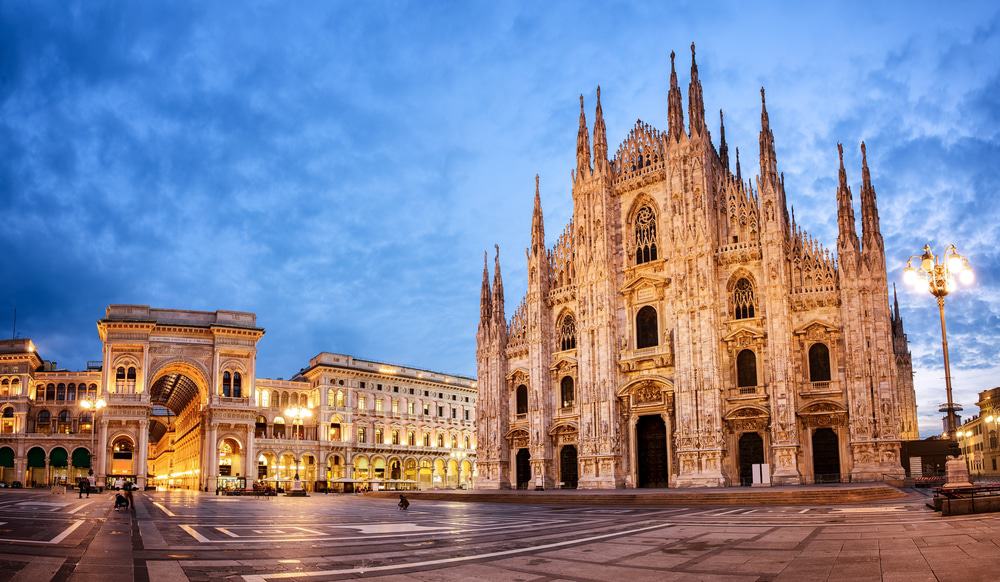
Milan is one of the largest cities in Italy and is renowned for its culture, history, economy and also its plethora of high-end designer shopping outlets.
This vast metropolis boasts some absolutely sublime architecture and a myriad of historical buildings that have played an important role in the shaping of Italy.
Notable sites include the unbelievable gothic Duomo with its intricate façade and gorgeous stained glass windows, the epic Sforzesco castle with its huge grounds and gardens, the infinitely interesting Da Vinci Museum of Science and Technology, and the opulent Galleria Vittorio Emanuele II. This city has something for everyone – from shopping to sight-seeing and museums.

Venice is dubbed as one of the most romantic cities in the world and it is easy to see why when you walk through its many narrow cobbled streets and canals.
Located in the Venetian lagoon, Venice is an island city that is formed from hundreds of individual islands all joined together by a network of canals and bridges.
The central Grand Canal is a magnificent site and the buildings that line it look simply beautiful.
Furthermore, St. Mark’s Square is an absolute must see with the opulent cathedral, the immense bell tower and the flocks of pigeons.
Alternatively, if you want to relax and soak up the sun you can travel via water taxi to the Venice Lido and enjoy the long stretch of golden beach.
Don’t forget to visit the Rialto Bridge, the Bridge of Sighs and Doges Palace too!

Although an economic powerhouse and one of the main industrial centres in Italy, Turin still retains much of its history and charm and has an amazing amount of sites and attractions.
Located in the western part of Northern Italy, Turin was once the capital of the country and has always been an important cultural and economic stronghold.
Today you can see some amazing sites such as the decadent Palazzo Reale and Palazzo Madama, the gigantic and domineering Mole Antonelliana and the Cathedral of San Giovanni Battista.
Additionally ensure to take a trip to the fascinating Turin Egyptian museum and see the face of Jesus in the fabled Turin Shroud.

Bologna is one of the largest cities in Italy and is the capital of the Emilia-Romagna region.
This city has a strong economic presence in the manufacturing and financial industries and is also a major transport hub.
In terms of tourism, Bologna is known as the city of towers due to its plethora of historical high-rise structures.
The leaning towers of Bologna and Torre Prendiparte for example are fascinating and beautiful structures that dominate the skyline of the city.
Aside from the towers, Bologna also has some amazing Piazzas and religious buildings such as Piazza Maggiore and the Cathedral of San Petronio.
Finally, for those who enjoy the arts and culture, Bologna has a selection of fine museums and galleries such as the Archaeological Museum and the National Gallery.

Genoa is a magnificent city located on the southern coast of Northern Italy on the Ligurian Sea.
As the 6th largest city in the country, and as a major port, Genoa has major significance for the economy of the country and has always played a prominent role in the history of Italy.
The city walls of Genoa were once expansive and the Porta Soprana is one of the remaining gates from this once impenetrable fortress.
In the city centre you can admire some fine architecture in public spaces such as the Piazza Ferrari and the Piazza Matteotti.
Moreover the Aquarium and Maritime Museum are fantastic for those who want to learn about marine life and the history of Genoas port.
Don’t forget to walk around the immense port and see the hectic hustle and bustle of commercial shipping activitiy!

This northern city is located in-between Bologna and Milan and is renowned for its beautiful Prosciutto Ham and cheese varieties.
Due to the cities long history and involvement with various factions and wars throughout the years it has a range of impressive structures, beautiful Piazzas and intriguing museums.
Parma Cathedral is considered one of the finest Romanesque structures in Italy and the adjoining Baptistery is just as opulent.
This city also has several fantastic theatres such as the Teatro Farnese and the Teatro Regio that offer the perfect venue to see a show.
Also consider visiting the national gallery that contains an immense collection from individuals including Da Vinci and Van Dyck.

Verona is often overshadowed by other major Italian cities but it has one of the finest historical centres in the country and some absolutely stunning sites.
The main site of Verona is undoubtedly the Arena – this huge structure rivals the Colosseum of Rome and is just as spectacular.
Furthermore the Castle Vecchio and the connecting Ponte Vecchio are amazing structures to visit and provide a look at the history of Verona.
This city also features some impressive religious structures such as Verona Cathedral and the Basilica of San Zeno Maggiore, but also a myriad of gorgeous Piazzas such as the Piazza Delle Erbe and the Piazza Bra.
Finally, Verona lies in close proximity to Lake Garda which is a brilliant region to explore.
8. Lake Garda

Lake Garda is the largest lake in Italy and is a hugely popular destination for both locals and tourists.
The landscapes and scenery surrounding Lake Garda are simply jaw dropping – the combination of forest covered mountains and small terracotta roofed villages create an idyllic setting.
Towns such as Sirmione and Bardolino provide perfect venues to explore the lake from and offer a myriad of sites and high quality eateries.
Consider taking a boat trip on this immense lake and travelling between some of the gorgeous lakeside villages whilst taking in the sublime scenery.

Trieste can be found in the eastern part of Northern Italy on the coast of the Gulf f Trieste – this city lies in close proximity to Slovenia and the border can be reached in under 20 minutes.
Due to its close proximity to Slovenia, Trieste actually has a different feel and culture to the rest of Italy and has been influence greatly by its close ties to its neighbouring country.
The harbour of Trieste is a fantastic place to explore and the connecting Canale Grande has some beautiful surrounding architecture.
This city also features a series of castles, Roman ruins and opulent religious structures.
When exploring the Harbor, don’t forget to take a stroll down the Molo Audace which is a 300m long promenade that juts out into the sea.
10. Alessandria

Alessandria can be found in the Piedmont region of Northern Italy and is a fantastic place to visit despite its smaller size.
With great transport links to Milan, Turin and Genoa the city serves as a transport hub and is easily accessible.
The impressive Cittadella di Alessandria sits proudly on the banks of the River Tanaro and can be reached by crossing the modern Ponte Meier footbridge.
If you like military history and displays, the Museo delle Divise Militari provides a fantastic insight into the operations of the Italian Military.
Alternatively, if you enjoy walking and architecture, the Piazza Garibaldi and the Piazza della Liberta are great places to explore in the centre of the town.
11. Brescia

Only a stone’s throw from Lake Garda and Verona, Brescia is a beautiful city in the heart of Lombardy.
This city is one of the main industrial regions of the country and contributes a great deal to the GDP of Italy.
Brescia combines fantastic historical sites together with some gorgeous areas of natural beauty to create a city that everyone can enjoy.
In terms of architecture, Brescia boasts the ancient Roman Tempio Capitolino, the impressive Duomo Nuovo, and the historic Broletto.
Furthermore, in terms of natural sites, Brescia is located in close proximity to Lake Iseo which contains the beautiful Monte Isola, and also only a short distance away is the magnificent Mount Maddalena.
Brescia is also ideally located to venture to Lake Garda and the neighbouring city of Verona.
12. Ferrara

Ferrara has a favourable location between Bologna in the south and Venice in the north.
This city offers the perfect base to explore the eastern side of Northern Italy and also contains some beautiful structures and historical sites.
The main site of Ferrara is the Estense Castle – this gorgeous wooden castle sits on its own lake and has become a symbol of the city.
Also found within the city centre is the interesting Archaeological museum, the Palazzo dei Diamanti and the Cathedral of Saint George.
Finally, Ferrara was once a medieval city and had a complete defensive network – today you can see sections of the city walls and admire their design.

Located within the greater metropolitan area of Milan, Monza is a fantastic tourist destination in its own right and has some amazing sites.
If you are located in Milan and want a day trip, Monza offers the perfect location.
Possibly the best known attraction of Monza is the historic Formula One Racing Track and the immense Parco di Monza.
The park covers a vast area and as some beautiful villas, gardens and wooded areas – you could spend hours walking through its many trails.
Inside the park, the Autodromo is also a great place to visit and if you are lucky enough, watching a Formula One race here is a true treat.
Aside from the park, Monza also features the opulent Duomo di Monza and the gorgeous Ponte dei Leoni.

Como and the lake of the same name is considered to be one of the most beautiful areas in Italy and is known for its jaw-dropping mountainous landscapes.
Como itself features some grand architecture such as the 14th century Cathedral and the Basilica di Sant’Abbondio.
If you want to see some epic mountain landscapes then take the Brunate funicular to look down onto the expanse of the majestic lake.
When you have seen all the city has to offer, take to the waters of Lake Como and enjoy a sublime boat ride or visit one of the lakeside towns such as Bellagio, Lierna and Dervio – these towns offer some amazing views across the lake and the chance to relax in a fine restaurant or café.

Udine is located in the eastern part of Italy near the Slovenian border.
This city has been influenced greatly by other cultures crossing the Italian border and has an extensive history.
The castle of Udine is a mighty structure created in the 16th century and sits as a major landmark in the historic town centre.
Other interesting structures of note include the Loggia del Lionello, the Cathedral of Udine and the Chiesa di San Giacomo.
Aside from the architecture, Udine has several important museums, a selection of beautiful public parks, and several gorgeous Piazzas.
15 Best Places to Visit in North Italy:
- Alessandria

Touropia Travel Experts
Discover the World
10 Top Destinations in Northern Italy

From Alpine mountains and glacial lakes to the sunny shorelines of the Riviera and Adriatic, the geographical diversity of Northern Italy is its most striking characteristic. Nestled within the cities and landscapes of the region are a host of culinary pleasures and cultural treasures as well, including Leonardo de Vinci’s masterpiece, “The Last Supper.”
Encompassing Italy’s wealthiest provinces, Northern Italy is a premier destination when it comes to luxury resorts and upscale shopping too. Whether sampling fine wine and dining on world-class cuisine or exploring ancient castles, cathedrals and churches, the region offers all the memorable travel experiences visitors want from a holiday in Italy.
Map of Northern Italy
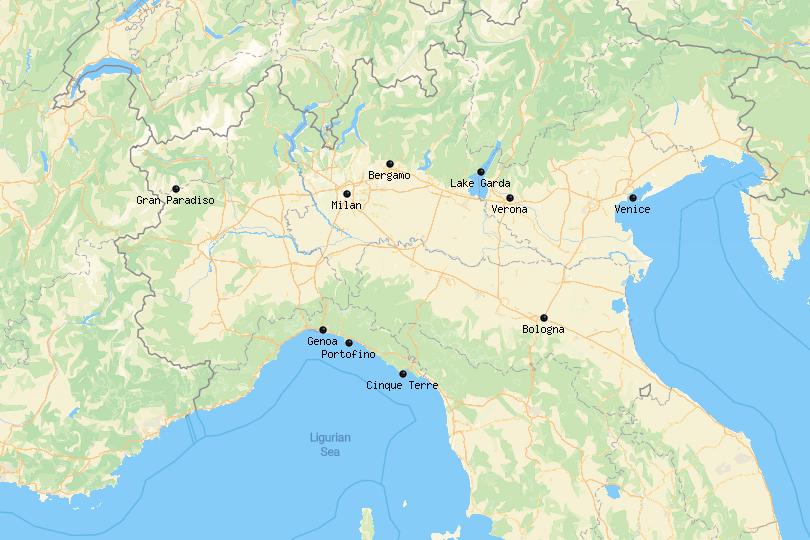
10. Bologna [SEE MAP]

Called “La Rossa” for its red brick buildings and tile roofs, Bologna is the capital and largest city in Northern Italy’s Emilia-Romagna region. It’s also an architecture lover’s dream. Although Bologna is best known for its medieval towers and extensive porticoes, thanks to extensive restoration, Bologna’s architecture includes Etruscan and Roman structures as well.
Founded in 1088, the University of Bologna also demands a visit. It’s the world’s oldest institution of higher learning and still enrolls thousands of students each year. No trip to Bologna is complete without a visit to Piazza Maggiore where the still-unfinished façade of the Basilica of San Petronio makes its beautiful interiors appear all the more remarkable.
9. Gran Paradiso National Park [SEE MAP]
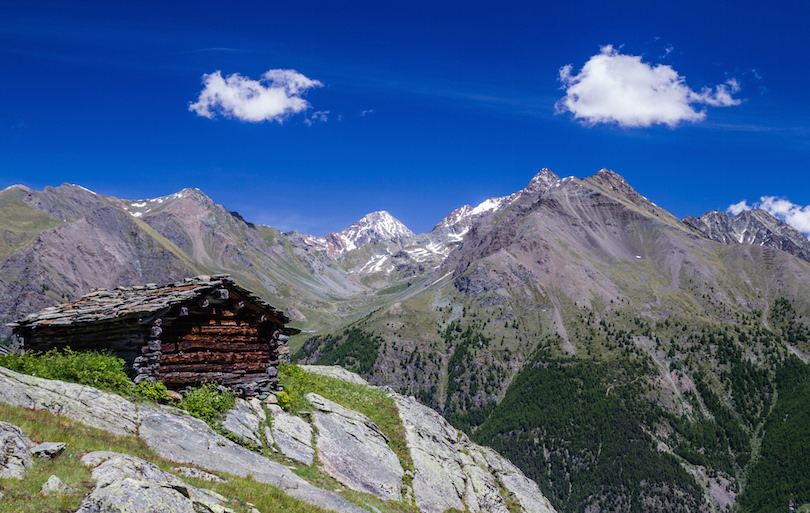
One of Europe’s largest and best preserved wilderness areas, Gran Paradiso National Park is named for Italy’s highest peak, Gran Paradiso, the only mountain in the Alps that lies entirely within the country’s boundaries.
The area was designated Italy’s first national park in 1920, in part to protect the dwindling population of ibex, a mountain goat best known for horns that can grow up to 3 feet long. The park is a hiker’s paradise in late spring and summer when the flowers are in bloom, and it’s a great holiday destination for cross-country skiing and snowshoe hikes during the winter.
8. Bergamo [SEE MAP]
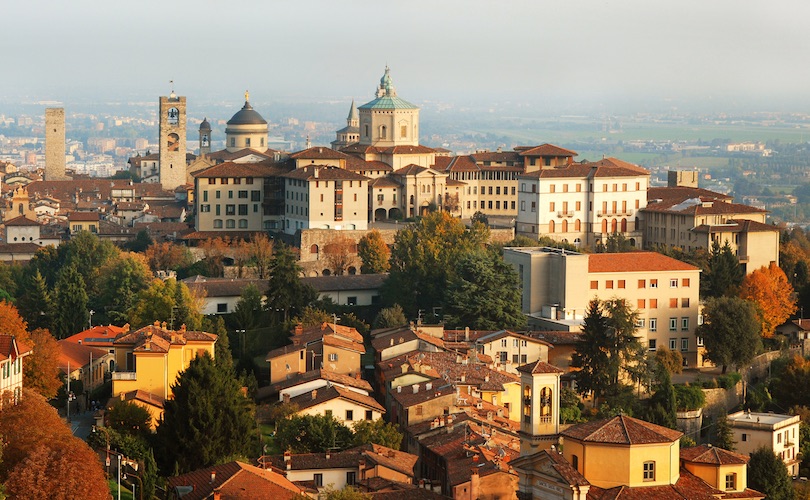
Nestled against the foothills of the towering Bergamese Alps, Bergamo is comprised of two distinct cities. The Città Alta, or upper city, is a medieval town surrounded by 16th-century walls while the lower section known as Città Bassa is a relatively modern city.
Most visitors head straight to the old town to explore the beautifully preserved Medieval and Renaissance architecture and picturesque piazzas, including the ornate Basilica of Santa Maria Maggiore, the final resting place of the composer Gaetano Donizetti. With its extensive collection of paintings by Raphael, Botticelli and Canaletto, the Accademia Carrara is a can’t-miss attraction too.
7. Verona [SEE MAP]
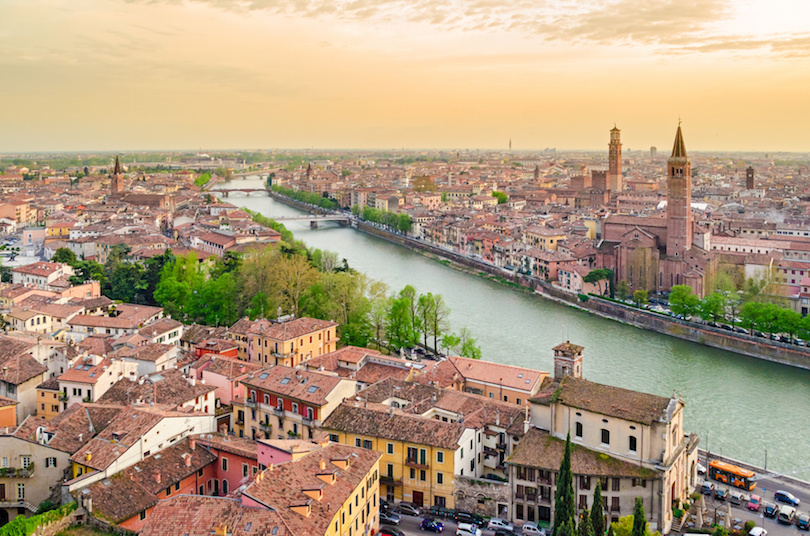
Best known as the setting for Shakespeare’s play “Romeo and Juliet,” Verona is a picturesque city filled with Roman ruins, Renaissance palaces and medieval buildings. Located between Milan and Venice, the city receives a bit less attention from travelers than its more celebrated neighbors but not for lack of attractions .
Verona offers visitors the chance to enjoy all of the charms of an ancient Italian city without constantly battling crowds. Although the first stop for many visitors is “Juliet’s House” with its recently added balcony, it’s important to remember that Romeo and Juliet were characters from fiction, not reality.
6. Genoa [SEE MAP]
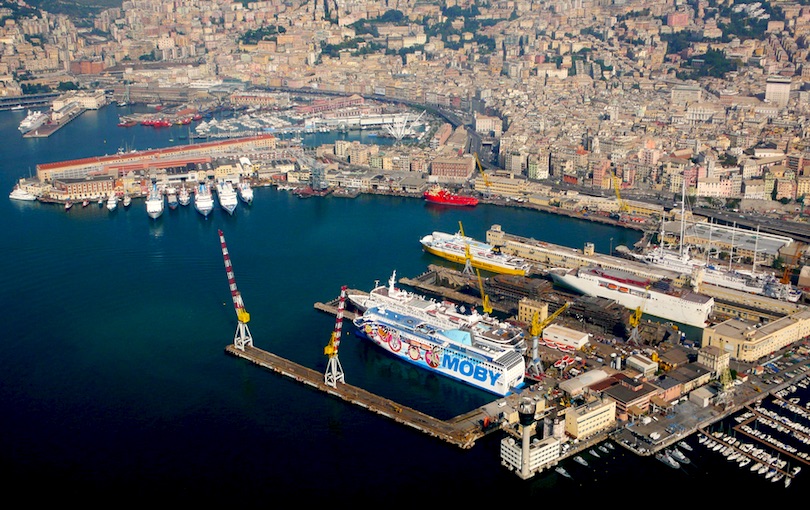
Sometimes overshadowed by the popularity of other Italian cities like Rome and Venice, Genoa nevertheless is one of Italy’s true hidden gems. As the capital city of the Liguria region on the northwest coast of Italy, Genoa is most associated as the birthplace of Christopher Columbus.
The city’s shining crown is its historic center, which features narrow, winding streets that reveal surprising gems at every turn like marvelous architecture and artistic treasures. At the base of the city center is the historic seaport. Docked with cruise liners, yachts and fishing boats, Genoa’s seaport today sports a trendy renovation of new features such as a bustling marina, waterfront bars and the Aquarium of Genoa.
5. Milan [SEE MAP]

Nearly destroyed from heavy bombing during WWII, Milan has since reconstructed and now shines as the country’s financial and fashion capital. Milan’s most famous site is the Santa Maria della Grazie where da Vinci’s “The Last Supper” is on display. The 14th-century Sforzesco Castle houses the exhibits of the Museo d’Arte Antica, which includes Michelangelo’s “Pietà Rondanini.”
Decked out in sumptuous red and gold, the 18th-century La Scala opera house is a must-see attraction too, as is the Duomo, known as one of the world’s largest Gothic cathedrals. When it comes to shopping, the Galleria Vittorio Emanuele II is the place to go for the best of Italy’s haute couture designs.
See also: Where to Stay in Milan
4. Portofino [SEE MAP]
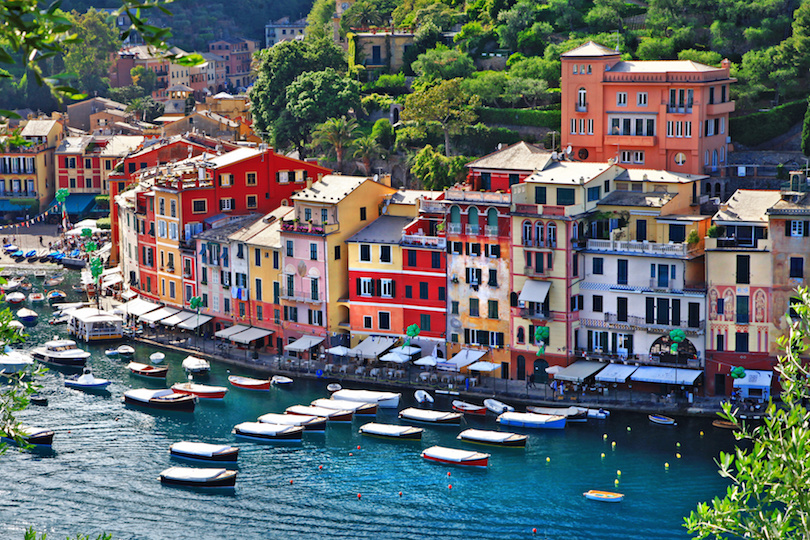
With its picture-perfect harbor, verdant scenery and haphazard rows of hilltop and waterfront homes, Portofino is one of the prettiest towns on the Italian Riviera. Located just a short drive south of Genoa, the little village has been a popular day-trip destination for centuries.
It’s a favorite stopping point for cruises along the Italian Riviera too, and the cluster of yachts floating in the harbor only adds to Portofino’s visual appeal. Short climbs up the hillside to the medieval Castello Brown, the historic Church of San Giorgio or the lighthouse at Punta Portofino offer photographic views of the charming city.
3. Lake Garda [SEE MAP]
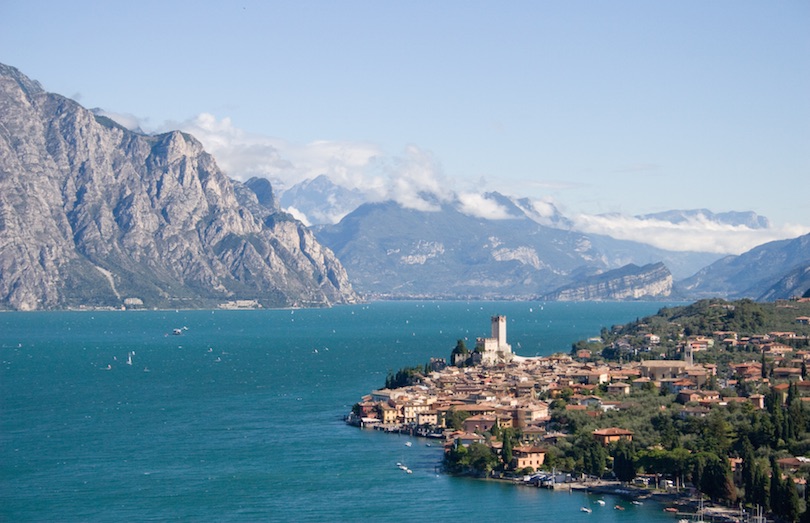
The largest of the glacial lakes of the Lombardy province, Lake Garda is bordered by Alpine peaks to the north and flat plains to the south. Gardens, orchards and forests rim the shore, providing a scenic backdrop for visitors seeking rest and recreation .
The southernmost town of Sirmione features natural hot springs, a small castle and the Grotte di Catullo, the largest collection of Roman ruins in Northern Italy. On the northern shore of lake lies Riva del Garda, which is the destination of choice for visitors interested in outdoor activities, including sailing, windsurfing, kayaking and swimming.
2. Cinque Terre [SEE MAP]
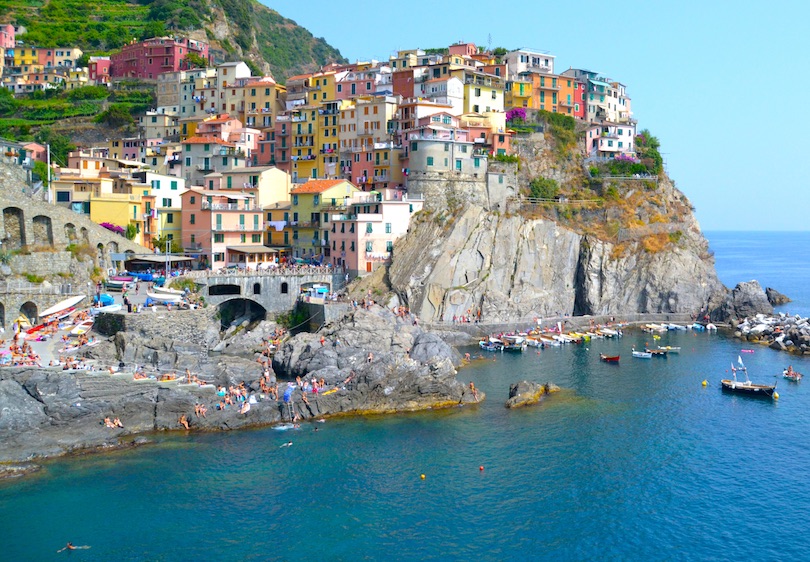
Cinque Terre is undeniably one of the most beautiful areas of Italy. A visit to just one of the five villages of Riomaggiore, Manarola, Vernazza, Monterosso and Corniglia will confirm this.
Made to grace picture postcards, the towns are built on steep hills and atop high cliffs overlooking the Mediterranean. It doesn’t get much more scenic than this. Most towns are reachable only by train. Comfortable walking shoes are a must since cars aren’t allowed in the older sections of these towns.
1. Venice [SEE MAP]

The perfect destination for a romantic getaway, Venice is a city where canals replace roads and buildings rise up out of the Adriatic Sea as if by magic. There’s a timeless quality to Venice that has attracted and engaged travelers for hundreds of years.
When not enjoying the enchanting experience of being serenaded while gliding down a canal on a gondola, visitors flock to the sidewalk cafés of St. Mark’s Square. Inside the Basilica of San Marco lies a treasure trove of jewel-encrusted altarpieces, icons and holy relics, including the marble-canopied tomb of St. Mark.
See also: Where to Stay in Venice
Share this post:
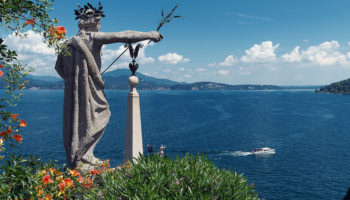
10 Best Day Trips from Milan
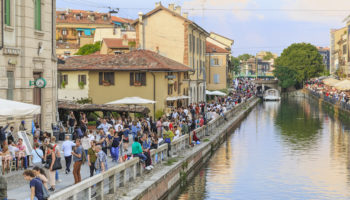
Where to Stay in Milan: Best Neighborhoods & Hotels
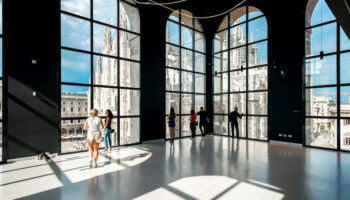
23 Top Attractions & Things to Do in Milan

14 Best Places to Visit in Lombardy, Italy
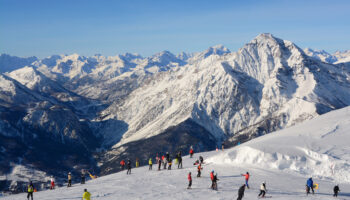
12 Best Places to Visit in Piedmont, Italy
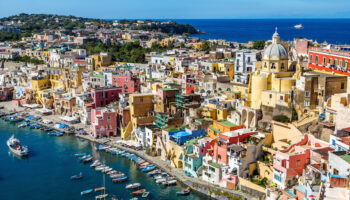
10 Most Beautiful Italian Islands
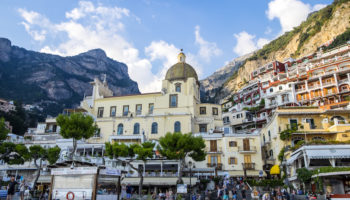
Where to Stay in the Amalfi Coast: Best Towns & Hotels
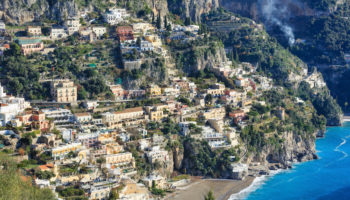
9 Best Day Trips from Naples
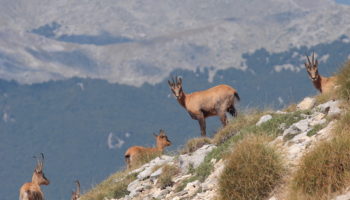
10 Most Beautiful National Parks in Italy
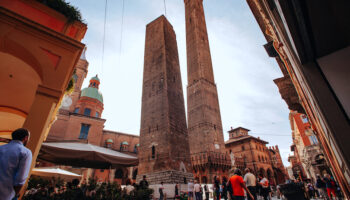
17 Best Things to do in Bologna, Italy
Reader interactions.
July 30, 2019 at 8:17 pm
Would you recommend visiting these destinations in February?
July 27, 2019 at 11:37 am
why doesn’t anyone list CORTINA DE AMPEZZO? stunningly beautiful in summer or winter and only an hour and a half from Venice.
November 8, 2016 at 11:13 pm
Thank you. Excellent information on Northern Italy!
Leave a Reply Cancel reply
Your email address will not be published. Required fields are marked *
This site uses Akismet to reduce spam. Learn how your comment data is processed .
- 21 Breathtaking Destinations In Northern...
The 21 Most Breathtaking Destinations in Northern Italy

Northern Italy is as topographically diverse as it is beautiful: spectacular mountain vistas in the Dolomites and the Alps, vast crystalline lakes, undulating, vineyard-covered hills, dramatic coastlines, enchanting historical cities and architecture. Get inspired with this introductory list of some of the most stunning locations in the region.
Keen to visit Italy but not sure where to go? Check out our selection of specially curated small-group Italian adventures.
1. Langhe, Piedmont

In the wine-producing region of Langhe, rolling, vineyard-covered hills give way to views of the snow-covered Alps. Picturesque Piedmont villages form in clusters on small winding roads throughout the region, with striking contemporary architecture and sculptures found on many vineyard estates. A trip here is incomplete with a tour (and tasting, of course) at one of the region’s finest wineries.
2. Bologna, Emilia-Romagna
Architectural Landmark

4. Turin, Piedmont
Architectural Landmark, Historical Landmark

Baroque buildings and art nouveau cafes line the grand boulevards and squares of this refined and cosmopolitan city. Geometric stained glass windows, plasterwork with floral motifs and curvaceous ironwork decorate the elegant townhouses and dreamy villas on the Po River. The cityscape, set against the dramatic outline of the Alps, is often shrouded in mist. Be sure to book a tour of the Royal Palace, and get to know the city properly on a gourmet food tour.
5. Parco Nazionale Gran Paradiso, Aosta Valley

With 724km (450mi) of marked trails and mule tracks, this national park in the Aosta Valley is a walker’s paradise in all seasons. During winter, hike the pristine snowy peaks and in the spring and summer months watch the biodiversity of the landscape blossom. You are also likely to see horned goats grazing peacefully on the alpine pastures, or spot rare birds overhead.
6. Basilica di San Vitale, Emilia-Romagna

The plain facade of this Byzantine-inspired church belies the splendour within – one of the most sublime examples of early-Christian mosaic art in Europe. The Basilica di San Vitale was built in Ravenna in the sixth century and across every surface, tales and allegories expressing the ideology and religious beliefs of Christianity in the Justinian period are relayed in exquisite coloured and gilded tiles. The conflation of eastern and western aesthetics is also distinct in the church’s unique architecture.
7. La Venaria Reale, Piedmont

This magnificent royal estate built in the 17th-century for Duke Carlo Emanuele II of Savoy is considered Turin’s Versaille. The famous Hall of Diana designed by Amedeo di Castellamonte is a fairytale Baroque masterpiece.
8. Camogli, Liguria

Savour fresh seafood on the azure pebble beaches of this picturesque fishing village. The main beach is lined with buildings painted in sherbert hues, others are nestled in secluded coves surrounded by lush greenery. The ancient Abbazia San Fruttuoso creates a special backdrop for a small bay beneath a steep wooded hill; its cloisters lead directly onto the beach that is only accessible by foot.
9. Bagni di Bormio, Lombardy
Natural Feature

10. Livigno, Lombardy

It may be renowned as a ski resort, but Livigno is also within the prized Parco Nazionale dello Stelvio. Stunning panoramas of the Alps are peppered with traditional baita (chalets) whilst in February, the town comes alive with a famous snow polo tournament. Fear not if your shaky on the slopes, there are plenty of good ski lessons you can book here.
11. Lake Orta, Piedmont

Lake Orta is smaller and less frequented than its more glamorous counterparts; Como, Maggiore and Garda, which creates a distinct atmosphere. The single island at the centre of the lake is enchanting, as is its principal town Orta San Giulio. The calm and reclusive feeling that people find at Orta has been a pull for writers across the centuries – Friedrich Nietzsche, Samuel Butler, Lord Byron, Honoré de Balzac and Robert Browning all visited. From a hillside vantage point, take in the in its entirety and admire the seasonal changes in the surrounding topography.
12. Lake Como, Lombardy

Lake Como is celebrated for outstanding natural beauty, crystalline bays and Renaissance architecture. The area remains popular thanks to a location just an hour from Milan , yet Como is undeniably stunning. The ‘upside-down Y’ shaped lake is set against the foothills of the Alps and spectacular lakeside vistas surround you in every quaint village and town. Bike to a hillside summit and survey the area’s Mediterranean yet alpine majesty.
13. Lake Garda, Lombardy

Situated at the edge of the Dolomites, this is Italy’s largest lake and its beauty has been eulogised by many writers, including Catullus, Tennyson, DH Lawrence and Ezra Pound. At the northern part of the lake, the Gruppo del Baldos mountains create a dramatic backdrop and at the centre, you will find small islands home to grand villas. Garda’s many charming lakeside villages and towns drip with lush and fragrant Mediterranean plant life and fishing boats rest in their harbours. Fresh mountain water gently laps at the sand and pebble beaches that dot the lake’s perimeter.
14. Bergamo, Lombardy

15. Venice, Veneto
Natural Feature, Architectural Landmark

16. Cortina d’Ampezzo, Veneto

One of the most quaint ski resorts in the Dolomites, Cortina d’Ampezzo has slopes for beginner and advanced skiers and breathtaking mountain views. In winter, chocolate box chalets sit covered in heavy snow whilst in summer they are dressed with bright red geraniums.
17. Wine country, Friuli-Venezia Giulia

Friuli-Venezia Giulia has a unique geographical position, bordering Slovenia , Germany and the Adriatic Sea, all of which make it a much-celebrated wine region. The Collio is a series of picturesque hills nestled between two rivers and the Slovenian border. Mostly small-scale, family-run vineyards sprawl across the valley in every direction, so when the seasons change the entire landscape changes colour too – from intense and vivid green to burnt amber, the all-encompassing vineyard views are truly stunning.
18. Monte Lussari, Friuli-Venezia Giulia

At the peak of Mount Lussari in the Julian Alps stands a shrine that has been a pilgrimage destination since the 16th-century. The story, which features in both Italian and Slavic folklore, states that in 1360 a shepherd lost his sheep before finding it in a bush of mugo pine alongside a statuette of the Madonna with Child. Climb up through the old world village and admire panoramic views of the Tarvisian basin.
19. Isarco Valley, Trentino-Alto Adige/Südtirol

Italian and Germanic culture conflate is the fairytale landscape of the Isarco Valley. Steepled churches and traditional wood chalets are surrounded by apple orchards and pine forests which lead to stunning vistas of the rugged Dolomites. The valley’s rich cuisine reflects the culinary heritage of the Austro-Hungarian empire and the Veneto region.
20. Pragser Wildsee, Trentino-Alto Adige/Südtirol

Be enchanted by one of the most beautiful lakes in the Dolomites. Located in the Pragser valley between Felsberg and Niederdorf branching off from the Puster Valley, the Pragser Wildsee is surrounded by dense pine forest and its perfectly calm water is an almost unreal turquoise.
21. Messner Mountain, Südtirol

The summit of the plateau of Kronplatz is one of the most magnificent viewing platforms of Südtirol. The breathtaking panorama moves from the Lienz Dolomites in the east to the Ortler in the west, from the Marmolada in the south to the Zillertal Alps in the north. The Messner Mountain Museum designed by Zaha Hadid Architects is located here and the grey, modernist design built into the landscape is equally inspiring.
Since you are here, we would like to share our vision for the future of travel - and the direction Culture Trip is moving in.
Culture Trip launched in 2011 with a simple yet passionate mission: to inspire people to go beyond their boundaries and experience what makes a place, its people and its culture special and meaningful — and this is still in our DNA today. We are proud that, for more than a decade, millions like you have trusted our award-winning recommendations by people who deeply understand what makes certain places and communities so special.
Increasingly we believe the world needs more meaningful, real-life connections between curious travellers keen to explore the world in a more responsible way. That is why we have intensively curated a collection of premium small-group trips as an invitation to meet and connect with new, like-minded people for once-in-a-lifetime experiences in three categories: Culture Trips, Rail Trips and Private Trips. Our Trips are suitable for both solo travelers, couples and friends who want to explore the world together.
Culture Trips are deeply immersive 5 to 16 days itineraries, that combine authentic local experiences, exciting activities and 4-5* accommodation to look forward to at the end of each day. Our Rail Trips are our most planet-friendly itineraries that invite you to take the scenic route, relax whilst getting under the skin of a destination. Our Private Trips are fully tailored itineraries, curated by our Travel Experts specifically for you, your friends or your family.
We know that many of you worry about the environmental impact of travel and are looking for ways of expanding horizons in ways that do minimal harm - and may even bring benefits. We are committed to go as far as possible in curating our trips with care for the planet. That is why all of our trips are flightless in destination, fully carbon offset - and we have ambitious plans to be net zero in the very near future.

Guides & Tips
The best trips and tours in italy.

Top Tips for Travelling in Italy

The Best Places to Travel in April 2024

Top Tips for Travelling in Rome

See & Do
Why san ginesio is one of the best tourism villages in the world.

The Best Group Trips to Take With Your Partner

The Best Private Trips to Book With Your Girl Friends

Your Guide to Travelling Italy by Train

How Much Does a Trip to Italy Cost?

The Most Amazing Markets in the World

The Top 11 Things to Do in Navigli, Milan

Visit the Locations from Your Favourite TV Shows with Culture Trip
Culture trip spring sale, save up to $1,100 on our unique small-group trips limited spots..

- Post ID: 1676389
- Sponsored? No
- View Payload

The Ultimate Northern Italy Itinerary: Must-See Destinations
- Post author: angelo
- Post published: November 4, 2023
- Post category: Italy
When it comes to exploring Italy , each of its regions offers something unique and captivating. In this comprehensive northern Italy itinerary guide, we’ll cast a spotlight on the enchanting northern part of the country. Whether you’re struggling to narrow down your travel options or starting from scratch in search of inspiration, this post is designed to help you craft the perfect itinerary, complete with valuable tips for navigating this fascinating region.
As someone who visits northern Italy on a regular basis, this area holds a special place in my heart. Over time, I’ve had the privilege of traversing its picturesque landscapes, savouring its delectable cuisine, and immersing myself in its rich culture. There is so much to see and do in the North of Italy that a single trip for sure may not suffice. To address this delightful dilemma, I’ve curated five distinct northern Italy itineraries (plus a suggested itinerary at the end), each catering to different interests and preferences. These itineraries are tailored for those who wish to explore the most famous locations, outdoor enthusiasts, city lovers, couples seeking romance, and avid foodies. With these options, you can experience a bit of everything that northern Italy has to offer, making it easier to compile your northern Italy bucket list.
How long should a northern Italy itinerary be
Before delving into the itineraries, let’s address a crucial question that often plagues traveler’s: How long should a northern Italy itinerary be? Ideally, a robust northern Italy itinerary should span between 10 and 14 days. If you have more time at your disposal, that’s even better. You can delve deeper into the local culture, take the slow travel route, and unearth hidden gems. On the other hand, if you have a shorter timeframe and still want to explore a variety of places, careful planning of your transportation and a jam-packed schedule of activities await you.
While I’ll recommend a particular order for the stops on the itineraries, I won’t prescribe a fixed number of days for each location. The flexibility of your travel dates and the pace of your journey should guide your choices. I’ll also sprinkle in additional tips and suggestions based on my own experiences to ensure you don’t encounter the same hiccups I did, and I’ll introduce you to extra destinations in the region that are well worth your time.
The Best Time to Visit North of Italy
Now, let’s consider the best time to visit northern Italy. As a frequent visitor of this region, I can confidently tell you that the optimal times to explore northern Italy are during the months of June and September. These months offer the perfect blend of pleasant weather, the beginning or tail end of the busy summer tourist season, and the opportunity to secure great deals on rental cars and accommodations if you book in advance. For adventure seekers and outdoor enthusiasts, winter in the Italian Alps , during the peak ski season, is a thrilling option.

How to Move Around
Now, let’s turn our attention to the essential aspect of moving around northern Italy . This region is the most developed part of the country, making transportation readily accessible and convenient. However, northern Italy is not without its challenges, particularly when it comes to navigating the Italian Alps. While you can easily travel between cities and even towns using regional trains, crossing the mountainous terrain may limit your train options. In some cases, there may be no train connections available at all. For those planning to explore the Italian Alps, I recommend either renting a car or booking a tour that takes care of transportation during your daily activities. Another option is bus travel, which comes with its own set of challenges, such as understanding regional bus routes within a limited timeframe and a lack of flexibility when using coach buses.
Here’s a more detailed look at your transportation options in northern Italy:
Northern Italy boasts both national and regional train lines, ensuring well-connected travel between major cities and smaller towns. Trains are generally easy to navigate, making them an attractive option for tourists. While trains may not be as cost-effective as buses, they are more budget-friendly than renting a car.
Italy lacks a national bus line, so most buses are regional or city-specific. However, companies like Flixbus operate throughout the country and Europe, providing options for interregional travel.
Buses are often the most economical choice for transportation, with Flixbus tickets available for as low as €5. Nonetheless, they tend to have longer travel times. Regional buses offer access to smaller towns, while Flixbus primarily serves cities. Navigating regional or city buses can be challenging, requiring careful planning around timetables.
Opting for buses is ideal for a slower travel itinerary when you have ample time to explore Italy. This approach allows you to save money while immersing yourself in the local experience.
Embarking on an Italian road trip is a thrilling adventure, providing the opportunity to experience the country’s diverse landscapes. Renting a car in Italy offers maximum flexibility but comes at a higher cost compared to other modes of transportation.
If your itinerary involves visiting many places outside major cities or tourist hotspots, renting a car is highly recommended. Any of the itineraries discussed here can easily be transformed into a road trip, allowing you to relish the scenic beauty of Italy at your own pace. Now, let’s dive into the five enticing northern Italy itineraries designed to cater to your distinct interests and preferences:
- The Bucket List Northern Italy Itinerary:
If you’re embarking on a once-in-a-lifetime journey to Italy, this Northern Italy itinerary is tailored to your aspirations. This comprehensive route covers the five major areas on everyone’s northern Italy bucket list, including Milan , Lake Como, Cinque Terre, Venice, and the Dolomites. You can start your journey in either Milan or Venice , with both cities serving as excellent home bases for exploring the region. Spend time in Milan, venture to the enchanting Cinque Terre and Lake Como, and consider exploring additional day trip options. Subsequently, make your way to Venice, from where you can embark on a day trip to the stunning Dolomites. With a 10-day itinerary, you have the flexibility to allocate two days to each location. However, you can adapt this itinerary according to your preferences and the time you have available.
- Explore the Italian Alps:
For outdoor enthusiasts and nature lovers, the Italian Alps offer a breathtaking and invigorating experience. This itinerary delves into the Western Alps, including Courmayeur, Gran Paradiso National Park, and Breuil-Cervinia, followed by a journey through the Central Alps, covering Lake Como, Bergamo, and Val Brembana, and concluding with the Eastern Alps in the Dolomites . The Western Alps in Valle D’Aosta offer a unique blend of French and Italian cultures, with the stunning Mont Blanc and Matterhorn as prominent highlights. Moving through the Central Alps, you’ll be captivated by the picturesque Lake Como and the charming towns that grace its shores. A deeper exploration of Val Brembana reveals hidden treasures in the form of villages like Branzi and Cornello dei Tasso. Finally, the Eastern Alps, with their jagged grey peaks and lush valleys, make the Dolomites a must-visit destination for mountain enthusiasts.
- City-Lovers’ Paradise:
For travellers who relish the hustle and bustle of historic European cities, this itinerary presents an array of vibrant urban centers. From the bustling metropolis of Milan to the medieval charm of Bergamo, the major cities in northern Italy offer diverse landscapes and captivating experiences. The itinerary covers Milan, Turin, Bergamo, and Venice. You can choose to start in Milan, home to major airports, or consider Bergamo Orio al Serio Airport , a hub for Ryanair flights. Milan and Bergamo, while just 40 minutes apart by car, offer entirely distinct atmospheres. Milan exudes energy and excitement, while Bergamo, with its historic Città Alta, boasts a more relaxed pace of life. Continuing westward, Turin awaits, adorned with Baroque-style architecture and the iconic Mole Antonelliana. Finally, journey east to the enchanting Venice, known for its unique water-based transportation system and picturesque alleyways that beckon travelers to get lost in their beauty.
- Most Romantic Places for Couples:
Italy has long been celebrated as one of the world’s most romantic destinations, making it an ideal choice for couples seeking an amorous getaway. This Northern Italy itinerary takes you to the most enchanting and intimate locales, including Portovenere, Lake Como, Franciacorta, Verona , Lake Garda, and Venice. Portovenere, a hidden gem along the Ligurian coast, offers stunning views, a tranquil harbor, and romantic spots like Lord Byron’s Grotto and Palmeria Island. Lake Como, renowned for its luxury, features villas, alpine peaks, and the picturesque town of Bellagio. Franciacorta, nestled between Bergamo and Brescia, is a haven for wine lovers, with its sparkling wine and vineyard vistas. Further exploration in Veneto reveals Verona, the city of love, immortalized in Shakespeare’s Romeo and Juliet. Lake Garda , the largest lake in Italy, boasts small, charming towns, including Sirmione and Limone sul Garda, offering an intimate atmosphere. Venice, the ultimate romantic city, beckons with gondola rides and timeless charm.
- A Foodie’s Northern Italy Itinerary:
Italian cuisine is renowned worldwide, and northern Italy’s traditional dishes are a departure from the stereotypical pasta and pizza. The meals here are heartier, reflecting the lifestyles of industrial workers and the challenging winters faced by those in the Alpine regions. Additionally, northern Italy is passionate about local ingredients, resulting in a delectable array of regional specialties. Here are some of the delightful foods you can savor in each region on this itinerary:
Piemonte: Truffles Liguria: Seafood, Focaccia, and Pesto Bergamo: Polenta Bologna: Tagliatelle alla Bolognese, Parmigiano Reggiano, Mortadella, Ragù Bolognese, Balsamic Vinegar, and Lasagna , Tortellini in Brodo
The northern Italy foodie itinerary commences in Piemonte, renowned for its exquisite truffles. A fall visit is ideal, coinciding with the White Truffle Festival in Alba. To make the most of this experience, consider booking a truffle hunting tour and indulging in a Barolo wine tasting. Liguria , with its fresh seafood, delectable focaccia, and iconic pesto, awaits your palate. Don’t miss out on the trofie al pesto, a Ligurian pasta favorite. Venturing into Bergamo, you’ll encounter two regional specialties: polenta and pizzoccheri. Polenta, a versatile grain dish, comes in various forms, including Polenta Contadina, which combines cheese, spinach, and local sausage. Pizzoccheri, a unique blend of short buckwheat tagliatelle pasta, potatoes, cheese, and greens, hails from Valtellina, a valley bordering Switzerland. The final stop on this delectable journey is Bologna, the birthplace of Italian food favorites such as Parmigiano Reggiano, Mortadella, Ragù Bolognese, Balsamic Vinegar, and Lasagna. Arrive with an empty stomach to fully savor these culinary delights of this wonderful city.

If you are not sure where to start on planning your Northern Italy itinerary I have a solution for you with a suggested itinerary if you are a first timer visiting the North of Italy.
Exploring Northern Italy: A 10-Day Itinerary
Northern Italy, with its stunning landscapes, rich history, and vibrant culture, is a dream destination for travelers. From the romantic canals of Venice to the art-filled streets of Florence, and the breathtaking landscapes of the Italian Lakes, Northern Italy offers a diverse range of experiences. In this article, we will take you on a 10-day journey through this enchanting region, providing you with a comprehensive Northern Italy itinerary packed with 10 incredible ideas for an unforgettable trip.
Day 1: Arrival in Milan
Your Northern Italy adventure begins in Milan, the fashion and financial capital of Italy. Upon arrival at Milan Malpensa Airport , settle into your accommodation and spend your first evening exploring the city. Take a stroll through the magnificent Piazza del Duomo, where you can admire the iconic Milan Cathedral. Don’t forget to visit Galleria Vittorio Emanuele II , a 19th-century shopping gallery with luxurious boutiques and restaurants.
Day 2: Milan Exploration
Start your day with a visit to Leonardo da Vinci’s masterpiece, “The Last Supper” located in the Convent of Santa Maria delle Grazie. Book your tickets in advance, as this is a popular attraction. In the afternoon, explore the historic Sforza Castle and its beautiful surrounding park. Milan is also known for its fashion, so indulge in some shopping along Via Montenapoleone or Corso Buenos Aires.
Day 3: Venice – The City of Canals
Leave Milan behind and take a train to the enchanting city of Venice and begin your exploration of this unique city built on water. Start with a visit to St. Mark’s Square and the stunning St. Mark’s Basilica. Take a gondola ride along the Grand Canal and explore the charming streets of Venice.
Day 4: Venice Islands
Spend a day exploring the beautiful islands surrounding Venice. Take a Vaporetto (water bus) to Murano , famous for its glass-blowing traditions, and then proceed to Burano, known for its colorful houses and lace-making heritage. Finally, visit Torcello, home to the Cathedral of Santa Maria Assunta and Attila’s Throne, where you can enjoy the tranquility of this island paradise
Day 5: Verona and Juliet’s Balcony
Leave Venice and travel to Verona, the city of love. Explore the well-preserved Roman arena, where you can catch an opera performance if you visit during the opera season. Don’t miss a visit to Juliet’s House, with its iconic balcony. Take a romantic stroll along the Adige River and enjoy a meal in one of Verona’s charming restaurants.
Day 6: Lake Garda
Head to Lake Garda, Italy’s largest lake, surrounded by picturesque villages and stunning landscapes. Spend your day in the town of Sirmione, known for its thermal baths and Scaliger Castle. Take a dip in the lake’s crystal-clear waters and savor delicious Italian gelato as you enjoy the serene atmosphere.
Day 7: Florence – The Cradle of the Renaissance
Say goodbye to Lake Garda and board a train to Florence, the heart of the Renaissance. Visit the Uffizi Gallery to see masterpieces by artists like Michelangelo and Botticelli. Stroll across the iconic Ponte Vecchio, don’t miss a visit to the Florence Cathedral.
Day 8: Florence’s Art and Culture
Dedicate a full day to Florence’s art and culture. Explore the magnificent Florence Cathedral (Duomo) and its stunning dome designed by Brunelleschi. Visit the Galleria dell’Accademia to see Michelangelo’s David, and then wander through the Boboli Gardens. In the evening, savor Tuscan cuisine in a local trattoria.
Day 9: Tuscany Day Trip
While in Florence , you can’t miss the opportunity to explore the beautiful Tuscan countryside. Take a day trip to the charming towns of Siena and San Gimignano. In Siena, visit the Piazza del Campo and the stunning Siena Cathedral. In San Gimignano, admire the medieval towers that dot the skyline and enjoy local wines and cuisine.

Day 10: Milan Departure
End your 10-day Northern Italy itinerary by returning to Milan for your departure. If time allows, visit the Brera district to explore its art gallery and charming streets. Before leaving, savour a last Italian meal, perhaps in one of Milan’s top-rated restaurants.
A trip to Northern Italy offers a diverse range of experiences, from the bustling city life of Milan to the romantic canals of Venice, the cultural richness of Florence, and the serene beauty of Lake Garda. This 10-day itinerary provides a perfect balance of history, culture, and natural beauty, allowing you to make the most of your visit to this enchanting region.
In conclusion, northern Italy is a captivating and diverse region, offering a rich tapestry of experiences, from breathtaking mountains and tranquil lakes to vibrant cities and delectable cuisine. While it’s challenging to encompass all of its wonders in a single trip, I hope these itineraries provide you with the inspiration and guidance you need to craft your dream northern Italy adventure. You can customize these itineraries based on your interests, time frame, and preferred pace of travel. Whether you’re a nature lover, a history enthusiast, a foodie, or a romantic at heart, northern Italy has something special to offer, and these itineraries are your key to unlocking its treasures.
Affiliate Disclaimer
Please Share This Share this content
- Opens in a new window X
- Opens in a new window Facebook
- Opens in a new window Pinterest
- Opens in a new window LinkedIn
- Opens in a new window Reddit
- Opens in a new window Tumblr
- Opens in a new window WhatsApp
You Might Also Like

Top Things To Do In Puglia: Uncover Italy’s Hidden Gem

Italy in April: A Traveler’s Guide to Springtime Splendor

Experience the Magic of Italy in October: A Must-Visit Guide
Northern Italy’s Enchanting Escapes: 12 Unmissable Vacation Destinations
Northern Italy is known for its mountain ranges, beautiful coastlines, rich cuisine, deep history, and gorgeous architecture. Northern Italy cities are simply breathtaking.
Each major region of Italy (northern, central , and southern ) is quite unique. Northern Italy is made up of 8 different sub-regions, which include Piedmont, Emilia-Romagna, Lombardy, Liguria, Aosta Vally, Veneto, Fruili-Venezia, and Trentina-Alto.
From hiking the Italian Alps and Lake Como boat tours to handmade pasta and vineyards, the northern region of Italy is a diverse vacation destination you shouldn’t miss! Check out our favorite places to visit in Northern Italy– with things to do!
[This article contains affiliate links to trusted partners.]
Cinque Terre, Liguria
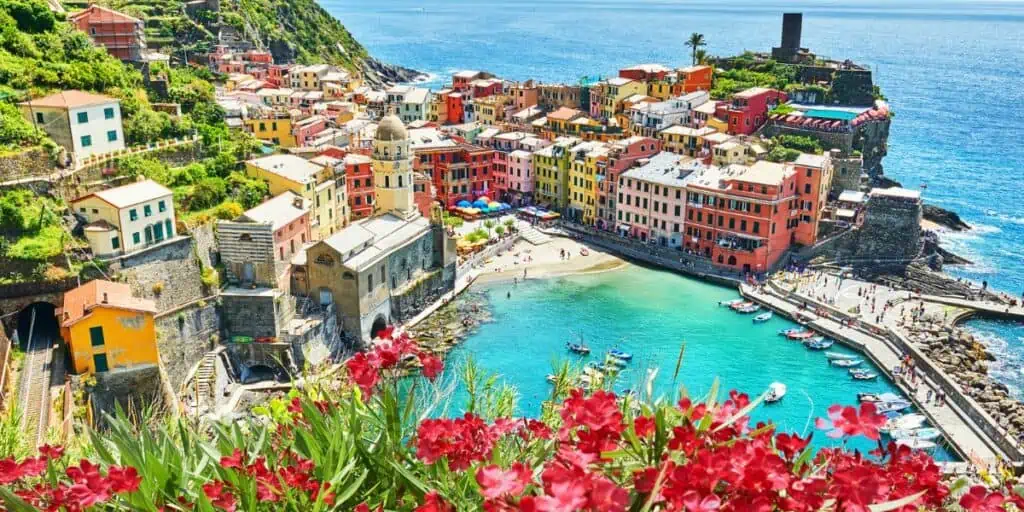
Recommended by Pafoua of Her Wanderful World
Cinque Terre, meaning “Five Lands,” is a charming, must-see UNESCO destination located in Liguria’s capital city, La Spezia, off the Mediterranean coast in Northern Italy. Listed north to south, these beautiful coastal towns are Monterosso al Mare, Vernazza, Corniglia, Manarola, and Riomaggiore.
Each town has its own unique beauty to explore, but all of them offer scenic views of colorful houses that line the hills. The ambiance, culture, and people in the Cinque Terre make a stop here unforgettable even though there aren’t traditional tourist sites such as churches or museums to visit.
Monterosso is the largest of the five and is known for its long stretch of sandy beach. Vernazza is the most beautiful of all the towns, with a smaller beach to swim in and a piazza to view the harbor below.
Sitting as the highest of all five villages, visitors will need to climb over 300 steps to reach the town center of Corniglia. Visit Gelateria Corniglia to find the best gelato. A popular activity in Manarola is sunbathing on the rocks or swimming in the sea since it doesn’t have a beach.
Riomaggiore is known for being the first town introduced to tourism, and nightlife is more lively. There is also delicious fried seafood found here.
A well-maintained train system connects the towns so visitors can easily travel between towns by hopping on and off. To take the scenic route, you can hike the trails and receive even more picturesque views, although keep in mind that some of the trails may be challenging.
Vehicles are discouraged in the Cinque Terre, so the easiest way to arrive is by train. Visitors can also arrive by boat, but schedules can change depending on the weather. The busiest times in the Cinque Terre are June and July, which also offer the sunniest, longest days.
To miss the crowds, visit during September or October to get cooler weather and still enjoy this beautiful area. Whenever you decide to visit the Cinque Terre and Northern Italy, you will not be disappointed!
Genoa, Liguria
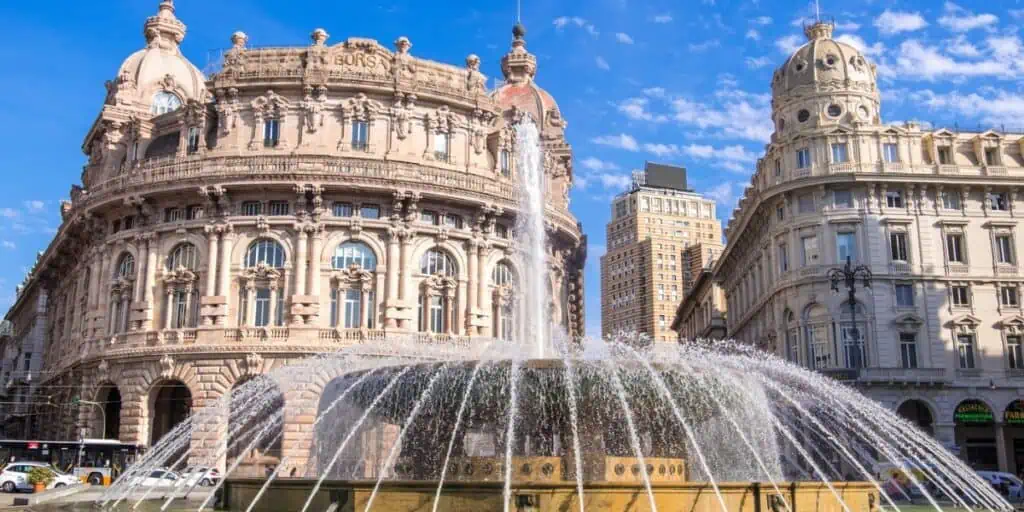
Recommended by Sarah of A Social Nomad
Genoa, located in Northern Italy, is really easy to travel to – some buses and trains make it easy to reach this city on the Mediterranean, which is also a major cruise port, which means that a lot of visitors spend one day in Genoa . Genoa has one of the largest harbors in the Mediterranean, which means it sees a lot of yachting traffic too.
Genoa’s most famous son is Christopher Columbus, who spent much of his childhood here, and it is still possible to visit his home in the city. The maze of tiny, narrow streets makes the historic center of Genoa a delight to wander around in, safe from traffic, and the series of UNESCO World Heritage-listed palaces will delight all who visit.
Foodies, too, will love Genoa. The region is the birthplace of pesto and focaccia bread, and it’s also a city where street food is awesome – a paper cone of freshly fried seafood is absolutely not to be missed. To learn more, consider a Genoa food tour .
There are walking tours and open-topped Hop on Hop off bus tours to explore, but this is also a city where it’s easy to wander and discover hidden areas. Endless pavement cafes, bars, and restaurants suit all budgets and rest from the day’s heat. Genoa also caters well with accommodation options from five-star hotels to hostels and apartment rentals – all types and budgets of travelers are catered for.
Portofino, Liguria
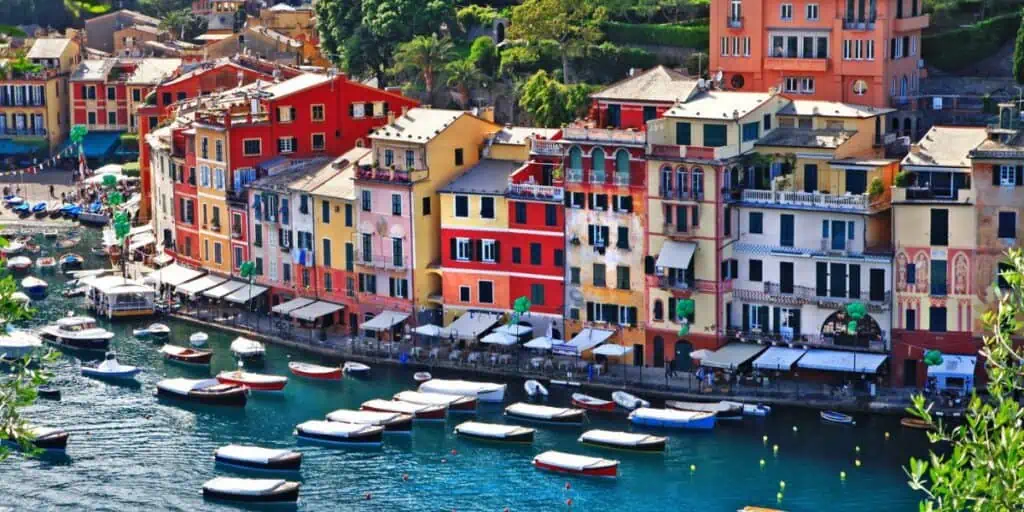
Recommended by Alex and Leah on Tour
Portofino is an absolutely beautiful village on the Italian Riviera coastline in northern Italy. It’s extremely popular with celebrities worldwide, and once you visit, you’ll know why!
The best way to get to Portofino is by taking the train from Genoa to Saint Magherita before hopping on a direct bus to the village. The bus trip is an experience; snaking along the cliffside, you’ll see magnificent views across the Tyrrhenian Sea.
Despite being a small fishing village, there is much more to do than meets the eye. Firstly, if you have the budget or just fancy a nose, you definitely need to pop into all the designer shops that line the cobbled street.
We’d then recommend going for a wander around the harbor before settling down for an alcoholic beverage, coffee, or even some food. Whilst (obviously) expensive, the food is fantastic, and you MUST have an Aperol Spritz!
If you’re more of an adventurer, you definitely need to hike up to Castelletto or Faro di Portofino, as the views are unbelievable.
Don’t worry if that doesn’t appeal to you; you can always sit on the edge of the Marina di Portofino pier, look back at Portofino’s beautiful, multi-colored buildings, and watch the world go by.
Cortina d’Ampezzo, Veneto
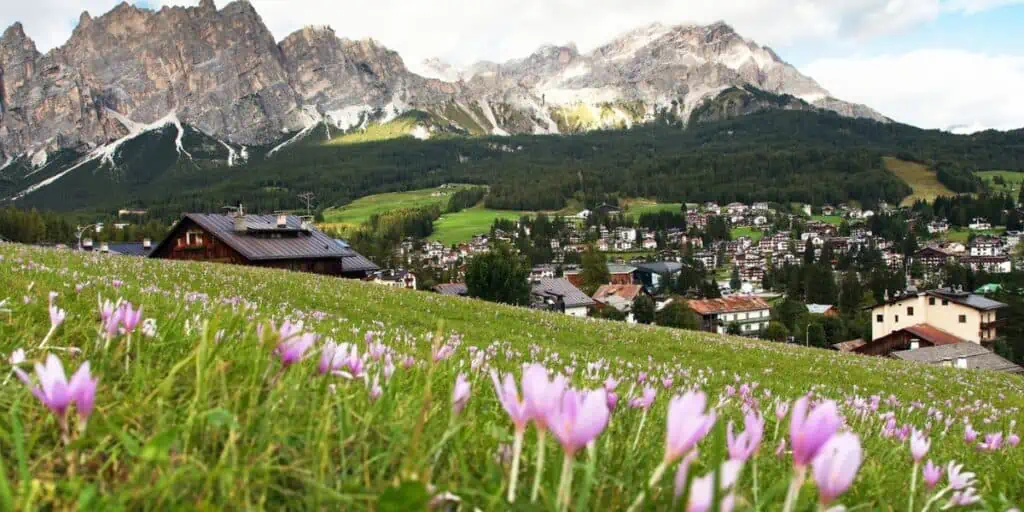
Recommended by Morgan of Crave the Planet
You don’t have to be a mountaineer and eat dried food to experience out-of-this-world hiking with breathtaking views– even with your kids or mobility-impaired friends and family. Everyone should travel to Italy to experience the magnificent cities, but it’s a hustle and touristic bustle that can leave you or your family well-fed but drained. Cortina d’Ampezzo, nestled high in the Dolomites in northern Italy, is a must-see for people who love nature with a dose of good food and wine.
Fortunately, it’s only a 2-hour drive or bus ride from the international airport in Venice to the stunning mountain village of Cortina d’Ampezzo, filled with history, great food, and luxury spas. The incredible thing about Cortina d’Ampezzo and the Italian Dolomites is the chance to walk easily at high elevations with minimal effort and no special training.
Gondolas and chair lifts run in summer for those not inclined to hike to the top so that everyone can experience some of the most spectacular views in the world, like the Cinque Torri Rock formation.
Directly on these trails sit mountain huts called “rifugios,” like Rifugio Lagazuoi. These huts serve delicious cuisine, great local wines, and views that make you think you’re on top of the world.
Best things to do: Rent bikes, people watch in the village center, do an exciting Via Ferrata, do a day hike around Lago di Braies, or do a hut-to-hut hike and feel like a mountaineer without having to rough it by staying in gorgeous huts each night.
Cortina merges Italian and outdoor culture like no other place. It’s a great winter and summer destination for skiing, hiking, or doing a spa on the top of a mountain. Stay at Cristallo’s luxury spa overlooking Cortina d’Ampezzo, which has no details left out. It’s pure luxury.
Venice, Veneto
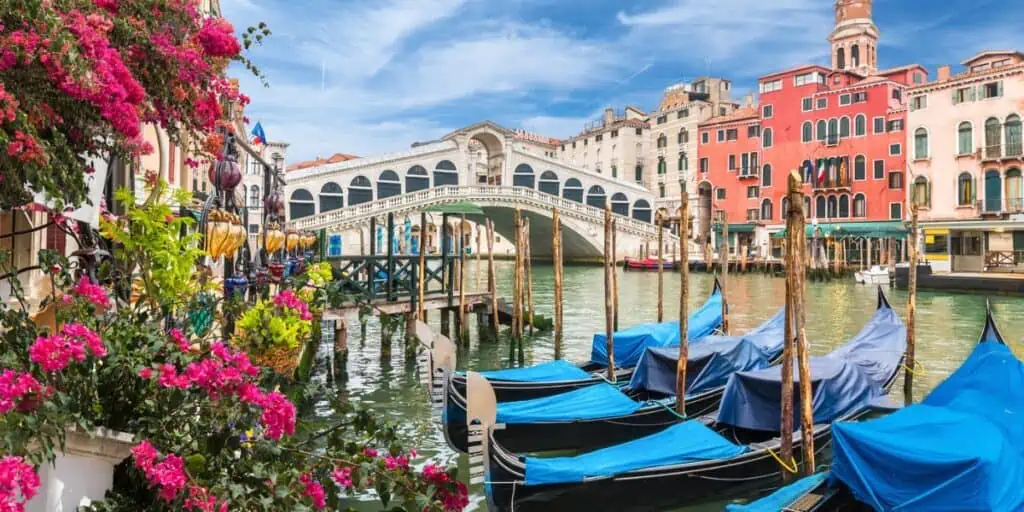
Recommended by Angela of Where Angie Wanders
Venice is a must-visit destination in northern Italy; once you have experienced its history and beauty, you will want to return time and time again. Italy’s floating city is the only place in the world fully pedestrianized, and the only traffic jams you will find here are caused by boats.
Getting around Venice by water can seem complicated on a first visit; however, with waterbuses, water taxis, and gondolas, you can be sure to get around the city easily and quickly. Arriving in the city center from the airport by water taxi is a fantastic experience reminiscent of a James Bond movie! Looking for somewhere to stay? Click here for places to stay while in Venice .
St. Mark’s Square is the main tourist area in Venice, and visitors arrive to admire the centuries-old Venetian/Roman architecture of St. Mark’s Basilica. In the square, you will also find the Bell Tower and Doges Palace. This area is always busy, but walk away from it, and within 10 minutes, you will find yourself in quiet backstreets where you can wander freely without the crowds.
Finding good Italian cuisine should definitely be on your Venice itinerary . Don’t buy food and drink in St. Mark’s Square – the prices are extortionate – instead, find one of the numerous cafes that sell cicchetti. This is the traditional food of Venice – similar to tapas – and can be accompanied by local wine. It is a cheap and tasty way of eating in Venice, with dishes usually costing no more than €2 each. Here’s a
If you have time, make a day trip from Venice to Burano, the Italian island famous for its incredible rainbow-colored houses, freshly caught fish, and lace-making.
Alba, Piedmont
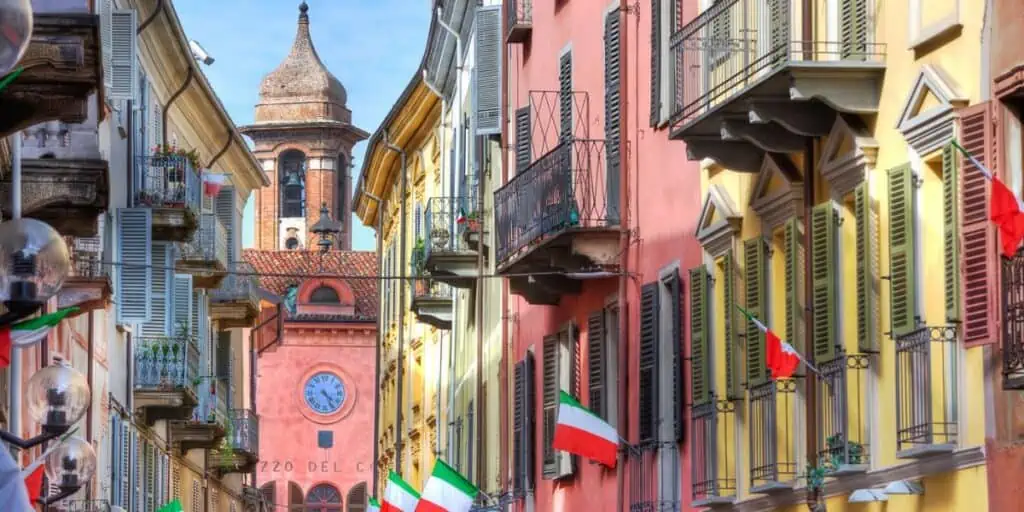
Recommended by Denise of Chef Denise
Alba in the Piemonte region should be on your must-visit list when traveling to northern Italy. Just an hour and a half south of Turin, you will find some of the best wines of Italy and, of course, their world-famous white truffles. This picturesque village is easily walkable in an hour or two. This is definitely a foodie town with quaint squares, a pink church, and many restaurants.
The traditional dishes in Alba are not usually marinara sauce based. Think mushrooms, truffles, olive oil, and cream. You should not leave Alba without ordering a mouthwatering truffle dish unless you are allergic.
If truffles make you swoon, visiting the International White Truffle Fair from mid-October to mid-November is like a trip to heaven. Special dinners and tastings of these culinary diamonds abound.
But even if you cannot make it to the festival, truffles will be on offer at any time of year. Make sure to purchase some truffle oil and truffle paste to take home. They make great souvenirs and gifts and will last longer than any you buy at home.
Also, try one of the most famous dishes of Alba and the Piemonte region, Brasato al Barolo—tender beef marinated in Barolo wine with vegetables and herbs. If you think the wine can’t be good if they’re cooking with it, think again!
Alba is a great hub for visiting local wineries and enotecas (wine bars or shops). Barolo is not just a wine varietal; it’s a village and a short drive from Alba. You can easily visit Barolo and Barbaresco, where Nebbiolo grapes are grown in one day. Enjoy a beautiful ride through rolling hills and vineyards. Enjoy sipping the local wine, then stroll through the charming villages.
Val di Susa, Piedmont
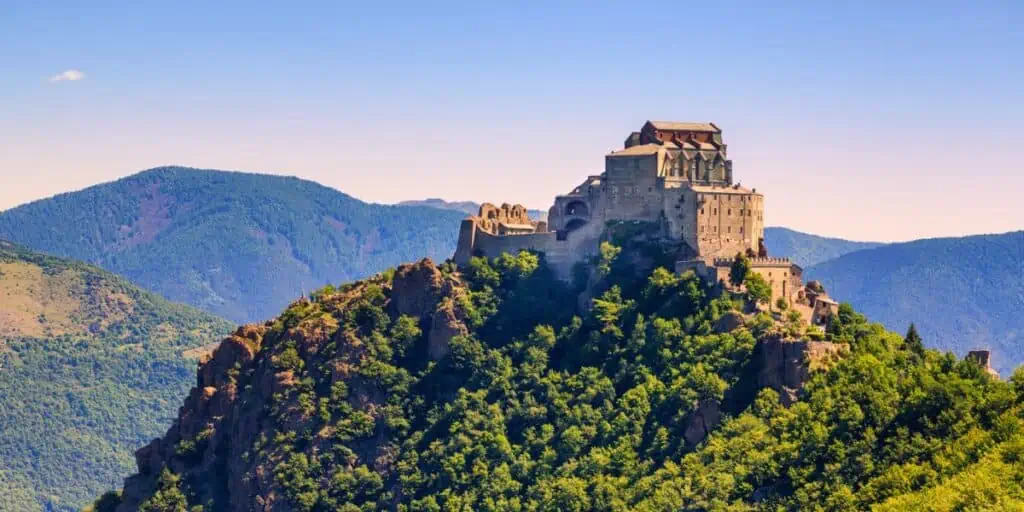
Recommended by Linda of Insieme-Piemonte.com
Being the symbol of the Piedmont region, you will have to visit the impressive Sacra di San Michele when traveling in northern Italy. It is also known as Saint Michael’s Abbey. Sound familiar? That is because author Umberto Eco was inspired by the powerful abbey for his bestselling book “The Name of the Rose.”
Located only 40km from Piedmont’s capital, Turin, the massive Sacra di San Michele is high above Susa Valley. At 962 meters above sea level, it is not only rich in history but also offers fantastic views of the Italian, Swiss, and French Alps—and even Turin.
Built between 983 and 987, the ancient abbey had its best years in the 13 th century. During that time, there were about 1000 monks living in it permanently, plus pilgrims from the north traveling to Rome.
Via the QR code on the self-guided tour, you will get all the essential and interesting information on the abbey’s history directly to your cell phone. This will allow you to discover the gigantic building at your own pace.
You will pass the “stairways of the dead” to reach the main church from the 12 th century. Several members of the Savoy, one of the oldest royal families in the world, are buried in it.
The Sacra di San Michele area offers some fantastic hiking trails and a via Ferrata for climbers. You will have outstanding views of the abbey, the valley, and the Alps.
Turin, Piedmont
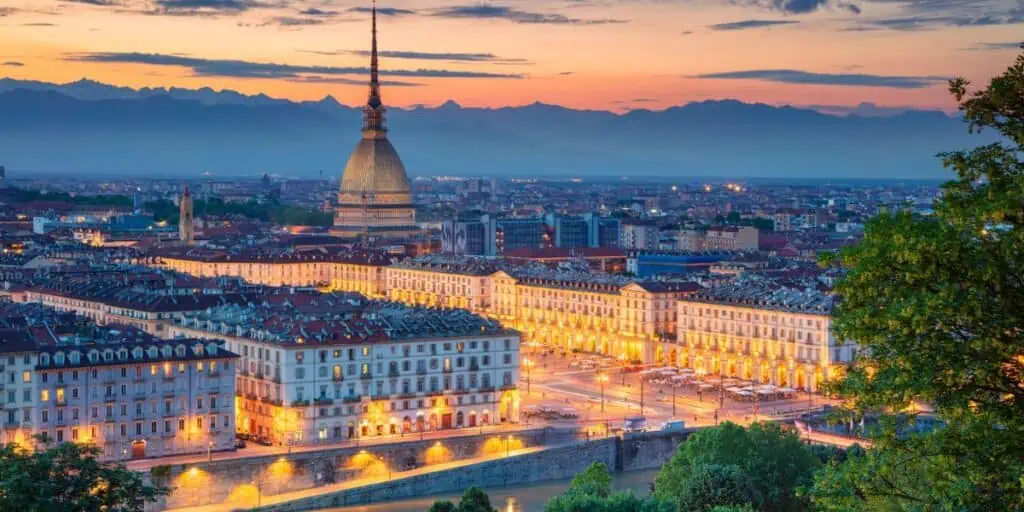
Recommended by Teresa
The first capital of the Kingdom of Italy was built between 1861 and 1865. Today, Turin is a fantastic city. Turin, located in Northern Italy, is a combination of various European styles and modernity that must be added to your bucket list. In the past, Turin was famous as the house of the Italian monarchy; today, it is famous for industries such as FIAT and many others.
The Chapel of the Holy Shroud is a really important cathedral famous for housing the Holy Shroud. The Pope decides when to expose the Holy Shroud, and the expositions usually last 45 days.
The most critical and principal square of Turin is San Carlo Square. The square is very nice and elegant, with two twin churches at the end, the Equestrian monument wanted by the leader of the Savoy dynasty in the middle and beautiful arcades with historical and chic cafes all around.
If you are looking for a breathtaking view and a splendid church, visit the Basilica of Superga.
The Egyptian Museum houses the most extensive collection of Egyptian antiquities. It was founded in 1894 by King Carlo Felice di Savoia and has grown.
The symbol of Turin is the Mole Antoneliana. From the top, you can have a 360-degree view, and inside, there is a stunning and exciting museum of cinema.
The Reggia di Venaria, a UNESCO World Heritage site, is a beautiful day trip not too far away from Turin. You can spend a whole day wandering through rooms and the palace’s beautiful gardens.
Like all of Italy, Turin is known for its delicious food. Find a traditional restaurant and try the Agnolotti or the Vitello Tonnato, all accompanied by wine.
Val Chisone, Piedmont
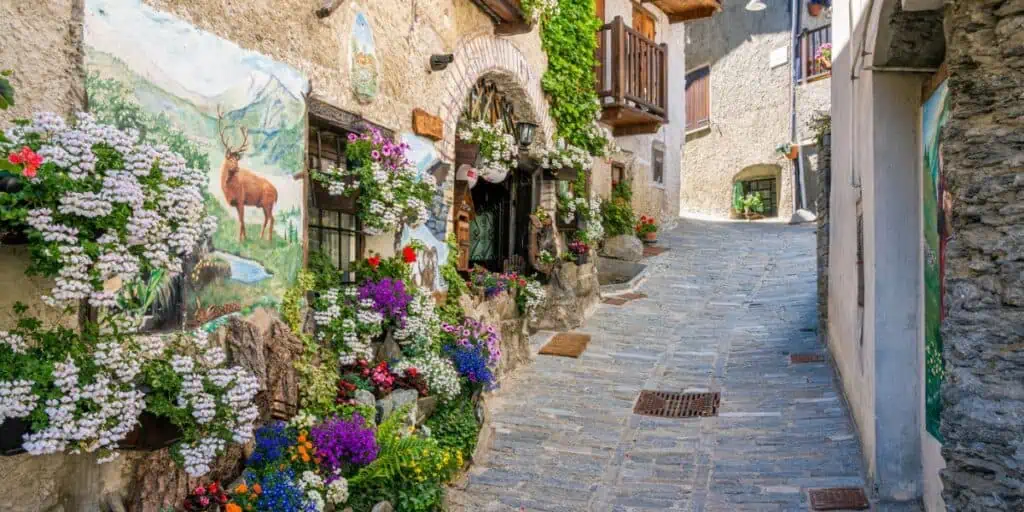
Recommended by Linda of HikingTheAlps.com
When traveling in northern Italy, you will see several fascinating medieval forts and castles, but none is as impressive as the Forte di Fenestrelle.
Located in the middle of beautiful Val Chisone, 85km west of Piedmont’s capital, Turin, the powerful fort can be admired from afar. It is the largest Alpine fortress in Europe!
The fortified complex, covering an area of about 1.3 million square meters, consists of three different forts. They are joined by a tunnel inside the massive fortress wall, which runs the longest covered staircase in Europe. You will have to climb 4000 steps, 3km from Fort San Carlo in the valley to Fort delle Valli at 1800 meters above sea level, and overcome a 635-meter height difference.
The mighty fortification, which was built starting in 1728, took 122 years to complete. It was intended to defend against foreign invasions, but it was mainly used as a garrison and prison.
Abandoned after the Second World War, that outstanding construction can be visited today. There are full-day guided tours (only in Italian) or a short self-guided option. To experience and appreciate the dimension of that stunning building, you should combine an inside tour with a fantastic hike to Usseaux , one of the most beautiful villages in Piedmont.
Lake Como, Lombardy
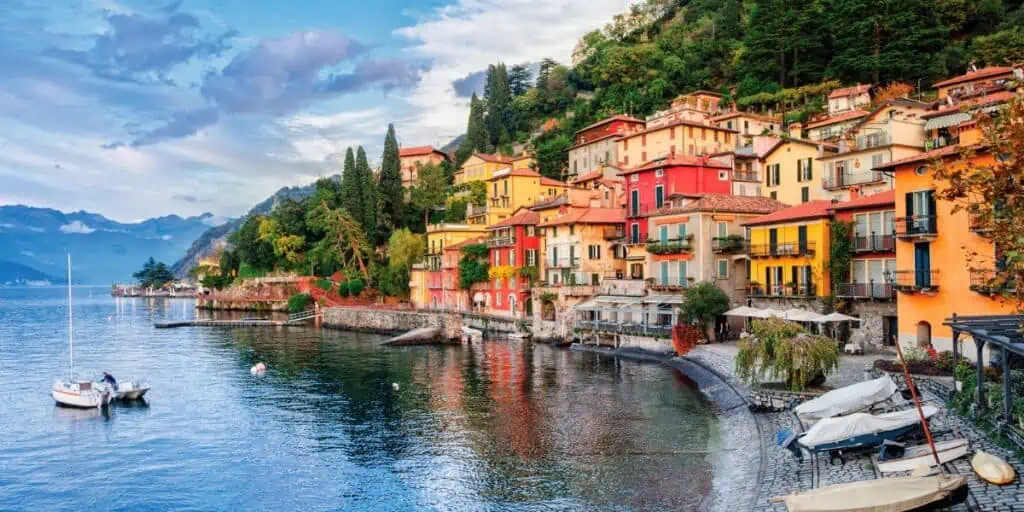
Recommended by Krisztina of SheWandersAbroad.com
If you’re looking for the best places to visit in Northern Italy, don’t miss out on Lake Como! This beautiful destination is perfect for a romantic getaway or a family vacation. With its stunning scenery and lovely towns, Lake Como will surely please everyone.
It’s one of the biggest lakes in Italy, and since it’s located only a one-hour train ride away from Milan, it’s a great day trip opportunity. However, if you want to explore the area properly, it’s worth spending at least 2-3 days at Lake Como.
Bellagio is one of the most popular towns on Lake Como, and it’s easy to see why. With its beautiful buildings and stunning views, Bellagio is a must-see when you’re in the area, and it’s also one of the best places for first-timers to stay in Lake Como. Be sure to walk around the town center to admire the architecture, and don’t forget to take a boat ride on the lake for some truly breathtaking views.
If you’re looking for a more low-key town, Tremezzo might be the place for you. This town is known for its pretty gardens, and it’s a great place to relax and take in the scenery. There are also some great restaurants here if you want to try some local cuisines.
Milan, Lombardy
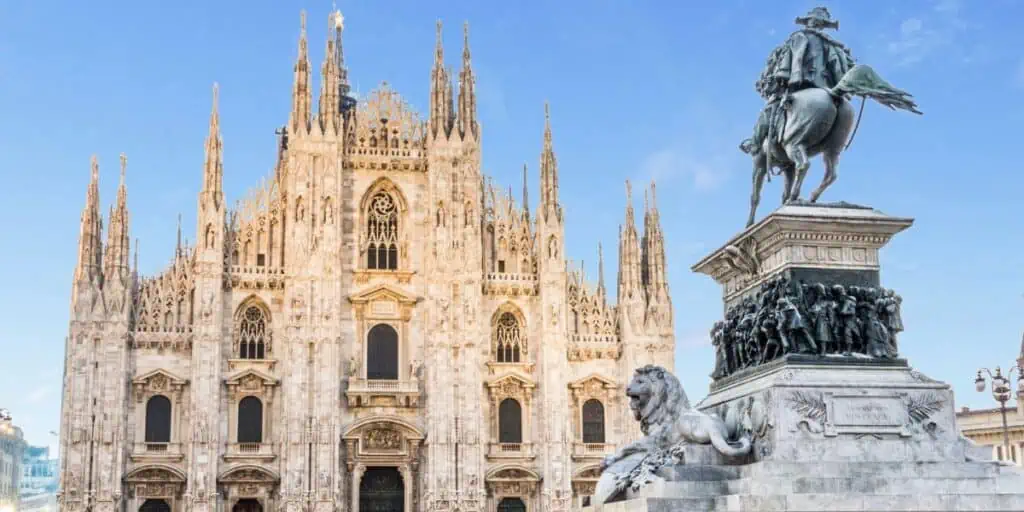
Recommended by Greta of Greta’s Travels
If you’re looking for the best places to visit in Northern Italy, add Milano. Milano is known as the City of Fashion; it’s the economic capital of Italy and the capital of the Lombardy region of Italy.
Milan is an iconic destination, both for its historical and cultural aspects and the modern pull of fashion and innovation. From the new trendy skyscrapers of Piazza Gae Aulenti to the cobbled streets of Brera, Milan has something to offer every type of traveler.
You could live in Milan and still not see it all. However, most travelers consider one day in Milan a good amount. In one day, you’ll be able to see all the highlights of the city, starting from Piazza del Duomo and Galleria Vittorio Emanuele, going on to Brera neighborhood, Castello Sforzesco, Arco della Pace, and then ending your day with a Milanese aperitivo at Navigli.
The best time to visit Milan is in late spring or early summer when the weather is good, the days are long, and you can easily get around the city on foot. You can still visit at other times of the year, but in summer, it gets very hot, and the weather in winter won’t make for a fun experience.
You can’t miss visiting the rooftop of the Duomo Cathedral . From here, you will get stunning views over the Piazza del Duomo and the rooftops of Milan. Head there at sunset for the most gorgeous golden light!
Bologna, Emilia-Romagna
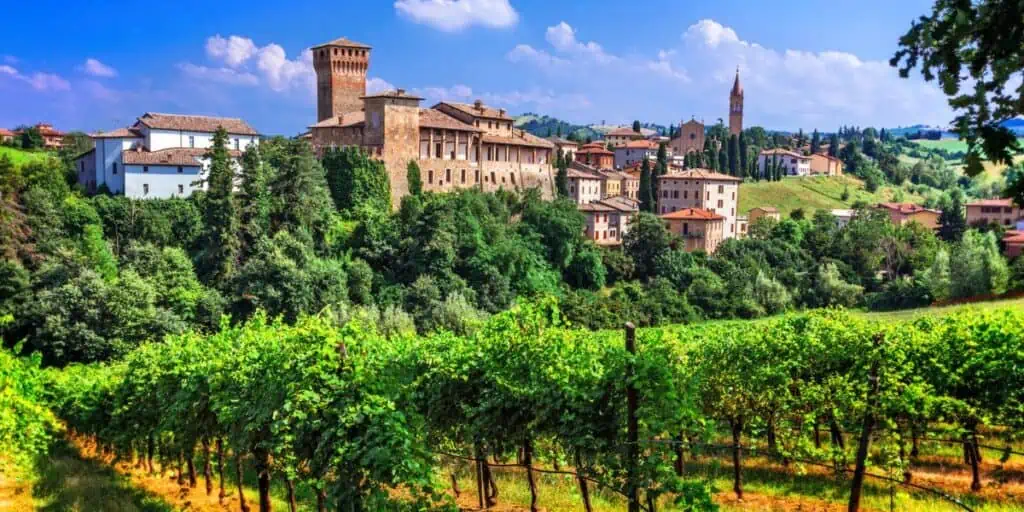
Recommended by Lori of Italy Foodies
Bologna, in northern Italy, is known for its well-preserved medieval buildings and the magnificent UNESCO porticoes stretching across the city. But for all that, Bologna is also known as the “culinary capital of Italy” for producing some of the country’s most unique foods, including prosciutto, parmigiano reggiano cheese, and balsamic vinegar, all found locally on every menu.
The city is not as flashy as its neighbors, Florence and Venice, and therefore is undoubtedly one of Italy’s most under-visited cities. But there’s plenty to keep you occupied for a week or more.
A favorite activity is strolling the Piazza Maggiore in the heart of Bologna. Centuries-old medieval buildings, including the main cathedral, Basilica di San Petronio, surround the huge piazza. Here, you’ll find coffee shops and outdoor cafes serving pastries, sandwiches, and, of course, excellent regional wines.
If you’re a foodie, next door to the Piazza Maggiore is the oldest market in Bologna, the Quadrilatero, where you can walk the narrow cobblestone streets and shop for local Italian bread , meats, and cheeses or dine at some of the city’s best eateries.
Bologna once boasted 125 medieval towers, but only about 25 remain. One of the tallest is the Asinelli Tower, the only one you can climb—and you should! The panoramic views over Bologna are worth the climb.
Bologna is also home to fast-performance cars; a day trip to the “Motor Valley” should be on your list. The world headquarters of Ferrari, Lamborghini, and Maserati are fascinating places to visit for car buffs or anyone looking for a true Bolognese experience.
Visiting Northern Italy

When planning a trip to northern Italy, there are many different cities and attractions that you must not miss. Milan, of course, is at the top of the list, with its beautiful architecture and buzzing cultural scene. There are also many lovely small towns in this region to explore.
And just outside of Milan is Lake Como, one of the most breathtaking destinations in the region. With its deep blue waters and snow-capped mountains in the distance, it is truly a sight to behold. Whether looking for great food and wine or incredible natural beauty, northern Italy is truly amazing!
This article originally appeared on Wander With Alex .
Alexandrea Sumuel is a nationally syndicated travel writer and founder of the Wander With Alex travel blog. Her work has appeared on MSN, YAHOO!, Euronews, and FOX, ABC, and NBC affiliates across the United States.
Alex travels to experience, eat, explore, and occasionally escape! She collaborates with destinations, vacation property management companies, and hospitality technology firms to provide her readers with exclusive insights and information.

10-Day Northern Italy Itinerary: 2 Perfect Routes
Last Updated on January 3, 2024
by Maggie Turansky
Disclaimer: This article contains affiliate links. That means if you click a link and make a purchase, we may make a small commission. As an Amazon Associate we earn from qualifying purchases. For more information, see our privacy policy.

If you’re planning a Northern Italy itinerary, it can be tough to map out the ideal route if you only have a limited amount of time. There is a lot to see in the north of this diverse country — from beautiful cities to storied lakes to incredible coastline — that there is absolutely no way one can pack everything into just 10 days in Northern Italy.
However, if you know what you want to see and adequately plan out your time, you can see a lot in 10 days if you simply prioritise your top destinations.
Whether you’re after a Milan-Venice-Lake Como itinerary or you’re searching for something that loops you through Emilia-Romagna and Liguria, the routes below are sure to help you plan out your perfect trip to Northern Italy!
Table of Contents
Getting To & Around Northern Italy
Whether you’re looking to map out a route by train or would like to opt for a North Italy road trip, it is important to discuss A) how to get to your desired destination and B) how you plan to get around whilst there.
We will start with the first point. Both of the routes outlined below begin in Milan and that is for good reason – Milan Malpensa Airport is the second highest traffic airport in Italy and it’s also the second-largest city in the country. This means that it is the most logical starting-off point if you’re visiting Northern Italy.
There are a few other airports near Milan that can also be a point of entry into the region – especially if you’re flying a budget airline from elsewhere in Italy or from Europe in general.
I’m speaking of the Bergamo airport, which is often billed as the “Milan Bergamo Airport” but do keep in mind that this airport is in the city of Bergamo and is located about one hour from Milan’s train station itself – though it is easy to reach Milan.

There are other airports in most of the cities that are mentioned in both routes, including Venice, Bologna and Genoa, however, they are smaller and not as many flights go to them from as many destinations.
When it comes to getting around on your trip to Northern Italy, you also have a few options open to you. By far the easiest way to go on either of the routes listed below would be by car. This will help you save time and also allow you to make stops along the way and reach further-flung places.
Driving in Northern Italy is easy and holds none of the stressors that you may experience in the south of the country.
You don’t need a car to get around the major cities like Milan, Venice, Bologna, Bergamo, Verona and Genoa, meaning that it makes the most sense to find a place to park your car and use public transit (or your own two feet) while in these destinations. However, having your own vehicle can make day trips exceptionally easy and convenient.
Having your own car is also ideal for exploring Lakes Como and Garda as, again, it gives you a lot more flexibility. You can browse Rentalcars.com to compare prices on rental cars.
However, if you don’t want to rent a car or don’t drive for whatever reason, both of the routes outlined below are also doable via train with a few considerations in mind.
You likely won’t be able to see as much as you could if you had your own vehicle just because coordinating timetables can be tricky, but that doesn’t mean you will have any less of a fulfilling trip to Northern Italy. You can browse schedules and book train tickets here.

Lombardy & Veneto in 10 Days
This itinerary for Northern Italy is perfect for those who want to see the well-known highlights of the region including Milan, Venice and Lake Como. There are also a couple of lesser-visited gems on this route to ensure you have a varied and interesting time exploring the Lombardy and Veneto regions – two of the best places in Northern Italy to visit.
Day 1 – Milan
Plan to spend the first day of your Northern Italy trip exploring the highlights of Milan . Italy’s second-largest city has a lot to offer visitors and you need to spend at least 2 full days getting to know the city.
Your first day should be dedicated to seeing all of the main sites of the city. Begin your day at the iconic Milan Duomo – the city’s main cathedral. A visit here can take several hours and is truly spectacular. You can pre-book tickets here .
You can fill the rest of your day wandering by the Royal Palace, the Museo de Novecento, the Galleria Vittoria Emanuele II and, of course, the famous Teatro La Scala. Plan to spend at least two nights in Milan before moving on to your next destination.

Where to Stay in Milan
Lancaster Hotel – If you’re visiting the Lombardy capital on a mid-range budget, then this classical hotel is a great option. Located in the centre of Milan within walking distance of the city’s top attractions, they have a range of great rooms to choose from and breakfast included for guests each morning.
Castello Guest House Milano – This luxury guesthouse is an excellent choice for those after a bit of a splurge while visiting Milan. Well-located for exploring the highlights of the city within a stone’s throw, they have countless lovely rooms on offer and plenty of other amenities to enjoy, as well.
QUO Milano – Budget and solo travellers will love this centrally-located hostel. Well situated for exploring the best Milan has to offer, it is one of the highest-rated hostels in the city and they offer both dorms and private rooms.
Not quite what you’re looking for? Click here to browse more Milan hotels!
Day 2 – Milan
Your second day in Milan should be spent getting to know the city just a little bit better. Check out some of the city’s smaller churches, some cool areas and, of course, one of the most famous paintings in the world – da Vinci’s “Last Supper.”
Start your day at the Basilica di Sant’Ambrogio before making your way over to the Chiesa di Santa Maria Delle Grazie where you can view the Last Supper. Afterwards, you can go over and explore Castello Sforzesco and tranquil Sempione Park.
End your day by exploring the hip and happening Navigli district, which is a great place to partake in Italy’s favourite pre-dinner pastime – aperitivo!

Day 3 – Lake Como
Day 3 of this North Italy itinerary takes you out of Milan and to beautiful Lake Como . Keep in mind that it is best and easiest to explore Lake Como if you have your own car, however, it is still possible to see a lot of the villages by relying on the extensive ferry system around the lake.
Many treat Lake Como as a day trip from Milan , however, it is best to spend at least a couple of days here to really get a good feel for this beautiful area.
Plan to spend your first day in Lake Como exploring the iconic villages around the lake – Bellagio, Menaggio and Varenna. These three villages are well-connected by ferry and you can very easily enjoy this day without your own car.
Each village is small and has its own charm so make sure to take your time to get lost in the beautiful little streets and take in tons of incomparable lakeside views.

Where to Stay in Lake Como
B&B Villa Rosalinda – This bed and breakfast in the quiet town of Dongo in the north of Lake Como is a great option for those looking for a tranquil escape on the lake. They have a number of clean and comfortable rooms to choose from and offer breakfast to guests each morning.
Villa Lario Resort Mandello – Luxury travellers will swoon over this beautiful hotel located in the town of Mandello del Lario – about fifteen minutes south of quaint Varenna. They have countless luxe rooms to choose from and an extensive list of amenities to ensure that your stay is absolutely perfect.
Miralago B&B and Apartments – This bed and breakfast located just outside of Bellagio offers both en-suite rooms and some apartment options for those looking for a comfortable self-catering notion. They are in a great area for exploring Lake Como and breakfast is available upon request.
Not quite what you’re looking for? Click here to browse more Lake Como hotels!
Day 4 – Lake Como
Dedicate day 4 to exploring some of Lake Como’s larger cities and also taking in one of the lake’s famous villas and their beautiful gardens.
Spend your morning touring a villa – there are countless to choose from on Lake Como. It’s best to get to whichever villa you choose as early as possible as they can get very busy and popular, especially if you’re travelling in the high season.
Your afternoon can be spent exploring the cities of Como and Lecco, both located on either end of the south of the lake.
Keep in mind that if you’re keen to visit both of these cities in a day, it’s best if you have your own car. If you’re relying on the ferry system on Lake Como, then plan to simply spend your afternoon in Como and maybe go on a cruise or boat tour on the lake to enjoy it from a different perspective.

Day 5 – Bergamo
On day 5, it’s time to leave Lake Como and drive about an hour to the lovely city of Bergamo. Though its airport acts as a hub for a number of budget airlines across Europe, not enough visitors take the time to explore this delightful city and this is really a shame – it has a lot to offer.
Its compact nature means that you only really need to spend one day in Bergamo to do it justice. Split over two parts – the Citta Alta and Citta Bassa – the majority of the historic sites lie in the Citta Alta, so that is where you will likely dedicate the majority of your time.
You can take the funicular up to the Citta Alta before taking in Piazza Vecchia – Bergamo’s main square. Take another funicular up to the Castello di San Viglia where you can get fantastic views of the city from above. We recommend walking down and making a stop in the botanical gardens on your way.
Later, explore the Duomo di Bergamo and the Basilica di Santa Maria Maggiore. And if you want even more fantastic views of the city, head up the Campanone tower. Then make your way down, on foot, to the Citta Bassa. You will walk along the Venetian Walls, which are a UNESCO World Heritage Site.
End your day in Citta Bassa for aperitivo and dinner with the locals.
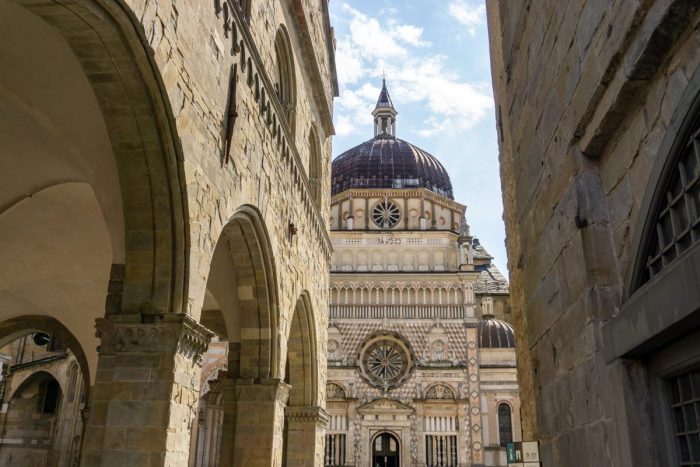
Where to Stay in Bergamo
B&B Entro Le Mura – Located in Citta Alta close to all the top sites in Bergamo, this bed and breakfast is an excellent option for mid-range travellers. They offer a number of cosy rooms to choose from and, of course, breakfast is included for guests to enjoy each morning.
Petronilla – This luxury hotel located in Citta Bassa is great for those looking for a plush stay in Bergamo. Well located for exploring all this wonderful little city has to offer, they have a number of rooms on offer, there is an on-site restaurant/bar and they even allow pets.
Not quite what you’re looking for? Click here to browse more Bergamo hotels!
Day 6 – Lake Garda
From Bergamo, it’s time to head to the incredible Lake Garda for the sixth day of your itinerary. Though you could easily spend 2 or 3 days in Lake Garda, you can get a good feel for the lake and some of its towns in just one day, as well.
Where you decide to go in Lake Garda really depends on if you have a car or not, as the lake can be difficult to navigate without your own vehicle. Keeping that in mind, if you’re doing your Northern Italy itinerary by train, plan to explore the area in and around Sirmione, which has easy train connections.
If you have a car, you have the option to go wherever you choose on the lake, however, keep in mind that this is the largest lake in Italy and it may take some time to drive between places.
You can opt to spend the morning in Sirmione before heading up the western side of Garda and exploring the towns of Salo, Maderno and Gargnano.
Alternatively, you could spend your time at the north of Lake Garda and explore the towns of Limone and Riva del Garda before heading down the eastern coast to lovely Malcesine.
Plan to spend the next two nights on Lake Garda – there are lots of lovely towns to stay in on the lake .

Where to Stay in Lake Garda
Ambienthotel PrimaLuna – This hotel is an excellent mid-range hotel in Lake Garda. Located in the lovely town of Malcesine, they have a number of lovely rooms to choose from and there is even a great swimming pool to enjoy and a fantastic breakfast available for guests each morning.
Grand Hotel Fasano – Located in Gardone Riviera between the towns of Salo and Maderno on Lake Garda’s western side, this hotel is perfect for those after a bit of luxury when visiting Italy’s largest lake. They have a number of plush rooms to choose from, two swimming pools to enjoy and an on-site bar, spa and wellness centre.
Blue Sky Garda – This two-bedroom apartment can be a great option on Lake Garda if you’re after the convenience and privacy of your own flat. Situated in the town of Malcesine on the eastern side of the lake, its location is perfect for exploring the area.
Not quite what you’re looking for? Click here to browse more Lake Garda hotels!
Day 7 – Verona
From Lake Garda, it’s time to head to nearby Verona. An oft-overlooked city in the Veneto region, Verona is perhaps most well known for being the setting of Shakespeare’s Romeo & Juliet , however, this city has a lot more to offer than just that.
Much like Lake Garda, you could easily spend 2 or 3 days in Verona , however, you can also see the highlights of this compact city in just a simple day trip , which is what we recommend here.
During your day in Verona, make sure not to miss the Casa di Giulietta (Juliet’s house) and, of course, the Verona Arena.
The arena is an impressive Roman colosseum that attracts only a fraction of the crowds found at the most famous one in Rome. There are plenty of other Roman ruins to enjoy in Verona, not just this incredible arena.
Plan to spend your night on Lake Garda before heading to Venice the next day.

Day 8 – Venice
Generally, no visit to Northern Italy is considered complete without visiting the iconic city of Venice.
This is a city that needs no introduction but keep in mind that the city has been struggling under the stresses of overtourism and it is important to spend a good amount of time here in order to travel a bit more sustainably and have the most benefit to the local economy. That is why we recommend spending up to 3 days in Venice.
Spend your first day in this city of canals taking in the top and most iconic sites. These include, of course, the Rialto Bridge and St Mark’s Square. Make sure to take your time to simply enjoy the ambience of this incredible city and even get out onto the canals on a gondola!
Spend your evening in a cosy taverna eating local fare and simply enjoying the final destination on your fantastic itinerary through Northern Italy.

Where to Stay in Venice
Ca’ Angeli – This hotel in the San Polo neighbourhood only has 6 rooms on offer, but it is a great choice for those looking for a wonderful, central place to stay when exploring Venice. They have a number of great amenities for guests to enjoy along with a wonderful breakfast on offer each morning.
Riva del Vin Boutique Hotel – Located within spitting distance of the iconic Rialto Bridge, this is the perfect place for a luxury escape to Venice. Couples are sure to love the chic rooms on offer and there is also an on-site bar and wonderful breakfast included each morning.
Combo Venezia – Those looking to save as much money in notoriously expensive Venice as possible will love this small, locally-run hostel. Perfect for solo travellers, as well, it is located in the cool Cannaregio neighbourhood and they have a range of dorms and privates available along with great common areas.
Not quite what you’re looking for? Click here to browse more Venice hotels!
Day 9 – Venice
Your second day in Venice should be spent digging a little bit deeper and enjoying some of the lesser visited neighbourhoods of the city – the places where the Venice locals live away from the tourist crowds.
Start your morning by wandering around the historic San Polo neighbourhood before making your way over to the lovely Dorsoduro neighbourhood. Cross over the Accademia Bridge back to the historic, central San Marco neighbourhood to round out your afternoon.
In the evening, head to the lively Cannaregio neighbourhood in order to get a real local feel and to dine at a wonderful Venetian restaurant!

Day 10 – Venice
On the final day of your trip, you’re still in Venice and it’s time to explore some of the islands off the coast of this incredible city. The most famous of these islands include Murano and Burano, known for their incredibly colourful houses and charming atmosphere.
If the season is right, you could also use this day as a beach day, lounging on one of the many sandy stretches close to the city. You can book a tour here.
Alternatively, you could opt to go on a day trip to the nearby Prosecco region and sip some of the area’s eponymous Sparking wine. Another popular day trip option is to the town of Treviso, which is located just outside of Venice and worth the journey.

Lombardy, Emilia-Romagna & Liguria in 10 Days
Also beginning in Milan, this 10-day itinerary is great for those looking for something different from the routes that include the lakes and Venice (such as the one outlined above).
Winding you through gastronomic Emilia-Romagna before ending in gorgeous Liguria, you’re sure to fall in love with this area of Northern Italy.
Begin day one of this route through Northern Italy in the vibrant city of Milan. As mentioned in the route outlined above, spend this first day exploring the highlights of the city centre, including the Milan Duomo and the Teatro La Scala.
End your day like the Milanese do with an aperitivo before heading out to dinner. Plan to spend three nights in Milan for this itinerary, though we will only spend 2 full days exploring the city proper.

Your second day in Milan should be spent seeing all of the sites in the city that you didn’t get to on your first day in the city. This includes various churches, viewing Leonardo da Vinci’s The Last Supper and relaxing in a tranquil park.
Spend your evening exploring the hip and happening Navigli district where you can get an authentic taste of Milanese life away from throngs of tourist crowds.
Day 3 – Lake Como or Bergamo
The third day in Milan should be spent on a day trip – where to is up to you! Milan makes for an excellent base to explore a couple of nearby areas, so you have a couple of options open to you.
If you’d like to head to the Italian lakes, then a day trip to Lake Como is definitely in the cards. You can hop on a train to Varenna and spend the day riding the ferries between beautiful Menaggio, Bellagio and Varenna itself. Alternatively, you can organise a guided tour here.
Alternatively, if you want to explore a city that isn’t on the radar of a lot of international visitors to the Lombardy region, consider going on a day trip to historic Bergamo.
Bergamo has a lot to offer visitors and it is an absolutely beautiful city to visit and spend some time in. One day is definitely enough to see all of the highlights of this lovely place.

Day 4 – Modena
Day 4 sees you heading to the incredible Emilia-Romagna region. Your final destination for today will be the region’s capital of Bologna, however, make sure to make a pit stop in the charming city of Modena first.
Modena is known, primarily, for being the homeland of Balsamic vinegar and heading to an acetaia (the place where traditional vinegar is made) is an excellent thing to do in the city. However, there is a lot more on offer here than just that – especially if you’re into food!
Spend your day wandering through the incredible Mercato Albinelli to see what fresh produce and local pastas are made fresh here. Then simply take the time to get lost in the city. Wander through the winding streets and grand piazzas, take in the lively Cathedral and simply enjoy this lovely city.
Modena is located only about a 30-minute drive or train ride from Bologna, so it’s not difficult to end your day in the latter city.

Where to Stay in Bologna
B&B Chez Moi Lame 57 – This cute boutique B&B is perfect for those after a romantic escape to Bologna. They offer a handful of chic, quaint, clean and comfortable rooms on offer and there is a breakfast voucher given to guests daily to dine in a nearby local cafe.
Hotel Metropolitan – If it’s luxury you’re after in Emilia-Romagna’s capital, then this plush hotel is the perfect option. They have an excellent location in the heart of Bologna, myriad chic rooms on offer and countless luxe amenities to ensure your stay is fantastic.
Dopa Hostel – Budget and solo travellers will love this hip hostel located in the centre of Bologna. They have a range of both dorm beds and private rooms on offer, breakfast is included each morning and it’s a great place to meet other travellers.
Not quite what you’re looking for? Click here to browse more Bologna hotels!
Day 5 – Bologna
The fifth day of this route through Northern Italy sees you exploring Emilia-Romagna’s capital city of Bologna . Home to ragu bolognese and plenty of other gastronomic delights, Bologna has a lot to offer visitors beyond its food scene (but it’s totally fine to visit just for that, as well!).
Start your day in Bologna in the Piazza Maggiore, Bologna’s main square. Take in the towers and the Basilica di San Petronio before wandering down Via Rizzoli, the city’s main drag filled with shops. Spend your afternoon and evening exploring the university area – Bologna is home to one of Europe’s oldest universities.
End your day in one of the city’s many restaurants dining on local fare and enjoying every minute.
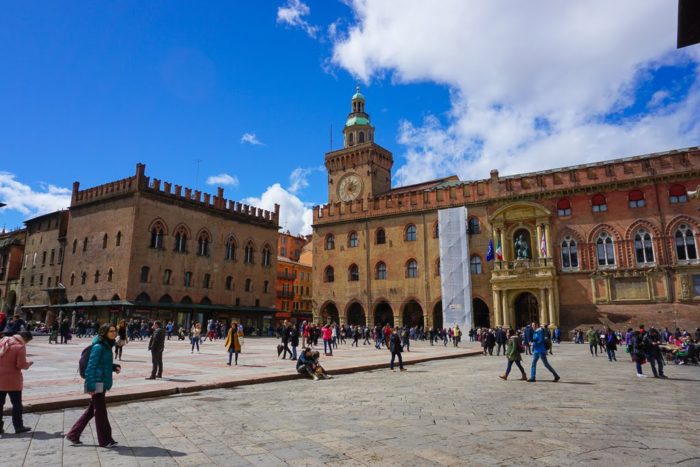
Day 6 – Bologna
On day six of this itinerary, you have the option to either continue exploring Bologna or to go on a day trip to nearby Parma . If you choose the former, there are a number of things that you can choose to occupy your time.
One of the best things to do in Bologna is to go on a food tour – some of the most famous Italian dishes come from this city and it is a great chance to sample them with context.
If you choose to go on a day trip, you can’t go wrong with beautiful Parma. Parma is well-known for being the homeplace of such delicacies as prosciutto di Parma and, of course, Parmigiano Reggiano cheese.
You can sample these to your heart’s desire in Parma, along with exploring what is one of the most charming and historic cities in the region.

Day 7 – Cinque Terre
When you get to your seventh day of this trip through Northern Italy, it’s time to head to another region and area of the country – Liguria and, more specifically, Cinque Terre .
Literally translating to “five villages,” this area is made up of five lovely little towns situated on the dramatic Ligurian coast. These postcard-perfect towns are a can’t-miss destination on this itinerary!
Spend your first day in the main city near Cinque Terra, La Spezia. Though not one of the five villages itself, it is absolutely beautiful and it has a lot to offer visitors.
You can also use this day to explore two of the five villages. Take the time to wander around beautiful Riomaggiore and charming Manarola before calling it a day and resting up for another perfect day of exploration tomorrow.

Where to Stay in Cinque Terre
L’Approdo Dell’Ammiraglio – Those after a good mid-range place to base themselves for exploring Cinque Terre will love this guesthouse in La Spezia. They have numerous lovely and bright rooms on offer and an unbeatable location.
Miramare Apartments&Suites – This aparthotel is great for those after the convenience of an entire apartment with all the benefits of a traditional hotel. Located in La Spezia within easy reach of Cinque Terre, they have a number of different fully-furnished apartments available that range in size.
La Serra Sul Mare – Located in the town of Monterosso, this is one of the best places to stay in Cinque Terre for those looking for a luxury option. They have an unbeatable location within five minutes of the beach, all rooms have their own balcony and there are countless other amenities offered.
Not quite what you’re looking for? Click here to browse more Cinque Terre hotels!
Day 8 – Cinque Terre
Your second day in Cinque Terre should be spent exploring more of the five lovely villages. Start your day in Monterosso al Mare – the largest of five towns that make up Cinque Terre. Known for its beautiful beaches, incredible scenery and charming old town.
From Monterosso, head to the village of Vernazza. This is a gorgeous fortified town with, like all other villages in the region, incredible sea views to enjoy. In fact, this is a great place to enjoy a sunset cruise on the sea, if it suits your fancy.

Day 9 – Genoa
The final destination for this particular 10-day Northern Italy itinerary should end in the Ligurian capital of Genoa. This seaside city is absolutely beautiful and full of interesting things to do – in fact, plan to spend 2 days in Genoa to round out your trip to the north of Italy.
Your first day in Genoa should begin by wandering down Via Garibaldi, the city’s main drag. After getting your bearings, head over to the Palazzi dei Rolli. Once you’ve explored this former palace, visit the San Lorenzo Cathedral.
Of course, no visit to Genoa would be complete without gorging yourself on delicious pesto pasta — the famous basil, pine nut and parmesan sauce hails from this city.

Where to Stay in Genoa
B&B Dormire Dai Grimaldi – Mid-range travellers will love this quaint and cosy bed and breakfast in the centre of Genoa. They offer a number of different en-suite rooms, a lovely communal lounge area and there is a hearty breakfast included each morning.
Hotel Astoria – If you’re after luxury in the Ligurian capital, then this plush hotel is a great option. For those looking for a high-end option, then this luxe hotel is a great choice. They have an excellent central location for exploring Genoa and have a range of lovely rooms to choose from, along with numerous other amenities.
OStellin Genova Hostel – For those looking for a budget option or a great social atmosphere while travelling, then this hostel is a great option. They offer both private rooms and dorm beds and have an excellent location for exploring all Genoa has to offer.
Not quite what you’re looking for? Click here to browse more Genoa hotels!
Day 10 – Genoa
Dedicate the final day of this itinerary to getting to know Genoa just a little bit better. Spend your morning in Genoa along the seaside and visit the renowned Genoa Aquarium which is the largest aquarium in Italy and the largest of its kind in all of Europe.
There is a lot to see here so plan to spend a good amount of time learning about all of the sea creatures here.
In the afternoon, take the time to get lost in the lovely Porto Antico (old port) neighbourhood along the harbour. Dine on delicious, fresh seafood and really make sure to savour you last day of your Northern Italian adventure.

Have 14 Days in Northern Italy?
If you, for example, have 14 days in Northern Italy or more to spend, your options are virtually unlimited. There are so many incredible areas to explore that you won’t struggle to figure out where to go.
If you’re following the first route on this itinerary, you could easily add a visit to the Dolomites after exploring Venice. Spending time in getting to know the regions of Trentino and South Tyrol and taking in the incredible views of the Italian Alps is always worth it with stunning mountain peaks and lakes like Lagi di Braies.
Alternatively, a good place to visit when moving on from Genoa is the city of Turin . As one of Italy’s largest cities, it can be overlooked. However, there is a lot to do in Turin (and in the Piedmont region , in general) that it is definitely.
You could also choose to fuse the two itineraries together for a longer trip through Northern Italy. From Venice in the first route, head to Bologna, Cinque Terre, Genoa and beyond!

Northern Italy is one of the most fascinating regions of the country to explore. With so much to offer, mapping out the ideal 10-day itinerary can be a bit overwhelming, but once you weigh out your priorities, you’re sure to have an exceptional trip.
Are you planning to visit Northern Italy? Have any questions about this itinerary? Let us know in the comments!

Related Posts:
The Ultimate Pisa Day Trip from Florence

Best SIM Card for Italy Travel with Data

The Perfect 2 to 3 Days in Bologna Itinerary

About Maggie Turansky
Maggie is a co-founder and writer for The World Was Here First. Originally from the US, she has lived in five different countries and has travelled to dozens more, both solo and with her partner, Michael. She particularly loves exploring Spain and spending time in the Caucasus and the Baltics. Read more about Maggie
Hi Maggie. It was great reading about northern Italy. We’re planning a southern Italy trip soon. Naples and amalfi coast and around. Could you please send me an itinerary for 15-18 days. Thanks. Paul
Hi Paul, you may find some inspiration in one of our generic Italy itineraries ( https://www.theworldwasherefirst.com/10-day-italy-itinerary/ ), our Amalfi Coast itinerary ( https://www.theworldwasherefirst.com/amalfi-coast-itinerary/ ), our Puglia itinerary ( https://www.theworldwasherefirst.com/puglia-itinerary/ ) and our Sicily itinerary ( https://www.theworldwasherefirst.com/sicily-itinerary/ ). Hope you’re able to plan a great trip!
Leave a Comment Cancel reply

The Perfect Northern Italy Itinerary: 5 Ideas For The Trip Of Your Dreams
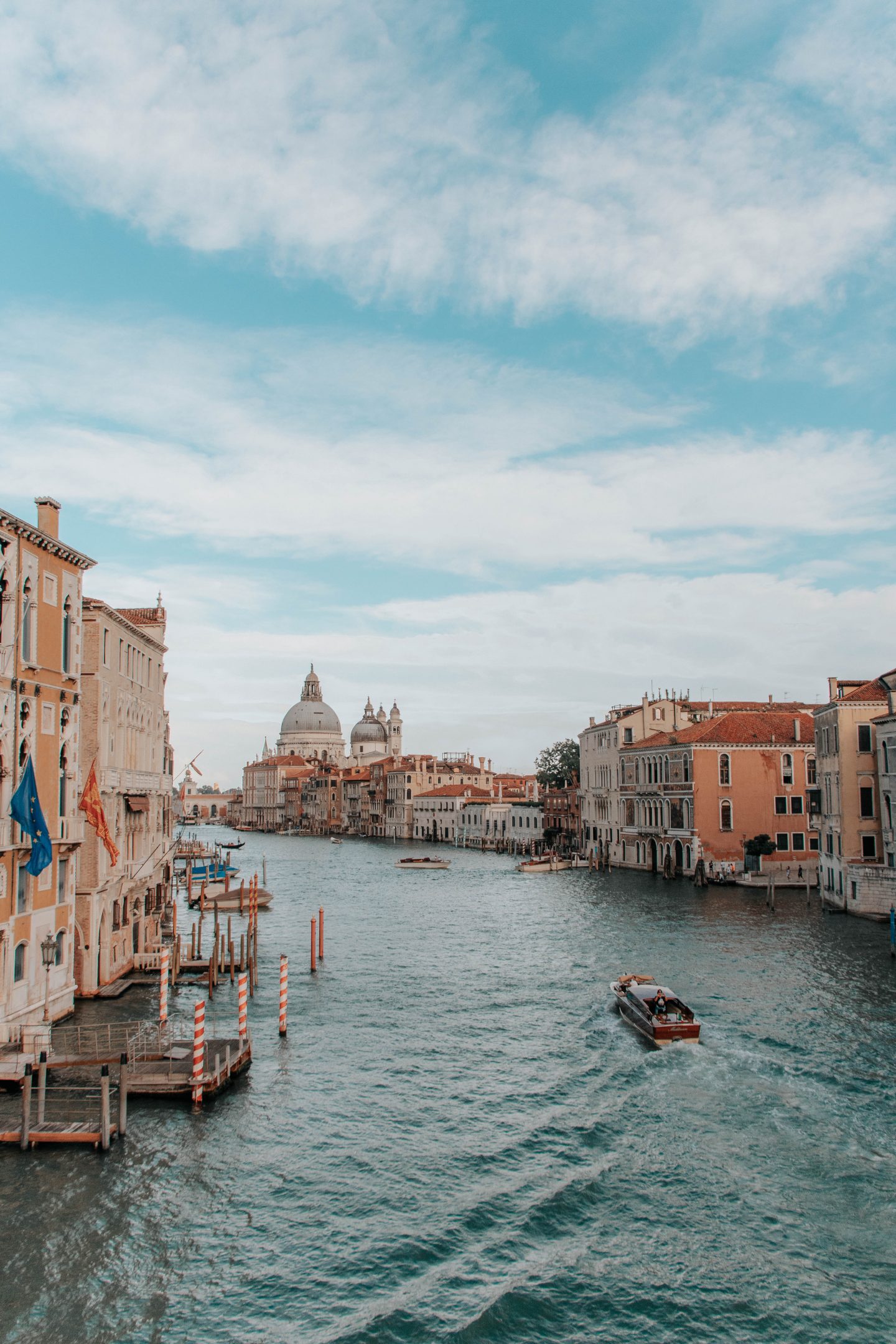
Last Updated on March 24, 2024 by Michela
All of Italy’s regions offer something unique, and in this guide the spotlight is on the north. If you are having trouble narrowing down the top places to visit for you or you’re starting from scratch seeking inspiration, you’ll find the perfect northern Italy itinerary for you in this post, along with tips for visiting this part of the country.
I live in northern Italy, so the area not only has a special place in my heart, but I’ve also traveled all around it!
There is truly so much to do and see that one trip may not be enough, which is why I have curated 5 northern Italy itineraries that play to certain strengths: one for those who want to see the most famous locations, one for outdoor adventurers, one for city-lovers, one for couples, and one for foodies, so you experience a little bit of everything.
Hopefully all these options make clearer what is at the top of your northern Italy bucket list!
Some of these links are affiliate links. This means if you make a purchase through that link, I receive a small commission at no extra cost to you. Read my full disclosure !
Creating The Perfect Northern Italy Itinerary
Before we get into the fun part (the destinations!), I must let you know all the practicalities of planning a northern Italy itinerary.
How Long Should A Northern Italy Itinerary Be?
The big question when planning a trip is always: how long you should spend in northern Italy?
Ideally, a robust northern Italy itinerary falls somewhere between 10 and 14 days.
If you have longer, great! You can go more off-the-beaten-path and deep dive into the culture, taking the slow travel route.
If you have less time and want to see a lot, plan out your transportation well and get ready for days jam-packed with things to do and breathtaking places to see!
I’ll be recommending the stops on the itineraries in a certain order, but not necessarily saying you should be spending one day here and two days there. That is up to you and the flexibility of your travel dates!
I will sprinkle in extra tips and suggestions based on my own experience (so you don’t have to make the same mistakes I have) and extra destinations as well, so you can play with how much extra time you have and be informed about other places in the area well-worth seeing.
Want specific help planning your northern Italy itinerary? Check out my trip planning services , where I give you a personalized itinerary with all the suggestions and tips specific to your desires and needs!
When is the best time to visit Northern Italy?
As a resident of northern Italy, I can share with certainty that the best time to visit is either June or September. In these two months you get the best weather, the very beginning or the tail end of the busy summer tourist season and, if you book ahead, you can get great deals on reservations for rental cars and accommodation.
For those adventure seekers and outdoor lovers, you may also enjoy traveling through the Italian Alps in winter during peak ski season , which is early December to late February.
Read my guides to Italy in Spring , Italy in Summer , Italy in Fall , and Italy in Winter to dive deeper into which season may be a better fit for you.
How To Get Around Northern Italy
Another necessary and important element of visiting northern Italy is knowing how you’ll get around. Northern Italy is the mostly well-connected by public transportation that can take you just about anywhere.
Northern Italy is, however, partially composed of the Italian Alps which presents a challenge for train travel. While you’ll easily be able to get from city to city and even town to town using regional trains, going through the mountains will mean there are less stops and train options, or there may just be no options at all.
I recommend for anyone visiting the Italian Alps either rent a car or plan to book a tour that handles transportation throughout the day’s activities.
Bus travel is also an option, but comes with its own challenges: one, understanding regional bus routes in a short period of time, and two, using coach buses means you’ll get dropped off in one spot and you don’t have much freedom to travel around.
Here’s a more in-depth look at how to get around northern Italy:
There are both national train lines and regional train lines, meaning you are well-connected between the major cities and there are also options to reach smaller towns. Trains are generally easy to navigate, so tourists shouldn’t be intimidated.
They aren’t as cheap as buses, but they’re less expensive than renting a car.
If you’re planning on taking a train around northern Italy, read all my Italy train travel tips so you know exactly how to prepare.
- Mid-range price compared to bus and rental car travel
- Well-connected between cities and towns (regional trains)
- Can be less flexible
I use Omio for purchasing train tickets or go straight to the Trenitalia website .
Italy does not have a national bus line, so most buses are only regional or city. However, coach bus companies like Flixbus operate throughout the country and Europe, so you could travel between regions using their service.
Read about all of your options and how to navigate bus lines in my guide on buses in Italy .
Buses are usually the cheapest option for getting around , as Flixbus tickets are as low as $5. However, the travel time is the longest.
With regional buses you can typically reach small towns, while with Flixbus, you’ll mostly be limited to cities.
If you’re thinking of using regional or city buses, the real challenge is understanding the routes and planning your itinerary around the timetables.
I would only use the bus option if you are opting for a slow travel itinerary and have lots of time to spend in Italy, this way you save money but aren’t wasting half your vacation trying to figure out the buses.
Bus can also be a flexible and inexpensive option for airport transfer.
- Can be super cheap & is overall less expensive
- Least flexible
- Takes time to understand routes of regional or city buses
- Longest travel time
What’s more exciting than an Italy road trip ? It truly is the best way to visit the country and enjoy just how vastly different the landscapes are across the peninsula.
Renting a car in Italy is the most flexible yet most expensive option for traveling around northern Italy. If you’re hoping to visit many places that aren’t major cities or tourist spots, then I would absolutely recommend renting a car.
Any of these itineraries can be turned into a road trip itinerary – like I said, the country is best experienced by road trip!
- Most flexible
- Most comfortable
- Most expensive
- Have to get used to driving in Italy
5 Northern Italy Itineraries You Should Steal
The bucket list northern italy itinerary.
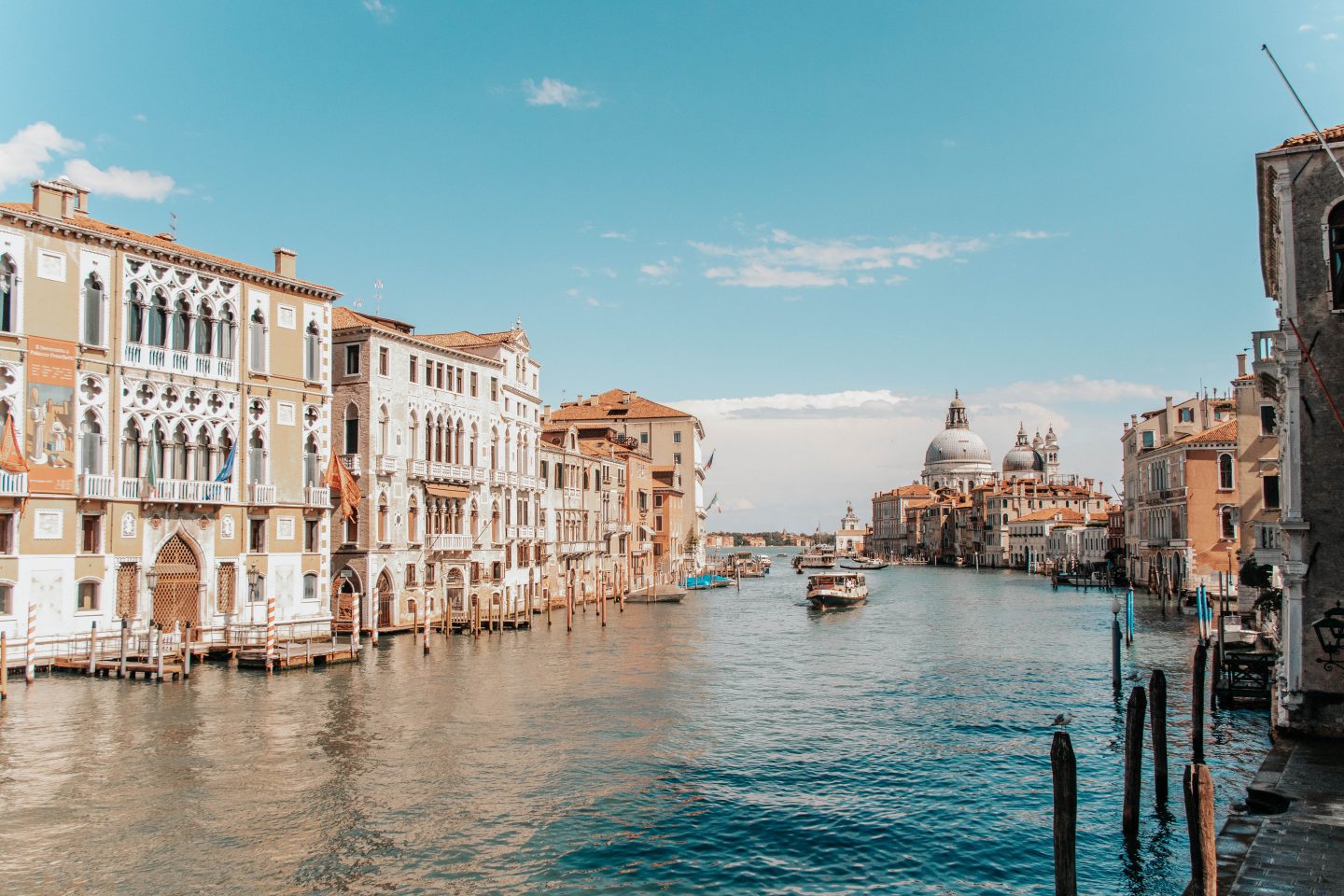
If you’re someone who’s embarking on their once-in-a-lifetime trip to Italy, this itinerary is for you. Hit the 5 major areas on everyone’s northern Italy bucket list.
- Cinque Terre
There is an airport in both Venice and Milan so you could start your itinerary in either place. Both these cities will be your home base on this itinerary.
Book your stay in Milan and spend time exploring the city, while using the next few days to visit Cinque Terre and Lake Como as day trips. Curious about more spots to hit? Discover more day trips from Mi lan to beef up your itinerary.
Then you’ll head to Venice, from which you can do a day trip to the Dolomites.
If you’re working with a 10 day northern Italy trip, you can make it simple by spending two days in each place, or do as I’m suggesting using Milan and Venice as your home bases to explore more with day trips.
Here are some in-depth guides to help you plan exactly what to do in each destination:
- Milan in 24 hours
- One Day Cinque Terre Itinerary
- Lake Como in One Day: Varenna & Bellagio
- 3 Day Dolomites Itinerary
- Where to Stay in the Dolomites
- Unique Things To Do in Venice
Check out this Google Maps Trip Planner with extra itinerary suggestions:
Explore the Italian Alps
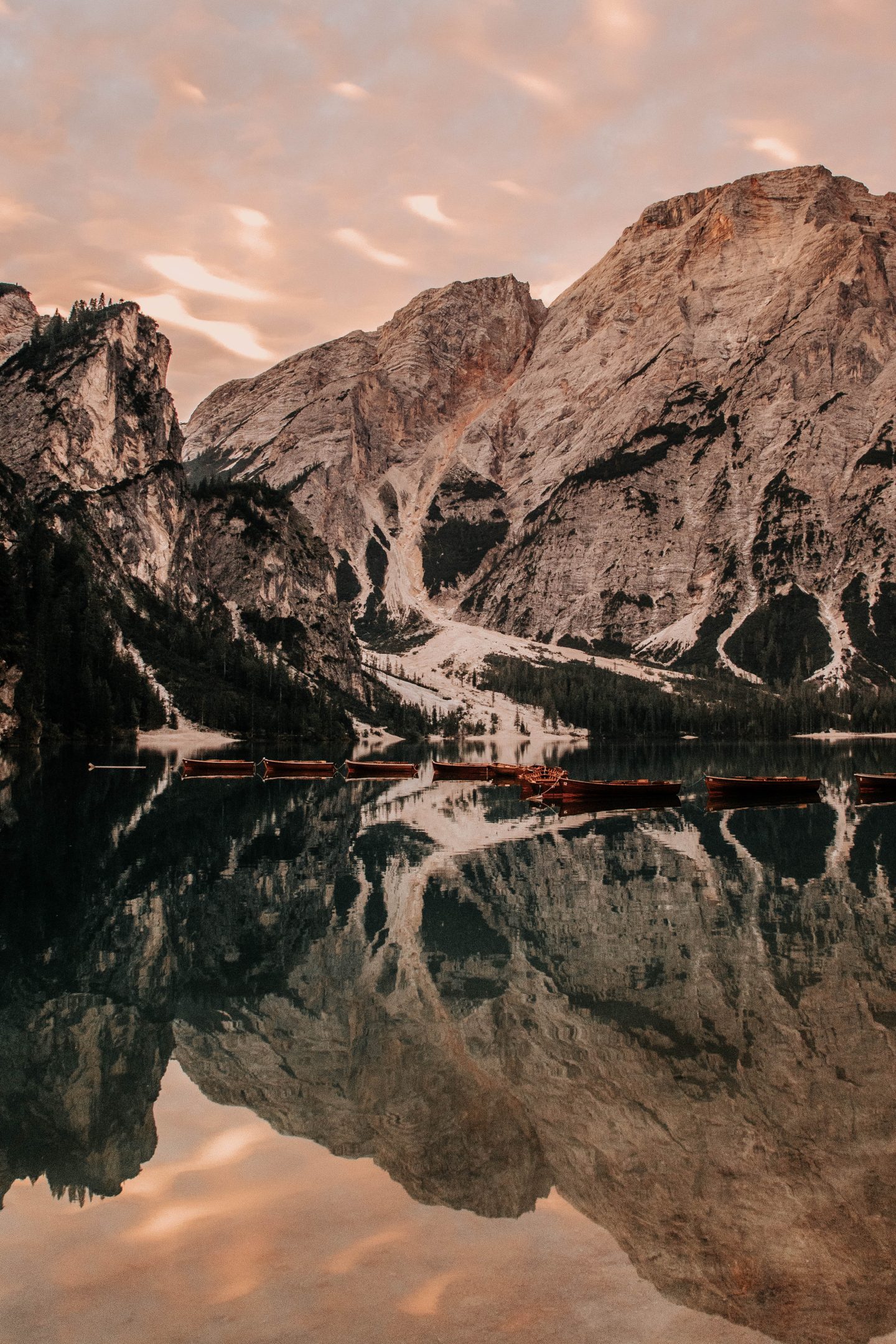
Outdoor enthusiasts will fall in love with the Italian Alps. Whether you like hiking in the summer or skiing in the winter, the mountains are paradise.
The great thing is that even this itinerary is worthwhile for people who aren’t nature lovers but love the mountain landscape. You could engage in sports or you could visit to admire the views!
Here are the itinerary stops:
- Western Alps: Courmayeur, Gran Paradiso National Park, Breuil-Cervinia
- Central Alps : Lake Como, Bergamo, Val Brembana
- Eastern Alps: Dolomites
This epic northern Italy itinerary begins in Valle D’Aosta, the smallest and most underrated of Italy’s regions. The entire area is made up of the Western Alps. You’ll find both French and Italian are spoken here because of how close the two countries are. But the true draw is the landscape!
Start as far west as possible in Courmayeur to visit Mont Blanc and the Val Ferret. Then explore Parco Nazionale Gran Paradiso , the oldest national park in Italy, before heading north to the tiny town turned ski haven Breuil-Cervinia to see Monte Cervino – otherwise known as the Matterhorn !
Making your way from the Western Alps, you’ll cross Milan, Lake Como, and Bergamo in the Central Alps . Lake Como is a must stop also for mountain lovers: the peaks soaring above the lake are breathtaking. Dive deeper into the Val Brembana to the north of Bergamo to visit the villages of Branzi and Cornello dei Tasso.
Then head over to the Dolomites: the most unique of mountains with jagged grey peaks surrounded by the absolutely stunning valleys and green hills of Trentino Alto-Adige.
Check out the map to see this sample itinerary and extra suggestions on where to visit:
North Italy City-Breaks
Some travelers can’t get enough of a historic, bustling European city and Italy is rich with them.
From metropolitan Milan to the medieval hilltop city of Bergamo, the major cities in Italy all offer a different landscape to be explored.
The stops on this north Italy itinerary include:
You’ll probably start this itinerary in Milan, given that the most major airports are located just outside the city. However, if you’re flying from within Europe, you may want to consider flying into Bergamo Orio al Serio Airport, which is a hub for Ryanair flights.
Regardless, these two sister cities are only 40 minutes apart by car, but exhibit completely different landscapes. Milan is bustling, crowded, the energy is always high.
Bergamo is big in size, but quaint in spirit. Life moves just a little bit slower, especially up in Città Alta, a UNESCO World Heritage site and the medieval, historic old town that rests on a hilltop overlooking the more economic center, Città Bassa.
Head west to Turin , a financial and cultural hub like Milan, stylized by Baroque-style architecture and the famed Mole Antonelliana.
Head east and end your itinerary in Venice. There’s not much I need to explain as to why Venice is a good city-break: the uniqueness of its landscape and how it affects every aspect of life from transportation to food is crazy to experience in person.
Check out more in-depth locations for the perfect city-break itinerary to northern Italy on the map:
Most Romantic Places for Couples
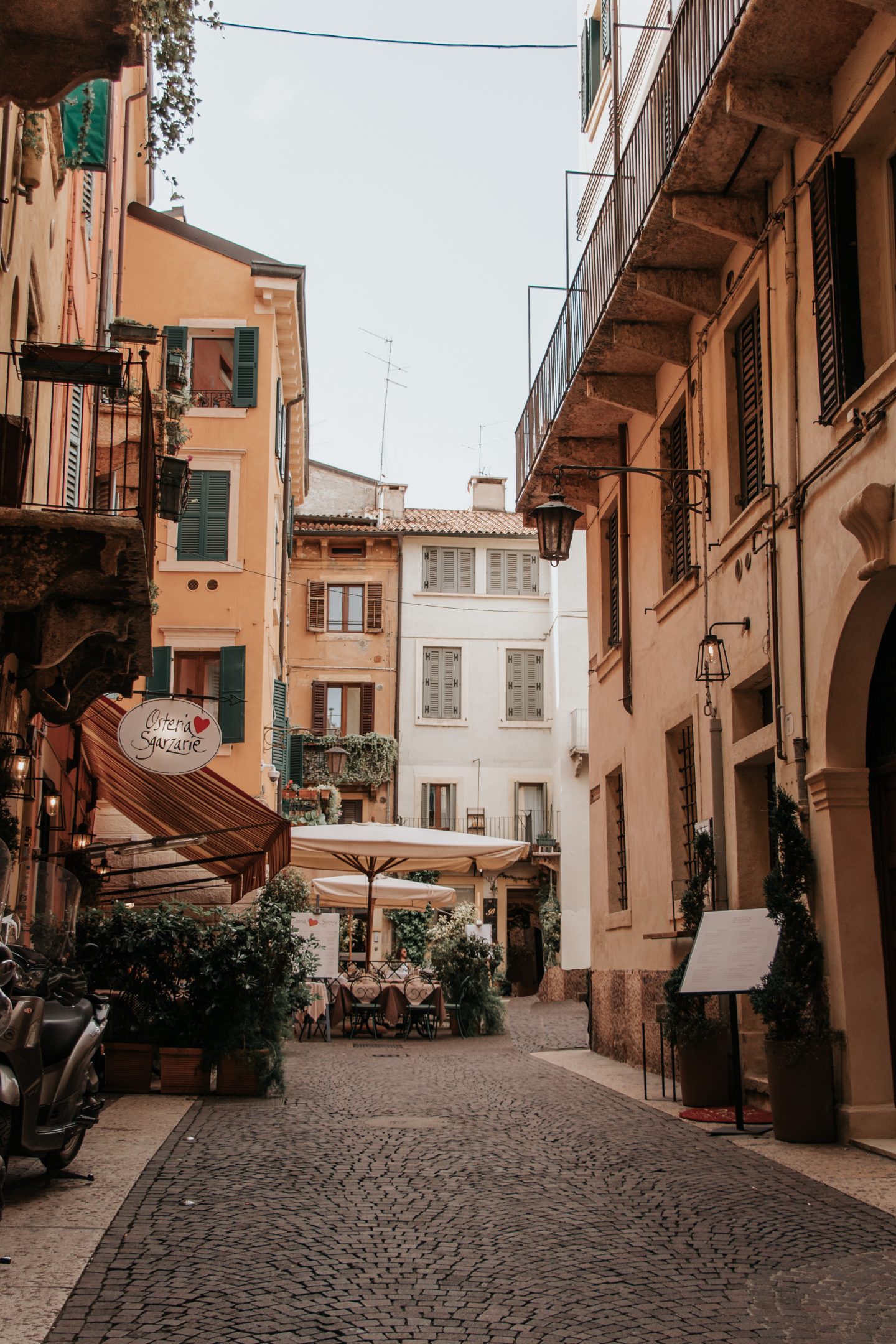
It’s no secret Italy is one of the most romantic countries in the world to visit, so I’ve also curated a North Italy itinerary perfect for couples, whether on honeymoon, anniversary, or simply a romantic trip.
Between wine, fairytale villages, and intimate vistas, you’ll be feeling the Italian romance.
Here are some of the most romantic places in Italy :
- Portovenere
- Franciacorta
Portovenere is an underrated hidden gem on the coast of Liguria. From the views to the quiet harbor to the unreal swimming spots like Lord Byron’s Grotto and the untouched beaches of Palmeria Island , it’s a lover’s paradise and exudes Italian charm. Nearby Portofino and Santa Margherita Ligure are a few extra stop ideas.
It’s no secret Lake Como is one of the most luxurious destinations in Italy and its exclusivity, plus the incredible views of villas and alpine peaks, makes it an intimate retreat. Make it easier to visit using my Lake Como budget tips , but don’t be afraid to indulge in visiting its most romantic places like Villa del Balbianello and the town of Bellagio .
The Tuscany of northern Italy? Franciacorta . Franciacorta is a territory between Bergamo and Brescia that produces sparkling wine or “spumante”, mostly Prosecco, Italy’s version of Champagne. If you love the idea of vineyard views on end and wine tasting with your partner, it must be added to your romantic itinerary.
Not far from Franciacorta is the region of Veneto, where the next half of the itinerary lies. Verona is the ultimate city of romance in Italy: the setting of Shakespeare’s Romeo & Juliet, made up of rose-hued buildings and castles nestled over the Adige River.
Lake Garda is the largest lake in Italy, but its small, cascading hillside towns make the atmosphere intimate. Visit Sirmione for its enchanting castle and Limone sul Garda for its quiet charm. Curious for more ideas? Read about all the best towns on Lake Garda .
Last stop for lovers: Venice! You can’t take a romantic trip to Italy without enjoying the swoon-worthy, picturesque atmosphere of Venice. Gondola ride for two?
Discover more specific destinations for loved-up travelers on the map:
A Foodie’s Northern Italy Itinerary
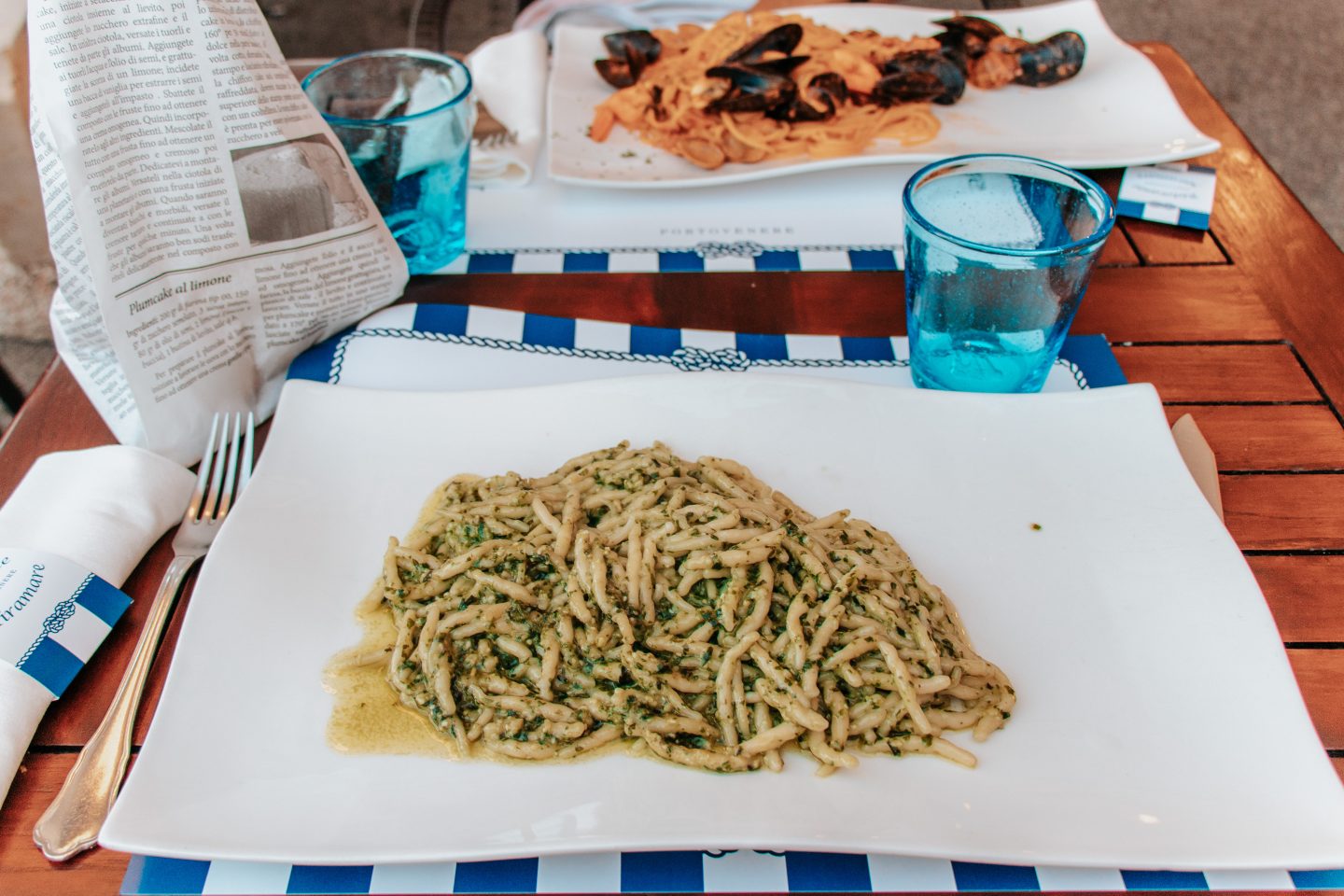
Italian food is in a league of its own, but you’ll soon find out when visiting northern Italy that the traditional dishes are not pasta and pizza.
Instead, the meals are heartier, which reflect the lifestyle of the historic types of people living here: industrial workers or those living in the Alps having to face long winters.
People in northern Italy also love their local ingredients. Here are some foods to try in every region on this itinerary:
- Truffles in Piemonte
- Seafood, Focaccia, & Pesto in Liguria
- Polenta in Bergamo
- Spaghetti alla bolognese in Bologna
Starting in Piemonte, the speciality is one of the most expensive and luxurious foods in the world: truffles ! The best time to visit is in the fall, also when the White Truffle Festival takes place in Alba. I highly recommend booking a tour with a local guide for the unique experience of hunting for truffles and do a Barolo wine tasting.
Next stop is Liguria for fresh seafood, focaccia, and pesto ! You can pretty much walk into any bakery in Liguria and get an amazing piece of focaccia. I love simple focaccia, made with just oil, but the bread is so versatile that you’ll find many different versions. The other dish I ordered at every restaurant in Liguria: Trofie al Pesto.
After heading to the sea, return to the mountains around the area of Bergamo. Here you’ll find two specialties: polenta and pizzoccheri. Polenta is a versatile grain made plain, with cheese or as Polenta Contadina, made with cheese, spinach, and local sausage. Pizzoccheri are a mix of short buckwheat tagliatelle pasta, potatoes, cheese, and greens. It comes from Valtellina, a valley in Lombardy bordering Switzerland.
Your last stop on this itinerary is tapping into a bit of central Italy territory, but it is a must stop for foodies. Bologna is the origin of many Italian food favorites : Parmigiano Reggiano, Mortadella, Ragù Bolognese, Balsamic Vinegar and Lasagne. Arrive on an empty stomach and take a traditional food tour !
Check out the map with extra suggestions:
The SGTD Take
I could go on and on about all of the beautiful places to visit in northern Italy, but this post would then be at least 10,000 words. I highly suggest taking a look at the embedded maps to discover places worth adding to your itinerary based on the amount of time you have available.
Also take advantage of the linked posts within this article to discover individual destinations in depth and ultimately allow you to plan your trip better.
Northern Italy is a diverse landscape: mountains, sea, lakes, floating cities, metropolitan centers, food-rich countrysides. It’s hard to fit it all into one trip, but hopefully you’ve found the perfect itinerary for your trip to northern Italy or at least sparks of inspiration!
Which itinerary is on your bucket list? Leave a comment!
Italy Trip Planning Resources
- Accommodation : For Italy, I mainly use Booking.com to search and book places to stay.
- Booking flights : I like to search for flights through Skyscanner , but I also book direct depending on the airline.
- Activities & experiences : For things to do that require a ticket, and for more unique trip activities, I use Musement .
- Road trip : For renting a car, I get the best prices by comparing companies with AutoEurope . I then use ViaMichelin to estimate road trip costs and Autostrade.it to find gas stations/have live updates on traffic.
- Transportation : Traveling by public transportation is a great way to see Italy. I use Trenitalia or Trainline to book tickets for trains and Flixbus for long-haul bus trips.
- Accessories : I always travel with this portable charger to stay connected and with a universal adapter to accommodate Italy’s plug types.
- Need help planning an itinerary? Fill out my form for a custom itinerary request !
Save these itinerary ideas to Pinterest!
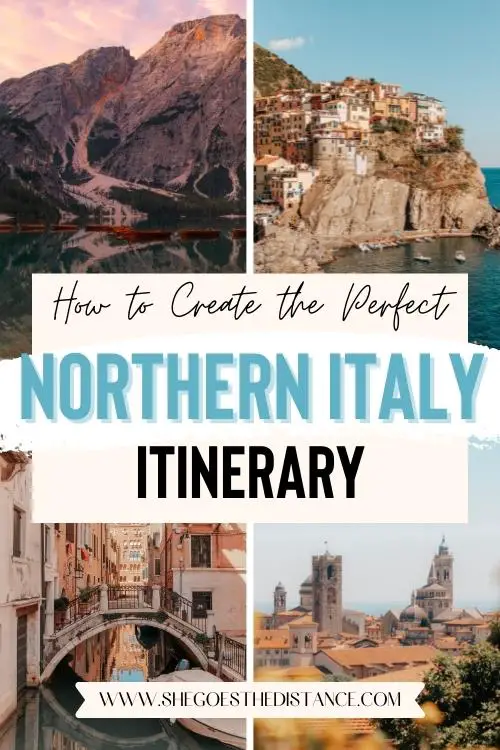
If you head out on your adventure using one of these itineraries or have questions for curating a totally customized itinerary, share with me – I’d love to hear how your trip has gone or help you further plan your dream northern Italy itinerary !
Michela is a travel writer and photographer living in northern Italy. She is passionate about helping people make the most of their travels by sharing advice gained from her personal experiences, off-the-beaten-path destinations and time-saving quick itineraries. Browse her top articles or have her help you plan your itinerary to your dream destination!
Find me on: Web | Instagram
You may also enjoy:
Monte isola, italy: the best travel guide to visit europe’s largest …, saturnia hot springs: how to plan an epic visit to italy’s ….
Hi Michela, I would love some suggestions on a 14 day itinerary to Northern Italy. We are coming from the West Coast of the US (California). This is our second trip. Our first trip we visited Rome, Florence, Bologna, Venice, Genoa/Cinque Terre. We would really like to visit Bologna and Florence again and have to add Verona for sure due to business (just 1 day business meeting). I’d also like to see Lake Como, Lake Guardia, Dolomites and Piedmont but know we can’t fit it all in and I’m ok with making another trip some day. I was thinking of flying into Rome due to convenience and cost and flying out of Milan mostly due to convenience. We are not opposed to flying in and or out of any airport as long as it makes sense. I would love to hear your suggestions for an itinerary and how long to spend in each place
Those are all amazing places to visit! Since they are very concentrated in northern Italy, I would suggest flying roundtrip in and out of Milan. But if the price is better in Rome, you could always take a train to a major northern Italian city or find a cheap flight with RyanAir, for example.
As far as how long to spend in each place, here are my recommendations for a minimum amount of stay based on how much there is to do in each place (& my personal favorite spots!):
– Piedmont: at least 2 nights (Piedmont is a large region, so depending on how much you want to see, you could easily extend this a couple of nights) – Lake Como: at least 1 night – Bologna: at least 1 night – Florence: at least 2 nights – Verona: at least 1 night – Lake Garda: at least 1 night (or even a day trip from Verona & you stay in Verona 2 nights) – Dolomites: at least 2-3 nights
Planning the best order of visiting these places will depend on what airport you end up flying into, as well as what day your business meeting falls on! If you have any other questions, feel free to reach out again!
Leave a Reply Cancel reply
Your email address will not be published. Required fields are marked *
Save my name, email, and website in this browser for the next time I comment.
Website URL
Sign me up for the newsletter & access to resources from The Travel Library!
JOIN MY FACEBOOK GROUP
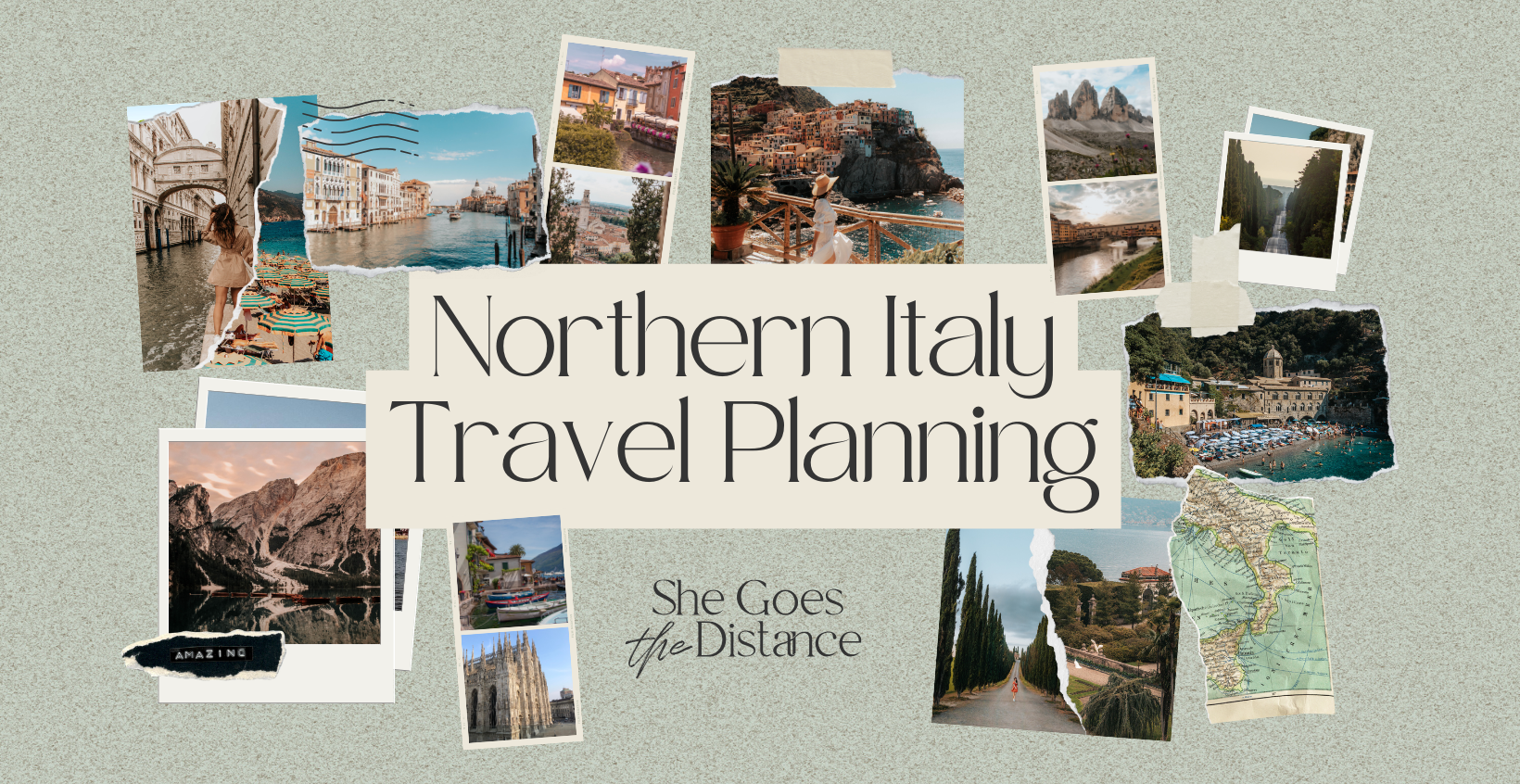
Check this out
- The Travel Library
- Privacy Policy
BUY ME A COFFEE
I love creating free resources for your travels and personally responding to your questions over chat and email.
Planning a trip to Italy?

Looking for Something?
Lists by Lukiih 🍀
Practical travel guides with less fluff
- 🍝 7-10 Days in Northern Italy: 2 Efficient Itineraries

The northern regions of Italy are known for their world-renowned restaurants , famous historical sites, and picturesque villages nestled on mountainsides and lakeshores.
With seven to ten days in northern Italy , you have enough time to visit four to five distinct areas featuring coastal villages, intricate canals, and historic cities.
I spent a fantastic two weeks in Italy and here, I share amazing things to do and tips to optimize your trip itinerary . This post covers:
- 🗓️ 2 different optimized itineraries
- 📍 Best destinations in Northern Vietnam
- ⭐️ Top attractions in the region
- 🗺️ Italy map with key places
- ✏️ Italy trip planner
Planning a trip? Here’s what to know about Italy .
- Essential Tips
- 7-Day Itinerary
- 10-Day Itinerary
2. Lake Como
4. bologna, modena and parma, 5. cinque terre, 6. florence, italy trip planner.
Lists By Lukiih is readers-supported. When you buy with my affiliate link, I may earn a small commission. Thanks!
3 Essential Tips for Visiting Northern Italy
Before getting into the itineraries, here are five practical things to keep in mind when traveling to northern Italy.
🍝 1. Book restaurant reservations.
One of the most important things I learned after spending over two weeks in Italy is that there’s always a long wait for good restaurants in bigger cities like Milan and Florence. This is especially true during Italy’s high season in the summer.
Make sure to make reservations a week or more in advance. Otherwise, you might have to wait for hours or eat at more touristy restaurants with less authentic food and higher prices.
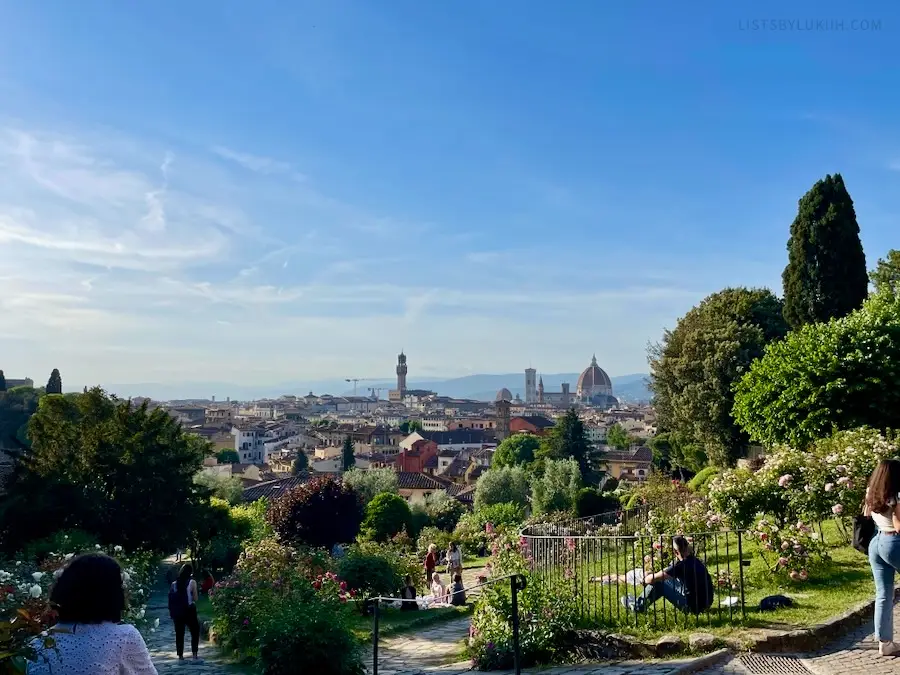
💶 2. Carry some euros.
Although Italy has a great credit card infrastructure, many smaller businesses and some of the charming areas like Cinque Terre and Venice are cash-only , so carry some euros.
Learn other cash-related tips when traveling to Italy .
🚊 3. Get around on Italy’s trains.
Italy has one of the best train infrastructures in the world . You can rely on their trains to get to most major cities (and even some smaller towns) within the country. In this itinerary, you will be primarily relying on public transportation.
Learn other practical tips when traveling to Italy .
Northern Italy Itineraries
Below are two different itineraries for northern Italy, covering distinct destinations with varying activities and atmospheres.
These Italy itineraries are the improved version of my two-wek trip. I’ve included some of my actual timestamps, so you can plan and sequence activities efficiently.
7-Day Northern Italy Itinerary
You can spend more than two weeks traveling around northern Italy and not run out of things to see or do. If you only have a week there, below is a great and efficient way to see four of Italy’s best places :
- Milan , the fashion capital of the world
- Venice , a city famous for its intricate canals
- Cinque Terre , a picturesque coastal village
- Florence , the birthplace of the Renaissance
The Italy trip planner below has this itinerary prefilled.
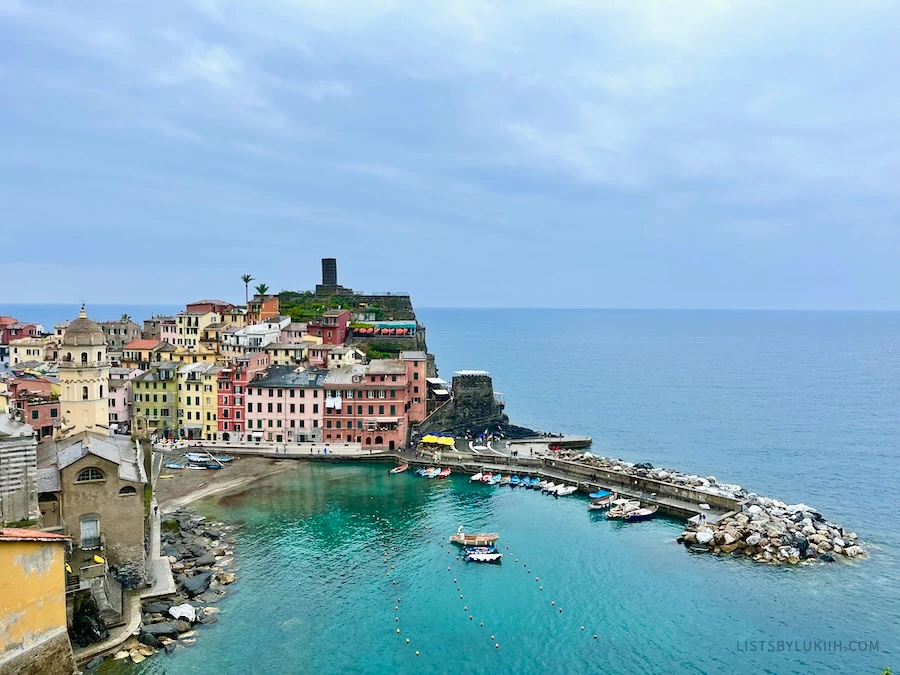
10-Day Northern Italy Itinerary
Below is an efficient way to see six of northern Italy’s best places in ten days. This ten-day itinerary features city landscapes, coastal villages, narrow canals, wine country, and stunning views.
This itinerary closely resembles my busy and packed trip, so I’ve included some of my suggested duration . Scroll below to see how to modify this itinerary for more downtime.
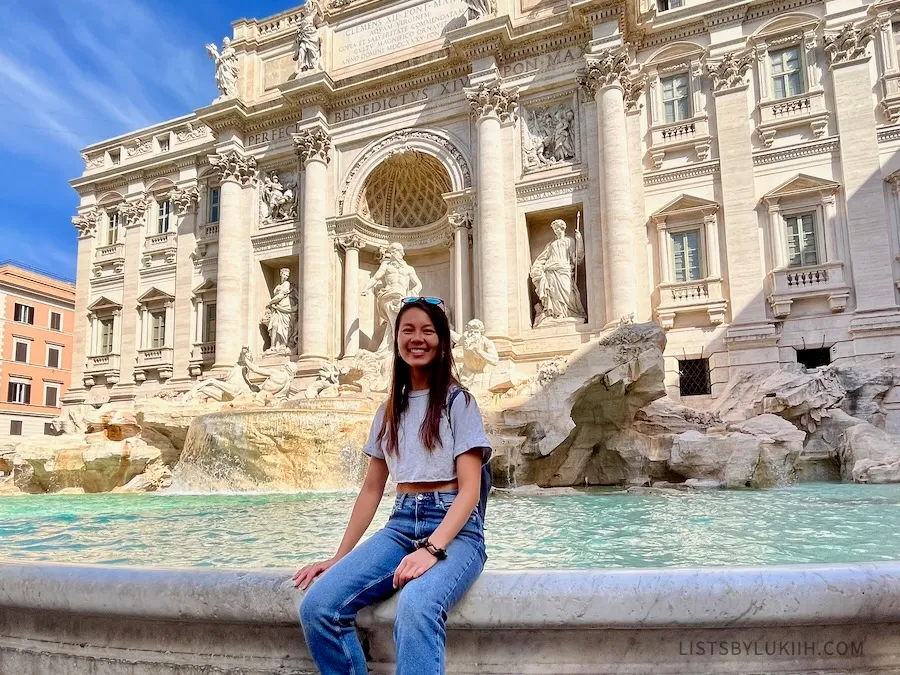
I share all my expenses doing an itinerary similar to the one above in this Italy trip cost breakdown .
🗓️ Slower 10-Day Northern Italy Itinerary
For more downtime and a slower northern Italy itinerary, skip Bologna, Modena, and Parma . Instead, spend an extra day visiting the beautiful villages of Cinque Terre.
Your slower ten-day itinerary can look like this:
If you want to further minimize taking the train to different areas of northern Italy, skip the Lake Como day trip and spend another day exploring Milan instead.
🍝 With More Time: Extending Your 10-Day Trip
If you have an extra day or two in northern Italy, you can either spend extra time in Cinque Terre, Florence, or the Emilia-Romagna region, which includes Bologna, Modena, and Parma.
- Cinque Terre is beautiful and you can take your time hiking between the villages if you want to extend your trip there to three days.
- Florence is one of Italy’s most visited places and it’s a perfect place to spend more time if you love history and the arts.
- The Emilia-Romagna region is worth visiting over two to three days, but it’s usually not a main stop in many first-timers’ itineraries.
Here’s a comparison of Bologna, Modena, and Parma .
💧 Alternative to Lake Como: Visit Lake Garda
Lake Como is Italy’s most popular lake and it’s an hour-and-a-half train ride north of Milan. A great alternative option is to travel to Lake Garda (Lago di Garda) instead, which is a one-hour train ride east of Milan and takes you much closer to Venice.
Lake Garda vs. Lake Como
Lake Garda is not as picturesque as Lake Como, but it’s the largest lake in Italy.
Lake Garda boasts a more diverse landscape and offers a bigger range of water activities (e.g., windsurfing, sailing, kiteboarding).
Lake Garda’s Best Towns
Like Lake Como, Lake Garda is surrounded by charming towns. Its most popular towns include:
- Sirmione , the most iconic town with the Scaligero Castle and Roman ruins
- Riva del Garda , a town loved by outdoor and nature enthusiasts
- Desenzano del Garda , the largest town with a lively town center and lakeside promenade
- Peschiera del Garda , a town with historic importance
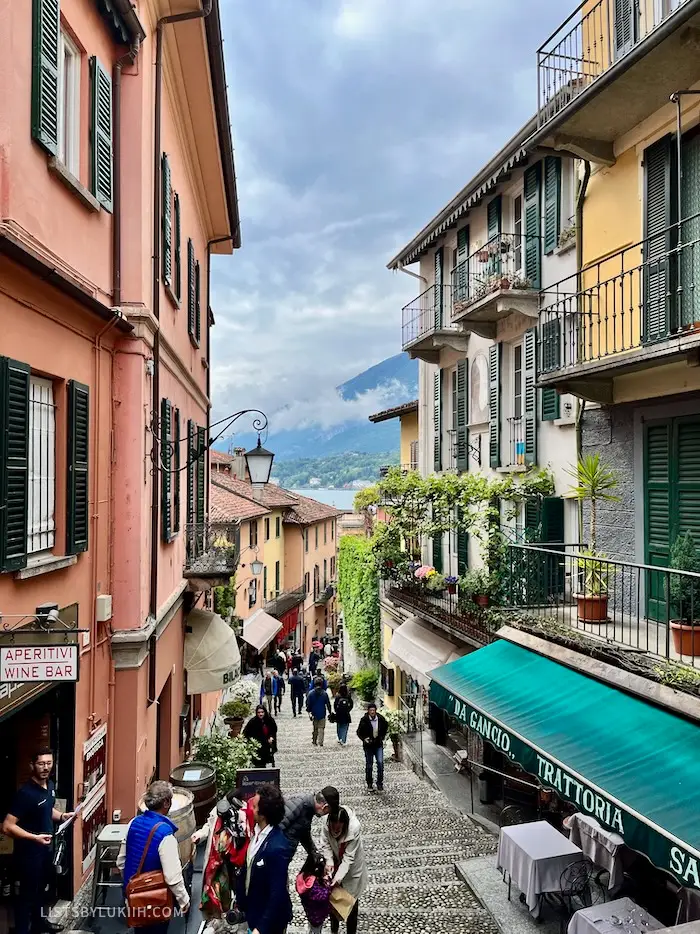
Northern Italy Map
This Italy map has all the recommended places mentioned in this post.
6 Amazing Places To Visit in Northern Italy
Here are six destinations in northern Italy with distinct environments and experiences for a complete trip .
These destinations are some of northern Italy’s top places and attractions featuring a mix of wine country, coastal villages, and spectacular views.
An economic center in Italy, Milan is known as the premier fashion capital of the world and has some of Italy’s most treasured cultural heritage.
✨ Top Attractions in Milan
The vibrant city of Milan is best known for these main attractions:
- Duomo di Milano (Milan Cathedral) is the largest church in Italy and is a Gothic architectural masterpiece in the city center. It’s considered one of the must-see attractions in Milan.
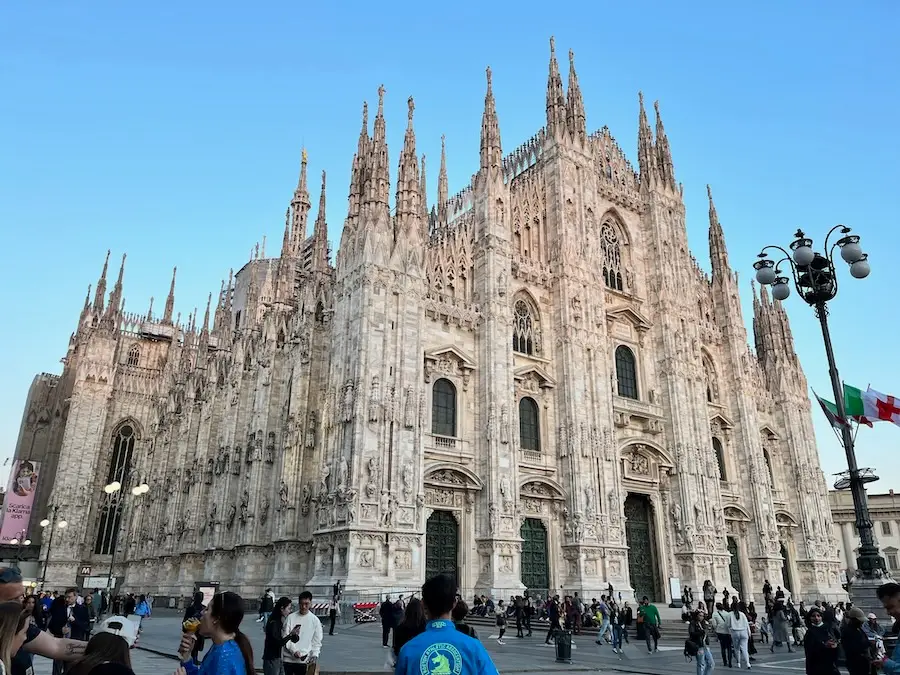
- Santa Maria delle Grazie is a UNESCO World Heritage Site as this Renaissance church hosts Leonardo Da Vinci’s most famous artwork , The Last Supper .
The Last Supper can only be viewed for 15 minutes . You must book a timed ticket to see it and some tours will allow you to skip the line .
- Navigli District is one of the most famous districts in Milan. Navigli runs along the river and is a picturesque town that comes alive during the night.
Many of Milan’s top restaurants are often booked, especially in popular areas like Navigli. Make reservations in advance or else you might be waiting for seats for hours, which is what happened to me.
📍 Getting To Milan
Milan is located in the Lombardy region in the northernmost part of Italy . It has one of Italy’s major international airports, Milan Malpensa Airport (MXP), that visitors can fly into.
Milan is a major city well-connected to Italy’s trains. Its location makes it the best city to visit Lake Como as a day trip. It’s also a little under three hours west of Venice by train.
🗓️ How Long To Spend in Milan
You can spend one to four days in Milan, depending on your interest. One to two days is sufficient time to visit the top attractions, but if you want to shop and explore more of the galleries, three days or more is appropriate.
See the best of Milan and understand its history better in this well-rated guided tour.
🍀 My Take on Milan
Truthfully, Milan was my least favorite city in northern Italy, which is why I recommend spending only one to two days there in my itinerary.
Milan is a great place to see a bustling and fashionable city in Italy, but I found all other cities and towns more unique and breathtaking. That said, I found it to be one of the best places to eat gelato.
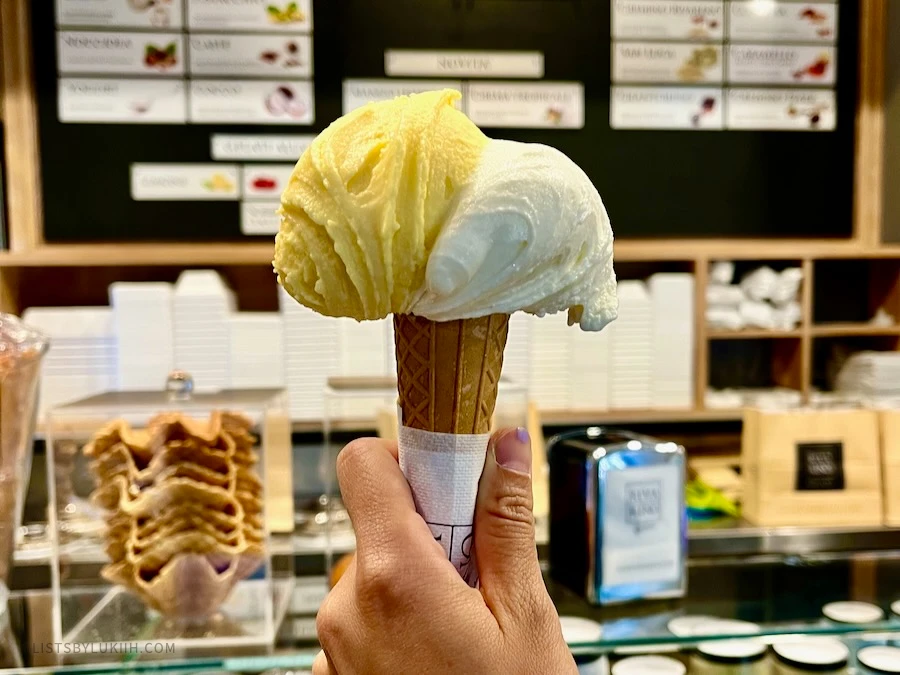
One of the most beautiful lakes in Italy, Lake Como is known for its dramatic mountain scenery with spectacular views , picturesque towns lined along its shores, and villas with beautiful gardens.
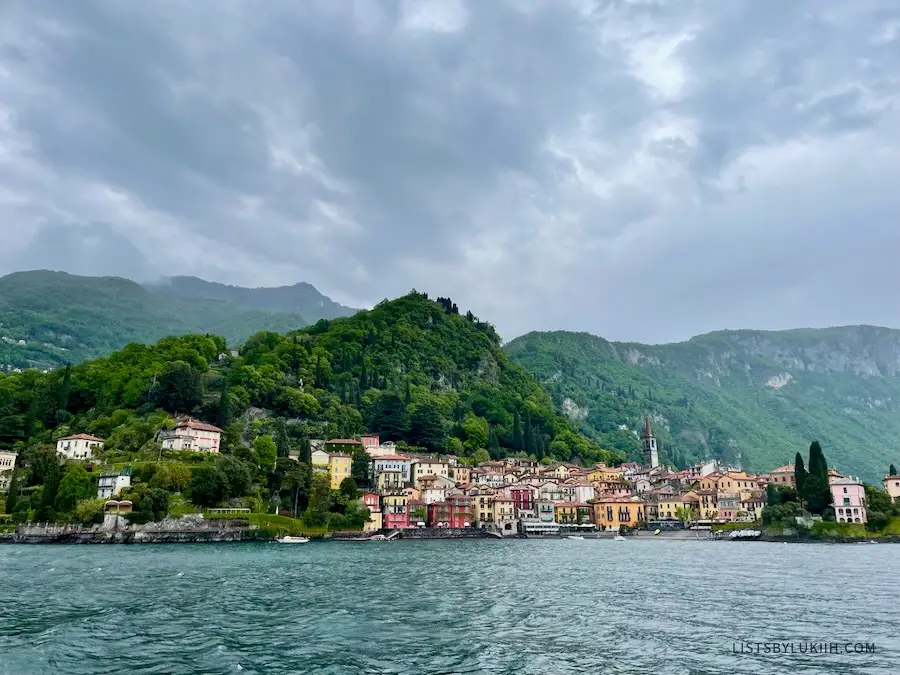
Lake Garda and Lake Maggiore are Italy’s second and third most popular lakes that are also known for beautiful views. They’re both a one to two-hour train ride away from Milan, making them good alternatives to Lake Como .
✨ Top Attractions in Lake Como
Lake Como is surrounded by more than ten towns and villages. Its most famous towns are Bellagio, Varenna, and Como, and here are their top attractions:
- Castello di Vezio in Varenna is a medieval castle with some of the best views of the lake.
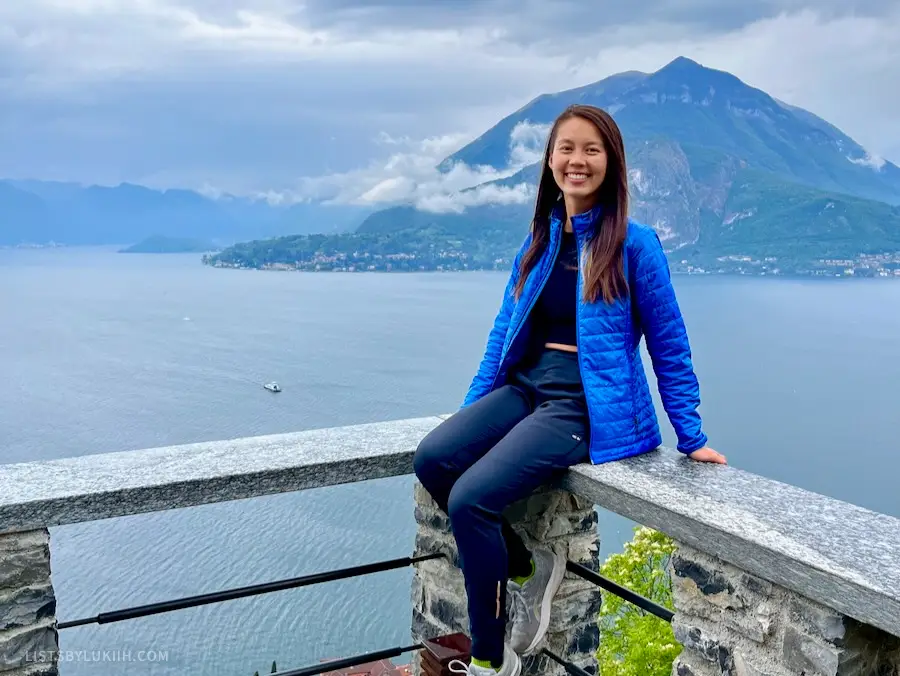
- Villa Monastero in Varenna is one of Lake Como’s most notable villas , featuring a beautiful botanical garden.
- Bellagio is a small town considered to be one of Lake Como’s most charming ones. Famous Street gives visitors a picturesque view of the lake and town shops.
See how to plan a day trip to Lake Como .
📍 Getting To Lake Como
Lake Como is very far north of Italy, located less than 10 miles south of Switzerland .
The best way to get to Lake Como is from Milan by train . The train ride takes one to two hours, depending on which of the lake’s towns you’re visiting.
🗓️ How Long To Spend in Lake Como
You can spend one to three days on Lake Como depending on how many towns you want to visit.
🍀 My Take on Lake Como
Lake Como is a beautiful lakefront that’s worth spending a full day at . If you enjoy visiting villas or are visiting northern Italy in the summer and love water activities, Lake Como is worth at least a two-day trip.
Venice is a beautiful city that’s world-famous for its intricate networks of canals, gondola rides, and romantic ambiance.

✨ Top Attractions in Venice
Here are some of Venice’s best attractions and activities:
- St. Mark’s Square (Piazza San Marco) is Venice’s main square lined with cafes . It’s a major tourist attraction featuring notable, historic buildings.
- St. Mark’s Basilica (Basilica di San Marco) is a stunning church with intricate details . It’s one of Venice’s most popular attractions, so expect long lines, even in the morning when it first opens.
- Doge’s Palace (Palazzo Ducale) is a historic palace connected to the famous Bridge of Sighs on the Grand Canal.
Due to its rich history, Doge’s Palace is best experienced with a guided tour . Here’s a highly-rated tour combined with a tour of St. Mark’s Basilica.
- Rialto Bridge is one of Venice’s most iconic bridges . It’s the oldest bridge on the Grand Canal and was historically a bustling center of trade.
- Venetian gondola rides are one of Venice’s most iconic activities .
Learn the best place to catch a gondola ride in Venice .

- Cichetti are small snacks typically served on a piece of bread and Venice is an excellent place to enjoy them. I had them at several places and my personal favorite was at a local spot called Vino Vero .
Learn more about exploring Venice in a day .
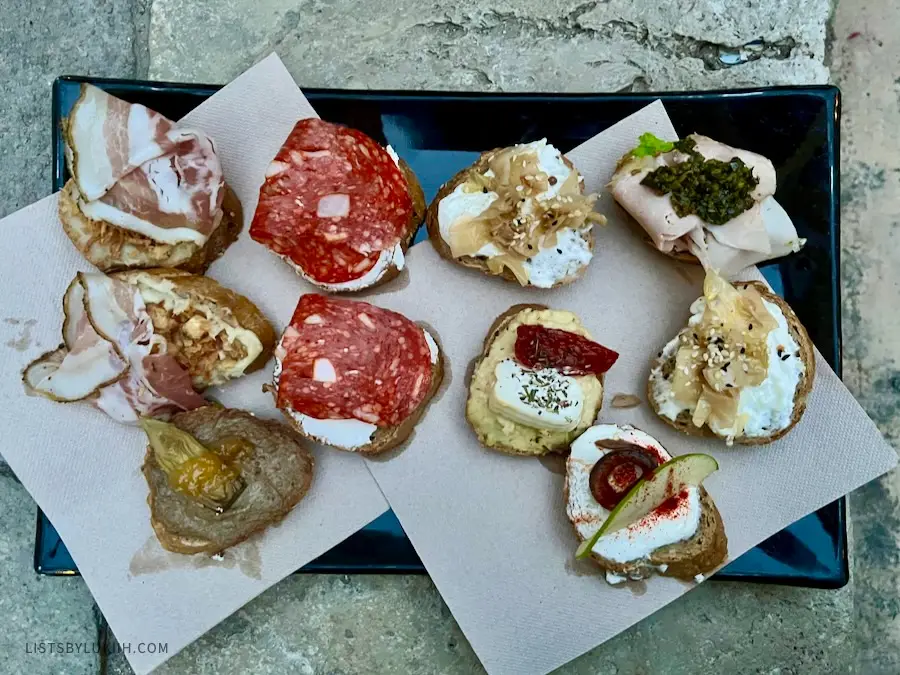
📍 Getting To Venice
Venice is located on the northeast coast of Italy . It has one of Italy’s international airports, Venice Marco Polo Airport (VCE), that visitors can fly into.
Venice is also located a three-hour train ride east of Milan.
The train ride from Milan passes through the city of Verona, which is most famous for Casa di Giulietta , the setting for Romeo and Juliet .
🗓️ How Long To Spend in Venice
Two to three days in Venice is sufficient to do its main attractions and explore its different districts on foot.
Given its popularity, try to avoid traveling to Venice during the weekend . The small canals and streets become overly crowded. It’s a much more pleasant city to visit on the weekdays.
🍀 My Take on Venice
With its narrow streets and canals, Venice is a perfect place to wander . Venice has six districts and although San Marco is the most popular one, I enjoyed walking around the quieter Dorsoduro district the most.
Bologna, Modena, and Parma are well-known cities located in the Emilia-Romagna region. The region is known to have some of the best local restaurants in the world , so they’re great places to stop for food lovers.
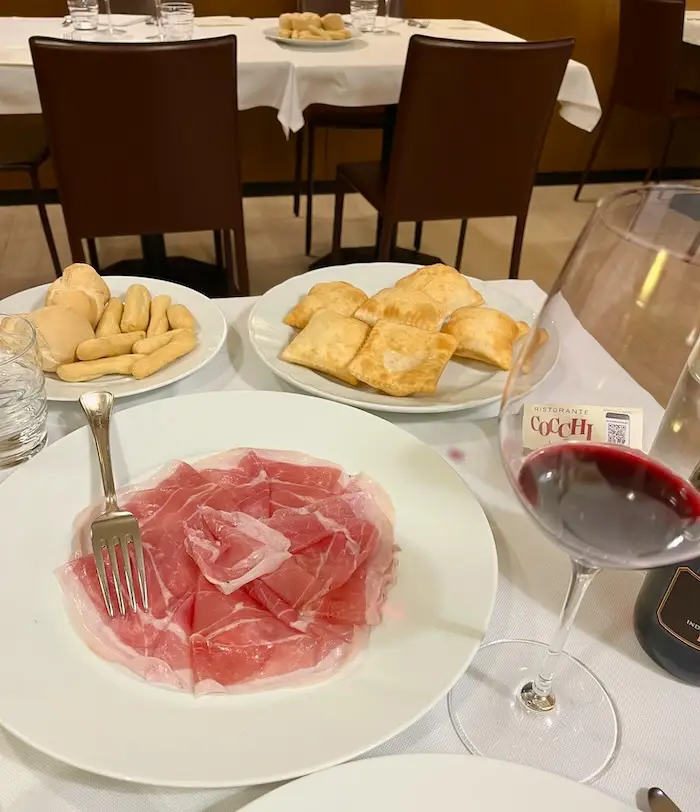
Learn more about the differences between Bologna, Modena, and Parma .
🍀 My Take on Parma
I recommend stopping in one of these three cities even for just a day because it’s a nice way to break up the commute from Venice to Cinque Terre. I chose to do Parma because I wanted to eat some of the world’s best prosciutto.
One of my favorite discoveries in the region is Lambrusco , a sparkling red wine that’s difficult to find in other regions of Italy.
A UNESCO World Heritage Site, Cinque Terre is one of the most beautiful places in Italy . It’s known for hiking trails, picturesque villages, dramatic cliffs, and ocean views.
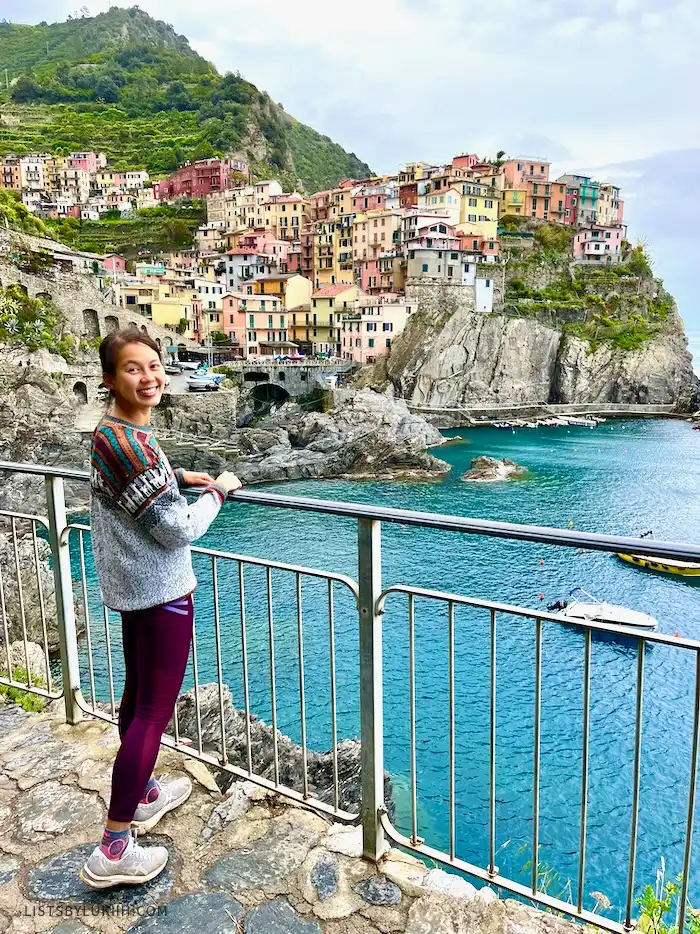
Cinque Terre is the more affordable version of the popular and luxurious Almafi Coast in southern Italy. This Italy cost breakdown has all my trip’s expenses.

✨ Top Attractions in Cinque Terre
Cinque Terre is comprised of five villages located near the coast. Aside from wandering around each small village, one of the best things to do is hike through them.
Learn how to hike through Cinque Terre .
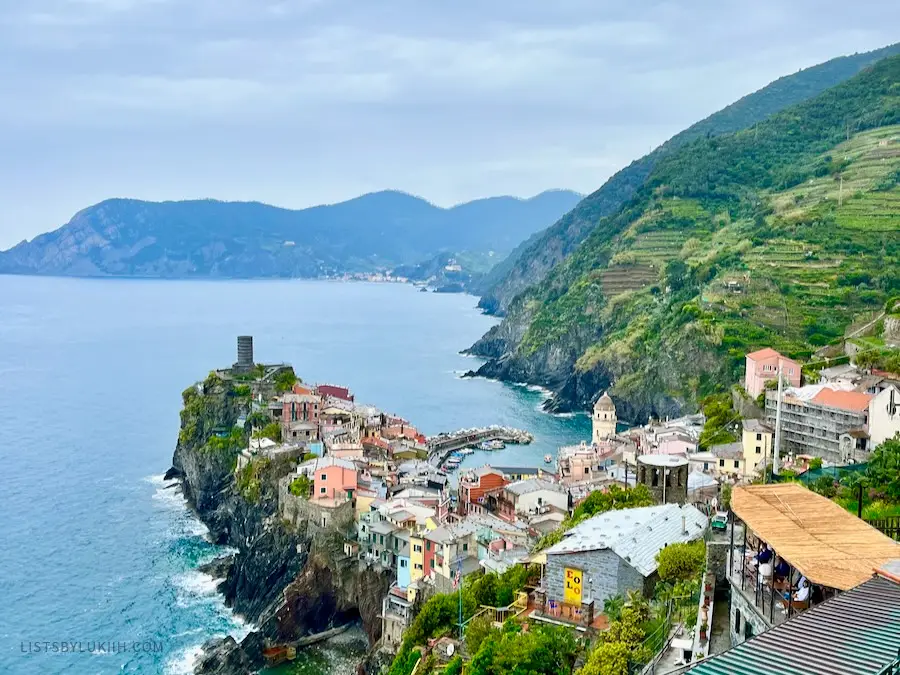
📍 Getting To Cinque Terre
Cinque Terre is located on the northwest coast of Italy . The best way to get to Cinque Terre is by taking the train to Monterosso al Mare (the northernmost town) or Riommaggiore (the southernmost town).
🗓️ How Long To Spend in Cinque Terre
Two to three days in Cinque Terre is a sufficient amount of time to visit and spend meaningful time in all five of its villages.
🍀 My Take on Cinque Terre
Cinque Terre was my favorite place in northern Italy and it’s absolutely worth visiting. The hike and breathtaking views were a pleasant break from the cities and old architectural landscapes commonly found in other regions of Italy.
Called the “Cradle of the Renaissance,” Florence is known for its historical sites and acts as a gateway to the Tuscany wine countryside of Italy.
✨ Top Attractions in Florence
Here are Florence’s top attractions and activities:
- Uffizi Gallery (Galleria degli Uffizi) is one of the most famous art museums in the world , featuring art from Renaissance artists such as Leonardo da Vinci, Michelangelo, and Caravaggio. Learn about these world-famous artists in a well-reviewed guided tour .
- Piazza del Duomo is the main square of Florence . It’s bustling with restaurants and cafes and is home to Florence’s duomo, the Cathedral of Santa Maria del Fiore .
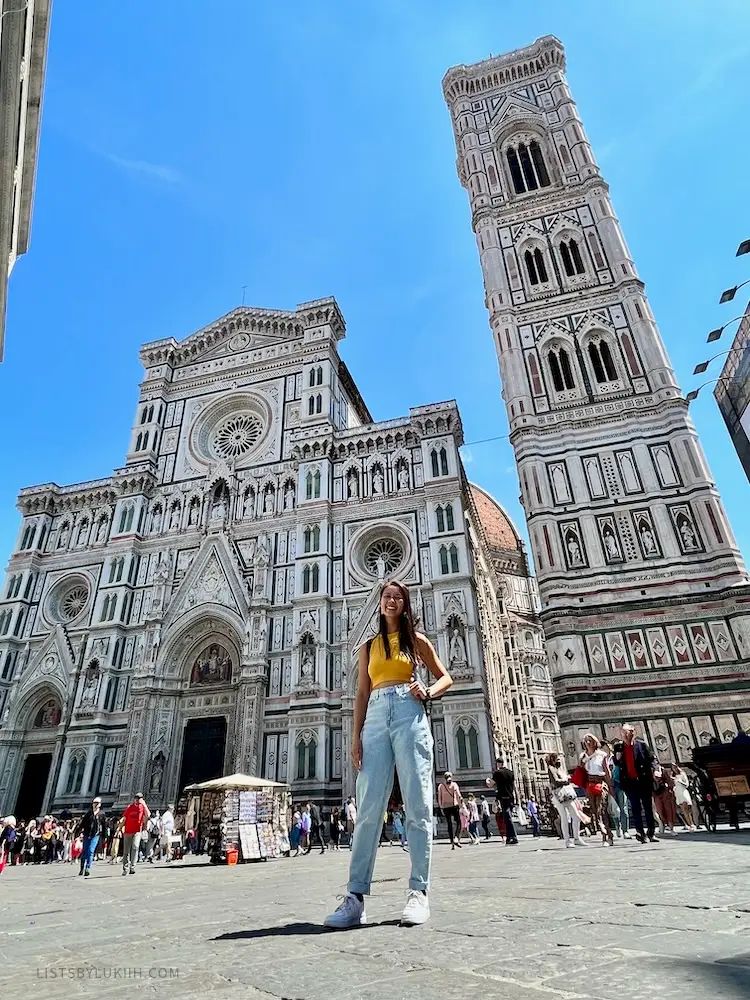
One of the most popular things to do is to climb Brunelleschi’s Dome of Florecen’s Duomo to get a panoramic view of the city . You need a guided tour, like this highly-rated one , to visit the dome.
- Piazzale Michelangelo is another famous square in Florence. Piazzale Michelangelo gives you a panoramic view of the city and is a great place to catch the sunset . You can walk across the famous Ponte Vecchio to get to the square.
- Florence is located near several famous wine regions in Tuscany, so it’s a great place to do a wine-tasting tour.
I did this highly-rated, small-group wine-tasting guided tour from Florence and highly recommend it.
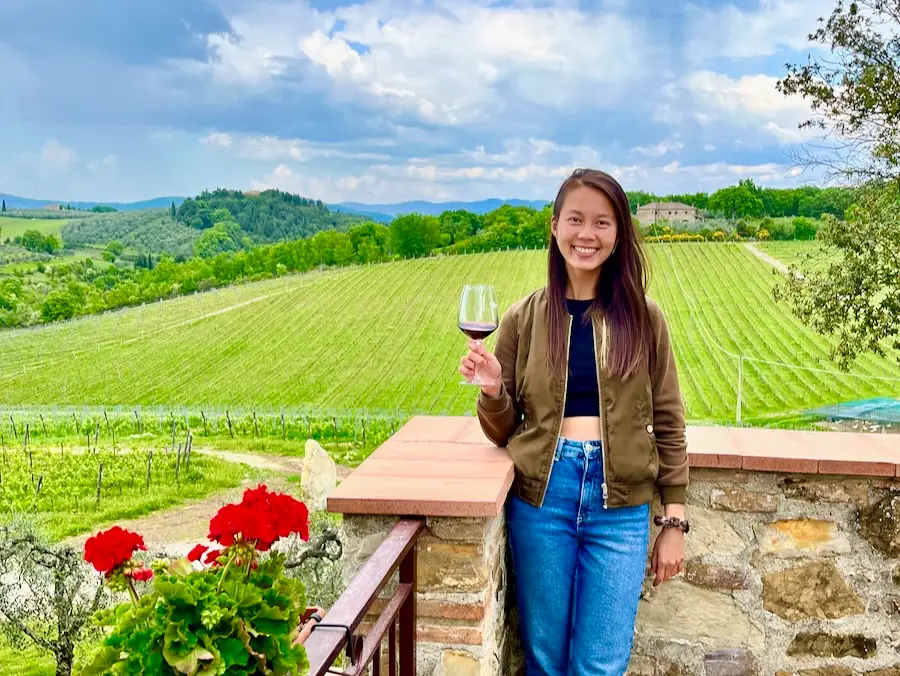
📍 Getting To Florence
Florence is the capital city of the Tuscany region . It’s a two-hour train ride from Rome, making it a great last stop in northern Italy before visiting southern Italy.
🚇 Getting there : If you take the train from Cinque Terre to Florence, you will pass by the Leaning Tower of Pisa . You can get off at the Pisa S. Rossore train station for a quick visit to the tower.
🗓️ How Long To Spend in Florence
Three days is sufficient to visit and see Florence’s top attractions.
🍀 My Take on Florence
Florence is a great city that mixes history and charm , while still feeling like a big city. I spent five days in Florence, which was a bit too long for me, so I recommend spending under five days there.
See how to spend three days in Florence .
To make your travel planning easier , download the trip planner below and use it as a starting point. The planner has country-specific travel information, an itinerary, a packing list, and a map with key places pinned.
The trip planner is built on Notion, which I use for all my travel planning (I genuinely love this tool). If you don’t have Notion, creating an account is free .
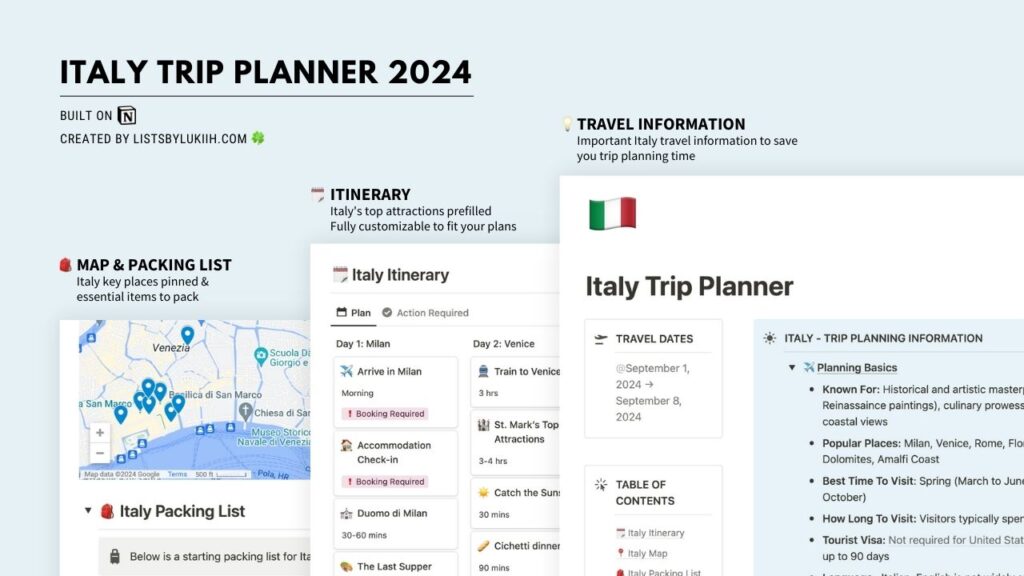
Thoughts? Questions? Leave a comment below .
Italy Travel Guides
- 🇮🇹 Planning A Trip to Italy: 11 Practical Things To Know
- 🎭 Venice Day Trip: 8 Great Things To Do + 1-Day Itinerary
- 👨🎨 3 Amazing Days in Florence: Itinerary With Hidden Gems
- 🧀 Parma, Italy Day Trip: 13 Great Things To Do + Itinerary
- 🌷 Lake Como Day Trip: Itinerary & Firsthand Tips
- 🛶 Best Gondola Rides in Venice: Tips & What To Know
- ⛰️ Hiking Cinque Terre Practical Guide & Firsthand Tips
- 💰 My 2024 Italy Trip Cost: A Budget Breakdown
Lists by Lukiih is Readers-Supported
If you find my travel tips helpful, say thanks with a bubble tea 🧋!
Leave a Reply Cancel reply
Your email address will not be published. Required fields are marked *
Save my name, email, and website in this browser for the next time I comment.

10 Reasons to Visit Northern Italy – The Land of Venice, the Dolomites, the Italian Lakes, and Exceedingly Delicious Food (With Map and Practical Tips)
By Author Rossi Thomson
Posted on Last updated: 15th March 2024
Categories Emilia-Romagna , Friuli Venezia Giulia , Lombardy , Travelling in Italy , Trentino , Veneto
Northern Italy is a great place to visit either by yourself or with your family and friends.
No matter what you are after – a city break, a relaxing holiday, or an active vacation – you are bound to find it here and so much more – from history and art to delicious food, a myriad of sports activities, and lively events..
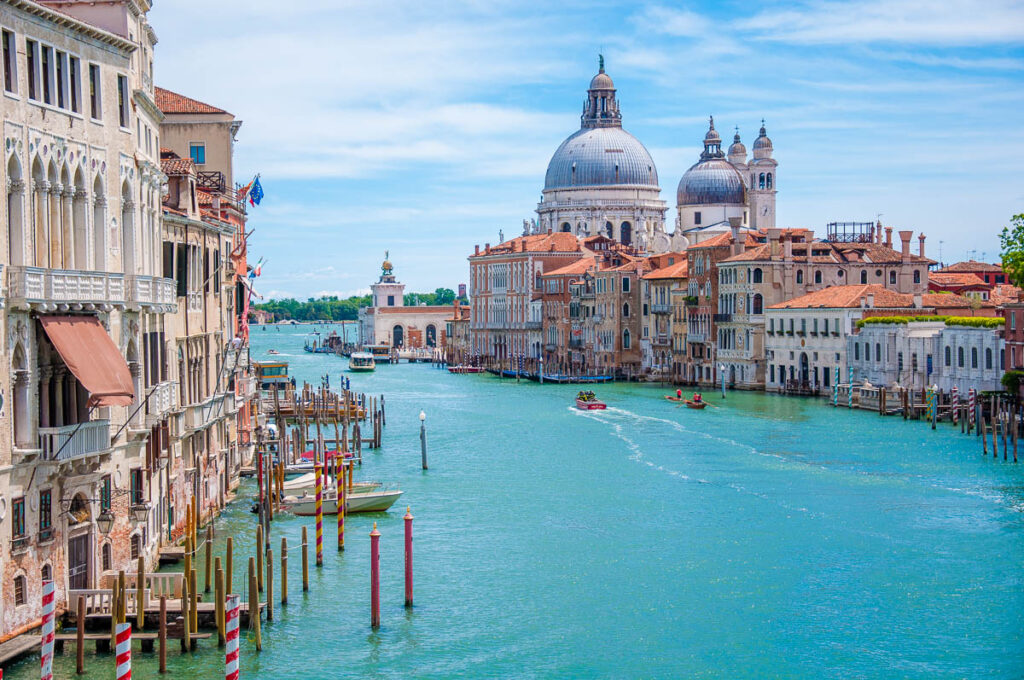
Stretching across the top of the Italian boot, Northern Italy is made of eight regions. From west to east, they are Aosta Valley, Piedmont, Liguria, Lombardy , Emilia-Romagna , Trentino-South Tyrol , Veneto , and Friuli Venezia Giulia .
Many of Italy’s most famous cities are in the country’s north. Among them are Venice , Milan , Verona , Turin, Trieste, Genoa, and Bologna .
Also in the north of Italy, you can visit the always very popular and very picturesque Cinque Terre, Lago di Garda which is Italy’s largest lake, Lago di Como which is Italy’s most famous lake, and the Dolomites – a mighty mountain range which is all the rage for its stunning landscapes and proud craggy peaks.
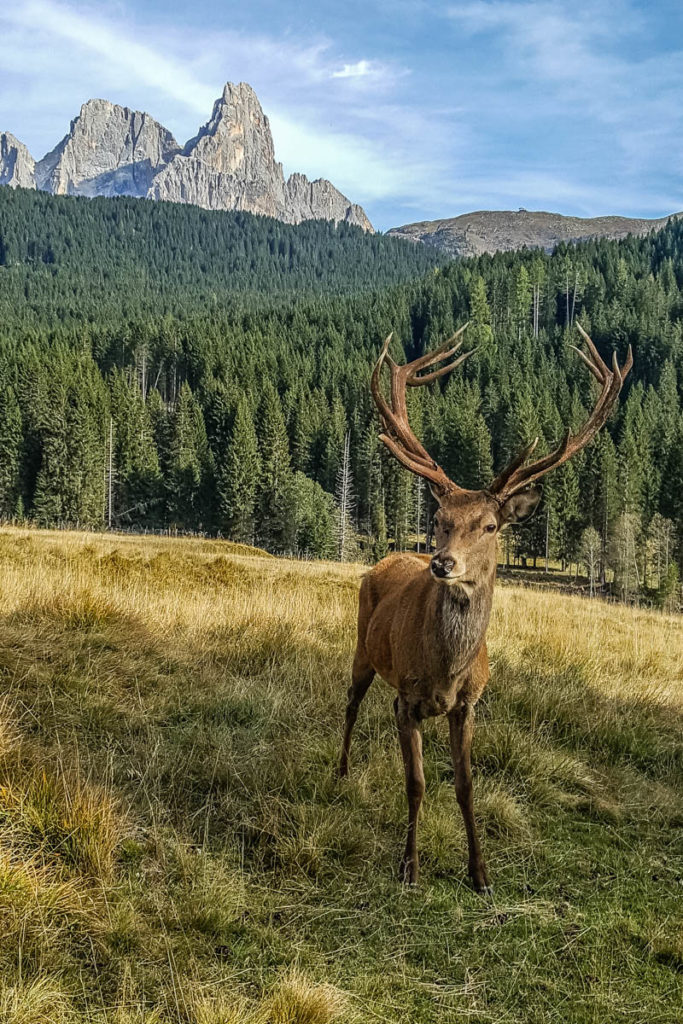
And yet, that’s not all! Rich in hidden gems, culinary delights, and a staggering number of unique landmarks, visiting Italy’s north is a recipe for many wonderful adventures. So, to inspire you to put it on your travel list, today, I will give you ten reasons that make Northern Italy a must-see.
All the detailed information in this blog post is based on my countless trips to Northern Italy over the last almost 20 years. Six of them I actually spent living in Vicenza – a small Northern Italian city halfway between Venice and Verona. Everything I write about herewith is firsthand tried and tested. Now, I am only too happy to pass the word along.
To help your travel planning, I have included a map showing the exact location of Northern Italy in Europe. It also outlines the eight Italian regions that are part of it. Practical tips are peppered throughout the text. I hope that the detailed information, the map, the tips, and the curious details I share with you below will galvanise you to experience Italy’s north for yourself as soon as possible.
Have a look!
Map of northern italy with the 8 northern italian regions and their capitals.
First things first! Let’s start by pinpointing on the map the exact location of Northern Italy and the eight regions it comprises. As you can see Northern Italy spreads across the upper portion of the Italian peninsula and it stands between its calf and the European countries of France, Switzerland, Austria, and Slovenia.
The eight Northern Italian regions are outlined with a different colour each. Their capitals are pinned with blue stars. Here they are:
Aosta Valley (green outline) – known for its mountainous landscapes and ski resorts it has the city of Aosta at its helm.
Piedmont (pink outline) – the land of truffles, hazelnuts, and chocolate has the royal city of Turin as its capital.
Liguria (purple outline) – long, thin, and curved, it’s captained by Genoa and attracts millions of visitors to its cluster of five picturesque villages known as Cinque Terre.
Lombardy (grey outline) – Italy’s most prosperous region is ruled over by the world’s fashion capital Milan.
Emilia-Romagna (blue outline) – the land of delicious food and red-brick buildings is headlined by the city of Bologna with Italy’s oldest University at its heart.
Trentino-South Tyrol (in Italian, Trentino-Alto Adige ) (lilac outline) – with strong Tyrolean influences, majestic nature, hundreds of lakes , and autonomous status, this region has two provincial capitals – Trento and Bolzano.
Veneto (red outline) – with well-developed industry and yet countless corners of pristine nature, this Northern Italian region is known predominantly for its capital Venice and hides many gems like Verona , Padua , and Vicenza in its bosom of history and art.
Friuli Venezia Giulia (orange outline) – the often overlooked northeasternmost corner of Italy lately has been attracting universal acclaim on account of its capital Trieste, coffee traditions, and locally produced wines.
How to Use This Map of Northern Italy?
You can use this map of Northern Italy just like any other Google map. You can zoom in and out, or click on the last icon in the top right corner to open the map in a separate tab.
A click on the first icon in the top left corner will open a list with all destinations – both the eight Northern Italian regions and their respective capitals – pinned to the map. Click on any destination to see its coordinates as well as links to accommodation options and (where available) additional information.
You can also use this map to calculate distances and directions from any point in Italy (or abroad) to the eight Northern Italian regions and their many points of interest. If you want, you can share this map of Italy’s north on social media, too.
10 Reasons to Visit Northern Italy – The Land of Venice, the Dolomites, the Italian Lakes, and Exceedingly Delicious Food
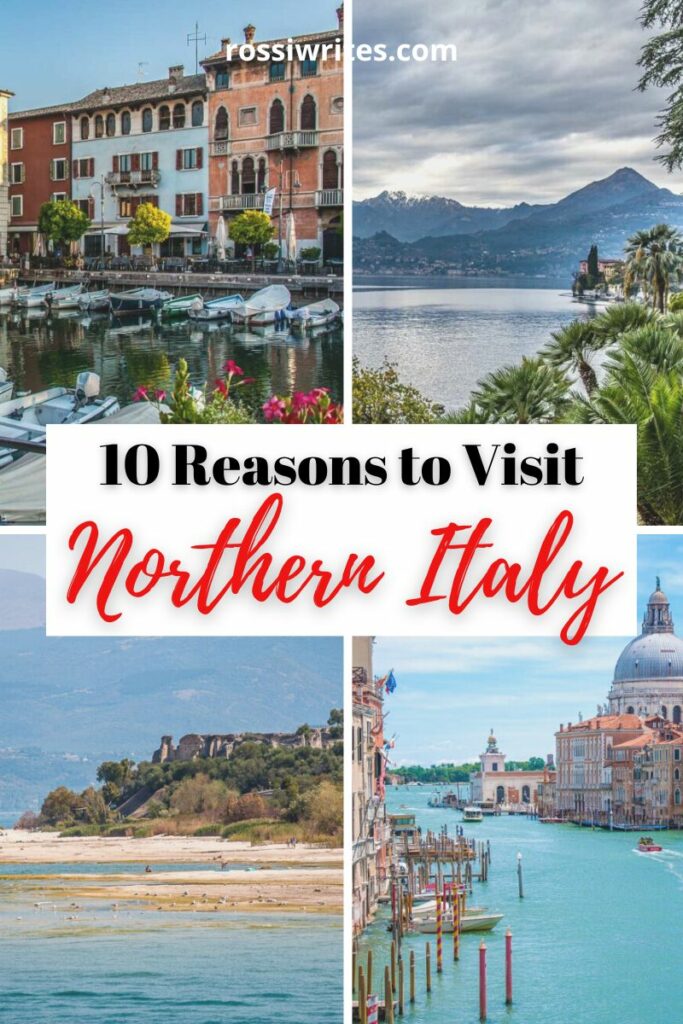
1. Northern Italy’s Many Must-See Destinations
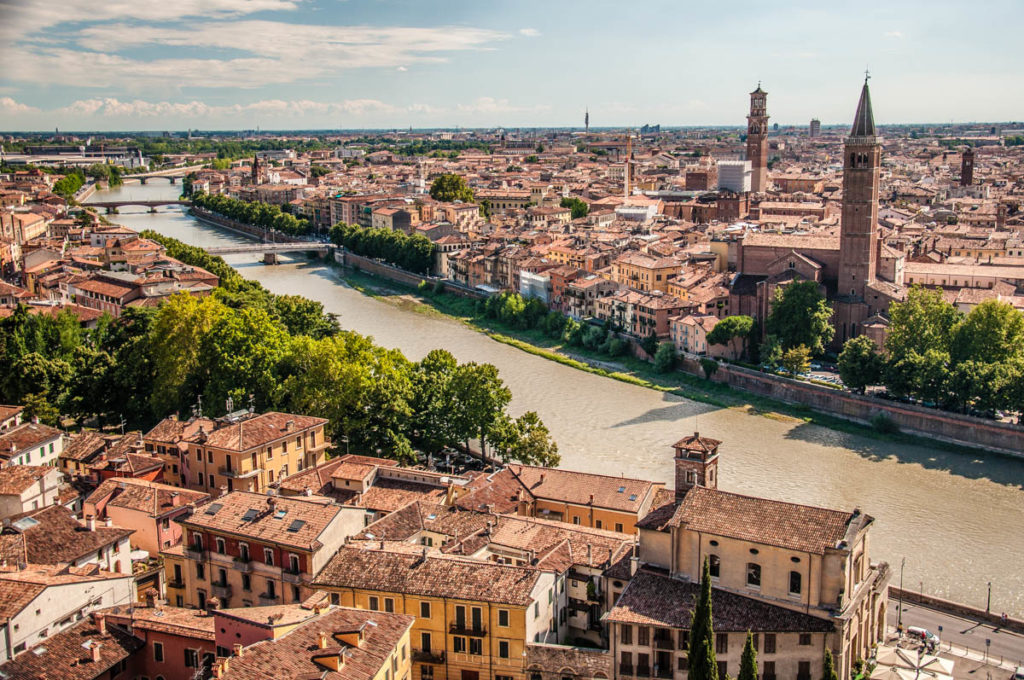
Many of Italy’s most famous destinations are in the northern portion of the country. They are known worldwide and millions of people dream to see them at least once in their lives.
From historic cities to picturesque villages , from stunning landforms to charming lakes, Northern Italy is blessed with many of Europe’s and the world’s most coveted spots. Here they are in a tiny nutshell:
- Historic cities: Venice , Milan , Verona , Bologna , Genoa, Turin, and Trieste;
- Picturesque Villages and Towns: Cinque Terre, Bellagio , Bassano del Grappa , Treviso , and Sirmione ;
- Stunning Landforms: the Alps, the northern portion of the Apennines, the Dolomites, dozens of islands in the Venetian Lagoon;
- Charming Lakes: Garda , Como , Maggiore, and Orta form the quartet of the greatest Italian lakes.
With short travel distances and well-organised public and road transport, many of these worldwide famous destinations in Northern Italy can be visited within the span of the same Italian holiday.
They offer a great mix of history, culture, nature, and art. A visit to them is always a good idea and something that leaves travel memories to last a lifetime.
Practical Tips:
Millions of people flock each year to Northern Italy’s most famous destinations. The best time to visit them is, generally speaking, during the shoulder seasons, i.e. April-May and September-October. This is when the temperatures are very pleasant, the sun usually shines bright, and the tourist crowds are just starting to swell or are already past their most voluminous.
The Christmas season is another great window to visit Northern Italy and it’s usually overlooked by the mass tourists. This is when heartfelt celebrations and festive markets are taking place all over the eight Northern Italian regions giving you a chance to experience authentic Nativity traditions .
When visiting famous landmarks and sights in Northern Italy, it’s always a good idea to book your tickets in advance. This way you will avoid queuing on the day and you won’t be disappointed in case all tickets are sold out for the time slot you are interested in. I usually book in advance through Tiqets and Viator – two large platforms specialised in selling tickets for and guided tours of worldwide famous attractions and museums.
Learn More:
Best Cities in Northern Italy , Venice Landmarks , Best Towns on Lake Garda , Travel Guide for Lake Como
2. Northern Italy’s Deep Layers of History and Art
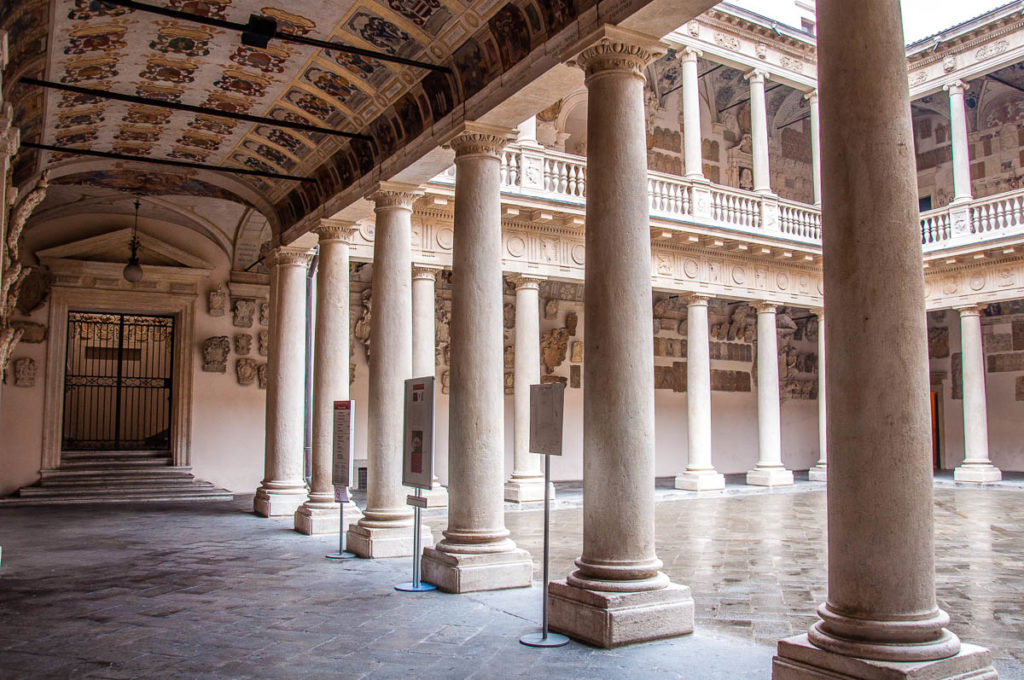
Northern Italy is a must-see corner of Europe if you have an interest in history and art.
Millennia ago, its territory was inhabited by prehistoric tribes many of which had advanced cultures with their own writing systems and intricate crafts. A case in point is the Paleovenetic Este Culture which has left us complex ceramic and metal artifacts. A visit to the National Atestino Museum in the small town of Este in the Northern Italian region of Veneto is an incredible experience if you want to delve deeper into it. Such museums – rich in priceless artifacts and throwing light onto advanced prehistoric cultures – are dotted all over Italy’s north.
When the territory of Northern Italy became part of the Roman Empire, the ancient Romans built majestic public and private buildings, religious temples, and many important roads. Arena di Verona – an imposing amphitheatre that nowadays serves as an exquisite opera and concert venue – is one of the largest surviving Roman structures in the world. A short trip by train away, you also have the monumental ruins of Roman villas on Lake Garda and of Roman temples, a theatre, and private dwellings in the city of Brescia .
Later on, the relations and tensions between the Western and the Eastern Roman Empires also left their imprint on the north of Italy. The mosaic masterpieces of Ravenna and the Byzantine-inspired architecture of Venice are direct references to this historic period.
During the High Middle Ages, Northern Italy was split between many warring factions and dynasties. They built mighty fortresses and castles, several of which still stand and can be visited nowadays. The medieval castles around Lake Garda – many of which were erected by Verona’s Scaliger dynasty – are among Europe’s most impressive medieval fortifications.
The High Middle Ages is also when the first two Universities were founded in Italy. First in Bologna in 1088 and then in Padua in 1222. Today, their historic buildings are open for visits. It’s one of the highlights of a trip to Italy’s north.
The Renaissance tightly embraced Northern Italy. The Renaissance cities of Venice , Vicenza , Mantua , and Ferrara flourished. Priceless works of art were created by the artists of the local branches of the Italian Renaissance with the Venetian School particularly well known. A cultural and scientific exchange between the city-states of Northern Italy and the cities and the states of Northern Europe propelled forward the development of art, medicine, and science.
And then the new history of Italy from its Unification in the 19th century throughout the two World Wars to our days makes for yet another fascinating topic to explore during your visit to the eight Northern Italian regions.
Travel off the beaten path to fully experience the wonders of Northern Italy’s history and art. Everyone wants to see seminal works of art like Leonardo da Vinci’s Last Supper in Milan but there are so many more masterpieces here that are not necessarily in a major landmark or museum. Explore the small Northern Italian towns, enter every church that you come across, and visit small, local museums and sights.
Soon, you will notice how your understanding of Italy’s art and culture grows and deepens, how your appreciation for a work of art doesn’t depend anymore simply on name recognition. We are too used to narrowing history and art down to a couple of dozens of events and names. One of the best things about travel in Northern Italy is that it helps you look beyond these limitations and experience things on a deeper level.
Italy’s Historic Universities , Venice for Art Lovers , Looking Slowly in Italy
3. Northern Italy’s Well-Organised Transport System
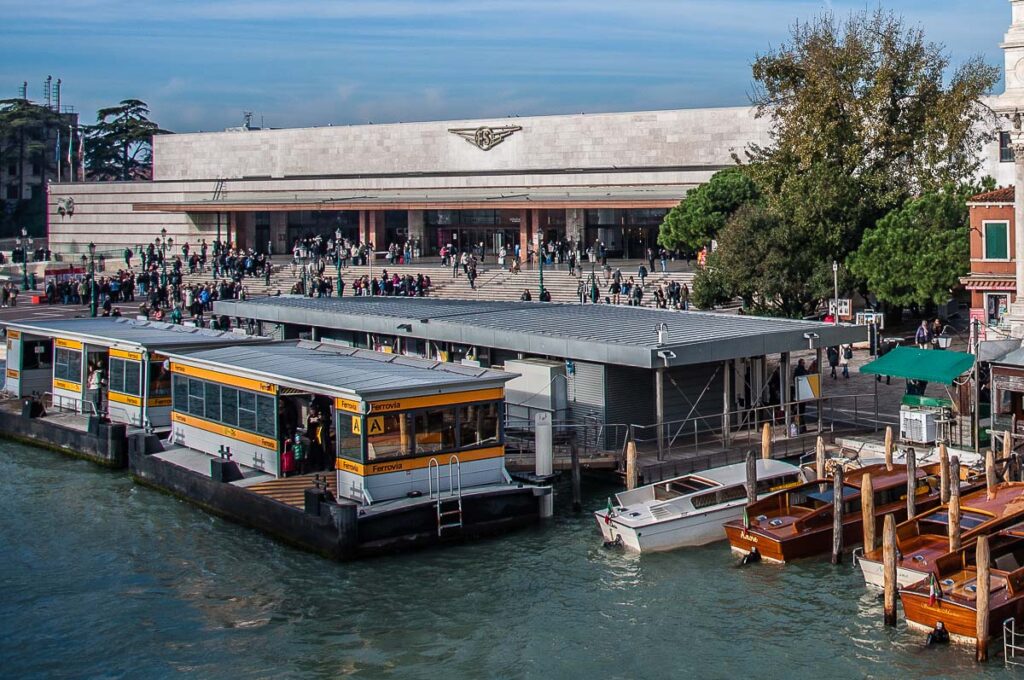
Northern Italy is incredibly easy to get around. Served by almost a dozen major airports , the northern strip of the country is quick to reach from anywhere in Europe and the world.
Once arrived, you can then rely on a well-organised transport system to take you anywhere by railway and/or road – from the main tourist magnets like Venice and Cinque Terre to historic towns like Ravenna , Cittadella , and Palmanova .
High-speed trains – Frecciarossa , Frecciabianca , Frecciargento , and ItaloTreno – connect Northern Italy’s main cities. A major railway line runs from Turin (the capital of Piedmont) in the northwest to Venice (the capital of Veneto ) and Trieste (the capital of Friuli Venezia Giulia) in the northeast. High-speed railway services also connect Italy’s north to the rest of the country.
As such, you can reach Venice from Milan in only two and a half hours, Verona from Venice in only an hour and a quarter, Genoa from Milan in an hour and a half, and Verona from Bologna in less than an hour.
Fast regional trains (in Italian, treno regionale veloce ) connect Northern Italy’s smaller cities and towns to the major destinations here, too. Inexpensive and running dozens of times throughout the day, they offer countless opportunities for exciting explorations and day trips .
A network of buses provides an easy-to-use and generally cheap public transport within the Northern Italian cities and towns. It also connects them to the local villages, beaches, mountains, and landmarks.
Plus, the historic centres of the Northern Italian cities and towns are usually very walkable. Just bring your comfiest pair of shoes and you can easily get from sight to sight simply by walking around.
If you prefer to travel by car, then you are also in luck. Modern motorways stretch across the north of Italy providing easy access to anywhere you may want to go.
Some of the most important ones are:
- Autostrada A4 ( also known as Serenissima ) – it connects Turin and Trieste via Milan, Brescia , Lake Garda , Verona , Vicenza , Padua , and Venice ;
- Autostrada A7 ( also known as Serravalle ) – it connects Milan to Genoa;
- Autostrada A13 ( also known as Euganea ) – it connects Bologna to Padua ; and
- Autostrada A21 ( also known as dei Vini ) – it connects Turin to Brescia .
This helpful website will give you an estimate of how much the tolls are going to cost. Alternatively, you can use Northern Italy’s network of provincial and regional roads which are free to drive on.
Beyond trains, buses, and cars, in Northern Italy, you can also catch a ferry (for example, on the Northern Italian lakes), a vaporetto (water bus) and a gondola in Venice , a tram in Padua , a metro in Brescia , Genoa, and Milan. Transport options truly abound.
To check train times and book train tickets in advance, I find the following three websites very useful: Omio , ItaloTreno , and TrenItalia .
To check ferry timetables for Lake Garda , Lake Como , and Lake Maggiore, have a look at the official ferry website of Navigazione Laghi . It has an English interface and provides you with useful details about the different ferry lines that crisscross Northern Italy’s greatest lakes and the lakefront towns they connect.
Finally, if you are researching transfer options from Northern Italy’s major airports, have a look at the blog posts linked below. Alternatively, you can use a travel search engine like Viator which can show you available airport transfers by car, taxi, and bus for different cities and destinations in Italy’s north.
Airports: Major Airports in Northern Italy , Airports for Venice , Airports for Verona , Airports for Lake Como , Airports for Lake Garda
Day Trips: Day Trips in Italy , Day Trips from Venice , Day Trips from Verona , Day Trips from Padua
Venice to Padua , Venice to Verona , Venice to Lake Garda , Venice to Milan
Milan to Venice , Milan to Verona , Milan to Lake Garda , Milan to Lake Como
Verona to Lake Garda , Verona to Milan , Verona to Venice
Bologna to Verona , Bologna to Lake Garda , Bologna to Venice , Florence to Venice
4. Northern Italy’s Sparkling Beaches and Majestic Mountains
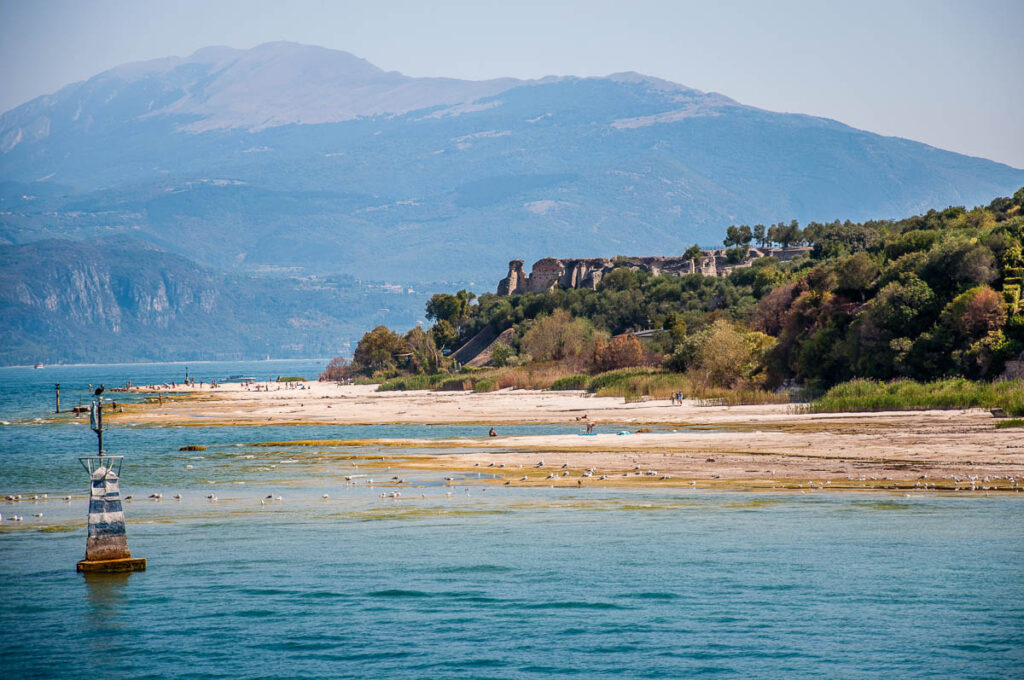
Northern Italy is blessed with some of the best beaches and mountains on this side of Europe. No matter what you are after – a hiking holiday in the hills or a relaxing stay by the sea, there are plenty of options to choose from.
In summer you are never too far away from a sparkling beach in this corner of Italy. It could be the gorgeous Ligurian beaches or the sandy beaches on the Adriatic coast with their endless lines of colourful umbrellas and sun loungers. It could be a pebbly lake beach or a wild beach where the locals congregate to cool off during the hottest days of July and August.
At the same time, Northern Italy’s mountains – the Alps, the Dolomites, and the northern portion of the Apennines – provide great opportunities to relax and to keep active. Right in the bosom of nature, you can take it easy with light walks and panoramic views or engage in many different sports – from paragliding in summer to snowboarding in winter.
Even better, in Northern Italy, you can combine beach and mountain within the same holiday. With short travel distances and a great variety of nature, you can spend time sunning yourself by the water and then hiking in the hills or vice-versa.
For example, if you book a summer vacation on the beaches of Jesolo near Venice, you can then enjoy a day trip to the Dolomites . Or, if you head to the beaches of Rimini, just down the road you can explore the hilltop Republic of San Marino . And if you stay at Lake Garda , Lake Como , or Lake Caldonazzo , you can literally do beach and mountain on the same day.
Even if you visit Northern Italy during the cold season, you can still have the best of both worlds – water and heights. Dozens of spa resorts here have amazing swimming pools fed by hot natural springs. Often, these spa resorts or even spa towns are next door to hilly groups. A case in point are the Euganean Hills in the Northern Italian region of Veneto . A short distance away from Padua and Venice, you can spend time here taking advantage of the warm natural springs and then exploring the lush hills.
If beaches and mountains are on your travel list for Northern Italy, don’t forget to bring suncream , insect repellent , adequate shoes, and appropriate clothing. In summer, the sun is very strong and mosquitoes can be relentless. Protecting your skin can be the difference between a great and a miserable holiday.
Good, comfortable shoes with a grip are paramount if you go hiking. Make sure that you research well the local trails before heading out. Often, people are seduced by the idea of taking photos of a beautiful place and then they try to hike to it without suitable shoes and gear. Always put safety first and pick a hike according to your abilities. Don’t bring small children to trails that are not suitable for them.
There are so many wonderful and beautiful corners to explore in the mountains and hilly groups of Northern Italy that there is no need to fixate on a particular spot just because it is popular on Instagram. Next door to it there will be dozens of other stunning locations which may not require a great effort or specialist equipment to reach.
Beaches in Northern Italy: Top Tips for Lake Garda Beaches , 3 Unmissable Lake Garda Beaches , Giamaica Beach , Beaches Near Venice
Easy Hikes in the Dolomites: Paneveggio – The Violins’ Forest , Cadini del Brenton and Cascate della Soffia , Grotta Azzurra di Mel
Easy Hikes around Lake Garda: Tibetan Bridge , Rocca di Garda , Campo di Brenzone , Punta di San Vigilio , Madonna della Corona
Easy Hike in the Little Dolomites: The Path of the Big Trees
5. Northern Italy’s Gorgeous Lakes
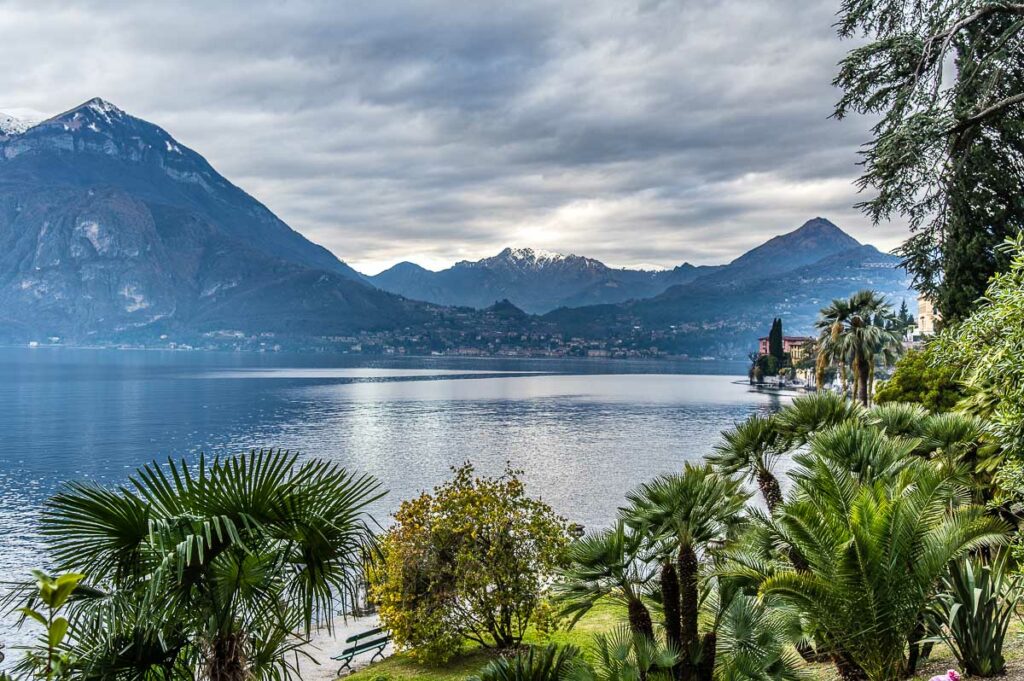
The great quartet of Italian lakes – Garda , Como , Maggiore, and Orta – sparkles brightly in the crown of Northern Italy.
With cute lakefront towns, splendid panoramic views, unique local traditions, and dozens of opportunities to sightsee and keep active, these four Northern Italian lakes attract millions of visitors each year. The best bit is that they are close to several important cities in the north of Italy and can be visited just for the day or for a longer holiday when you crave contact with nature.
As such, Milan is the gateway to Lake Como. Verona is next door to Lake Garda. Bologna and Venice are a train ride away from Lake Garda, too. Just make sure that you take the high-speed train!
You don’t have to head to the largest lakes to have a wonderful lake time in Northern Italy, though. There are hundreds of other lakes here – both big and small. From Lake Iseo which became famous for The Floating Piers installation by the late artist Christo to the surprisingly warm Lake Caldonazzo which is lovely to swim in, the choice truly is staggering.
I particularly like the tiny Lake Tenno. It has bright turquoise waters and takes about an hour to circumnavigate on foot. You will find it in the autonomous Northern Italian province of Trentino which in total has 297 lakes !
Italy’s largest and best theme parks are dotted around the southern shore of Lake Garda. Among them are Gardaland , Movieland the Hollywood Park , and Parco Cavour . Many waterparks, thermal parks, and garden parks are also here.
Northern Italy’s lakes, in general, are great for water sports, too. Lake Garda offers fantastic conditions for sailing, windsurfing, and kitesurfing. There are many beaches on its shores, too.
Swimming and water sports, however, are forbidden at some lakes here though. A case in point is the very famous Lake Sorapis. It can be reached only via a long, arduous hike in the Dolomites. It’s incredibly cold and has a stunning milky blue colour. Swimming and dipping here are not allowed to protect the lake’s fragile ecosystem.
If you visit a Northern Italian lake where sports and swimming are not allowed, please, respect the restrictions. They are in place to protect both nature and human lives. Plus, steep fines are in place to deter infringers.
Lake Garda: Best Sights , Best Towns , How to Navigate the Lake , Theme Parks , Beach Tips , Best Beaches , Giamaica Beach , Desenzano del Garda , Lazise , Malcesine , Riva del Garda , Torri del Benaco , Punta di San Vigilio , Campo di Brenzone
Lake Como: Travel Guide , Best Towns , Best Things to Do , How to Navigate the Lake , Best Airports , Milan to Lake Como , The Beauty of the Lake , Nesso
Other Lakes in Northern Italy: Lakes in Trentino , Lakes in Veneto
6. Northern Italy’s So Many Hidden Gems
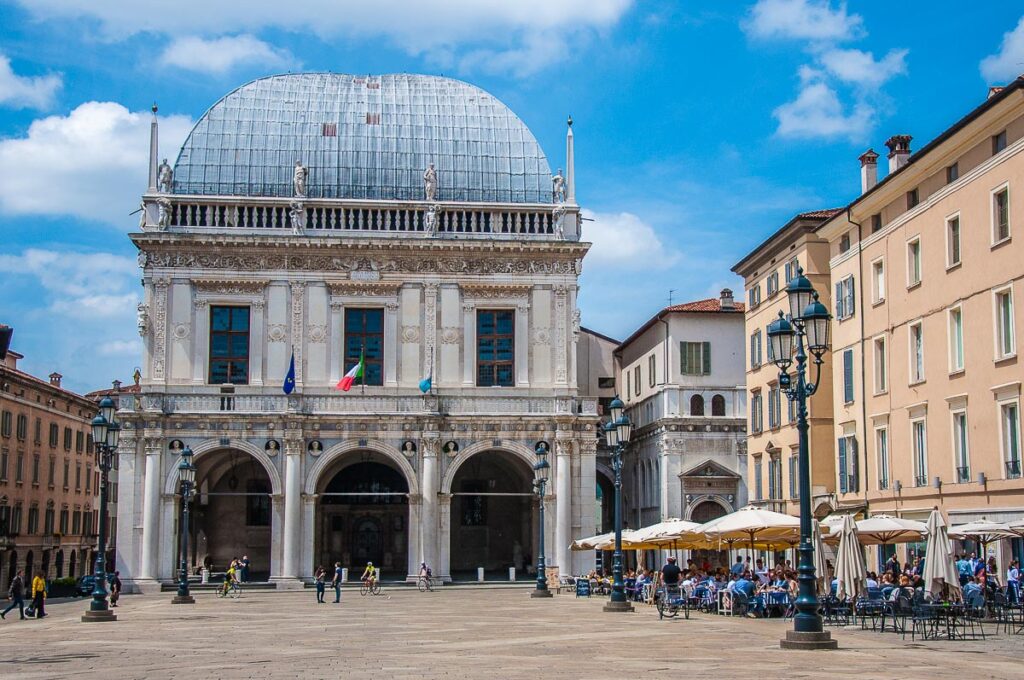
This is my favourite thing about Northern Italy as a travel destination. There is so much to do and see here off the beaten track. It’s absolutely amazing and very inspiring!
While everyone has heard of Venice and Milan, Verona and Bologna, Lake Como and Lake Garda, Cinque Terre and the Dolomites, there are hundreds more corners to explore and fall in love with in the north of Italy. Not to mention the dozens of incredibly beautiful historic villages, the many nature reserves, Italy’s longest river – Po, Italy’s shortest river – Aril , the province of Trentino with its 297 lakes, and so much more.
If you need more examples, here, in alphabetical order, are five of my favourite ones:
Brescia – halfway between Milan and Verona, this must be Northern Italy’s most underrated city. With rich layers of history that span 3,200 years, come here for monumental Roman ruins, a hilltop medieval castle, and splendid squares with Renaissance and Modernist architecture.
Chioggia – Spread on a handful of small islands on the southern edge of the Venetian Lagoon, this picturesque town was once a rival of Venice. Free of maddening crowds and with amazing beaches next door, the local dishes based on fresh seafood make Chioggia a must-see yet little-known place.
Ferrara – one of Italy’s most important Renaissance destinations, this small city has a picture-perfect historic centre and an imposing castle surrounded by a deep moat.
Lake Iseo – halfway between Lake Garda and Lake Como, this is a spectacular lake surrounded by mighty mountains and with shores dotted by cute little towns. Hosting one of Europe’s largest lake islands – the picturesque Monte Isola – Lake Iseo is also where you will find pristine nature and whimsical landforms. The Torbiere del Sebino Nature Reserve with its white waterlilies and the Zone Pyramids are two of them.
Val Camonica – a large valley in the Central Alps, here you can see one of the world’s largest collections of prehistoric rock drawings. This was Italy’s first UNESCO World Heritage Site and you can easily reach it from Brescia , Verona , and Milan.
Northern Italy has hundreds of little-known gems. The best bit is that here you don’t even need to dig deep or travel far to come across wonderful places that are rich in history, architecture, nature, and art.
One of the easiest and quickest ways to discover unique and inspiring destinations in Northern Italy is to head to its medieval villages and walled towns. With a history that spans many centuries, often commanding beautiful panoramic views, and preserving impressive defensive walls and castles, they are a delight to explore and spend time at.
These are also places where you will come in touch with ancient traditions and where you can savour delicious local foods.
I wholeheartedly recommend the walled town of Cittadella , the medieval hamlet of Borghetto sul Mincio , and smaller cities and towns like Ravenna , Comacchio , Vicenza , Este , and Montagnana . Each one of them – small, compact, and easy to explore on foot – has a tremendous richness of architecture, history, and art. Yet, they are little known by the tourist masses and you can enjoy their beauty in peace.
Small Towns in Veneto , Cities and Towns in Lombardy , Adventures in Veneto , Villages in Emilia-Romagna , Villages in Friuli Venezia Giulia , Villages in Veneto , Colourful Places in Veneto , Mysterious Places in Veneto
7. Northern Italy’s Musical Heritage
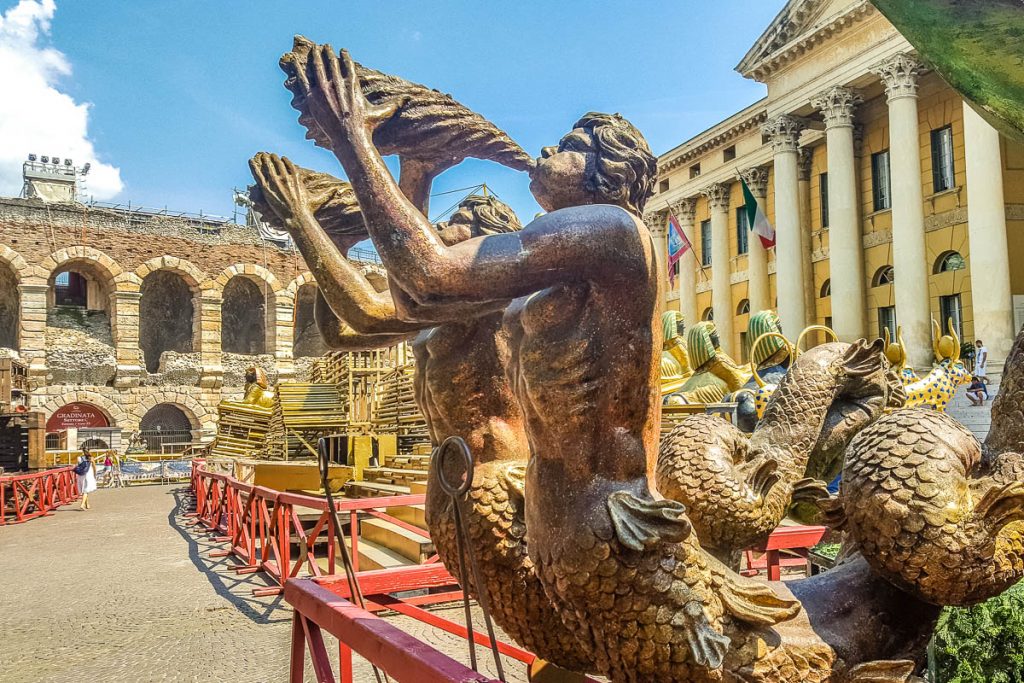
Northern Italy also has lots to offer to those who love music and want to dedicate time to extraordinary music experiences.
Some of the world’s most lavish historic opera theatres are here. From La Scala in Milan to La Fenice in Venice, you can watch splendid performances in lavish surroundings. The world’s most famous opera festival takes place every summer in the ancient Roman Arena in Verona. Listening to world-class singers whilst sitting under a starry sky on 2,000 years old stone benches is a memory that stays with you forever.
Museums dedicated to musical instruments and their history are also dotted all over Northern Italy. The most famous of them all must be the Violin Museum in Cremona. This small Northern Italian city is also where you can see historic luthier workshops where violins and other string instruments have been made by hand for decades and centuries.
You can get closer to music in many different ways in Northern Italy. Music festivals take place here regularly all throughout the year. There is something for everyone – from classical performances to pop, rock, and alternative concerts by some of the greatest names in today’s music.
In Northern Italy, you can also visit the historic homes of some of the world’s greatest composers and singers. For example, Giuseppe Verdi’s birth house near the city of Parma in the region of Emilia-Romagna. A short drive away is the elegant Villa Verdi where the composer spent the last years of his life. Near Modena, also in Emilia-Romagna, you can visit the house museum of the great Italian tenor Luciano Pavarotti.
And when you crave peace and quiet, you can still be close to music in Northern Italy. A great experience, for example, is to visit the Violins Forest in the Dolomites. For centuries, this lush, deep forest has been providing the wood for prized instruments. They say that even Stradivari would get the wood for his famous violins from here.
Attending a concert or a performance in Northern Italy’s lavish opera houses is a great experience. Alternatively, you can visit them during the day when they open their doors to be explored just like museums. Milan’s La Scala and Venice’s La Fenice are particularly beautiful. And, usually, you can simply walk in off the street and admire the splendid foyer and the frescoed cafe of Teatro Grande in Brescia where a handwritten letter by the composer Puccini hangs on the wall.
Churches, basilicas, and cathedrals are another venue to head to for exquisite music performances in Northern Italy. The Christmas and Easter concerts in Venice’s Basilica dei Frari and Milan’s Duomo are a heartfelt experience. Plus, the Duomo’s Music Chapel is Milan’s oldest cultural institution and it has been active since 1402.
In Venice – the birthplace of the famous composer Antonio Vivaldi – you can also enjoy a concert of Baroque music or a performance of his Four Seasons .
Paneveggio – The Violins’ Forest , A Postcard from Cremona
8. Northern Italy’s Exceedingly Delicious Food and Culinary Traditions
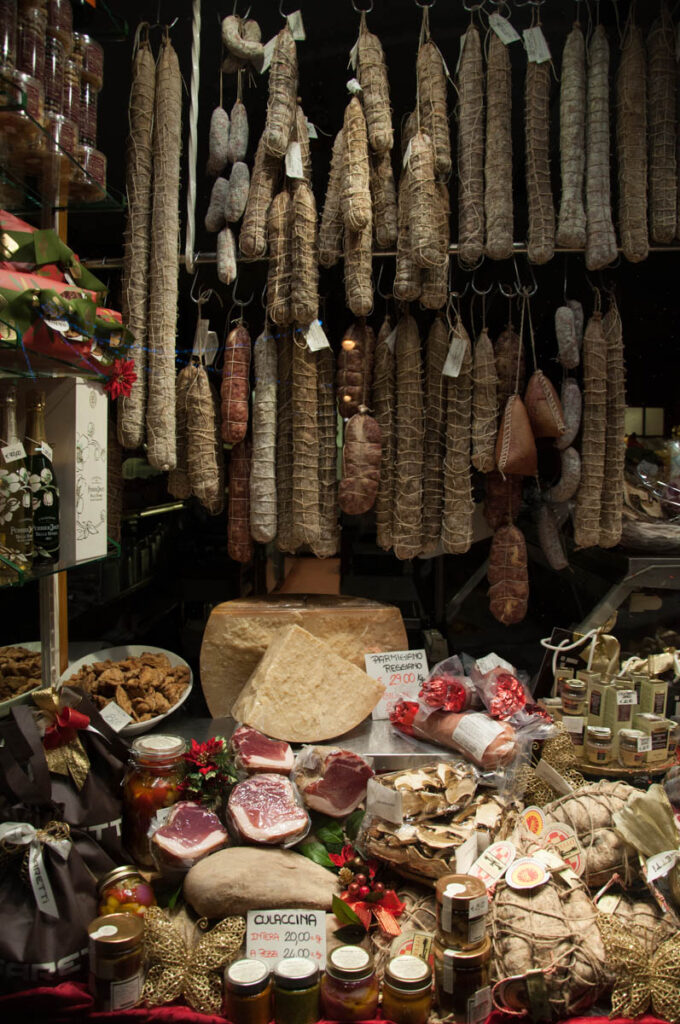
Northern Italy has eight regions and each one of them has its own traditional cuisine.
No! Scratch that! Northern Italy has eight regions, 47 provinces, dozens of large cities , countless towns and villages. And you can say that each one of them has a dish that’s unique to it and exquisite culinary traditions that took shape over the course of many centuries.
Millions of people travel to Italy each year eager to have the best pizza and pasta in their lives. Northern Italy offers so much more than that. So, dial-up your culinary expectations and get your taste buds ready to savour:
- polenta in many different variations and applications (it’s not in vain that the Northern Italians are known as polentoni !)
- love-knot tortellini from Valeggio sul Mincio which also have a romantic legend attached to their origin;
- Vicenza’s baccala’ alla vicentina – a dish that was born as a result of one of Europe’s oldest food routes;
- pumpkin tortelli from Mantua – a delicacy with medieval roots;
- prosciutto berico-euganeo DOP from the town of Montagnana – officially recognised as one of the best dry-cured hams in all of Italy, it even has a Protected Designation of Origin (DOP) status;
- coppa Piacentina DOP – thinly sliced cured meat which is produced exclusively in the area around the Northern Italian city of Piacenza;
- strudel from Trentino-South Tyrol and also from Veneto where the wide availability of several Austrian cakes and desserts testify to the historical events in these lands;
- mandorlato from Cologna Veneta and torrone from Cremona – a Christmas nougat made of egg whites, sugar, honey, and almonds.
Even Northern Italian foods, dishes, and desserts that are known all over the world have so many more nuances to them in the actual places where they were first created. Treviso’s tiramisu, Milan’s panettone , Verona’s pandoro, Parma ham (Prosciutto di Parma), and Parmesan cheese (Parmiggiano Reggiano) are only some of the applicable examples.
Eating is not the only way to experience the rich culinary traditions of Italy’s north. Once here, you can also take a cooking class, visit a sagra (a local food event), explore a winery, spend time at an agriturismo (an independent farm), browse food markets that have been held at the same spot for centuries, book food tours , visit producers specialised in a particular delicacy, embrace sweet breakfasts , enjoy proper Italian aperitivo, explore culinary libraries (read here about the one in Vicenza), enjoy chocolate festivals , and get close to the Northern Italian food traditions in so many more different ways.
Food, coffee , and wine are a big component of the culture of Northern Italy. To fully experience this wonderful place, be ready to taste and savour the local dishes and drinks while learning the stories behind them.
From the coffee shops of Venice – the first city in Europe to commercially import coffee in the 16th century – to the chocolate companies of Turin – where some of Italy’s and the world’s most popular chocolates were invented ( Ciao, Nutella! ), there is lots to eat and drink in the north of Italy.
The best tip I can give you is to be curious and be ready to taste something new every day here. Leave preconceptions about what Italian food should look and taste like and embrace the local flavours and culinary delights of Northern Italy.
Breakfast: Rules of Italian Breakfast , Italian Breakfast Foods
Food: Italian Markets , Cheap Eats in Italy , The Food of Lake Garda , 10 Reasons to Eat Polenta , Traditions of Panettone , Italian Cheeses , Mandorlato Veneto , Italian Food Gifts , Venetian Frittella , Pasticceria Soraru , Castagnata , Caperberries
Italian Coffee: Italian Coffee Culture , Italian Coffee Drinks , History of Coffee in Italy
9. Northern Italy’s Hundreds of Opportunities to Keep Active
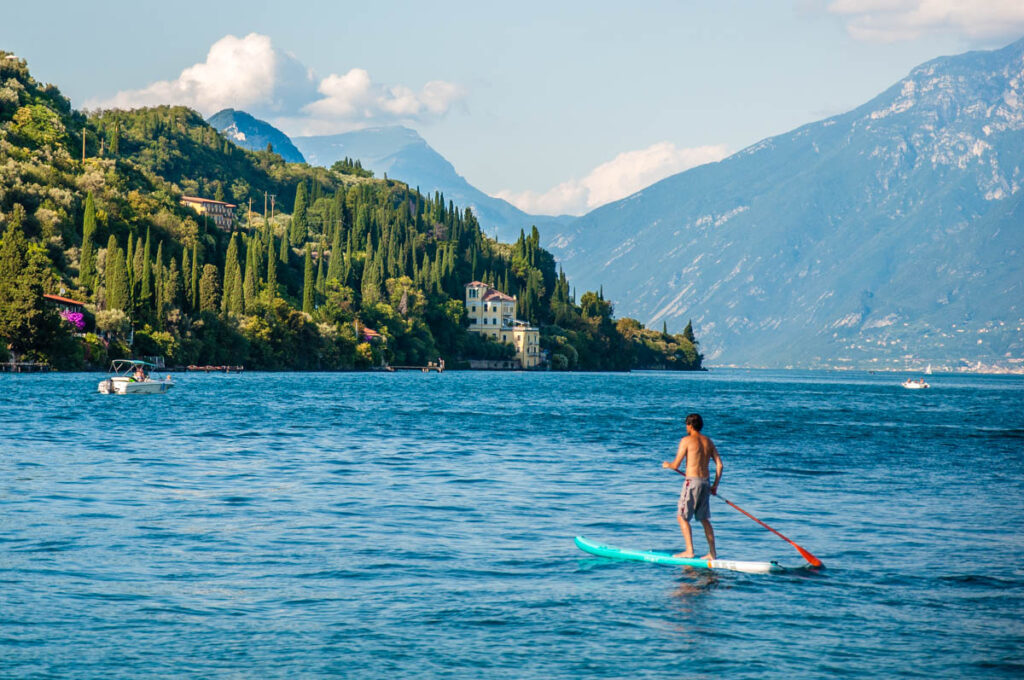
Northern Italy is a great destination to head to if you like to keep active. The Italians love sports. Cycling and hiking are especially popular. Children start to cycle from an early age. Many adults cycle to work every day and spend time in the bosom of nature on weekends. In winter, skiing, snowboarding, and snowshoe walking are the order of the day.
Being outdoors, exercising, and practising dozens of different sports is not a difficult feat in Northern Italy. You can either dedicate your whole holiday here to sport and exercise or alternate sightseeing and relaxation time with physical activities.
In summer, you can pick from Nordic walking, horse-riding, forest bathing, hand-gliding, swimming, paddleboarding, and windsurfing (to mention but a few of the many different options). In winter ski resorts abound.
Even if you prefer to be a sports spectator rather than an active participant, you are still in luck in Northern Italy. From football matches and stadium tours to the forthcoming Winter Olympics in 2026, there is something for everyone who enjoys watching competitive sports.
And if you prefer your sports with a touch of history, then head straight to Venice. Rowing and sailing regattas inspired by historic events are held here several times throughout the year. Especially popular are the Regatta Storica each September and the Regatta of the Historic Maritime Republics which takes place in Venice once every four years.
Northern Italy’s lakes are wonderful destinations for anyone who loves water sports. Lake Garda and Lake Como , for example, are two of the best spots for windsurfing and kitesurfing in Europe. There are many sailing clubs here that hold regattas throughout the year.
Dozens of winter resorts are dotted all over Northern Italy. Aosta Valley and Trentino-South Tyrol are particularly good destinations for snow sports. Yet, you will find great pistes in Asiago and Monte Baldo in Veneto, Val Camonica and Val Trompia in Lombardy and many more Northern Italian destinations.
10. Northern Italy’s Excellent Shopping
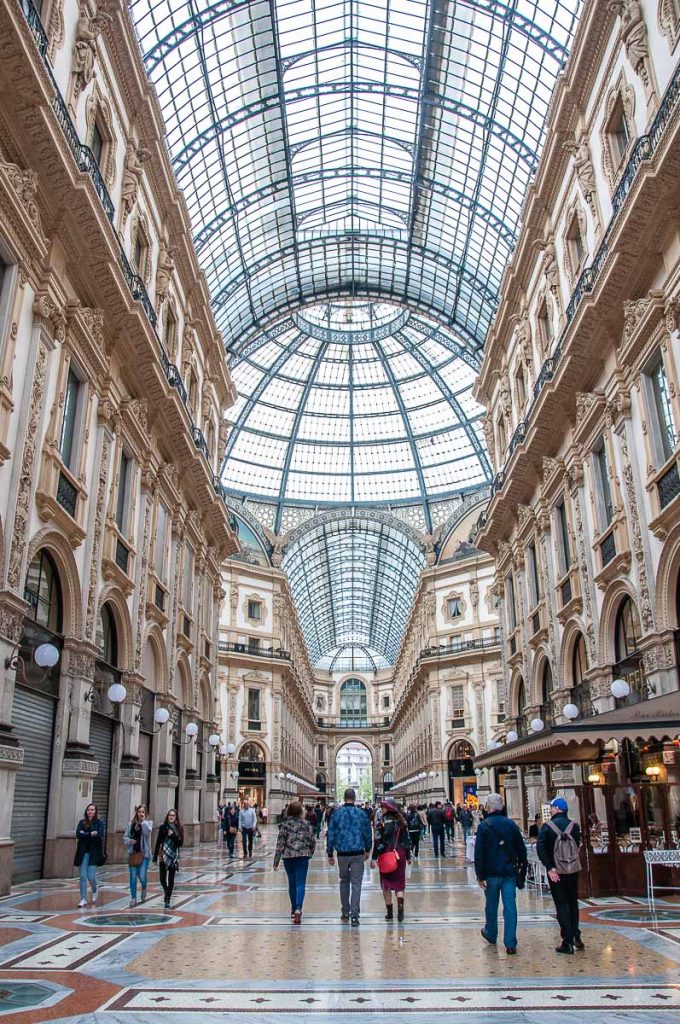
Northern Italy is a great place to visit if you like to shop.
Many renowned Italian brands – both high fashion and high-street – have their headquarters and factories here. The fashion capital Milan has the stunning Galleria Vittorio Emanuele II. Pictured above, it’s considered to be Italy’s oldest active shopping mall.
Several large outlet villages operate near important Northern Italian cities like Venice, Turin, and Brescia . This is where you can shop for branded products at significant discounts:
- Serravalle Outlet Village with more than 230 shops in Piedmont;
- Franciacorta Outlet Village with more than 160 boutiques in Lombardy ;
- Noventa di Piave Designer Outlet with over 150 shops in Veneto ; and
- Fidenza Village with more than 120 boutiques in Emilia-Romagna and with easy access from Lombardy, too.
In addition, large shopping centres stand on the outskirts of the main Northern Italian cities and towns. Inside them, you will find hundreds of shops selling the latest fashions, stylish homewares, Italian jewellery, and anything else, really.
And that’s not all!
Northern Italy is where you will find some of the best artisans and most exquisite craft products in Europe. From the masters of Murano glass in the Venetian Lagoon and the jewellers of Vicenza to the violin-makers of Cremona and the pottery-makers of Faenza, Nove, and Bassano del Grappa, there are hundreds of artisan workshops here to visit, explore, and acquire unique pieces from.
If shopping is serious business for you, then try to visit Italy during its annual sales. Traditionally, they take place twice a year – once at the start of January and then again in June/July. This is when shops offer great discounts and you can shop til you drop.
In Conclusion
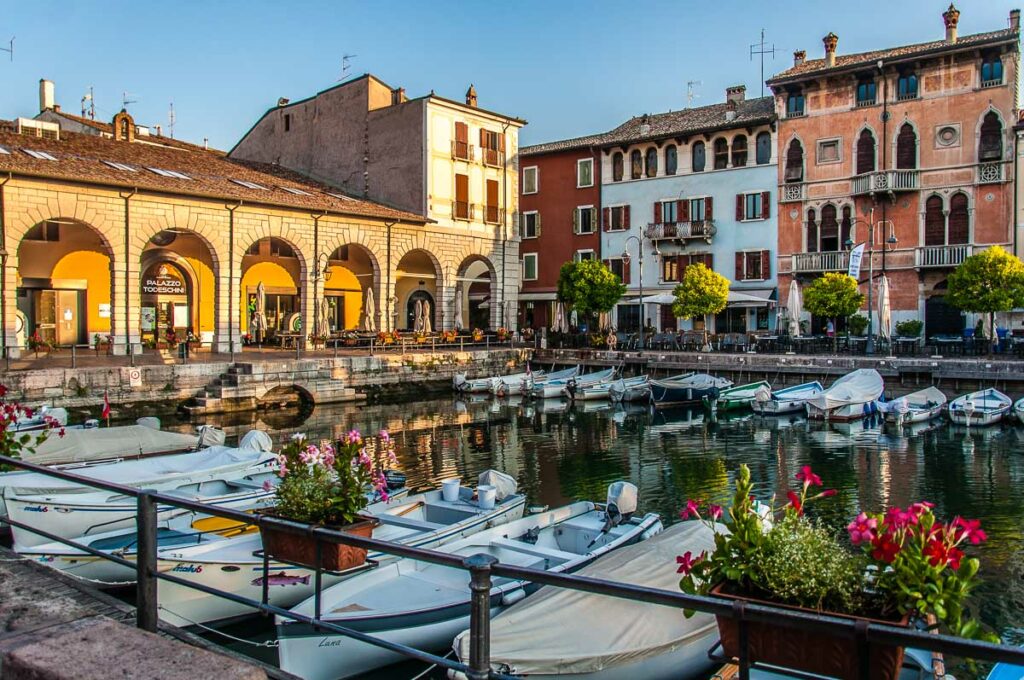
Northern Italy has a lot to offer to the traveller seeking to have a wonderful and memorable holiday. A land with a millennial history, beautiful nature, and a rich catalogue of art, this is a corner of Italy that has to be visited at least once in a lifetime.
Easy to reach by plane, train and car from anywhere in Europe and with a well-developed public transport network, Northern Italy has many cities and towns that are wonderful destinations for short breaks and long holidays. If you are looking for a new and intriguing place to visit, in this blog post I gave you ten reasons why the north of Italy may just be it.
From music and art to exceedingly delicious food and adrenaline sports, from mountains and lakes to beaches and hills, from museums and landmarks to large theme parks, there is something for everyone here to enjoy. I hope that all the first-hand tried and tested information shared herewith as well as the map of the eight Northern Italian regions will help you during the planning stages of your holiday.
Have a great time in Italy’s north!
Enjoy every northern italian experience, travel tools, get ready for your trip to northern italy.
Get a guidebook from Amazon. Buy plane tickets , train tickets , and bus tickets through Omio. Rent a car from Europcar. Research accommodation on Booking.com. Select local tours and activities on GetYourGuide , Viator , and Tiqets .
More Helpful Information About Italy for You
Best of Italy: Italian Piazzas , Italian Markets , Accommodation for Every Budget , Best Times to Visit Italy , Italy in Summer , Italy with Kids Italian Food: Best Italian Food Gifts , Cheap Italian Food , Rules of Italian Breakfast , Italian Breakfast Foods Italian Coffee: Italian Coffee Culture , Italian Coffee Drinks , History of Coffee in Italy Christmas in Italy: Fun Facts , Things to Do , Italian Nativity Scenes , Panettone , Christmas Guide Northern Italy: Best Cities to Visit , Major Airports , Reasons to Visit Lake Como: Ultimate Travel Guide , Best Towns , Best Things to Do , How to Get to Lake Como , Reasons to Visit in Winter , Inspiring Photos , Nesso , Milan to Lake Como Lake Garda Towns and Villages: Best Towns , Desenzano del Garda , Lazise , Riva del Garda , Malcesine , Torri del Benaco , Punta di San Vigilio , Campo di Brenzone , Borghetto and Valeggio sul Mincio Visiting Lake Garda: Map of Lake Garda , Getting Around Lake Garda , Food of Lake Garda , Lake Garda with Kids , 8 Best Airports , Venice to Lake Garda , Verona to Lake Garda , Milan to Lake Garda , Bologna to Lake Garda Verona: Things to Do in One Day , Verona Opera Festival , Day Trips from Verona , Romeo and Juliet Itinerary , Verona to Venice , Verona to Milan Padua: Things to Do in One Day , 101 Facts About Padua , 10 Reasons to Visit Padua , Day Trips from Padua Vicenza: Things to Do , Day Trips from Vicenza , Best Museums , The Beauty of Vicenza Veneto: Top Places to Visit , Unique Adventures , Most Colourful Places , Mysterious Places , Most Beautiful Lakes , Reasons to Visit , Main Cities , Prettiest Small Towns , Most Beautiful Villages Lombardy: Best Cities and Towns , Reasons to Visit , Brescia Friuli Venezia Giulia: Venzone , Most Beautiful Villages Emilia Romagna: Bologna , Ravenna , Comacchio , Most Beautiful Villages Marche: Reasons to Visit , Gradara , Frasassi Caves , Temple of Valadier Umbria: Reasons to Visit Perugia
Thank you for reading! You can leave me a comment, pin the images, or use the buttons right at the top and at the end of this blog post to share it on social media.
For more useful information like this, please, like my blog’s page on Facebook and Instagram and subscribe to my strictly no-spam newsletter.
Email address:
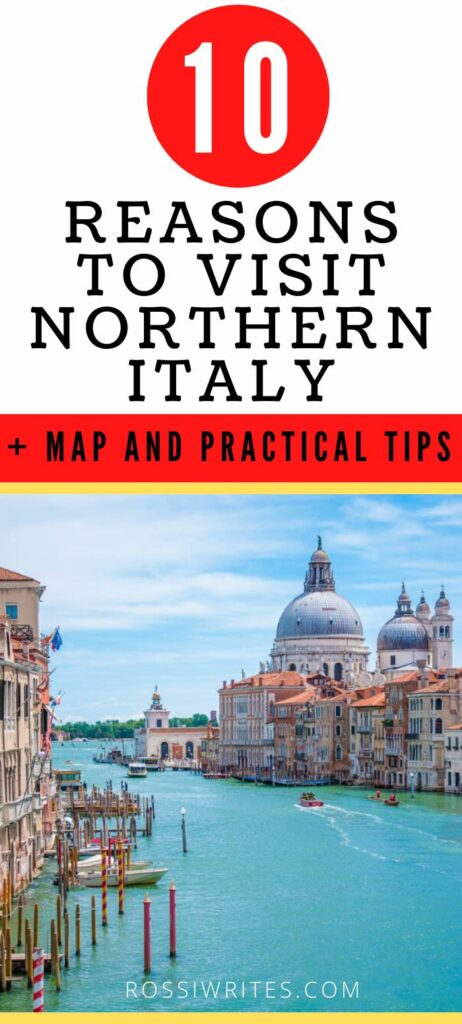
Sharing is Caring
Help spread the word. You're awesome for doing it!
Three Weeks in Northern Italy: a Travel Itinerary
Adventurous Kate contains affiliate links. If you make a purchase through these links, I will earn a commission at no extra cost to you. Thanks!
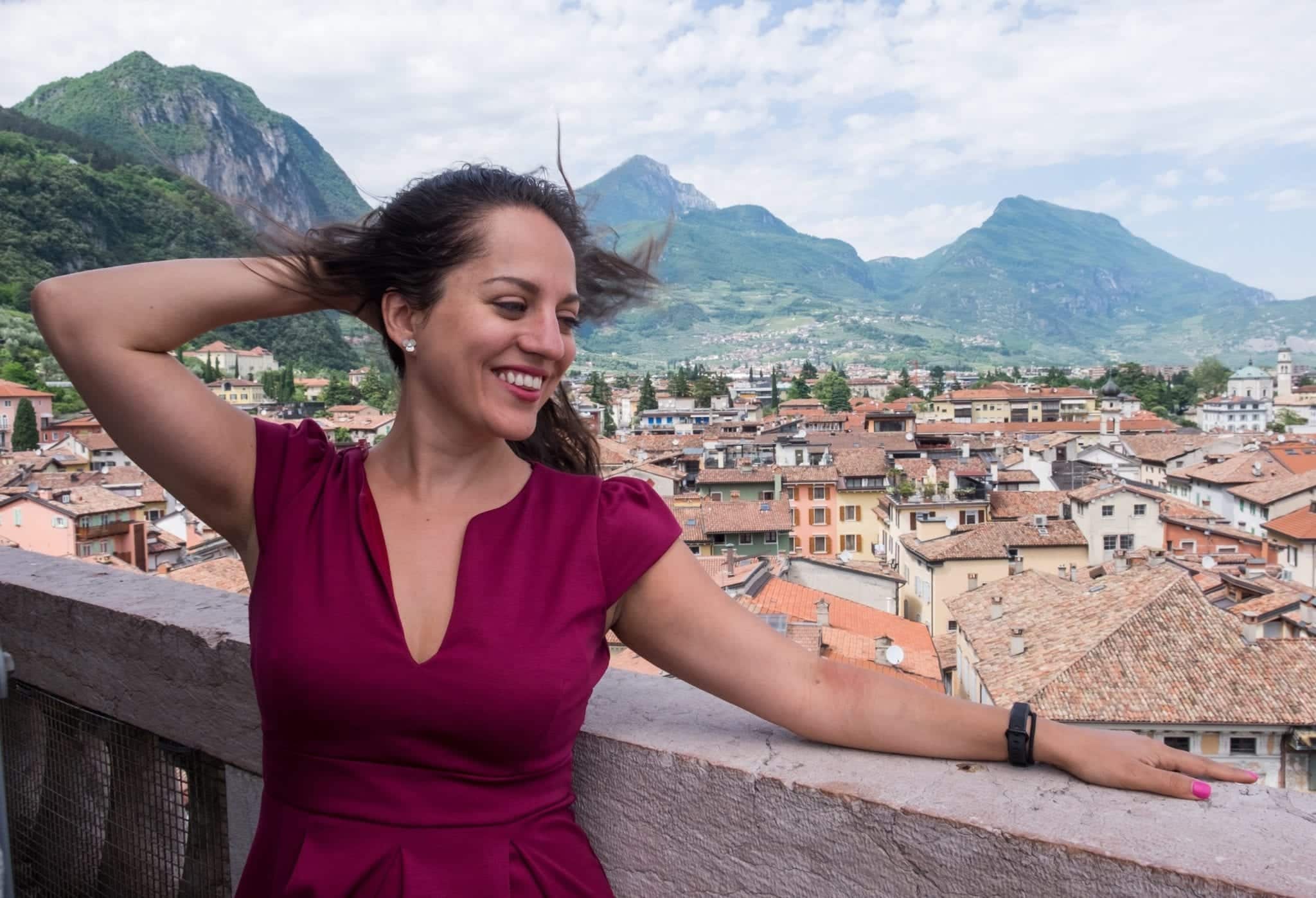
I recently took a three-week trip to northern Italy that blew my socks off. I had an opportunity to attend a conference in Trento in the Trentino region, and I used it as inspiration to plan a trip concentrating solely on the far north of Italy. Concentrating on this part of the country gave me the chance to go more off the beaten path, and I loved my itinerary so much I knew I had to come home and share it with all of you!
If you’re able to spend three weeks in Italy, you’re VERY lucky. As an American, I know how hard it is to get this much time off, but if you’re able to swing a longer trip, you’ll be able to explore Italy so deeply. And if you don’t have quite enough time, I have ways to modify the itinerary to fit your time frame.
I’ve been traveling extensively in Italy for 15 years. It’s one of the countries I know best. When I travel to Italy these days, I’m not looking to travel the well-worn itinerary — I’m looking to go deeper.
That’s what led me to plan this trip, and write this post for you. While some of the locations on this trip are well-touristed, the majority of them don’t get a lot of tourism. As a result, this is an offbeat Italy itinerary that will be full of surprises.
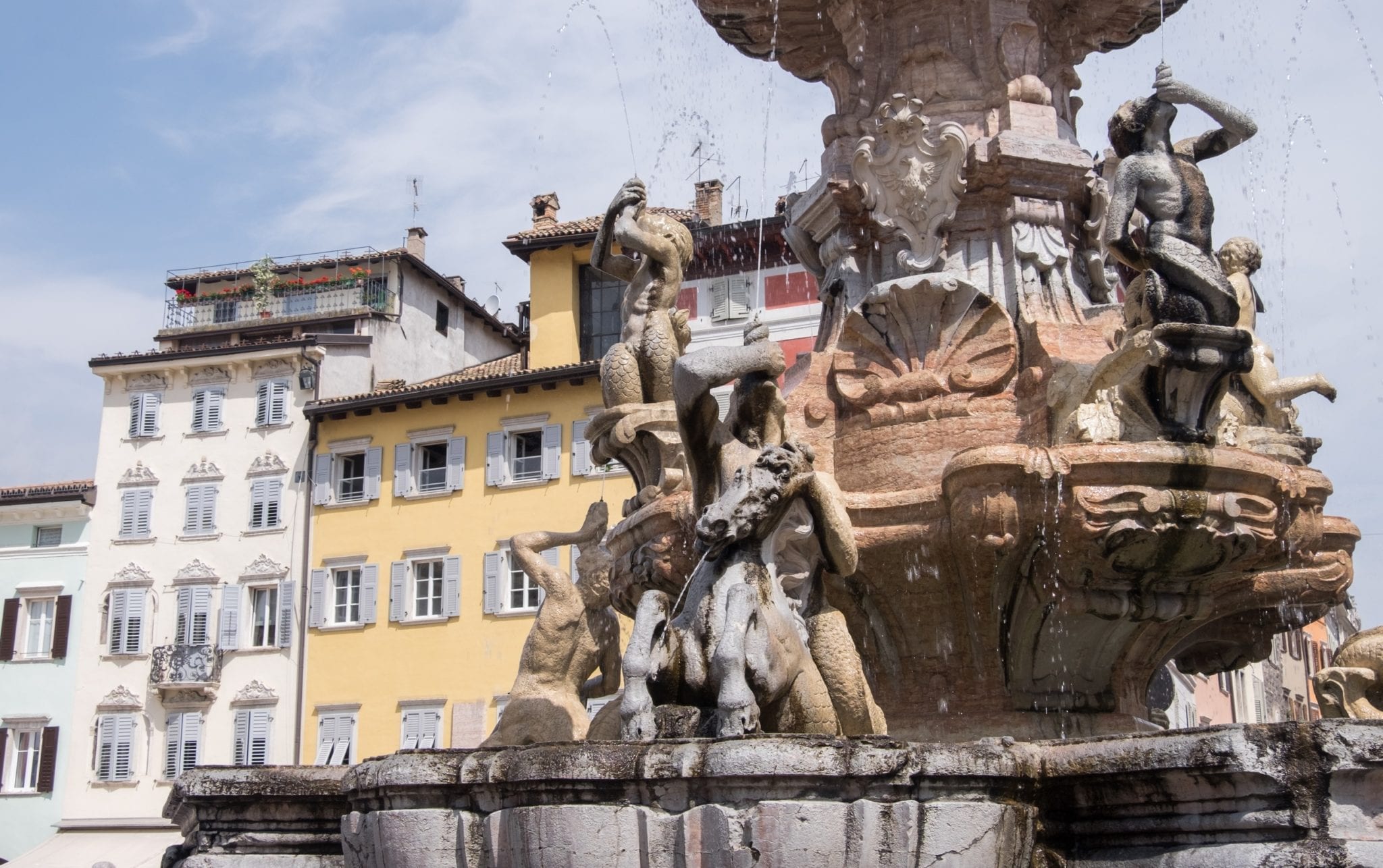
Who is this Italy travel itinerary for?
This itinerary is best for people who have traveled to Italy before and have already been to the major sites. This itinerary could potentially also work for first-time travelers to Italy who would rather get off the beaten path than visit the busiest spots.
This Italy travel itinerary includes in a lot of variety. You’ll visit two of Italy’s best culinary regions, Emilia-Romagna and Piemonte; you’ll marvel at Italy’s most picturesque mountains in Trentino and Alto Adige; and you’ll visit four lakes: Garda, Como, Orta, and Maggiore. You’ll spend time in the quiet but very pretty city of Trento, the busy and modern metropolis of Milan, the warm and fun city of Bologna, and visit two of the more touristy spots, Florence and Verona, on day trips only.
To me, this itinerary is true bliss: everything that I love about northern Italy with few of the drawbacks that plague more touristed areas like Venice, Cinque Terre, and Rome.
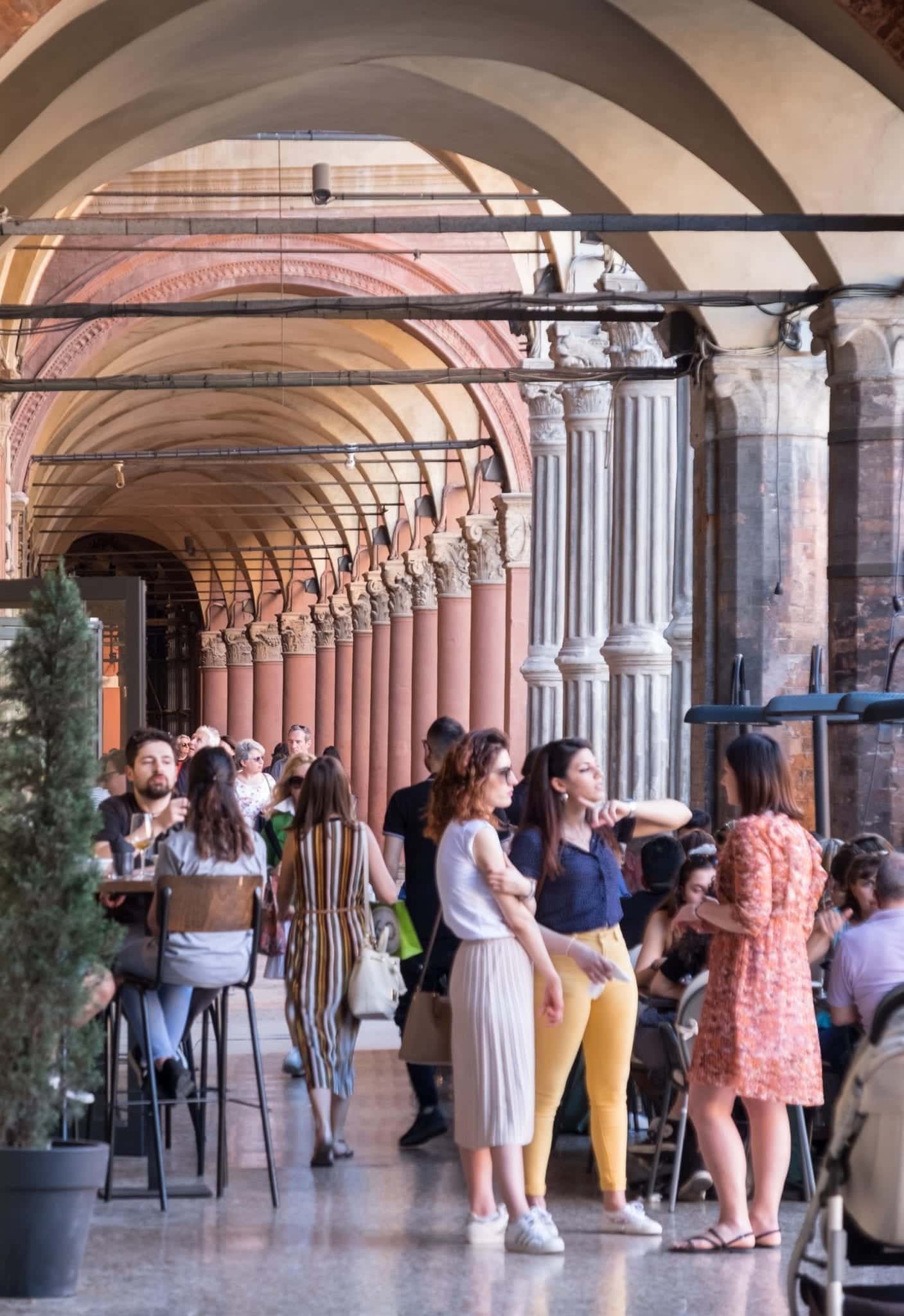
Day 1: Arrive in Milan, train to Bologna
If you’re flying overnight to get to Milan, chances are you’ll be a zombie. Don’t set super-high expectations for yourself for the first day. I spent my first day hanging out with my friends and taking it easy. You may want to take a nap; you may want to push through. Either way, I recommend taking melatonin at bedtime to help you get on the right time zone.
When you arrive in Milan, take a bus or train to Milano Centrale, the main train station. (If you’re arriving at Milan Malpensa, the bus and train take the same amount of time but the bus runs more often and is cheaper.) From there you can book and hop on a train to Bologna. The Frecciarossa train is an engineering marvel that only takes one hour.
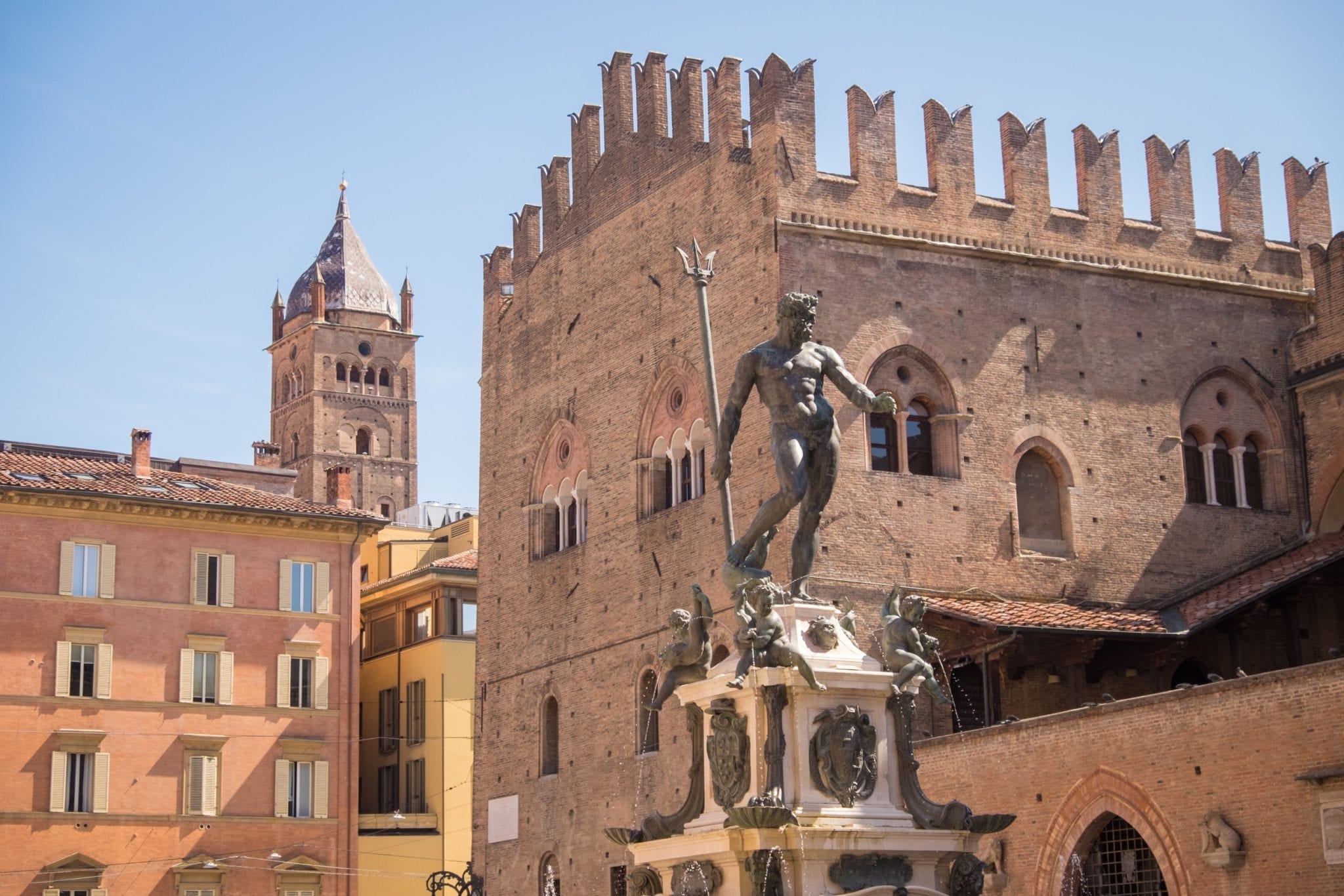
Days 2-5: Bologna
Bologna is a fantastic, underrated Italian city — and it happens to be my favorite city in Italy. Bologna is a city that comes with a lot of nicknames — la rossa , or the red, because of the red colors of the city (and its politically liberal history), la dotta , or the learned, because of its long history as a university city; and la grossa , or the fat, because it’s one of the best food cities in both Italy and the world.
Bologna is a beautiful, culture-filled city that doesn’t get nearly the number of tourists of Rome, Florence, or Venice. As a result, it feels like a lived-in city devoid of tourist traps. The cuisine is outstanding, so much that many Italians grudgingly admit that Bologna has the best food in the country. It also helps that Bologna is surrounded by lots of great cities for day trips.
My Favorite Thing to Do in Bologna: Eat, eat, eat. Check out my 25 Best Food Experiences in Emilia-Romagna, Italy for 25 ideas. At the very least, go to Osteria dell’Orsa for a cheap and delicious tagliatelle ragú and hit up the aperitivi near the city center.
Where to Stay in Bologna: Phi Hotel Bologna is an upscale and charming hotel just 2 minutes from the town square (rates from $136). Almarossa is a simpler, cheaper option in a great location near the university (rates from $76). Find deals on more Bologna hotels here.
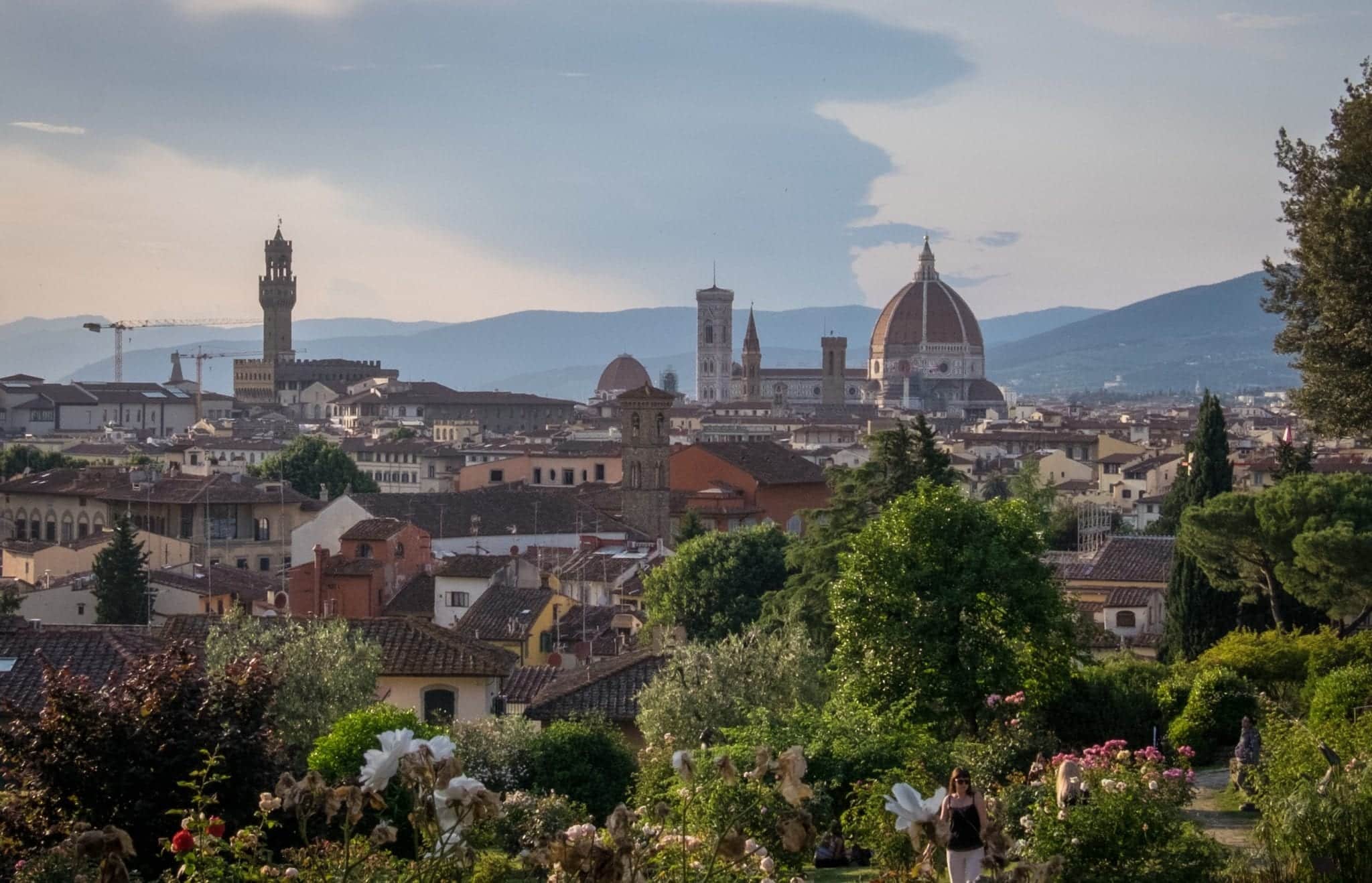
Day Trip from Bologna: Florence
Florence is one of the all-time great cities of Italy. It’s one of the most beautiful cities in the world; the art is unparalleled. Unfortunately, Florence is also one of the most touristed cities in Europe, and if you visit during high season, the crowds will be particularly intense.
My advice? Plan this day trip extremely carefully. If you want to visit the Uffizi or see David at the Accademia (I recommend one but not both in the same day unless you’re a hardcore art appreciator), BUY TICKETS IN ADVANCE. That is vital. If not, you’ll spend most of your day waiting in line. Beyond that, choose a few sites you want to see and roughly plan your route.
Choose your priorities in Florence without scheduling every moment of the day — you need to allow for a bit of serendipity, even if it’s just a gelato break (my favorite is Gelateria Dei Neri). But having a few sightseeing goals will help you navigate this city much more easily.
My Favorite Thing to Do in Florence: Enjoy the sunset from the Giardino Rosato, pictured above. This is very close to the much more popular Piazzale Michelangelo but with far fewer tourists, and the roses add to the ambiance.
Where to Stay in Florence: If you choose to stay overnight in Florence, Hotel Torre Guelfa Palazzo Acciaiuoli has colorful, central rooms and an unreal rooftop terrace. If you’re on a budget, Plus Florence has value-for-money rooms with amenities like a rooftop pool. Find deals on more Florence hotels here.
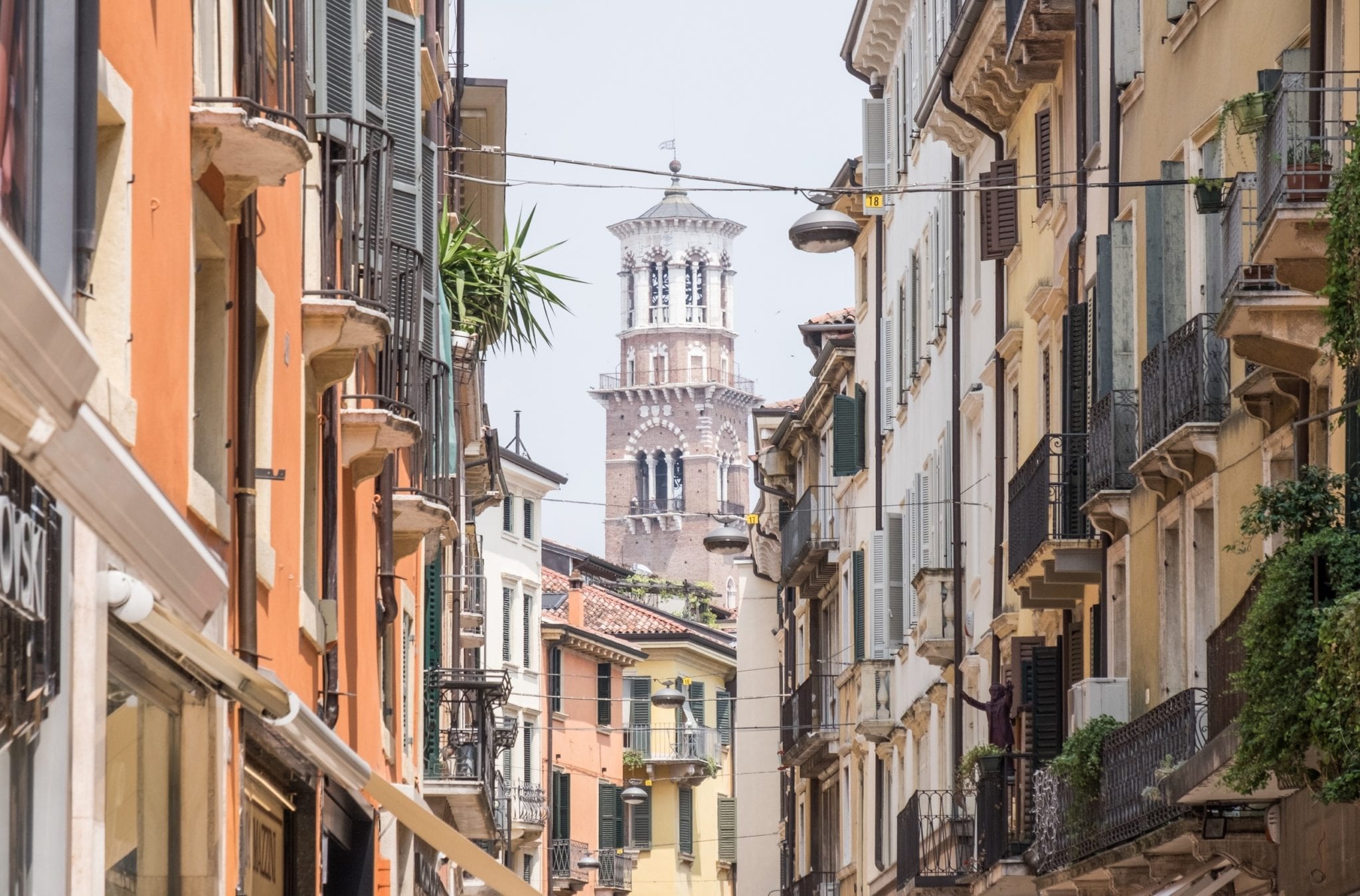
Day Trip from Bologna: Verona
Verona is most famous for being the setting of Romeo and Juliet — but today’s visitors admire the ancient amphitheater, the calm riverside setting, and the pristine city center, clad in the soft colors of the Veneto. Verona is a major transportation hub and a growing tourist attraction, but it’s much calmer and low-key than other Italian cities. The amphitheater, for one, only gets a fraction of the tourists Rome’s Colosseum gets.
Plenty of Romeo and Juliet tourists make their way here and set up shop at the Casa di Giulietta, where you can go out on Juliet’s balcony (built long after the play was written) or pose with the statue of Juliet. It’s a running gag for tourists to pose with a hand on Juliet’s breast. (Creepy. She’s barely pubescent in the play, you know.)
My Favorite Thing to Do in Verona: The one activity I didn’t do that I wish I did was to climb to the best view in town: Piazzale Castel San Pietro. Go up during sunset for especially good photos overlooking the city skyline.
Where to Stay in Verona: If you choose to stay overnight in Verona, Escalus Luxury Suites has gorgeous, modern suites in the heart of the city for surprisingly low rates starting from $101. Find deals on more hotels in Verona here.

Alternate Day Trips from Bologna: Parma, Modena, Ravenna, Ferrara, Rimini, San Marino
Bologna makes a great base for lots of reasons, including that there are several great cities in Emilia-Romagna. You can easily visit several on day trips. Parma and Modena are located close together on the same train line and you could visit Parma in the morning and Modena in the afternoon.
Ravenna and Ferrara are two other great cities easily day-trippable from Bologna. Ravenna has outstanding mosaics ; Ferrara is a gorgeous medieval town.
You could even visit a new country — San Marino ! Take the train to Rimini, then the bus to San Marino from there. Rimini is a terrific beach destination and it’s a nice city to explore, too.
San Marino: The Tiny Nation Surrounded by Italy
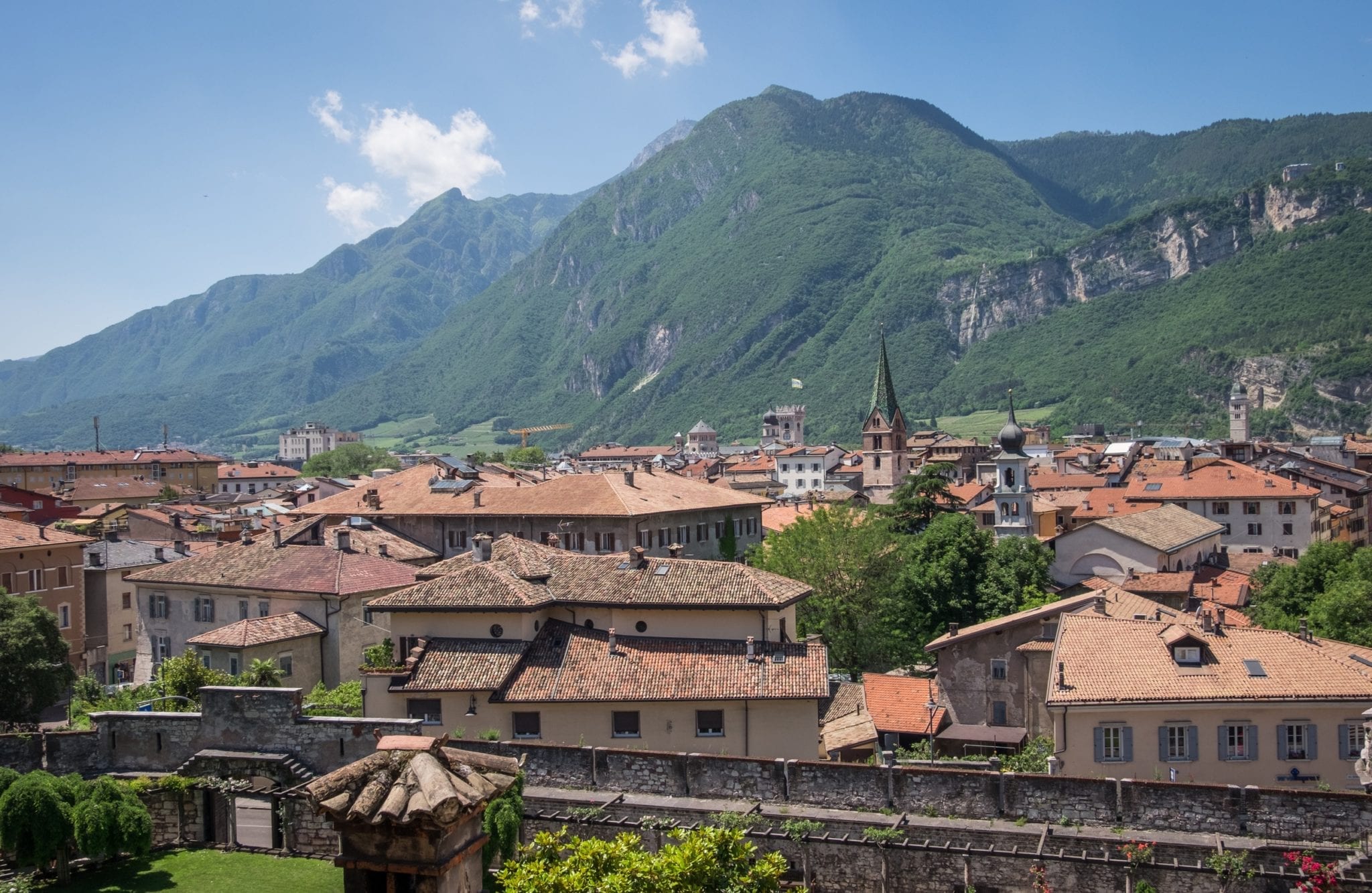
Days 6-9: Trento
Trento and the surrounding Trentino region aren’t often on travel itineraries — but it’s worth it. I visited Trento for a conference, which is why I spent a few days here in the first place, but I was surprised by how hard I fell for this little city. Trento is immaculate yet unpretentious, covered with frescoes and surrounded by mountains. Tourists here are very few, and many are cyclists and hikers exploring the mountains.
I encourage you to base in Trento and spend some time exploring this incredibly and underrated region, filled with spectacular mountains, beautiful towns, and sensational wine. Riva del Garda and Rovereto make great day trips, and there are tons of mountain hikes available too.
My Favorite Thing to Do in Trento: See the frescoes inside Buonconsiglio Palace. Far from your average frescoes, my favorites are in a tower where a portion of the wall represents each month of the year. Each panel is so detailed and full of interesting symbols.
Where to Stay in Trento: I highly recommend the Grand Hotel Trento . Beautiful rooms, nice bedding, super quiet, and in an ideal location just a four-minute walk from the train station and on the edge of the city center, with easy access to everywhere. Rates from $107. Find deals on more hotels in Trento here.
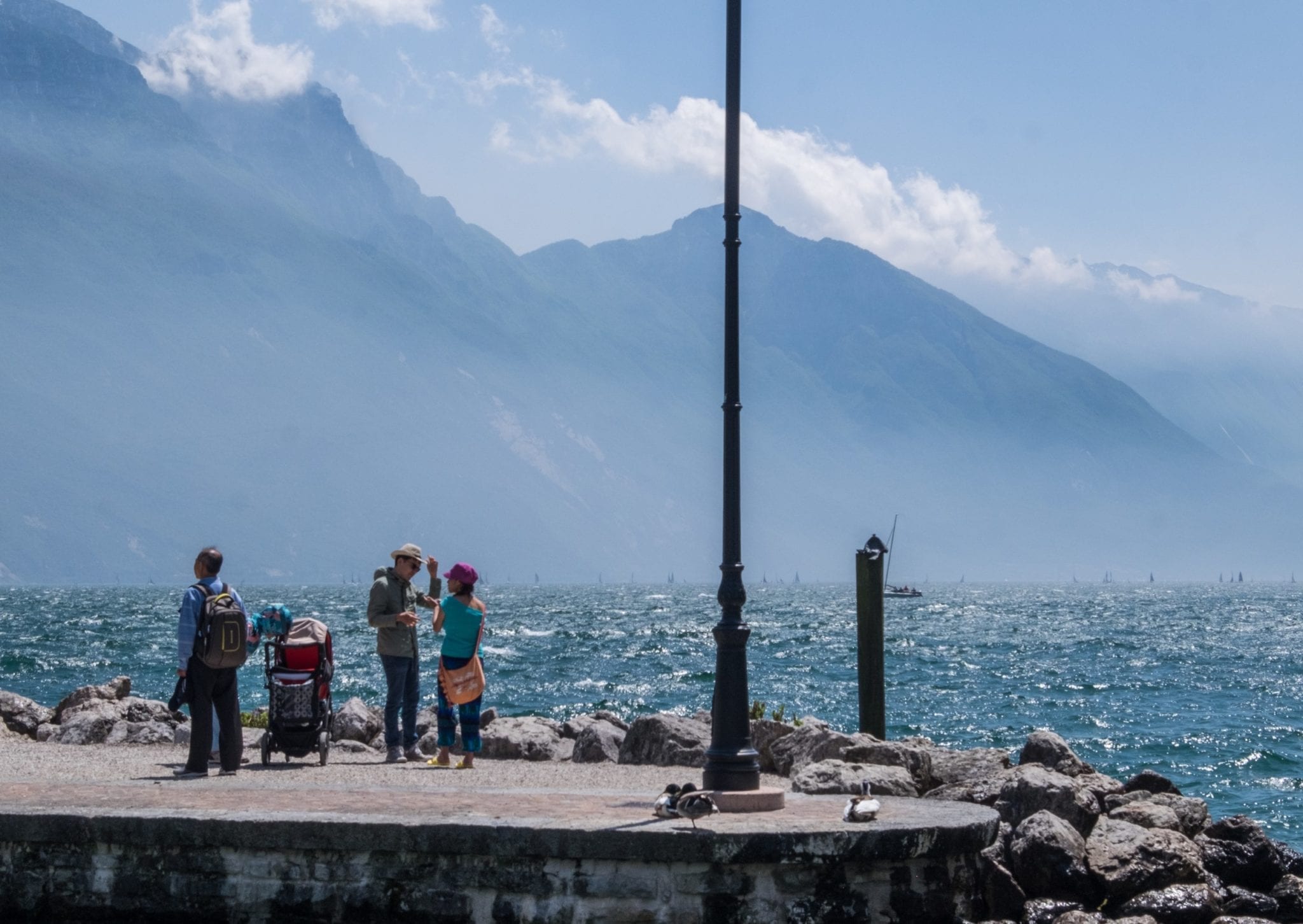
Day Trip from Trento: Riva del Garda
Lake Garda is the largest lake in Italy and is split between the regions of Trentino, Lombardia, and the Veneto. I visited the most popular destination on the Trentino portion: the town of Riva del Garda.
Other Italian lakes may be more about the beauty or luxury. Lake Garda made me feel humbled by its nature — the waves seemed more intense; the mountains seemed more foreboding. Even so, it felt so Italian and refined.
Riva del Garda is a pastel-colored little town that felt more like Liguria to me than Trentino. You could lounge in a cafe on the edge of the lake while sipping an aperol spritz, or you could waltz among the sherbet-colored buildings with a cup of artisanal gelato.
My Favorite Thing to Do in Riva del Garda: Climb the Torre Apponale, the tower that dominates the landscape. You’ll have amazing views of the lake, the town, and the mountains. The top photo in this post is from the tower!
Where to Stay in Riva del Garda: If you choose to stay overnight in Riva del Garda, I highly recommend the city center. The outskirts are home to campgrounds and cheap motels — probably not what you’re looking for on this particular Italy trip. Hotel Canarino is an option just off the city center with rates from $126. Find deals on more hotels in Riva del Garda here.
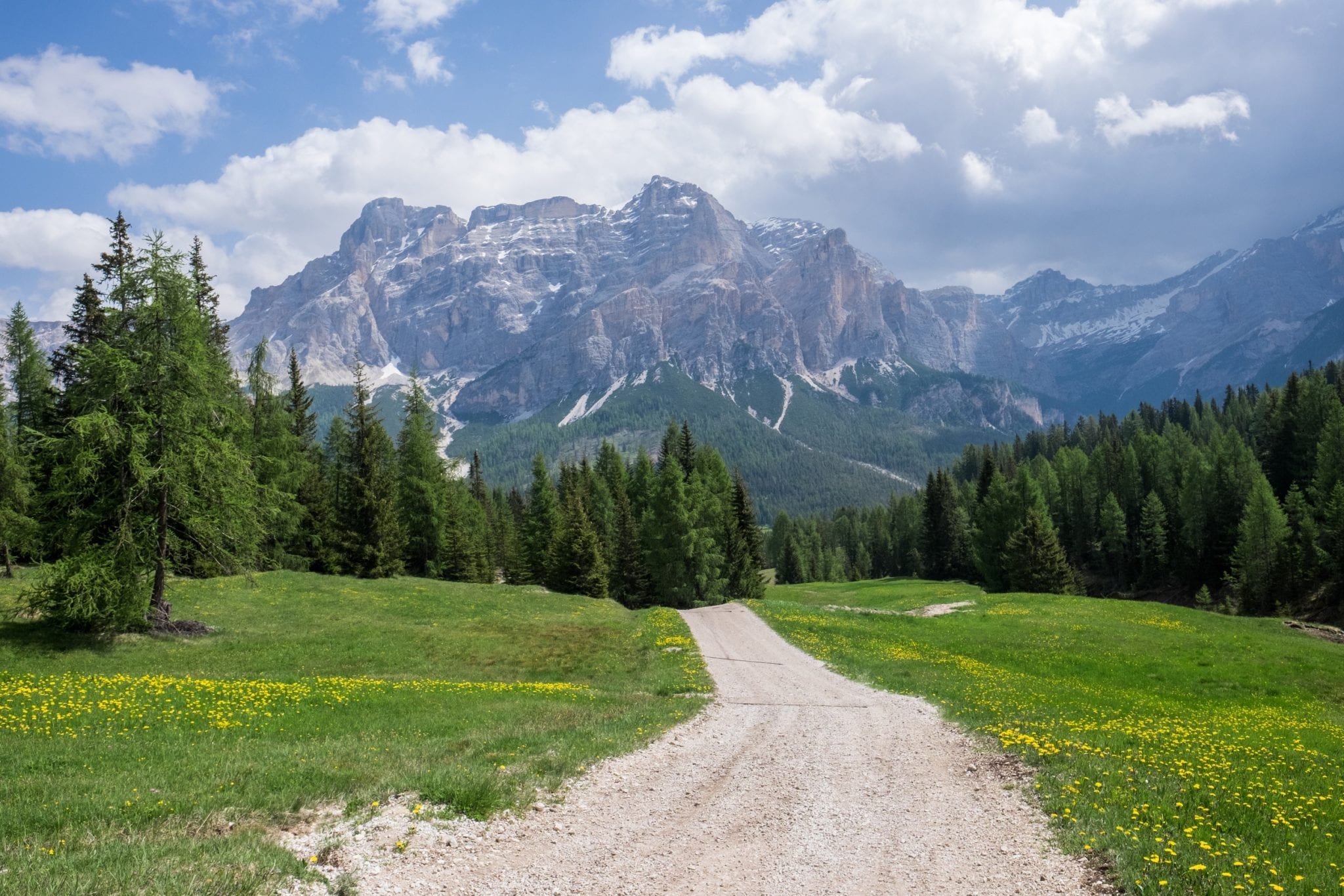
Days 10-13: Dolomites
The Dolomites, in the Alto Adige region of Italy (also known as South Tyrol), are home to some of the most dramatic landscapes in Italy. This is also the region least like the rest of Italy — it feels more like Austria or Switzerland!
Before you plan your trip, make sure you’re timing it correctly. Summer is hiking season and winter is ski season — but many resorts, Ciasa Salares included, are closed during the shoulder seasons. Keep this in mind before your trip. Also keep in mind that snow can last a long time here — 2019 was particularly intense and some of the last snow didn’t melt until June!
The summer is all about hiking, and the winter is all about skiing. Either way, the Dolomites are center stage — they’re jagged, pointy, and absolutely stunning.
My Favorite Thing to Do in the Dolomites: Hike, hike, hike! There are so many great hikes in the mountains, and there are hikes available for all levels of fitness. Talk to your local accommodation about a hike that is close to you. Oh, and eat plenty of soft, feathery speck.
Where to Stay in the Dolomites: Ciasa Salares is a fantastic high-end resort that I highly recommend. I loved this place and it’s a must if you want outstanding cuisine in addition to your mountain adventure. Find deals on more hotels in the Dolomites here.
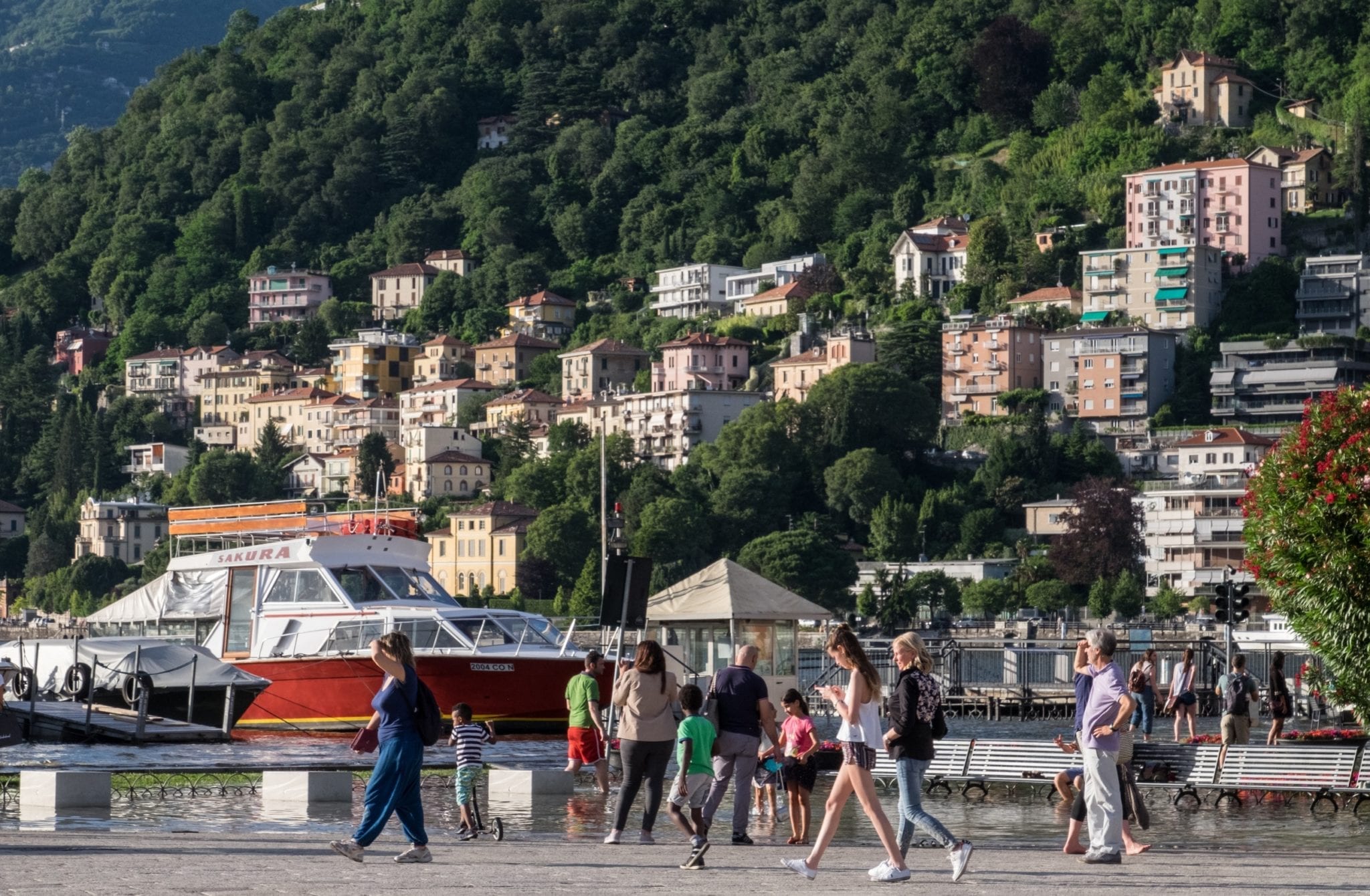
Day 14-15: Lake Como
Lake Como is famous for its beauty, its mountains, its palazzi, its Las Vegas namesakes. Oh, um, and George Clooney, easily the lake’s most famous resident. Here you’ll fine palatial residences, picture-perfect towns, flowering gardens and palm trees, and mountains leading straight down into the lake.
Lake Como is enormous and the biggest transit hub is the city of Como, home to an attractive city center. An hour away by bus are the cities of Bellagio, Varenna, and Menaggio, three of the prettiest cities in the area and easy to explore by ferry.
Do know that it took us so long to get to Lake Como on the first day that this was essentially a lost transit day — bus from La Vila to Brunico (Bruneck), train to Bressanone (Brixen), train to Verona, train to Milan, train to Como. Looking back, I think things would have been easier if we had rented a car from Trento or Verona and driven into the Dolomites and back.
My Favorite Thing to Do in Lake Como: While I didn’t get to explore much in Lake Como due to illness, I’ve been told that Bellagio is the prettiest city of all. There’s a reason why it inspired a Las Vegas casino!
Where to Stay in Como: I highly recommend two places: Ostello Bello is one of the nicest hostels I’ve stayed in lately with excellent amenities like laundry, breakfast, and free activities; and they have gorgeous private ensuite rooms (though the shower was so shockingly small that average-sized people will struggle to fit inside; there are shared showers that are a bit larger if you need them). Dorm rates from $28; private rates from $136. Alessia’s Place is a quiet, well-decorated B&B with perhaps the most comfortable bed and pillows I’ve ever enjoyed in Italy. Rates from $151. Both are centrally located near the old town of Como. Find deals on more hotels in Como here.
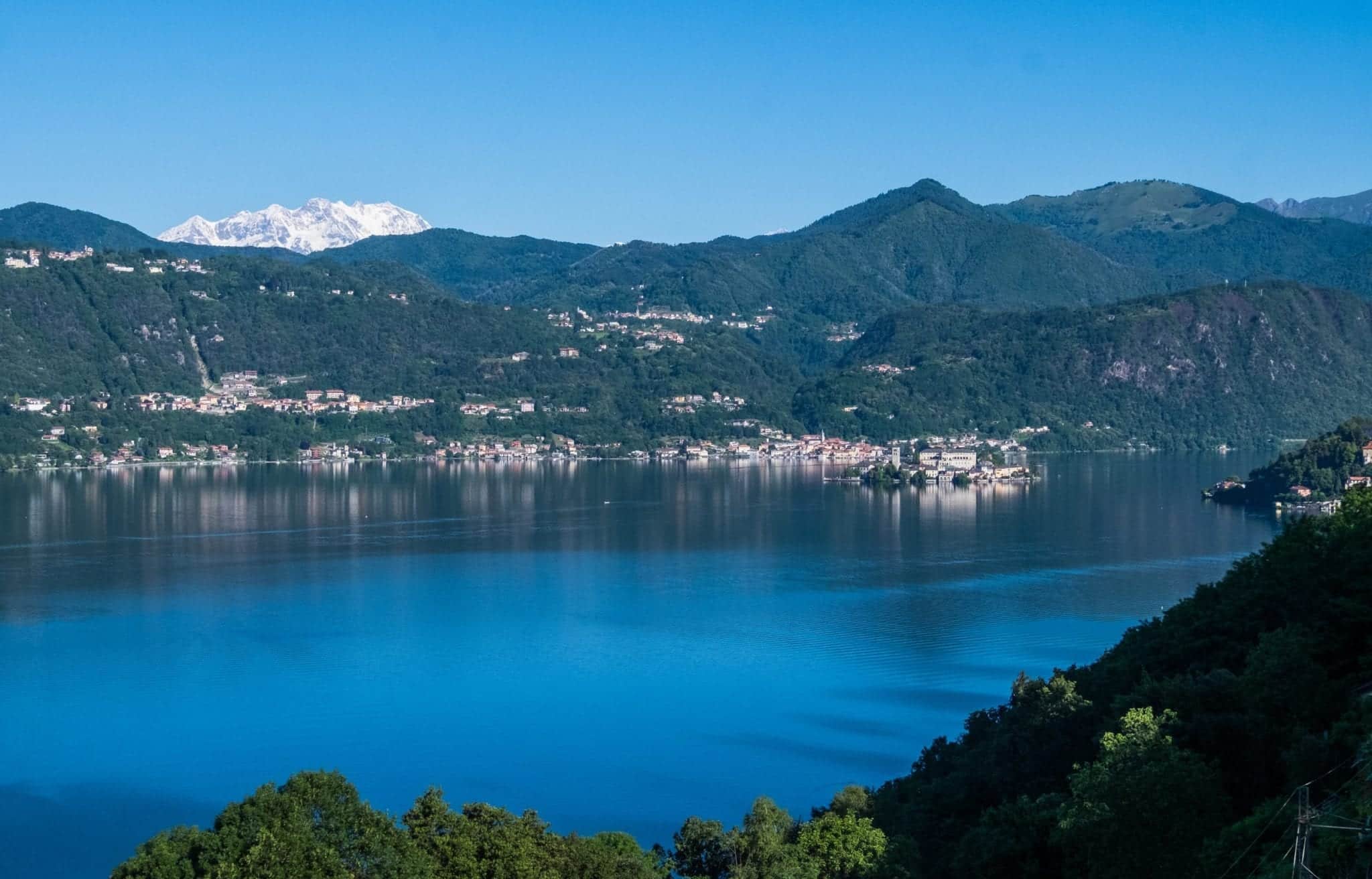
Day 16-17: Lake Orta
Lake Orta is one of the lesser-known lakes in northern Italy — and after visiting four of the lakes, Orta is my favorite. Lake Orta is much smaller than Como, Maggiore or Garda; it’s much less developed, and it has far fewer tourists. Most of Lake Orta’s visitors are Milanese looking for a nearby getaway, which gives it a much more local feel than the other lakes.
Orta San Giulio is the main hub of Lake Orta and home to a very pretty old town. You can take a boat to the island in the lake: Isola San Giulio, a spooky place filled with signs encouraging you to be silent. You can head up to Mottarone, a local mountain where on a clear day you can see 360-degree views of all the lakes in the region. But I think Lake Orta is best experienced by enjoying the peace and quiet.
My Favorite Thing to Do in Lake Orta: I had the best meal of my trip at Il Cucchiaio di Legno , an agriturismo in Orta San Giulio. 10 courses of astoundingly fresh, local, inventively prepared dishes. And I only paid 32 EUR ($36) for the food and 23 EUR ($26) for three glasses of wine, including a fine Barolo. One of the best value for money meals I have had anywhere in the world.
Where to Stay in Lake Orta: You can actually stay at Il Cucchiaio di Legno if you’d like, though it’s a bit of a ways out of town (rates from $94). While there are lots of towns around Lake Orta, I recommend basing in Orta San Giulio as it’s a beautiful, centrally located town with lots to do. Hotel la Bussola is a great option close to town (rates from $127). Find deals on more hotels in Lake Orta here.
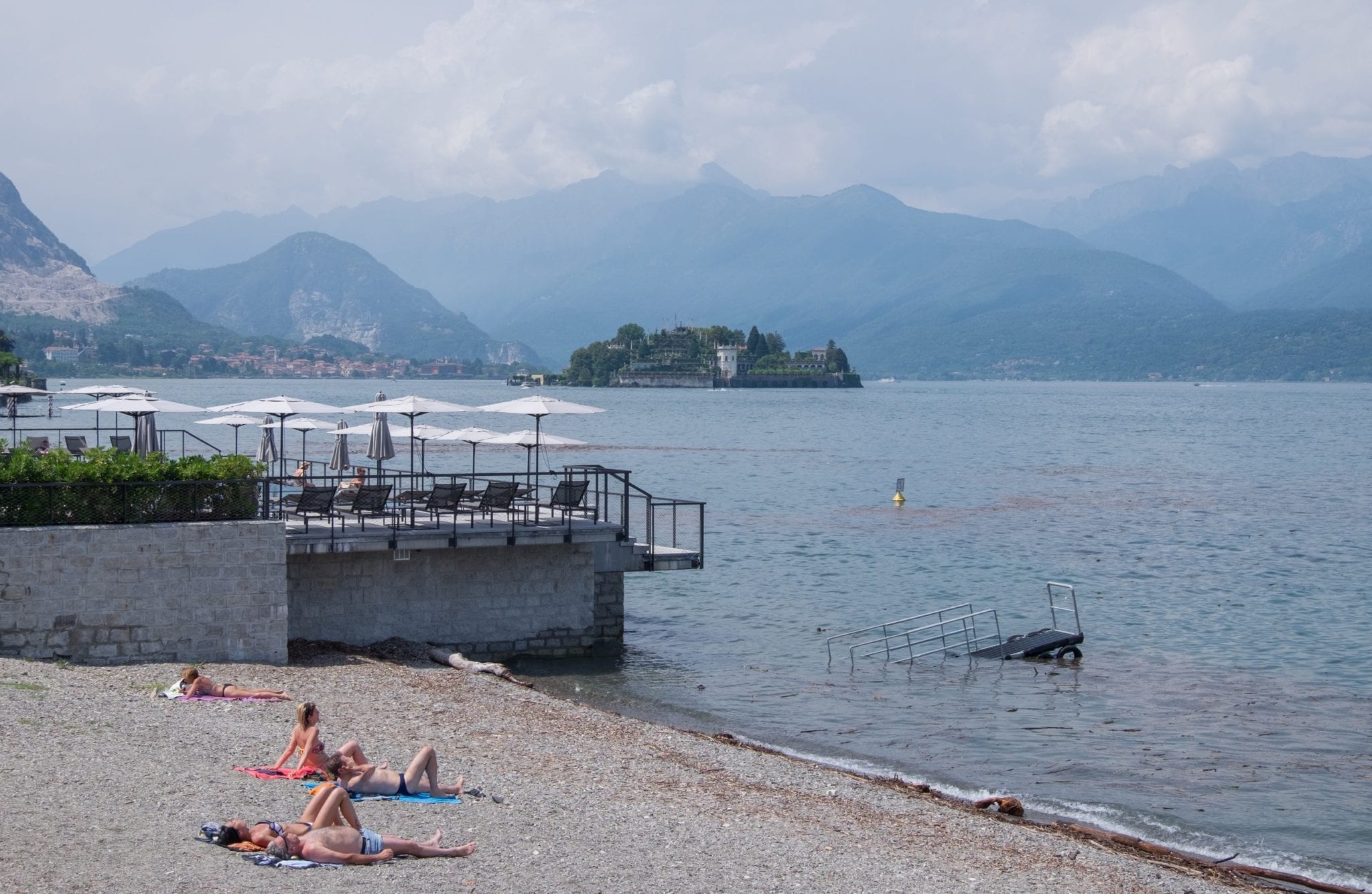
Day Trip from Lake Orta or Lake Como: Lake Maggiore
Lake Maggiore is very close to Lake Como, but a world away in lots of ways. It has a lot of elegance, but a vintage kind of elegance, the kind that you could see lighting up the lake in the 1950s but fading a bit into the present day. It doesn’t get a lot of the first-time-to-Italy travelers that dominate Lake Como; instead, people visiting here tend to be regular Italy visitors. And it doesn’t have quite the panache of Lake Como, but does it even need it?
Stresa is one of the transit hubs of Lake Maggiore and it’s a great base from which to explore the lake. It also gives you access to the pretty little islands in the lake: Isola Bella and Isola Superiore o delle Pescatori.
My Favorite Thing to Do in Lake Maggiore: Enjoy the architecture of Stresa and the surrounding towns while walking along the lake, pretending you’re in a Wes Anderson film.
Where to Stay in Lake Maggiore: If you choose to stay overnight in Lake Maggiore, Stresa is a good, well-connected base. Hotel Fiorentino is in the heart of town — highly rated with rates from $108 per night. Find deals on more hotels in Stresa here.
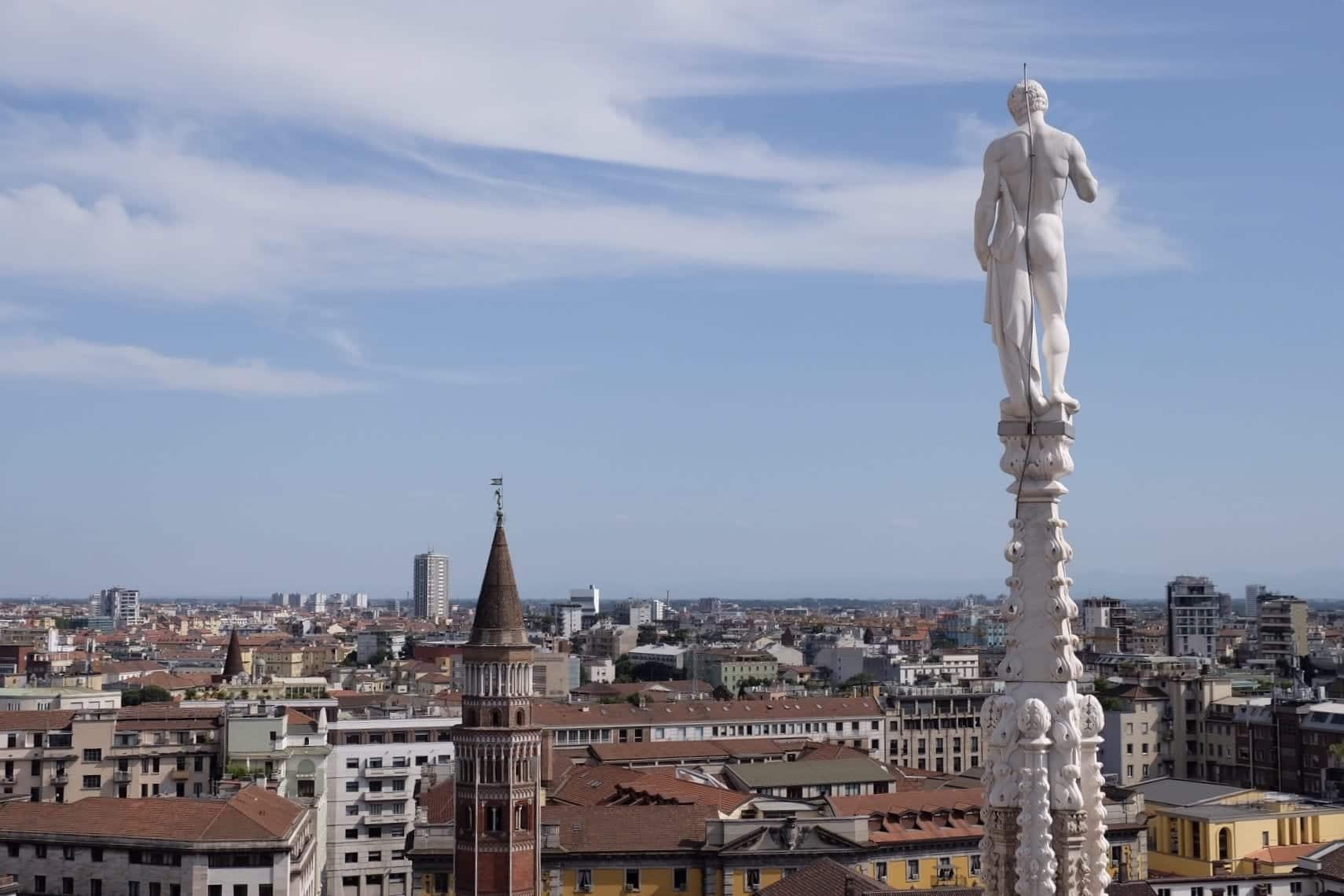
Day 18-21: Milan
By this point, you’ll probably be feeling tired from such a long trip, and it’s nice to have a place to crash for a few days near the end. Milan makes a great spot to base for the tail end of your trip to Italy, especially if you’re flying out of Milan.
Milan is arguably the most cosmopolitan city in Italy — only Rome comes close. You’ll be surrounded by incredibly well-dressed people sitting cocktails on piazzas, as well as some great attractions like the Duomo and The Last Supper . Take this time to soak up the best of Italy: the aperitivi, the gelato, the people-watching. Be sure to get some risotto with saffron, too.
My Favorite Thing to Do in Milan: Seeing Leonardo da Vinci’s The Last Supper . There are limited slots to see the painting and it books out months in advance, so I joined a tour with Walks of Italy, who comped my tickets. Seeing the painting was a moving experience and after I got to tour a bit of Milan and go up to the roof of the cathedral! Get your tickets here.
Where to Stay in Milan: Most recently, I loved staying in an apartment in the Zona Risorgimento — an up and coming place with great transportation access and tons of cool bars and restaurants. One great hotel in this neighborhood is Bianca Maria Palace Hotel , with huge rooms and bathrooms, a great gym, and rates from $124. Find deals on more hotels in Milan here.
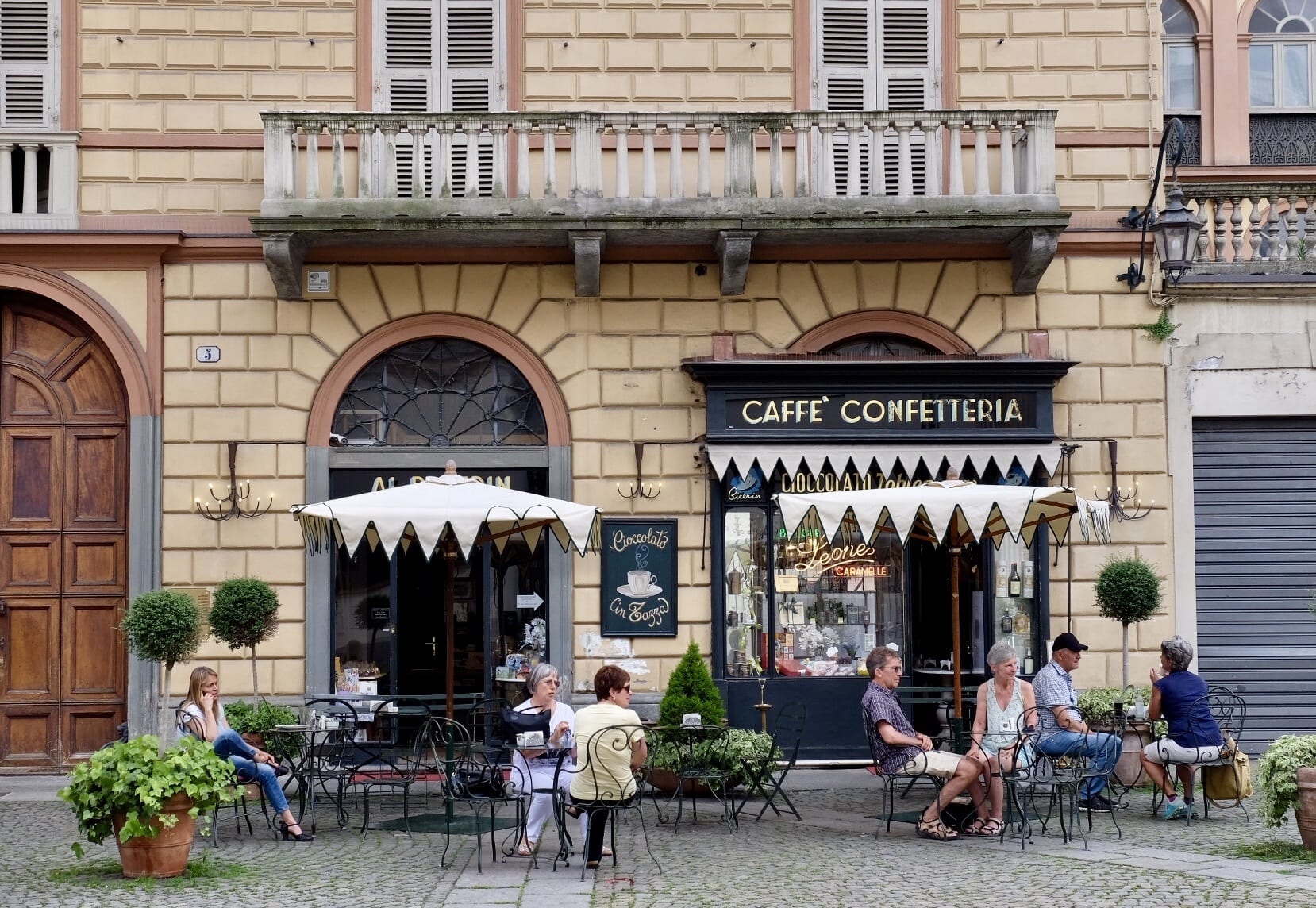
Day Trip from Milan: Torino
The Italian city of Torino, also known as Turin, is perhaps best known for hosting the Winter Olympics in 2006. But there is plenty more to explore in this city: the Egypt Museum, the endless elegant squares. THE BICERIN, a hot beverage made from chocolate and coffee. And all the wonderful food and wine from the surrounding Piemonte region.
Torino feels much more international than other cities in Italy — at times I felt like I was in Switzerland, or maybe France. It felt more quiet, more refined, more cultured. And absolutely beautiful.
My Favorite Thing to Do in Torino: Head to Cafe Al Bicerin to try the bicerin, either outside at one of the tables or inside in the cafe that has been open since 1763. Afterward, walk across the street to Santuario al Consolata and marvel at the collection of paintings depicting the church’s parishioners at the moments they narrowly escaped death. The paintings were commissioned to say thanks to God.
Where to Stay in Torino: If you choose to stay overnight in Torino, stay in the city center for the maximum convenience. Turin Palace Hotel is one of the highest-ratest hotels and a stone’s throw from most of the city’s attractions. Find deals on more hotels in Torino here.
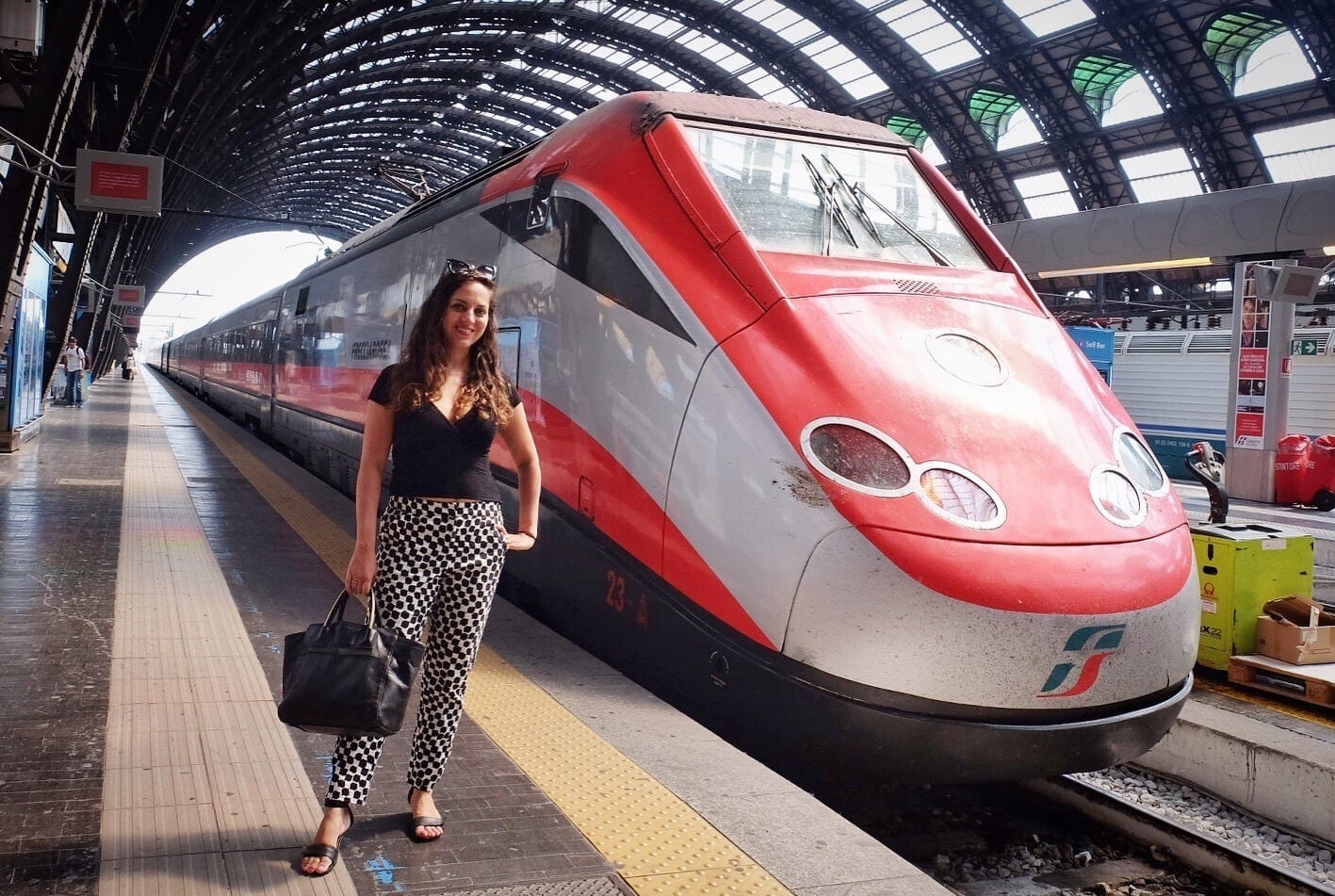
How to Get Around Italy: by Train with an Italia Rail Pass
On this trip, I traveled Italy by train with an eight-day pass from Italia Rail Pass . I love traveling in Italy by train and having this pass saved me a lot of money, especially because I did a lot of day trips by train.
There are two kinds of trains in Italy: local and express. If it’s a local train, you can hop on any train, show your pass, and be covered. But if it’s an express train, like one of the high-speed Freccia trains, you need to make a reservation in advance or you’ll be charged extra on board. You do this at any train station that has a station employee.
It costs 10 EUR ($11) for each Freccia reservation, no matter how far it goes (even on the 11-hour train across the country from Torino to Lecce !). And while it may seem annoying to pay for trains, they save you a ton of time. Milan to Bologna is just one hour, and it often travels at 300 kilometers per hour (186 miles per hour)!
On several of my day trips, including Florence, Verona, and Torino, I paid the 10 EUR for the fast train in one direction and took a “free” local train on the way back. Sometimes there isn’t even that much of a difference; at other times, I didn’t mind taking a two-hour local train instead of a one-hour fast train.
To get the most out of your pass, I highly recommend doing day trips by train. Because the pass charges you by the day, using a day of rail pass will cover you for unlimited rail journeys on that day. It’s even more worth it if you do a few trips in one day — say, if you’re staying in Bologna and take the train first to Parma in the morning, then to Modena in the afternoon, then back to Bologna.
There is only one place where taking the train was a bit of a pain: the Dolomites. We made it work, but it was complicated taking several trains and a bus, including trains that didn’t run often and had to be timed precisely. It would have made more sense to rent a car in Trento or Verona to get to the Dolomites and back, then resume our train travels from there.
But overall, I loved having a pass from Italia Rail Pass and I would absolutely get another on my next trip. I adore traveling Italy by train and I see more rail passes in my future.
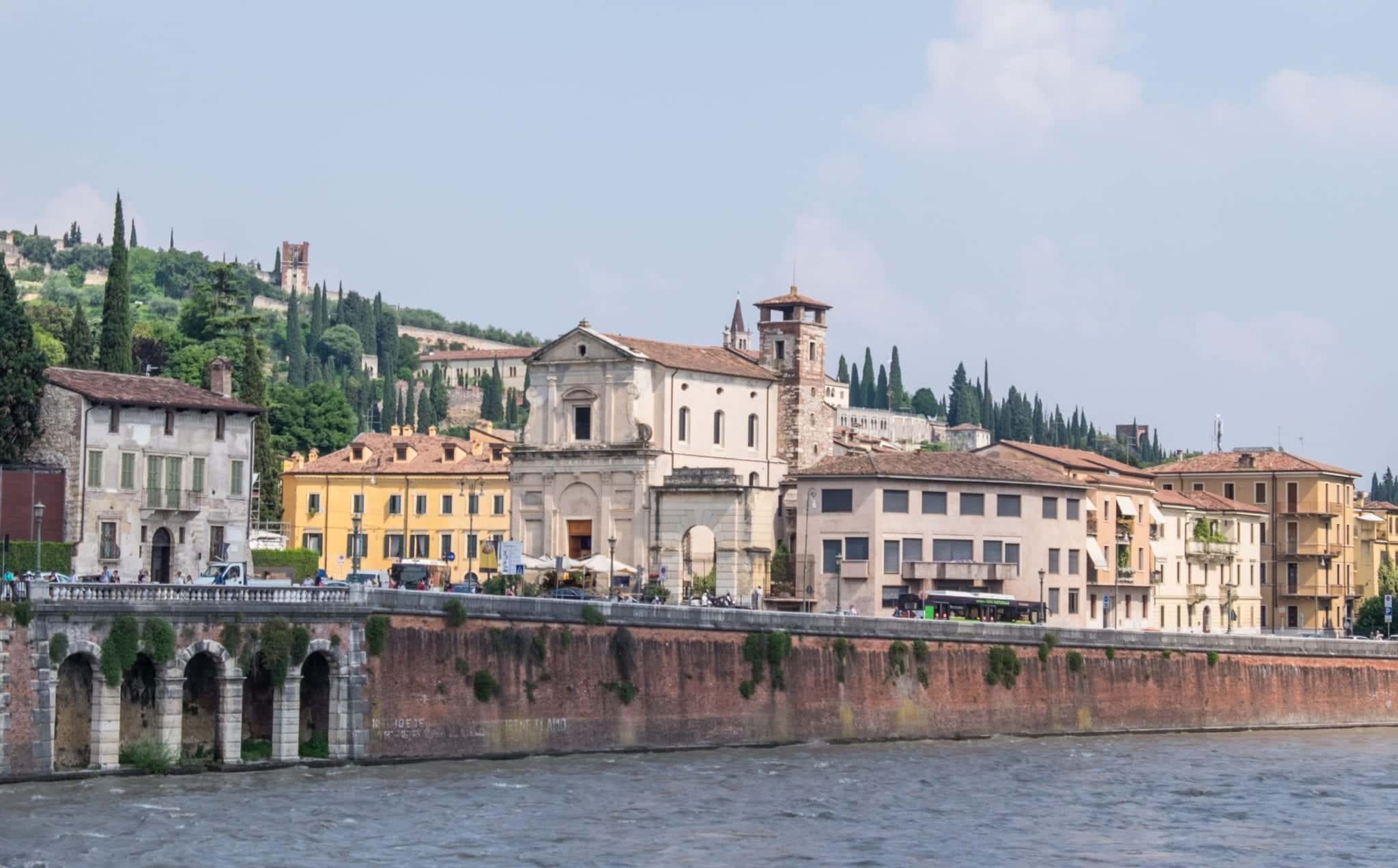
Three weeks is too long! What about a two-week northern Italy itinerary?
You can absolutely shave this itinerary down to two weeks if you’d like. Believe me, a two-week trip to northern Italy is absolutely wonderful. Just go through the itinerary and take off a day here and there, or axe a few destinations altogether.
If you’re not visiting during the summer, you may want to omit the Dolomites, as much as I loved them, as the winter is all about skiing and many places are closed during the spring and fall.
What are other destinations you can easily axe? Milan was lovely but I don’t consider it as essential as the other cities. Cut down on the day trips and definitely skip Florence or Verona if you’ve been before. Choose between Lake Como and Lake Orta.
If you only have 7-10 days to travel northern Italy, I recommend you base in two cities, three at the absolute max. Choose your favorites.
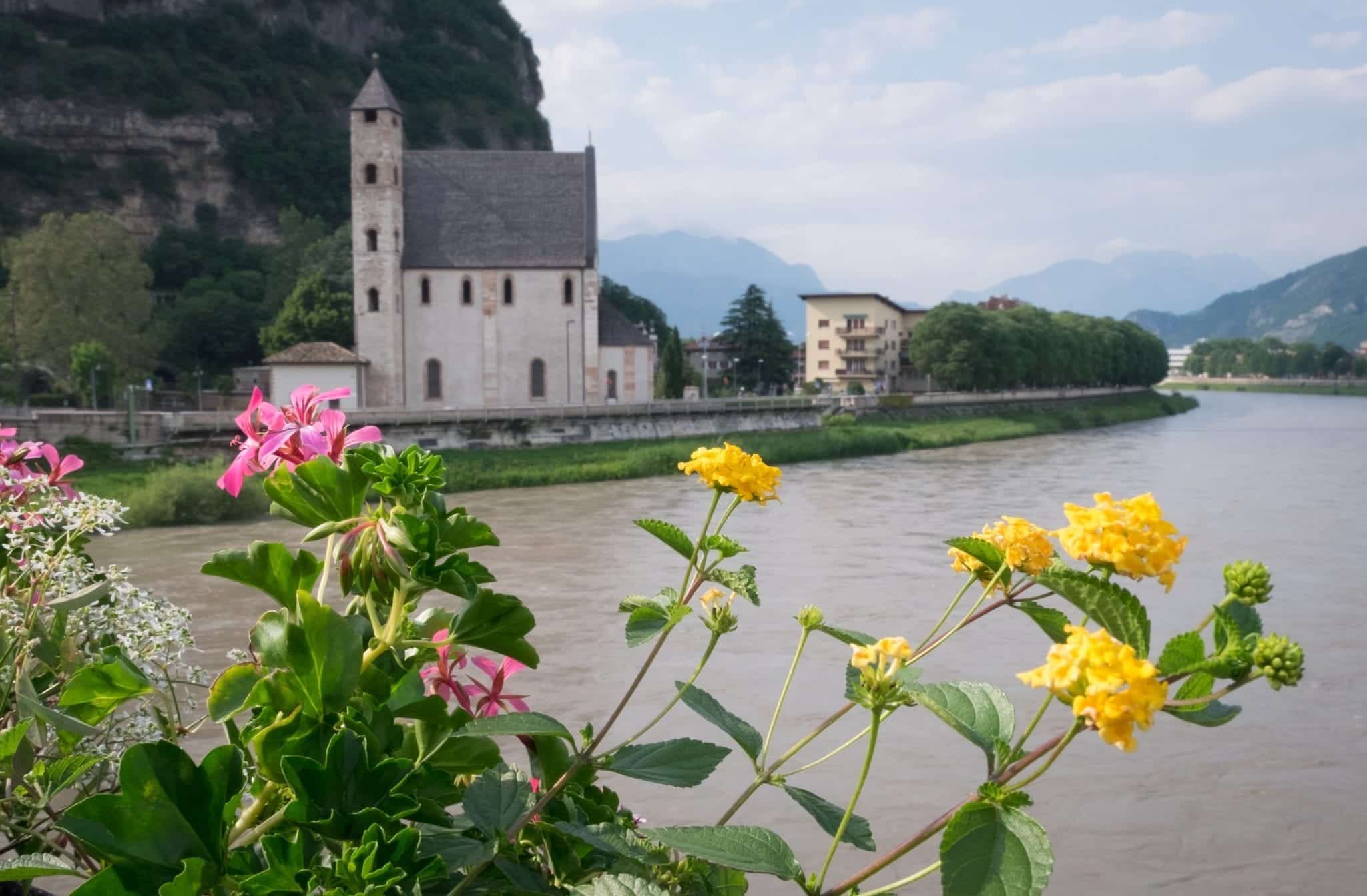
Italy Travel Tips
Italy is a very popular country to travel, and northern Italy in particular has excellent tourism infrastructure. It’s a relatively easy place to travel, but there there are lots of ways you can make your Italy trip even better.
Never eat right in front of a monument. Walk a few blocks away and take a few turns and you’ll find restaurants that don’t pander to tourists.
Remember to validate your ticket on the train. If you don’t have a rail pass or are not using it for a particular journey, you must validate your train ticket by putting it into the machine and stamping it.
It helps to dress to blend in with Italian women. Italians tend to be well dressed and groomed, especially in the cities; dressing this way will help you keep a low profile. Don’t wear athletic wear, shorts, baseball caps, or torn jeans unless they’re fashion items. Don’t wear sneakers or flip-flops; instead, bring nice flats, boots, or sandals. The Walking Company is my go-to for comfortable shoes that are cute; I strongly recommend black ABEO flats , which have fantastic arch support.
Italians tend to wear a lot of black, but you don’t have to restrict yourself to dark colors. In summer, I wear tailored dresses; in other seasons, I wear tall boots, nice jeans or pants, and a leather jacket. Italians tend to wear designer sunglasses; some solid black frames at any price range should do you well.
Consider bringing a Speakeasy Travel Supply scarf . These beautiful scarves are designed and sewed by my friend have a hidden passport pocket in them. I love these scarves ( I even designed my own! ) and they are so good at keeping your valuables hidden. They’re also extremely chic, enough to work in a fashion-conscious country like Italy.
Men can be aggressive with street harassment; the best thing that you can do is ignore it. Don’t react to the “Ciao Bellas”; if he grabs your arm, shake it off and keep walking. Italian men are used to local women ignoring them. 95% of the time, their behavior does not escalate if you do not give them a reaction.
In the event that the behavior continues without abatement or escalates, go into a shop or restaurant. Ask for help. Locals are familiar with this behavior and know how to defuse it.
Get travel insurance for your Italy trip. This is nothing to mess around with. I’ve been sick and injured in the EU before, and an emergency room visit cost me 300 euros — which was refunded by my travel insurance company. I use and recommend World Nomads for trips to Italy.
Planning a Trip to Italy:
- What NOT to Do in Italy
- Solo Female Travel in Italy: Is it Safe?
- Ultimate Guide to Driving in Italy
- How to Stay at an Agriturismo in Italy
- 40 Italy Landmarks to Experience Once In Your Lifetime
- 30 Stunning Mediterranean Islands To Visit In Your Lifetime
- 30 Italian Cities To Visit Once In Your Lifetime
Cool Places in Southern Italy:
- Tropea, Italy: A Spectacularly Situated Beach Town
- The Stunning Trulli of Alberobello, Italy
- 16 Fun Things To Do In Sorrento
- 17 Fun Things to do in Bari, Italy
- 16 Fab Things to do in Lecce, Italy
- 15 Best Things to do in Monopoli, Italy
- 17 Fun Things to do in Matera, Italy
Cool Places in Sicily:
- 22 Best Places to Visit in Sicily
- The Joys and Challenges of Traveling in Sicily
- Where to Go in Eastern Sicily
- 23 Fun Things to Do in Palermo, Sicily
- Complete Guide to the Aeolian Islands, Sicily
- Aci Trezza: A Laid-Back Coastal Town in Sicily
- Visiting Sicily in the Winter: Worth it or not?
- 30 Iconic Dishes To Try In Sicily
Cool Places in Northern Italy:
- Parma, Italy: A Colorful, Artsy, Delicious Town
- Where to Stay in Rome: Best Neighborhoods and Accommodation
- Three Days in the Dolomites: A South Tyrol Getaway
- Best Day Trips from Florence, Italy
- The Immaculate, Bursting Mosaics of Ravenna, Italy
- 25 Best Food Experiences in Emilia-Romagna, Italy
Most of this trip was paid for out of pocket for me, but there were a few exceptions: I received two eight-day rail passes from ItaliaRail ; I had a comped four-night stay at the Grand Hotel Trento , as well as several meals and activities in Trento, and my flights to and from Italy as part of my speaking engagement at Traverse; I had a comped three-night stay at Ciasa Salares in the Dolomites; I got two comped tickets on Walks of Italy Best of Milan and Last Supper tour. The rest of this three-week trip was at my own expense. Many thanks also to my friends in Italy who welcomed me into their homes, neighborhoods, and cities!
Have you traveled in northern Italy? Have any tips? Share away!
Northern Italy Roadtrip Itinerary | 5, 10 and 14 days
Planning your trip to the Northern part of Italy is exciting but can be overwhelming as well. There’s so much to visit in the whole country, and the northern part is no exception to that. We’re here to help you plan the best road trip in Northern Italy. This article contains several road trip itineraries in length and activities.
With the Northern Italy Highlights – 10 days itinerary you’ll cross the most important highlights, cities and landmarks in the northern part of Italy. In the next part, you’ll find step by step itineraries where we explain the best stops, famous landmarks, and best places to stay. Also, we cover several itineraries for 5 and 14 days. Let’s start with the 10-day highlights!
10-day Itinerary – Northern Italy
For this Itinerary we recommend you to start in Milan. We chose for Milan as a starting point because it is easy to reach, either flying or overland.
When you feel it is more convenient, you can also choose to start your road trip at Venice. The route will be slightly different.
We feel it is essential that you plan your trip with the best booking recourses. That’s why we selected the recourses we use all the time while booking our trips. You can find them on our recommendations page, or scroll down and read the ‘plan your trip’ part in this article. Also, we will recommend places to stay in each recommended city where you will stay overnight during this road trip.
Day 1 – 2 Milan – Lake Como
Our first recommendation is that you start in Milan. After you arrive in Milan, you probably want to relax a bit first. So the first day we don’t plan that much. But if you like, you can explore the city. On the second day you drive to Lake Como, but that’s only around 2 hours drive. So we recommend to stay in Milan until lunch, and after lunch drive to Lake Como. This way, you have enough time to explore the highlights in Milan.
Milan Highlights
The highlights in Milan are:
- Milan Cathedral (Duomo)
- Church of Sante Maria delle Grazia
- Sforzesco Castle
- Galleria Vitoria Emmanuelle II
- Teatro alla Scala
- Brera Pinacoteca
It is easy to walk around the city center of Milan. The city itself is not that big. We recommend that you pick up your rental car right before you leave the city and travel to lake Como. It saves you a day in rental- and parking costs. And you don’t need your rental car while staying in Milan.
We wrote this article you might like, with in-depth information about the city of Milan.
Recommended places to stay in Milan
Milan has many accommodations where you can stay. Most of the time, we use Booking.com to book our accommodations. We selected two options, both with excellent customer reviews, which we think are great to spend one night.
- Hotel Napoleon – is in the middle of the center, so easy to reach all the highlights in Milan. They get a review score of 8.5 on average
- Room Inn B&B – Also find in the center, offer rooms with breakfast. They get a review score of 9.3 on average.
When you would rather looking for other accommodation, make sure to use this link , which will direct you to the best deals in Milan on Booking.com
Day 2 Milan – Lake Como
On the second day, we recommend you to travel to Lake Como, somewhere after lunch. It will take around 2 hours to reach the lake. You’ll need to follow the A9 north from Milan. We recommend staying in the town of Varenna, which is the easiest to reach, and on the road, you’ll need to follow the next day. From Varenna, it is easy to explore the lake.
Lake Como Highlights
The villages around the lake are great to explore, but Lake Como is renowned for its beautiful nature. The highlights you don’t want to miss are;
- Cathedral of Como
- Visit a lakeside villa; Villa del Balbianello A 16th-century building with a beautiful garden on the side of the lake
- Take a boat trip to Varenna This trip will stop at several villages, and you’ll get a great impression of the lake and its surroundings
- Go hiking along the lake There are many different hiking trails at Lake Como. It is fantastic to spend a few hours in this beautiful nature.
Recommended places to stay Lake Como – Varenna
Varenna is the best place to stay at Lake Como for this road trip. It is on the road you’ll take the next day, and also it is easy to explore the best highlights of the lake with the taxi boat that leaves from this village.
There are many accommodations to find in Varenna, but the two that stand out the most, regarding customer reviews are:
- Hotel Beretta – in the town center
- Hotel Olivedo – with splendid views over the lake
You can also look for other villages to stay if you wish, but we recommend staying at the eastern side of the lake, on the road SS36. This is the road you’ll need to take the next day.
Day 3 Dolomites
The next day you follow road SS36, 38, 39, 42 and 239 to the national park Adamello Brenta . This park in the heart of the Dolomites is probably the best stop for a day visit. The entrance of the park is around 3,5 hours drive from Varenna. We recommend leaving early in the morning, so you have enough time to reach the park. The road will take you through the dolomites, which is lovely. You’ll probably stop a few times just to enjoy the views.
The dolomites are great for exploring nature and hiking. However, during this trip, you don’t have that much time to explore the most significant hiking trails. We recommend staying close by the park entrance
Hotel Garnì La Soldanella and Hotel Villa Fosine are both located around 5 kilometers from the park’s entrance.
Depending on your interests and fitness level, you can choose different activities. We recommend using the park’s website to find out the best hiking trails. It is also convenient to book a guided tour in the park and its surroundings, that way you make sure you’ll get the best things to see in the short amount of time.
Day 4 Lake Garda
After you woke up and enjoyed the beautiful mountain views, it is time to hit the road again. Today you’ll travel to Lake Garda. The biggest lake in Italy and Europe. Many people say the lake is less spectacular then Lake Como, but we think it is a must-visit while traveling through this area.
Lake Garda is known for its beautiful historic villages and also beautiful landscapes. Two villages you don’t want to miss are Garda and Sirmione . Sirmione is a historic town on a peninsula at the lake. Marvelous to visit!
There’s a lot to see at Lake Garda, so you might be interested in reading our article with in-depth information about this area.
To make sure you don’t spend to much time in the car we recommend staying somewhere around Lake Garda. Also, the countryside is renowned for its vineyards, so it is excellent to go for a local winetasting. Not much driving after that 😉
Our recommended places to stay are in two different villages. Sirmione , which is a bit more expensive option, but probably one of the most romantic places you’ll ever sleep. The other option is staying in Peschiera del Garda , a vibrant town next to the lake, also perfect for a romantic stay, but less expensive.
Day 5 Verona
The city of Verona is a maximum one hour drive from Lake Garda. This medieval town is great for a day visit. Verona is worldwide known as the city of love. Shakespeare’s love story Romeo and Juliet is set in Verona. And despite Romeo and Juliet is a fictional love story, it is possible to visit Juliet’s house. Millions of tourists travel every year to this renowned place.
Luckily there’s much more to see in Verona, some of the famous landmarks are Castelvecchio, Ponte Vecchio, and the Verona Arena. Verona Arena is one of the best-preserved Amphitheaters in the world. Built-in 30 AD and today still used as a concert venue.
Verona is a great city to spend your day. We wrote this article about the city where you can read all the essential details.
It is lovely to spend the night in Verona. However, we recommend you to drive a few hours to Venice during the evening and stay overnight in Venice. This way you can reach the historic city of Venice early morning and spend a few moments when it is not too busy. There are many accommodations to find in Venice. The city is known for its hospitality. We recommend staying a bit out of the center , which saves you tons of money. You can also stay at the neighboring island Venice Lido , from where you can easily take a taxi-boat to the historical center.
The upside is that you can explore Venice by night when you arrive not too late. And during the night, most tourists left the historic center, so it’s much quieter.
Our Venice hotel recommendations:
- Ca’ Dei Dogi – Which is in the old center, but relatively cheap considering the location. And they are rated with a 9.3
- Hotel New Reiter – Located at Lido di Venezia (Venice Lido), the island next to the historical center. This hotel gets a customer rating of 9.2
Day 6 Venice
Waking up early in Venice and arriving in the historical center before 10 a.m. is recommended. It is still busy, but starting from 10 a.m., it is getting swamped.
Exploring Venice by day is great, but you need to decide what things you definitely want to see.
A few of the highlights you don’t want to miss are:
- St. Marks square
- St. Mark Basilique & tower
- Doges Palace
- Rialto Bridge
- Grand Canal
- Bridge of Sighs
It is also great to visit the surrounding islands Burano, Lido di Venezia, Murano , which is comfortable with one of the taxi boats.
To enter Venice, you’ll need to buy a ticket, which gives you also access to the taxi boats. At the Grand Canal, there are many taxi boats where you can hop on and off with your ticket. So when you want to save some money, don’t go to a traditional Gondola, but hop-on a taxi boat.
At the end of the day, we recommend to leave Venice, hop in your car and drive to Florence, which is still a 3-hour drive. But the advantage is that you can stay overnight in Florence, and the next day has all day to exploring another historic city.
It is a bit difficult to drive into the city center of Florence. The city is busy, and most roads are one direction only. So we recommend staying at the outside center ring, which makes it easy to park your car. Public transport in Florence is perfect, so the next day you don’t have any problems reaching the city center.
Our Florence hotel recommendations:
- Eden Rock Resort – which is around 5 kilometers out of the center, but a relaxing place to stay. They get a customer rating of 9.4
- Hotel Rapallo – In the heart of the historical center of Florence. Perfect for a two-night stay or longer. They get a customer review of 9.3
Day 7 Florence
Florence is known as the heart of the Rennaissance. It is the capital of the Tuscany region. Florence was the center of trade and banking during medieval times. And the Medici Family, in particular, had significant influence at the modern banking system.
With many historical buildings, it is one of the most beautiful cities to visit in Italy. Since 1982 the historic center of Florence is listed as a Unesco World Heritage site. Many great artists and philosophers lived in Florence during the middle ages. Medici Family, who invented modern banking, but also a few popes came from this family. Artist like Michaelangelo, Botticelli, Leonardo da Vinci, and Machiavelli lived and worked in the city of Florence.
Florence is probably the city with the most historic architecture in Italy. Places you don’t want to miss while visiting Florence are:
- Florence Cathedral (Duomo)
- Piazza Della Signoria
- Ponte Vecchio
- The church of San Lorenzo
When you want to visit the Duomo, you must reserve a ticket in advance . It is recommended to plan this a few weeks before your arrival. Tickets are often fully booked, and you need to choose a particular time slot to visit the Duomo.
You can also book a guided tour through the city, where you’ll explore the best highlights of Florence.
Day 8 – Roadtrip in Tuscany
Tuscany is often referred to as the most beautiful countryside in Italy. Tuscany is a bit different than the other regions in Italy. Mainly because there are so many medieval villages to visit. The people are friendly, and the food is fantastic. We always feel at home while traveling through Tuscany.
You can easily spend a few weeks in the Tuscany region, but during this road trip in the Northern part of Italy, we recommend that you stay in the west part of Tuscany.
Leaving Florence we recommend you to drive to Siena – San Gimignano – Volterra – Pisa. In Pisa, you’ll stay overnight.
This road trip through a small part of the countryside of Tuscany will take up the whole day, but it is probably the best drive you’ll have during the entire trip. The roads are good condition, and the views are just stunning.
Siena is renowned for the largest medieval square and the famous Torre del Mangia. The historic center is one of the best-preserved medieval centers in Italy. San Gimignano is another great historic medieval village to visit. Walking into this village is like you’re stepping back in time. The center is closed for cars, so you need to walk here, which is easy. Because there’s no traffic, the vibe is even more unique. A perfect place to buy a fresh sandwich and enjoy your time at the main square of the village.
Volterra is another small village on top of a hill. This walled village with a big cathedral dates back to the 8th century BC! It is one of the oldest places in Tuscany. Many people think this village was the scene for the movie twilight. However, the town Volterra in this movie is a fictional village and not the same as the historic Italian village.
Driving west from Volterra, you’ll reach the coastal city of Pisa. Known for its iconic leaning tower. Did you know the famous tower straightens every year?
Our hotel recommendations for Pisa:
- B&B La Corte di Stelio – nice Bed & Breakfast with a local family. Customer review 9.1
- B&B Live design – it is a bit out of the center of Pisa, but they score a 9.6, which is one of the highest in the region
Tuscany region is great to spend more time. You can find more information about Tuscany in this article , where we tell more about the different villages in this region.
Day 9 Cinque Terre – Genoa – Parma
From Pisa, it is only a short drive to one of the most beautiful coastlines in Italy. Cinque Terre is a Unesco world heritage site. It is not a coastal city as many people think, the region consists out of five different coastal towns. The towns in Cinque Terre used the be fisherman towns. Nowadays the most important source of income is tourism.
Cinque Terre is known for its beautiful coastline, colorful houses that are built into the cliffs, stunning nature and excellent hiking trails. It is fantastic to spend a half-day or full-day in this area. During this road trip, we planned a half-day in Cinque Terre, but if you want to spend more time along these coastal towns, you can skip Genoa or Parma in this itinerary.
We wrote an in-depth guide about Cinque Terre. Check out our article What is Cinque Terre Famous For?
Genoa is known as the birthplace of Columbus, the renowned sea navigator. The city of Genoa was always an important harbor city for Italy. Nowadays it has the third biggest harbor in the Mediterranean Sea. Genoa is excellent to spend a few days and explore the extensive history. You can read all the details about Genoa in this
We wrote several articles about Genoa which we recommend reading before going to the city. Our recommended articles are:
- What is Genoa Famous For?
- Beaches in Genoa
Driving from Genoa to Parma is a beautiful road when you skip the tollroads. Parma will be the last city on this itinerary before you head back to Milan. Parma is a city that will surprise you. The city is known for its parma ham and renowned parmesan cheese. But also many historic buildings are to find in this city.
We were pleasantly surprised during our visit to Parma, and recommend anyone to stay here and explore this lovely city. Teatro Farnese is a theater you should visit while in Parma, it is a 16th-century theater, built entirely from wood. And the first theater with a podium instead of the round square you’ll see in the amphitheaters.
Our hotel recommendations in Parma:
- B&B Bsuites Parma – located in the heart of the center and a customer review of 9.3
- Palazzo Dalla Rosa Prati – Apartment/ Hotel located in the historical center. The get a customer review of 9.4, the location is perfect!
Day 10: Milan
The last day of this road trip itinerary is traveling back to Milan. Depending on your departure time you can either explore the city of Milan for a second time or maybe need to go directly to the airport. The drive from Parma to Milan is around 2 hours.
When you still have time for exploring, we recommend dropping your rental car at the drop-off and head to the city center. It is always fun to explore a city for the second time. Or maybe you didn’t have time on your first day to see all the highlights of the city.
Recommended route part 1 – Milan to Florence (Day 1 – 7)
You can use these Google Maps as a recommended route to follow.
Recommended Route Part II – Florence – Milan (Day 7 – 10)
5-day itinerary for northern italy roadtrip.
After reading the itinerary above, you might wonder how to shorten the itinerary to five days. Honestly, we think five days is too short to explore the best parts of Northern Italy. But sometimes you just don’t have more time.
You’ll need to choose between some highlights when you have less amount of time to spend in Italy. But in five days you still can see a lot.
There are several options to spend five days in the Northern part of Italy. We have three recommendations, where we think you still see a lot of this beautiful part of Italy.
5 days Milan to Venice
In this road trip, we recommend you to start in Milan and leave the country from Venice. This way you’ll spend your time in the most efficient way possible. We will skip the Dolomites during this road trip because the drive is taking to much time. Also, you’ll stay in the northern part of the region. You won’t reach the Tuscany region.
Depending on your departure time you can explore the islands around the historical city of Venice or go directly to the airport.
5 days Milan – Dolomites – Milan
The other option to spend only 5 days in the northern part is excellent for hiking enthusiasts.
We recommend spending two full days to explore the Dolomites and do some hiking. You might even drive to the Queen of the Dolomites – Marmolada. It is the highest mountain in this mountain range. The drive is a bit far, around 3 hours from the national park Ademello Breno, but you’ll have the best views from the cable car of the highest mountain peak!
5 days Milan – Cinque Terre – Florence (Tuscany Roadtrip)
Milan to Florence is a great road trip, where you see the best parts the Tuscany and Cinque Terre region. We recommend booking a departure from Florence because it saves you a lot of time. You’ll be able to use your time in the most efficiënt way.
The total length of this road trip is 388 miles (625 kilometers). You’ll drive around 62 miles (100 kilometers) a day, but that gives you enough time to explore the historical and traditional villages and countryside.
Don’t forget to book your sightseeing tickets for Florence in advance. The city is bustling, and if you don’t book your tickets in advance, there might be a chance you miss out on visiting the historic Duomo. Or that you need to wait a long time in line.
5 days Milan – Italian Lakes Roadtrip (Lake Maggiore, Lake Como, Lake Garda)
The northern part of Italy is renowned for its beautiful mountain lakes. Lake Garda is even the biggest lake in Europe, and Lake Maggiore and Lake Como are set in some beautiful environments.
If you’re into hiking, watersports, or just want to experience the beauty of nature, this road trip might be something for you.
In five days you’ll visit the three biggest lakes in Italy before heading back to the vibrant city of Milan. Note; the road from Lake Maggiore to Lake Como takes you a few miles through Switzerland. You can also go around Switzerland and stay in Italy, but that’s a longer drive.
Lake Maggiore is in the second largest lake in Italy, and also crosses the border with Switzerland. The lake is the largest in the southern part of Switzerland.
There are some splendid botanical gardens and excellent hiking trails around the lake. The Borromean Islands are the main attraction at Lake Maggiore. Three rocky islands that were bought by the Borromean family centuries ago. They made these islands in the beautiful botanical gardens which they are now. It’s worth a visit!
The two best lakes for watersports like kite- and windsurfing are Lake Como and Lake Garda. There’s a constant wind blowing from the mountains which makes both lakes favorable for a fun sports day on the water.
This road trip is around 500 kilometers, maybe a bit more depending on where you go around the lakes. Approximately 100 kilometers driving a day should be your maximum, so you have enough time to explore the beautiful lakes.
The drive back from Lake Garda to Milan is around 2 hours, so make sure you plan that properly according to your departure.
14-day Itinerary for Northern Italy Roadtrip
When you have more time for a road trip, we recommend using it. 5 days is very short, and you need to make some choices in what places you’re going to visit. 10 days is great, but also a bit short with so much to see around this part of Italy.
14 days or even longer is perfect for a road trip.
So if you’re lucky enough to spend more time on the road and enjoy your holiday, this itinerary is for you. The basics are the same as the 10-day itinerary for Northern Italy, but we added more stops and more time for sightseeing and exploring.
Also, we recommend leaving from another city. So you can use your time in the most efficiënt way.
14 days Milan – Venice – Florence
This itinerary takes you all the way from Milan to Venice, and from Venice to Florence. You’ll see the greatest highlights and have enough time for sightseeing, hiking and learn about the Italian culture.
In some places, we recommend staying two nights, so it is more relaxed, and you allow yourself to really get to know the city or village.
Recommended route day 1 – 8
Recommended route day 8 – 14, 14 days milan – venice – florence – rome.
The big Italian big four road trip. Many people want to visit these cities while visiting Italy, but especially Rome is a bit far regarding the other cities. However, if you have more then 10 days for your holiday, it is easier to manage.
We recommend starting in Milan and plan your departure from Rome. You can also choose to do this road trip in the other way around. It just depends on what you feel is more convenient.
From Florence to Rome it is about 3 to 4 hours drive. The road trip to Rome will take up a half-day. If you decide to avoid the toll roads, which is a more scenic route along the western coastline of Italy, it will take you even around 5 hours.
We recommend taking the scenic route, though. You’ll see a lot more of the beautiful countryside of Italy.
Rome is a special city to visit. It is one of our favorite cities in Italy! There is so much to find in Rome, historic building, culture, and great food! Of course, you’ll visit the famous landmarks as Colleseum, Trevi Fountain, Spanish Steps, Pantheon, and Vatican City. For drinks and dining, we recommend you to go to the Trastevere neighborhood. Here you’ll find many small traditional restaurants, the best place to have a relaxing night after much walking in the city!
You don’t need a car when in the city of Rome. Most of the landmarks are in walking distance, and public transport is excellent. So we recommend dropping your rental car when arriving at the city. You can easily take public transportation from and to the airport.
The bus from or to the airport can take up to 1 hour though.
We wrote some articles about Rome, that might interest you:
- What is Rome Famous For?
- City Guide to the Best of Rome
Planning & Packing tips
There are many options for a road trip in the Northern part of Italy. Our road trip itineraries cover the different highlights in this part of the country. We tried to be as thorough as possible and make different routes for different interests.
Best Time to Visit Northern Italy
The best time to visit the Northern part of Italy is between the months of May and September. During these months you’ll have the best weather conditions, less rain and most chance of sunshine. However, the Dolomites can be cold year-round, especially when you go high into the mountains. Make sure to bring some warm clothes, even in summer!
The months July and August are the high tourist seasons, so it is busier during these months. But for the cities of Venice and Florence, it is busy year-round.
Temperatures on average in the Northern part of Italy are favorable. The below charge are average temperatures in the Milan region. The weather around the lakes and in the mountains can vary heavily day to day.
Planning your trip
It is essential to plan ahead while planning a road trip in Italy. At every place where we recommend staying overnight, we put some recommendations for hotel bookings. If you rather look up a hotel yourself we recommend using the searching tool:
Tip: We only book accommodations on Booking.com that are rated with an 8.5 or higher. This way we make sure we get the best places to stay.
Renting a car in advance can save you a lot of money. We always use rentalcars.com for booking a car. Their search engine gives the best and most affordable results. We also find that their customer service is excellent.
You can use this link to check the latest prices on rental cars in Italy
We found that insurance can be a tricky thing, but since we’re using Rentalcover.com for our rental insurance, we stopped worrying. Rentalcover offers the best coverage for a rental car, and it is cheaper than insurance via the rental company. We recommend using rentalcover. Use this link or the banner below to get a quote.
Travel insurance
Travel insurance is essential for your belongings and healthcare while traveling. WorldNomads insurance is what we feel is the most comprehensive and reliable travel insurance you can buy. They cover over 150 activities, even some extreme sports and have 24/7 emergency assistance when necessary.
Hopefully, you’ll never use it, but when you need it, it is good to know there’s a company out there helping you. Click on the banner to get more information on the website of World Nomads.
Packing tips
We love taking pictures and videos during our travels, but also like to be organized with our stuff. We don’t want to bring too many things, because simply you don’t need that much while traveling. Over the years we tested a lot of stuff, check out our full list of recommendations for packing gear and camera stuff on the recommendations page Here are some things we recommend you to use during your Italian road trip:
- Camera: GoPro Hero 7 (Check the latest price on Amazon) – Easy to use, waterproof, and excellent quality.
- Backpack: North Face Duffel Bag (Check the latest price on Amazon) – has a lot of space and you can use it as a duffel bag or backpack.
- Packing Cubes: Eagle Creek packing cubes (Check the latest price on Amazon) – to organize your clothes in your backpack.
Similar Posts
What is milan italy known for, what is the best city in sicily, what is sicily famous for, how many islands does italy have, what is rome known for, what is the difference between italy and sicily.
- Privacy Overview
This website uses cookies so that we can provide you with the best user experience possible. Cookie information is stored in your browser and performs functions such as recognising you when you return to our website and helping our team to understand which sections of the website you find most interesting and useful.

One week in Northern Italy Travel Itinerary: Your 7 Day Guide
By: Author Sophie Nadeau
Posted on Last updated: 28th February 2024
Categories Italy , Itineraries
Last Updated on 28th February 2024 by Sophie Nadeau
Here’s a one week in Northern Italy Travel Itinerary you’ll want to follow. Highlights include time in the beautiful cities of Bergamo and Turin, a visit to the most beautiful monastery in Europe and a glimpse of the most iconic cathedral in the world (seriously!)
Many visitors make the mistake of simply heading to the city of Milan and then calling it a day (or should that be long weekend?) However, this would be your first mistake!
The North of Italy has so many beautiful destinations to discover that I highly recommend setting aside an entire week to truly enjoy its foodie scene and experience its cultural delights.

Why visit Northern Italy?
How to get to northern italy, day 1 & 2: two nights in bergamo, day 3 & 4: two nights in pavia, day 5 & 6: two nights in turin, day 7: one night in milan, if you have longer than a week in northern italy….
Alpine towns, great food, shimmering lakes, and plenty of UNESCO world heritage sites: the North of Italy has all the trappings of an Italian adventure and may well have it all if you’re after a European destination with oodles of history and great weather. Follow this Northern Italy itinerary if you’re looking for a taste of many of the best aspects of the European region…
Due to its number of airports and position close to the border with other European countries such as France and Germany, it couldn’t be easier to reach Northern Italy, even if you just have time to explore over the course of a long weekend.
As well as train links from Nice and Bern (which both have their own international airports offering flights to the rest of Europe and beyond) , Milan is probably going to be your port of call should you wish to fly to Italy directly. Milano actually has three airports, with one close to Bergamo, and the other two within closer reach of Milan itself.

Where to Stay in Bergamo | Relais San Lorenzo
The international airport of Bergamo is situated just twenty minutes from the city centre by bus, serves over one hundred destinations (including many major cities in Europe) , and has plenty of affordable airline connections. As a result, if you’re flying to the North of Italy, then chances are you’ll be headed to Orio al Serio International Airport.
Although many people opt to skip the city of Bergamo in favour of more popular Italian destinations (a visit to Milan from Bergamo’s airport cost just €5 by bus) , I highly recommend paying the town a visit and staying overnight if you can.
After all, missing this pretty city would be your first Italian mistake. That is, unless we’re talking about pronouncing words in the language. In which case, you’ll make plenty of mistakes as the week progresses!

Bergamo contains all the charm of an Italian town that time forgot with the modern comforts of good transportation, fine eating (and traditional Lombardy cuisine if you know where to look!) and a good range of accommodation to suit all budgets.
The town is split into two parts; the high town and low town. Each area has its own vibe, history, and range of things to do. Spend a night in Bergamo at the beginning and another at the end of your Italian adventure in order to truly make the most of this two-part city- you’ll thank me later!
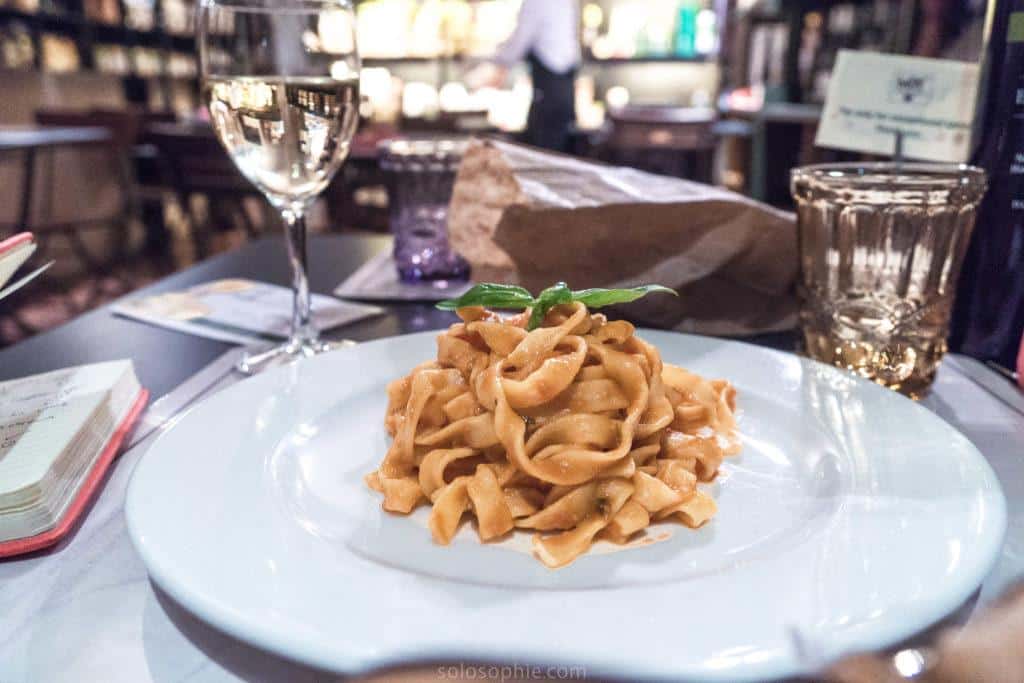
Where to stay in Pavia | Le Stanze del Cardinale
An ancient university town on the banks of the Ticino River, the university city of Pavia was the capital of the Lombardy region for a brief period of time when Lombardy was once a kingdom in its own right.
As such, the town has welcomed countless iconic guests over the years and was even home to Albert Einstein for a short period of time. Highlights of Pavia include a Basilica that both Charlemagne and Barbarossa were coronated in and a perfect reconstruction of a medieval bridge that was sadly destroyed during the war.
The crowning jewel of Pavia is most certainly a Cathedral (known in Italian as duomo) that da Vinci himself had a hand in designing. The town was once called ‘the city of a hundred towers’ owing to an abundance of medieval towers dominating Pavia’s skyline.

Today, although just a handful remain, an idea of what the city looked like can be found in a beautiful medieval fresco on the walls of San Teodoro church. Pavia’s prestigious university is one of the oldest in Italy, second only to Bologna (the oldest university in Europe).
This means that the town’s population is very young due to a third of Pavia’s residents being students, and meaning that there are plenty of affordable eats in town for the discerning tourist!
Wander the ancient courtyards of this institution to step back in time and soak up the atmosphere. Nearby to Pavia (8km North if we’re being precise) , you’ll find the Certosa di Pavia , thought by many to be the most beautiful example of Italian Renaissance architecture in the whole country!

Where to stay in Turin | Grand Hotel Sitea
Flanked on both sides by the mighty Alps, Turin is the capital of the Piedmont region of Italy and is definitely a highlight of this one week in Northern Italy Travel Itinerary. In fact, I’m pretty sure that it was my boyfriend’s favourite destination during our seven-day trip!
From almost all corners of the city, you can see the beautiful mountains rising up like giants, dominating the skyline. The sight definitely makes for a beautiful blend of landscape photo meets cityscape if you bring your camera along, and especially so if you’re an early riser and get up early enough to witness the sunrise.
Once a major political centre (people often call Turin ‘the cradle of Italian liberty’) highlights of this alpine city include world-class universities and a visit to the church which contains the Shroud of Turin.

The Turin Shroud is perhaps the most famous relic in Christianity and allegedly bears the outline of Jesus of Nazareth- a must-see for anyone interested in Ecclesiastical History.
Unfortunately, the Shroud is only on display to the public every decade or so for preservation purposes. And so what you see in Cathedral of Saint John the Baptist is actually a facsimile, but is still worth a visit in of itself.
Other points of interest include a visit to the Mole Antonelliana, Italy’s very own version of the ‘Eiffel Tower!’ and the city is often referred to as the foodie capital of Piedmont. As a result, you should definitely, try some chocolate, make sure to visit a few foodie cafés and sample some local cheese and butter during your visit!
Essential tour: Royal Palace of Turin Entry Ticket and Guided Tour

Where to stay in Milan | Sina the Gray
Milan has the unfortunate reputation of completely underwhelming visitors to the city. And after a visit here, it’s not hard to see why. After all, the city of Milan does not have nearly half as many points of interest and interesting attractions as its nearby neighbours. Instead, it’s a busy, bustling modern city and the second largest city in the entire country.
With that being said, I do still recommend spending at least one night here, if only to check out the shopping districts (Milan is synonymous with haute couture and luxury shopping), the Duomo di Milano (thought by many to be the most beautiful cathedral in the world), Galleria Vittorio Emanuele II (a covered passageway that is well worth a wander inside) and a few other tourist hotspots (mainly in the form of universities and small churches).
Milan is also the perfect place to base yourself if you want to take day trips to smaller cities and towns in the region, as well as if you want to explore the Italian lakes for a day. After all, most major Northern Italian train lines run through here and there are plenty of exciting day trips from Milan to be taken.
Essential tour: Last Supper Guided Tour

For those who are looking to spend 10 days in Northern Italy or just longer than 1 week in Northern Italy, there are plenty of extra wonderful places you can easily add to your European itinerary. One of the most beautiful places to visit is the area surrounding Lake Maggiore , which is home to stunning Renaissance towns and oodles of history.
For example, head to the North of Milan and Bergamo, and you’ll soon discover the land of the lakes. Lake Maggiore is particularly stunning and is characterised by its stunning towns, medieval history, and wonderful outdoor activities.

If you’re looking for even more inspiration about the boot-shaped country, then be sure to check out our best travel quotes about Italy . And if you need to know more information before heading to the South of Europe, check out our top Italy travel tips.
Enjoyed reading One week in Northern Italy Travel Itinerary? Pin it now, read it again later!

Sophie Nadeau loves dogs, books, travel, pizza, and history. A Francophile at heart, she runs solosophie.com when she’s not chasing after the next sunset shot or consuming something sweet. She splits her time between Paris and London and travels as much as she can! Subscribe to Sophie’s YouTube Channel.
This site uses Akismet to reduce spam. Learn how your comment data is processed .
Marissa | Marissa's Teachable Moments
Sunday 4th of February 2018
Reading this made me realize I need to get back to Italy asap!!
Beautiful pictures and great article- wish i had read this when we were in Milan!
Saturday 3rd of February 2018
I just love Italy! I feel like I could go to every little town in this country and fall in love! Thank you for sharing your experience and your gorgeous photos!
Great photography <3 love it!
http://carmelatte.co/wedding-yacht-dubai-find/
unaveronicavagante
Great post and beautiful photos! Next time, don't miss the north-east part of Italy. My hometown is Verona, but I'm currently studying and living in Venice. Totally worth it! Oh, and have been visiting some other cities, such as Trieste (whose post is online in my blog) and Cividale del Friuli. I, as Italian, had heard very little about the last one, but really loved it! :)

13 Unmissable Hidden Gems in Northern Italy Off the Tourist Trail
By: Author Angela Price
Posted on Last updated: July 15, 2023

Northern Italy has some exceptionally beautiful towns and villages tucked away in secret spots off the beaten path. Away from the hustle and bustle of well-known destinations like Milan, Turin or Cinque Terre, hidden Italian gems are waiting to be discovered.
Be it Dozza, Bologna’s secret mural town, Comacchio, the unknown brother of mighty Venice or Chiavenna, the underrated location of the annual Bresaola Festival. Whatever their hidden secret, you can be sure that visiting one or more of these non-touristy destinations in Italy will leave you with incredible memories.
In this post, I highlight thirteen hidden places in northern Italy visited by fellow travel bloggers, which each hold a special secret.
This travel guide may contain affiliate links – please read my disclaimer and privacy policy for more information.
Do you need to arrange travel insurance, car hire or accommodation? Please check out my resources page to help you plan your trip.
Table of Contents
Discover Northern Italy’s Secret Destinations off the Beaten Track
Domodossola – italy’s lesser-know city of art and religion, trento – a medieval unesco world heritage site, sen jan di fassa – the best-kept secret in the dolomites, comacchio – the underated little venice in emilia romagna, chioggia – the untouristy beach town near venice, dozza – bologna’s hidden, painted town of murals, chiavenna – a food lovers’ hidden treasure in lombardy, sesto calende – charming lakeside views on lake maggiore, alba – italy’s lesser-known truffle capital, avigliana – a hidden historic town close to turin, bassano del grappa – a food lovers secret destination, courmayeur – the secret alpine village in the aosta valley, val venosta valley – the natural wonder of south tyrol, map of secret places in northern italy.
Domodossola in the Piedmont region is a great place to visit for a local Northern Italy hidden gem. We stayed for a few days while on our way to Zermatt from Locarno, Switzerland. We decided to travel via Domodossola as there is a scenic train directly to Domodossola from Locarno, where we lived at the time.
Best things to see and do in Domodossola
The city is great to visit on the weekend, as they have a local market on Saturdays to buy treats. This is based at the Piazza del Mercato, where there are also some lovely little cafes, restaurants and boutiques to rummage in. The city has some architectural highlights, such as the Palazzo San Francesco art museum.
Another highlight is climbing the steps to the Sacred Mount Calvary of Domodossola church . This is located an easy 20 minutes from the central train station. I work out often, so I found the steps easy to climb.
On clear days you will be in for a treat, as you can experience a fantastic view from here of the surrounding area and mountains. Many little chapels are on the way dating back to the 17th century.
Where to eat and stay in Domodossola
For a bite to eat, we recommend dining at Ristorante Vikingo . They have an excellent aperitif with drinks for less than 20 euros and freshly made pizzas if you are hungry.
For dessert, head to Gelateria Amarena for freshly made ice cream that will make your tastebuds happy. I had a strawberry and vanilla cup of ice cream, delizioso!
Our stay in Domodossola was at the La Palma hotel. This was perfect since we travelled by car and needed local on-site parking. From the hotel, we could walk into Domodossola to explore on foot. The overall experience was lovely, simple and spotless, with welcoming staff.

South of the Dolomite Mountains in Northern Italy and a hop, skip and jump from Italy’s more well-known landmark – Lake Garda , you will find Trento, which is in the district of Trentino. Trento’s old-world charm makes this a must for an Italian hidden gem list.
Before Trento became part of Italy in 1918, it was part of Austria and Austria-Hungary (or the Austro-Hungarian Empire). Trento is famous for its beautiful landscape and delicious cuisine.
Heading to Trento to explore the region of Trentino brought me here; from the Dolomites to Lake Garda, this region of Italy has it all. It is a hidden gem to most tourists outside of Italy. It was listed as a UNESCO World Natural Heritage site in 2009.
Best things to see and do in Trento
I would highly recommend visiting the Castello del Buonconsiglio.
This castle is one of the Trentino region’s most important castles. Why? Because although now in the present day, it hosts many exhibitions, it was once the residence of Princes, Bishops and Cardinals.
And you can’t visit Trento without visiting its most recognised cathedral, the stunning Cattedrale di San Vigilio. The unique Tridentine Diocesan Museum is attached to the cathedral and houses fantastic artwork, tapestry, and wooden sculptures. Moreover, it explains the rich history and culture of this beautiful town.
Visit Distilleria Francesco in Santa Massenza. Going out of your way to visit (and taste) this grappa distillery in the Trentino region by the beautiful lake Santa Massenza is worth it.
Where to eat and stay in Trento
For something a little different, eat at Birreria Pedavena . There is a wide variety and a vast range of delicious pizzas. Here you can pivot from your usual choice of wines and aperitifs to a nice cold beer and some great authentic food.
For a lovely stay in the centre of Trento, book Hotel America .

Being a small town in a valley in the Dolomites, Sen Jan di Fassa is a hidden gem often overlooked by travellers to Northern Italy. As it’s not a well-known destination, most people are only aware of it if they are a camping or RV family like us.
Travelling through the Dolomite’s windy roads, the journey to Sen Jan di Fassa is well worth the drive from the main highway. It’s certainly only a road to drive on at night if you are familiar with mountain driving, but the beautiful scenery draws you in during the day. When you finally get to the town, it’s incredible to see the jagged peaks of the Dolomites.
Best things to do and see in Sen Jan di Fassa
Sen Jan di Fassa is quite charming. The locals are very welcoming and provide an atmosphere that speaks of their peaceful way of life.
We walked through the town and stopped at a beautiful old cemetery and a small church worth visiting. There are tall stone walls surrounding the cemetery, and the gravestones and plaques on the walls are fascinating to read. It’s a very peaceful place and representative of this lesser-known Italian town.
Sen Jan di Fassa is a good starting point for taking the gondola up the mountain in summer or winter. The mountain journey rewarded us with a great vantage point from the top, which was quite breathtaking.
Not too far away, about 10 minutes by car, there are also great hiking opportunities, including a waterfall. We did a relatively straightforward hike that almost anyone can do.
Where to eat and stay in Sen Jen di Fassa
In town, we stopped at Pizzeria Le Giare, which hits just the right spot for pizza when you’re hungry.
As campers, we always seek to find beautiful places to camp during the summer, and Camping Vidor Family and Wellness Centre was one of the best sites we have visited. It is what initially put this remote spot on the map for us.
The campsite is a great place to stay, made for tent campers and RVs. They have hotel rooms for anyone who wants to avoid roughing it during the night. The centre has excellent amenities, from a two-storey double slide waterpark and kid pools to saunas, an indoor kids club, a games room and much more.
We camped for a week, which was one of our best Italian experiences. I highly recommend staying here as it’s a hidden gem in northern Italy.

Are you looking for an off-the-tourist trail location in Italy? If you are, I can recommend you Comacchio!
It’s easy to understand why they call it Little Venice; water channels spread over a large part of the city, and colourful houses are reminiscent of those on the island of Burano . There are very few people around, and the vibe is surreal.
I visited Comacchio during the early spring on one of those dreary days for which the area of Emilia Romagna in northern Italy is known. It was foggy, with a mist and soft rain that wrapped everything in a mystical cloak. Although cold and grey, this scene is part of Comacchio’s charm.
Due to these meteorological conditions, it may not sound wise that I chose to go for a river cruise, yet I decided to experience this activity despite the weather.
The cruise was idyllic, and although the shapes were less visible, I could still see many birds fishing on the riverside. And they were not the only ones fishing; I saw many local fishermen with large nets.
After two hours, the cruise ended, and I headed back to the city centre to explore more of Comacchio.
Where to eat and stay in Comacchio
I decided to eat at Antica Trattoria la Barcaccia for lunch. I love to taste local food when travelling, so I decided to go with eel; the taste was strong but good!
With lunch over, I continued to explore Comacchio. I lost myself in the empty alleys until I ended at Ponte Pallotta , where three bridges converge.
My time in this hidden gem in Northern Italy had ended. As I left to continue my journey to another one of the incredible villages in Emilia Romagna , I was pleased to have stumbled upon this beautiful place off the tourist trail.
Villa Cavour is reasonably priced if you want to stay overnight in Comacchio.

Chioggia, Italy, is a stunning hidden gem outside Venice, Italy.
Since it’s part of the city of Venice’s public water transportation network , the Vaporetto, it’s been on my list of Italian cities to visit since I moved to the Veneto region.
Once part of the Republic of Venice and the site of the Battle of Chioggia in 1380, the small city is now known for its beautiful canals, quaint streets, and delicious seafood.
On a random Saturday in June, I decided today was the day to visit this lovely little city near Venice; and I couldn’t believe it when I arrived–by chance, we visited at the start of its annual Palio della Marciliana!
Best things to do and see in Chioggia
Every year, the city harks back to its Medieval roots during the festival with a crossbow competition, and locals showcase ancient trades, like net making, coin casting, and weaving.
I wandered the stalls and watched as these modern-day residents performed age-old arts with the finesse of their ancestors.
After exploring Chioggia’s historic centre, we decided to head to the city’s coastline and one of the best beaches around Venice.
The beaches are clean and well-maintained, so you can relax and enjoy the sun without worrying about overcrowding or pollution.
It’s an easy walk from the city centre to the city’s coastline; it took about 20 minutes to cross the bridge from Chioggia over the Isola dell’Unione to the Sottomarina.
My favourite beach in Sottomarina is Astoria Beach, which is free to enter. After spending a few hours soaking up the sun on the Adriatic Sea, we walked back across the bridge to take the bus from Chioggia’s train station back home.
Of course, with gelato from L’Oasi del Gelato ! No beach day in Italy is complete without it, especially with a 20-minute walk ahead.
Where to stay in Chioggia
Since the town is relatively small, you won’t find any large hotel chains or resorts in the historic centre, so booking a room in one of the smaller guesthouses or bed and breakfasts is best.
Otherwise, you can stay at one of the hotels along the beach or take the Vaporetto back to stay in Venice.

Dozza is a charming village near Bologna, off the usual tourist trail in northern Italy, where colourful murals are on every street, turning Dozza into an open-air art museum. It is very reminiscent of Sheffield, the mural town in Tasmania .
Since 1960 Dozza has hosted a bi-annual Festival of Painted Walls; however, its medieval streets shine throughout the year with beautiful images. More than one hundred paintings decorate almost every wall in the village.
Dozza is pretty secluded, a 40-minute drive from Bologna. Hiding among the picturesque hills close to Imola, Dozza is simply enchanting, with spring flowers like wisteria adding to its beauty.
After discovering it on social media, I was happy to visit Dozza with my Couchsurfing host.
Circular in shape and very small, Dozza didn’t require much time to get around. Even so, it was a lovely place that filled me with joy. We had fun exploring and admiring the wall art at a slow and relaxed pace.
Best things to see and do in Dozza
A lovely castle welcomed us at the entrance of Dozza. 13th-century Rocca Sforzesca dominates the charming town, and in its basement, you’ll have a chance to discover a wine cellar. A rich collection of wines from the Emilia Romagna region.
The small church of Santa Maria Assunta was the highlight of our visit. Its tower and painted wall are so alluring, even from a distance.
Where to eat and stay in Dozza
There are only a few restaurants in Dozza, among which La Scuderia is just next to the castle. We enjoyed morning coffee there and later had focaccia in La Bottega . It was even more impressive to have our meal outside on our own, with the excellent views of Dozza.
Not only did Dozza make our trip so alluring, but we also visited the nearby town of Castle San Pietro Terme. Don’t miss Giardini degli Angeli, another hidden gem in northern Italy, especially lovely during spring.
Suppose one day in Dozza isn’t enough for you. In that case, Locanda Dolcevita is a lovely small hotel in the centre of town and perfect for starting your road trip around the beautiful countryside of Emilia Romagna.

Chiavenna is a small medieval commune located in the northern Italian region of Lombardy, close to the Swiss-Italian border. It is part of Italy’s cittaslow movement, which is all about conserving the uniqueness of a place, protecting cultural heritage, and improving the quality of life.
Our reason for visiting Chiavenna was the Bresaola Festival. It’s a fun annual event in autumn, offering an opportunity to eat the famous air-dried meat for which this region is known.
Best things to see and do in Chiavenna
But aside from bresaola, there are plenty of attractions to enjoy around town!
We toured numerous crotti, natural caves fed by subterranean air currents at a constant temperature, making them ideal places to store cheese, meat and wine! These unique mountain cellars can be found in local restaurants and guesthouses. The best way to see one is to choose a restaurant with ‘crotto’ in its name.
Another activity we enjoyed in Chiavenna was exploring on foot and soaking in the views from the bridges that cross the Mera River. This is where you can best admire the pastel-coloured buildings that hang over the river with the mountains rising in the background.
We also visited the Parco Archeologico Botanico del Paradiso, a garden on two hills offering views of the valley and the surrounding mountains. Chiavenna is one of the hidden gems in northern Italy, and truly worth the effort to get there.
Where to eat and stay in Chiavenna
If you want to try typical Chiavennasca cuisine, Ristorante Crotto Ombra is a great spot. I suggest going hungry and going all out with antipasti, primi, secondi and dolci! And yes, treat yourself to a bottle of wine while you’re there.
If one day in Chiavenna isn’t enough for you, book a night in an apartment at Piazza Giani , a historical building in the centre of town.

I chose to visit Sesto Calende while on a trip through Italy because I was visiting a friend who lived nearby with his family.
He suggested that we stay in Sesto Calende instead of the smaller village where he’s from because it’s a bit more bustling and there is more to see.
This charming town is on the side of Lake Maggiore , a beautiful lake with walking trails, boating, and even a plane that takes off and lands on the water. Even so, Sesto Calende remains off the tourist radar and is one of northern Italy’s hidden gems.
My friend informed me that the area is known for manufacturing helicopter parts, which explains why there were so many posters and billboards related to helicopters.
The town is small but charming, with a few restaurants and bars to visit. Very few people speak English, so we got by on Google Translate and our meagre attempts at speaking Italian.
Without a doubt, the highlight of my visit was walking along Lake Maggiore. A path between the houses facing the lake and the water offers breathtaking views in all directions.
Where to eat and stay in Sesto Calende
For lunch, we tried Piazza Abba La Reclame Srl , a local pizza restaurant that also served pasta and other traditional dishes.
The best thing I tried was the bread and cheese served alongside culatello, a type of sliced meat, although all the dishes were impressive. The restaurant has indoor seating, but I’d strongly recommend grabbing a table outside and enjoying the fresh air.
Looking for a place to stay in Sesto Calende? Appartamenti Ticino is reasonably priced, has excellent reviews and is close to the train station. Not forgetting mountain views!

In the Piedmont region, just 70 miles from the French border, Alba is surrounded by wine country in the northwest of Italy.
This charming lesser-known gem sits along the Tanaro River, and its old town, with its small piazzas and stone-lined streets, is at the city’s core. Many structures, including the Cattedrale di San Lorenzo, date back to the 12th century.
We were first drawn to Alba, hoping to be lucky enough to experience the region’s pride and joy.
While most people dream of their perfect summer vacation to Italy, we specifically planned our trip so that we would arrive in Alba during the truffle season.
These aromatic tubers hit the market for around three months each year (October to December), and the Alba Truffle Fair opens its doors.
Best things to see and do in Alba
We went all out and went on a truffle hunt with a local forager and his highly trained dogs, and we even scored a few white truffles that can sell for thousands of dollars per pound.
The Piedmont region is also famous for its wines, including Barolo, which is referred to as the king of all wines. We visited a few wineries and were treated to an intimate tasting with views of the entire valley.
Where to eat and stay in Alba
Luckily we planned iahead and scored a reservation at the highly acclaimed Piazza Duomo – Michelin three-star restaurant. The restaurant put on a show with an opulent tasting menu featuring white truffles alongside Nebbiolo wine pairings.
Our visit to this culinary region of Italy was a potent reminder that there is so much more to see and taste in Italy when you explore a little deeper and get away from the tourist hotspots.
Alba was a fantastic surprise that was more delicious and engaging than we could have imagined. There are plenty of delightful accommodations in Alba for a longer stay.

After exploring Turin, our family decided to spend the rest of our Italian trip in a small town. We were travelling by train so we were limited to where we could go.
A quick look at the local trains revealed Avigliana, a hidden gem in Northern Italy and a quick 30 minutes from Turin. Once we discovered that Avigliana had a mediaeval hilltop town, we decided that this was the location for us, and it didn’t disappoint.
Avigliana old town is a 20-minute uphill walk from the rail station. On arriving in the old town, we were rewarded with a fantastic view over the Susa Valley towards Turin.
The old town centres around a 12th-century cobblestone square, and we spent several hours wandering Avigliana’s car-free narrow lanes.
Best things to see and do in Avigliana
We saw the 11th-century town walls, visited the 14th-century Church of St. John (one of many churches in Avigliana) and explored the 14th-century ruins of the Castello di Avigliana on top of Mount Pezzulano.
We loved Avigliana’s architecture, the highlights included the House of Porta Ferrata, the octagonal Torre dell’Orologio and several centuries-old wells. It was quiet and devoid of tourists, even in August.
It is a 30-minute walk to Avigliana Lakes. Lago Grande is the best lake for swimming; head to the public park on the right side of the lake for a free entry spot. We found the water unbelievably warm.
Where to eat and stay in Avigliana
We stayed in a brand new hostel, Casa Conte Rosso , in an old building on the central square. It was impeccably clean with many original features and offered small ensuite dorms and private rooms.
We popped to Caffetteria Del Vecchio Borgo each day for coffee (and for a late-night beer!), but the best restaurant we found was Ristorante San Michele .
The helpful owner recommended local specialities; their Agnolotti del Pin was outstanding. He also introduced our children to Chinotto, a drink made from the juice of the fruit of the myrtle-leaved orange tree. For the adults, he recommended Genepy liqueur infused with botanicals. It was the best meal we had during our entire trip to Italy.

Bassano del Grappa is a medieval town located in the Veneto region in the Vicenza province. It’s a place where I love going when I’m back in Italy since my hometown Castelfranco Veneto is close by; a 25 minutes drive or just 20 minutes by train.
The incredible views over the Alps from Ponte Vecchio make Bassano del Grappa one of the best-hidden gems in Italy.
Ponte Vecchio is a bridge designed by Antonio Canova that overlooks the picturesque town centre, known for its narrow cobblestoned streets and relaxed atmosphere.
Best things to see and do in Bassano del Grappa
While here, it’s important to explore both piazzas: Piazza Garibaldi and Piazza Libertà. It is here my favourite drink to try is the signature cocktail at the Leone bar .
Also, visiting the civic tower and the nearby Museo Civico di Bassano to learn more about the town’s archaeological past and admire Canova’s works is a must.
The popular grappa distillate comes from here too, so it is worth visiting the Poli Grappa Museum, which offers free admission to learn how grappa is produced. Then at the end, join a grappa-tasting experience.
Bassano del Grappa is also famous for its ceramic production, which is well-renowned all over Italy and beyond, so make sure you stop by the small boutique stores or artisanal laboratories in the city centre to admire the creations.
Where to eat and stay in Bassano del Grappa
My favourite time to visit is around springtime when eating the local white asparagus is common. It’s a versatile ingredient used to prepare pasta and risotto dishes or as a side dish to accompany various main courses. The best place to taste the local cuisine is the Trattoria Bigoleria da Alice , just next to the railway station.
To stay in Bassano del Grappa, try booking Hotel Victoria , a modern hotel 5 minutes from the historic centre.

The Italian alpine village of Courmayeur is nestled in the Aosta Valley, the smallest region in Northern Italy, on the border with France. The two countries are only accessible through the Mont Blanc tunnel or the rotating Skyway Monte Bianco cable car.
I stumbled upon the lesser-known Courmayeur by chance during a drive to the famous French resort of Chamonix . Before arriving at this underrated destination, I hadn’t even known its existence; it just happened to be the last village in Italy to stop at before entering the Mont Blanc tunnel into France.
Courmayeur is a beautiful hidden gem surrounded by the Mont Blanc Massif range, which towers over the town. Wooden chalets decorated with colourful flowers line the streets, and activity and adventure hubs remind you that Courmayeur becomes a ski resort in winter. The sun shone on our visit, and the town of Courmayeur in summer looked beautiful.
Courmayeur is on the 170km long Tour Du Mont Blanc hiking route, which spans Italy, France and Switzerland, and we spotted many hikers kitted out and heading for the mountains. We discovered there were many shorter hikes, including a stunning glacial lake hike, which we would have loved to do had we had the time.
Courmayeur has a good range of restaurants, but we opted for a cold beer and an ice cream while wandering around town.
Where to stay in Courmayeur
If you have booked to stay in Courmayeur , there are many great day trips from the town too. And, if, like us, you are on a European road trip, you are within driving distance of the beautiful towns of Annecy in France and Geneva in Switzerland.

I accidentally discovered the Val Venosta valley with my wife on a trip to a more well-known sight in the region, the bell tower in Lake Resia. We were driving through to Müstair, a neighbouring town in Switzerland.
Val Venosta, known as Vinschgau in German, is one of Northern Italy’s hidden gems in South Tyrol. Italy annexed the former Austrian region after WW1, so locals still speak a German dialect as well as Italian.
The road at the Resia pass at the northern end is at a higher altitude. Our drive went downwards across the valley of lakes, passing small villages that seemed frozen in time. The views are stunning in spring, with snow-capped mountains and green fields filled with colourful spring flowers.
Best things to do in Val Venosta Valley
There are plenty of things to do in Val Venosta , and a history spanning two thousand years can be unearthed in places such as the town of Glurns and the village of Burgusio. Roman outposts along the via Claudia Augusta were a vital trading route leading up to the North across what we now know as Austria and Germany.
The abbey of Monte Maria, a benedictine monastery, has been around since Medieval times, and the Romanesque art of the crypt and church is known to be unique in the alps.
The drive further up into the mountains takes you to a little travel gem, an unknown waterfall. A two-hour-long hike up the mountain trail will reward you with the scenic Schlinig waterfall.
Our favourite hangout was the ruins of the Castello di Montichiari. The ruins are straight out of a fairy tale located at the top of a tiny village, from where you can overlook the valley.
Val Venosta is also known for growing some of the best apples in Europe. The Romans started the apple tradition, and the area is now known internationally for its Delicious, Kanzi, Golden, and Gala varieties.
Where to Eat and Stay in Val Venosta Valley
Book a dinner at the Tschenglsburg , a former castle now a restaurant, to try every tasty bite Vinschgau offers.
Stay at the Hotel Garberhof for a rustic-chic Val Venosta valley experience.

Please Pin for Future Travel to Italy

Are you looking for further Italian inspiration? Please check out the following posts:
10 Beautiful Hidden Gems in Central Italy off the Tourist Trail
Sicily’s Hidden Gems: 10 Sensational Places off the Tourist Trail
10 Unmissable Hidden Gems in Southern Italy Worth Visiting
Top 10 Most Beautiful Lakes in Italy You Must Visit
3 Sensational Nights in Venice: A Complete City Break Itinerary
How to Get To Burano on a Day Trip from Venice
How to Visit Pisa from Florence in a Day and See the Leaning Tower
I would like to receive occasional updates and new travel posts.
Notify me of follow-up comments by email.

The Most Beautiful Places in Northern Italy
Michela Italy Tours 16
If you plan to visit Northern Italy and avoid the crowds, there are hundreds of lesser-known yet beautiful places worth adding to your itinerary. If you visit Italy for the first time , all your favourite cities like Rome, Florence, Milan, and Venice will surely be on your list. But the natural beauty of Italy goes well beyond the surface of the main attractions. You will be surprised to see how many charming villages and small towns the boot-shaped BelPaese has.
Table of Contents
The Best Places to Visit on a Northern Italy Trip
I grew up in Italy and returned to reside back in 2004. I have been travelling in my home country for decades and love to explore new things and experience the extraordinary about the lesser-known and secret places in Italy. From naturalist escapes to food and gourmet regions, in this post, I am showing you some of the best places to visit in Northern Italy , especially in Italy’s North East, an area that boasts small heritage sites and naturalistic treasures that you will love.
See Italy with our Groups of Over 50 👉 Small Group Tours of Italy 🌟
Trieste, the pearl of North-East Italy
Trieste is the most underrated city in North Italy. Located in Friuli Venezia Giulia, in North-East Italy, Trieste is right on the border with Slovenia. Although it feels isolated from all other northern Italian towns, leaving will be difficult once you get there. I call Venice’s sister town on the mainland because of its canals and the spectacular, beautiful Piazza D’Unità D’Italia on the sea.
From there, a short stroll along the Molo Audace, a 200-meter paved walkway, takes out to sea. Triest is the pearl of the Karst Plateau , where you can take beautiful walks along the Rilke Trail or the Strada Napoleonica (Napoleonic Way).
Another thing to do in Trieste is walk along its beautiful 6 km promenade that leads to the Miramare Castle, a white castle perched on a small promontory surrounded by a vast lush green park. If you are a food and coffee lover, Triest is home to the worldwide famous coffee brand illy coffee. The beautiful contrasts and the rich heritage makes Trieste an ideal destination for a weekend gateway when exploring Northern Italy. You can also travel to Croatia and Slovenia, as Trieste is located on the border of Slovenia. You can get to the beautiful coastal town of Baska Krk Island in a couple of hours.
Where To Stay in Trieste
Budget: Hotel Roma Mid-Range: The Modernist Hotel Luxury:
Venice: Discover its offbeat treasures
There is something magical about Venice that I cannot put into words. As a local, no other place in Italy makes me feel like strolling on Venice’s Calle. Having visited Venice since I was a kid and throughout my life, every trip to Venice is like seeing it for the first time. I get goosebumps whenever I get off the train and walk through the Venetian Calle. There is always a tiny hidden place, hundreds of little “ calli” (dead-end alleys) to discover and get lost. And many small islands on the Venetian Lagoon that are a real treasure. You can go on a heritage tour and explore more of its naturalistic beauty: go biking, walking, and bird watching.
These are some of Venice’s most unusual places that are not on most tourists’ plans when they come to see Venice.
Where To Stay in Venice
Budget: Locanda ai Santi Apostoli Mid-Range : Ca Nigra Lagoon Resort Luxury : Ca’ Di Dio Small Luxury Hotel
Check out our 👉 Guide To Venice Where To Stay Best Areas Guide 🌟
Padua, the city of Saint Antonio
Padua is one of the oldest cities in Northern Italy and home to many world-class sites like the Basilica of St. Antonio . This church was built in 1232 and continuously attracted visitors with its architecture and highly valued masterpieces.
You can also retrace the footsteps of Galileo and Copernico at the University of Padua, the fifth oldest university in the world, established in 1222. I suggest visiting The Orto Botanico di Padova , the world’s first academic botanical garden.
Another world-renowned work of art in Padua is the Scrovegni Chapel . You’ll be amazed by the frescoes depicting scenes from the lives of Jesus and Mary. And after a day of exploring, you can relax at Caffè Pedrocch i, the oldest and most famous historical café in Padua.
Where to Stay in Padua
Budget Hotel: Hotel Giotto Mid-Range Hotel: Hotel Europa Luxury Hotel: Four Points by Sheraton Padova
Guided Activities and Day Trips in Padua
If you want to join guided activities, and day tours, check out what we recommend here below:
Treviso, the closest Town Near Venice
Treviso is a Northeastern Italian city in the Veneto Region. It’s only 26 km from Venice, which gave it the nickname ‘gateway to Venice’. Sadly, tourists often overlook it, leaving only a few to appreciate its charming canals, historic places, cobbled streets, and picturesque river banks.
Treviso is quieter than Venice but still puts you close to the Veneto Prosecco region and wide vineyards where you can taste Italian sparkling wines. It also boasts medieval architecture in places like the Palazzo dei Trecento, equipped with battlements and vaulted arcades.
Medieval frescoes are also found at the Civic Museums’ leading site, the St. Catherine complex . You can also get up close to Fontana delle Tette , a 16th-century fountain that used to dispense wine.
Where to Stay in Treviso
Budget Hotel: Hotel Rovere Mid-Range Hotel: Ai Bastioni Boutique Hotel Luxury Hotel: Leoni Di Collalto Palace
Vittorio Veneto: a small heritage town in Northern Italy
Not many people know there are so many charming little villages and heritage sites within a short drive or one-hour train ride from Venice. One of these is Vittorio Veneto , with its beautiful medieval castle and many old buildings from the Renaissance era. Vittorio is one of the most beautiful Italian cities that must be on your bucket list as a day trip from Venice.
The Prosecco Road between near Conegliano
Welcome to the best region for all Italian sparkling wines. I’d say the area that can best compete with the French Champagne. There are many types of Prosecco , and the only place where the vineyards grow here is Veneto. You can visit the best Prosecco Wineries and go through some fantastic Prosecco hills and lush landscapes.
You can also hire a car and drive through the famous Prosecco Road from Conegliano to Vittorio Veneto and further down to Valdobbiadene. This triangle-shaped land encompasses the top white wine region of Italy. In my Summer Italy Tour of the Dolomites, we will go on a gourmet Tour by tasting the best Prosecco and walking through the picturesque Hills of Vittorio Veneto. If you like the idea of having a private group to the Prosecco Hills with Vittorio Veneto and Cortina .
The Northern Dolomites, a UNESCO Heritage site
The Italian Dolomites stretch between three regions in North-East Italy: Trentino & South Tyrol , Veneto, and Friuli Venezia Julia. Most people choose Cortina, which is very popular with tourists in summer and winter.
Bolzano: the northernmost Italian City
On the way to the Dolomites, you’ll pass Bolzano —a charming city in Northern Italy often called the Gateway to the Dolomites. It offers a panoramic view of unspoiled nature, such as the Earth Pyramids in the Bolzano plateau, Europe’s tallest and most beautiful natural pyramids. You can also visit the famous alpine iceman named Otzi in the South Tyrol Museum of Archeology in Bolzano. If you like to visit Bolzano, check out our Dolomites Hiking Trips .
If you love architecture, you’ll be fascinated by the late Gothic Assumption of Our Lady Cathedral and numerous castles, such as Rafenstein and Hocheppan Castle. Should your visit fall during the Christmas season, explore Bolzano’s famous Christmas market and discover why it’s considered the Christmas Capital of Italy.
Where to Stay in Bolzano
Budget Hotel: Hotel Laurin Mid-Range Hotel: Hotel Scala Luxury Hotel: Hotel Figl
Trento, Sister Town of Bolzano
Trento is a small, underrated city in the Alto Adige region of Northern Italy . And while the Dolomites wait not too far ahead, Trento also offers various attractions, such as the famous Buonconsiglio Castle . It’s the home to late-medieval fresco cycles and now functions as the Provincial Gallery of Art.
The architecture of Trento Cathedral on Piazza Duomo and the Renaissance building of Casa Cazuffi-Rella will also captivate you. Trento also keeps a modern appeal with its high-tech exhibits at the MUSE , a science and natural history museum.
You’re bound to have a fantastic dining experience in Trento, and you can end on a good note with the famous Trentodoc. It’s one of Italy’s most popular sparkling wines, made from Trentino grapes.
Where to Stay in Trento
Budget Hotel: Hotel America Mid-Range Hotel: Lainez Rooms & Suites Luxury Hotel: Grand Hotel Trento
Ortisei, Val Gardena, For The Best Mountain Views
Nestled in the Northern Dolomites , Ortisei is the main village in Val Gardena. It’s by the riverside and has an exciting pedestrian zone filled with various cafes, shops, and restaurants. This zone connects the chapel of Saint Ulrich to the Antonius church and is considered the most beautiful shopping street in the Dolomites.
Skiing in Val Gardena is one of the highlights of your visit to Ortisei. Other activities include hiking up Mountain Pic and through Rasciesa and Seceda . You can also go to the Ortisei climbing hall to practice on the 220 sqm climbing wall before going to the iconic Dolomites. If you like the idea of travelling with a small group of friends, we can organise fo you a Dolomites Private Tour .
Ortisei has also been the woodcarving centre since the 17th century. Today, the famous wood carvings of Val Gardena can be found all over the globe.
Where to Stay in Ortisei
Budget Hotel: Hotel Pontives Mid-Range Hotel: Hotel Cosmea Luxury Hotel: Hotel Genziana
How to plan a trip to Northern Italy
If you plan a trip around Northern Italy and beyond, during or after COVID-19, one of the most comfortable ways to save you time and hassle of booking your accommodation is to go on a road trip across Italy with an RV . Ideally, North Italy can be explored by train, as the train network is excellent and you can go anywhere by train. You don’t need to hire a car from Frecce to Italo Trains or the frequent regional trains; you are covered and can get anywhere.
Guided Tours Of Small Towns In North Italy
If you like joining a guided trip and seeing off-beat places in North Italy, check out our small group tours 👇
Want to see Italy’s off-beat places? Join our 👉 Small Group Tours of Italy 🌟
Guided Trips: half-day to full-day tours
See all options of half-day to full-day guided trips here below:
A South Tyrol Trip Itinerary
Things To Do When In Trieste
From Venice To The Dolomites
Italy Travel Guide: What You Need To Know
Rocky Travel
Pin it for later!
Explore the beauty of small towns in Northern Italy
Learn About Our Small Group Tours of Northern Italy
You can subscribe to Tour News to learn more about our Italy Small Group Tours For Over 50 . Fill in the fields below with your name and email address.
We respect your privacy, deliver only valuable content. No spam ever.
If you find this article helpful for your trip, I’d appreciate it if you could support Rocky Travel, book tours, accommodation, and rental car, or purchase my book using the links below. Thank you!
BOOK YOUR ITALY TRIP WITH THESE RESOURCES
Get Travel Insurance For Your Italy Trip
Travel with peace of mind: 👉 Compare and Buy Travel Insurance .
Book Accommodation In Italy
Find the best deals for hotel, homes, villas with 👉 booking.com .
Join Small Group Tours Of Italy For Over 50
Explore Italy with our 👉 Small Group Tours Of Italy .
Get Help For Planning Your Italy Trip
Plan your italy trip independently.
Check out our 👉 Travel Planning Bible .
First published in 2018, last updated in March 2024
Photos Credits from Shutterstock Photo no. 1. Trieste Miramare Castle Photo no. 2. Serravalle Vittorio Veneto Phooto no. 3 Burano Venice Photo no. 4. Vittorio Veneto Photo no. 5. Prosecco Hills Veneto Photo no. 6. Dolomites Landscape
Michela Fantinel
→ Michela Fantinel
Related Posts

Travel With Like-Minded People Over 50

19 Unique Places To Visit In Venice You Will Love

15 Best Places To Visit In Sicily And Where To Stay
16 comments.
Doreen Pendgracs April 17, 2018 @ 2:25 am
I absolutely adore Italy and Prosecco, so I know I would love touring the region where Prosecco was invented! Thx for the tantalizing post!
Rocky Travel April 30, 2018 @ 8:03 am
Hi Dorreen, thanks for stopping by. The Prosecco Road is a beautiful route in Veneto that shows you the best places for Prosecco tastings amidst lush-green hills and little villages.
Debbra Dunning Brouillette April 17, 2018 @ 10:19 pm
I’ve not yet visited Italy at all…but the northern region looks amazing. I hope I can make it there one day and enjoy all the beauty (and Prosecco!) that Italy has to offer.
Carole Terwilliger Meyers April 18, 2018 @ 2:49 am
I’ve added Prosecco Road to my to-do list! Can’t wait!
Perry H April 18, 2018 @ 6:47 am
Mmm.. I have a friend in Triest, looks like I’ll need to pay a visit. Thanks for some great insights.
Lisa Chavis April 20, 2018 @ 2:26 pm
Such a beautiful post and you’ve totally inspired my Italy wanderlust! Now I want to go on the Prosecco Road and sip bubbly…and to Venice to glide down the canals. The colors of Burano are spectacular! Thanks – I really enjoy your posts!
Cathy Sweeney April 23, 2018 @ 4:52 am
I like your suggestions of places to visit, including Prosecco Road — an area that I loved! I really enjoy the lesser-known gems of Italy. Although now I’ve been to Italy several times and have visited many places, my first trip was focused on the towns of Emilia-Romagna — an amazing experience.
Gabrielle April 23, 2018 @ 11:28 am
Italy is actually the most economically productive and has a host of important manufacturing regions that help give it one of the highest GDPs per capita in Europe.
Jane April 23, 2018 @ 10:05 pm
You had me at ‘Prosecco’! But seriously, some of my family is from Trevino and the northeastern part of Italy, so I really should do more exploring there!
Rocky Travel April 30, 2018 @ 8:26 am
Treviso is only 30 kilometers from Venice, a short train train. North East of Italy is beautiful, yet overlooked by most travellers who prefer to focus their first-time visit on the main Italian attractions. If you are coming you definitely have to include a trip to the Prosecco region and the Venetian Dolomites!
Susan May 24, 2018 @ 6:41 pm
Hi, I’m really into The Italian Dolomites, so can you pls suggest some other “small Dolomites towns” for me? Thank you so much for your such helpful guiding post. I hope you will get much further in this field.
Rocky Travel August 28, 2019 @ 9:15 am
Hi Susan, thanks for your comment. Glad you liked it. Watch out for this space to learn more about the beautiful small towns in the Dolomites!
matthew August 28, 2019 @ 1:04 am
Hi Michela,
I stumbled on your site and it looks wonderful. I’m in the very very early stages of planning a 2020 stay in N. Italy and thinking about four weeks in a town such as Verona, Padua or some other city as a home base. The town could be smaller. Any suggestions?
Rocky Travel August 28, 2019 @ 9:10 am
Hello Matthew, thanks for reaching out. Verona is a lovely city to use as a base if you want to do day trips from there, you can go to Padua, Vicenza, Trento, Rovereto, they are all within reach and doable on a day. If you love to explore more of the fabulous North East, I’d suggest you spend time in Bolzano you can use it as base to explore the beautiful Dolomites . Hope that helps! if you have more questions feel free to contact me here . Thanks :-
Terry July 6, 2022 @ 2:20 pm
Hey Michela, This is wonderful information. I was wondering if you could suggest a 3 day trip from Milan. We have Verona on the 4th day and will be taking your suggestions, Padua, Vincenza, Trento, Roverto and Bolzano while we are there and after Verona we are heading to Lake Como. But I am having a hard time with the first leg of the trip. (first 3 days) Thanks so much for all of your help.
Michela July 7, 2022 @ 5:37 pm
Hi Terry, Those places are a bit far away from Milano. I’d actually suggest nice towns and places nearby so that not much travelling is involved. Please reach out to me via our email to: info @ rockytravel.net and I’d be happy to help out. 😉
Leave a Reply Cancel reply
Your email address will not be published. Required fields are marked *
Privacy Overview

Best Hidden Gems in Northern Italy: 30 Non Touristy Places to Visit
From small unknown towns to underrated cities to picture-perfect natural spaces, there’s no shortage of hidden gems in northern Italy, the queen of exquisite food & wine, regal architecture, art, history, and remarkable natural landscapes.
Fully enjoying what the regions in this area have to offer will take years upon years (I have taken many trips to northern Italy yet still only scratched the surface), so many towns and cities can serve as a base to explore it, but if you’re planning a trip and want to get off the beaten path, the following places will surely provide some memorable moments.
* This post may contain affiliate links from which I earn a commission (for more info, read my disclosure ). As an Amazon Associate, I earn from qualifying purchases.
* I try to keep the information on this blog as updated as possible, but I still recommend consulting the latest prices, opening hours, and other details on the official website of each site, hotel, and tour, as well as checking the updated public transport routes and timetables.

Highlighted tip/hidden gem: Don’t miss the hot chocolate at the cafe near Cascata del Lenteney in Aosta Valley, one of the prettiest parts of northern Italy.
Table of Contents
Northern Italy off the Beaten Path: Friuli-Venezia Giulia Region
Laghi di fusine.
By Natali from She’s Abroad Again
When most people think of Italy, they think of charming cobblestone streets, cities full of history, and stunning beaches. However, northern Italy is home to some majestic mountain ranges full of hidden gems.
You will find the fascinating Laghi di Fusine at the foot of Mangart massif in the Julian Alps, right between the borders of Italy, Austria, and Slovenia. Their location makes them easy to visit even on a day trip from Zagreb , Croatia.
These two alpine lakes of glacial origin are a perfect place for a relaxing day in nature, even if you are not a sporty person!
Two lakes, Lago di Fusine Inferiore and Superiore are connected by a circuit trail approximately 2km long. Both lakes are stunning and have crystal-clear water, so make sure to hike the path connecting them.
You can hike the circuit trail in 45 minutes, but don’t be in a rush. The path is fairly flat, and there are benches along the way to sit and enjoy the view. The second lake is a starting point for many hikes, so if you are a hiking lover, remember to bring proper equipment!
Alternatively, rent a small boat on the first lake and head out for a unique and relaxing activity.

Hidden Gems in Northern Italy: Region of Lombardy
Ponte di legno.
By Isabella from Boundless Roads
If you are looking for a typical Italian mountain town with wooden houses, flowery windows, and cobblestone roads, Ponte di Legno is one of the cutest villages that you can visit in the north of Italy.
Located in the Val Camonica among the Italian Alps in Brescia province, it is easily reachable either from Brescia or Milan by direct bus. However, it’s recommended to rent a car to explore the beautiful surroundings.
The name Ponte di Legno means wooden bridge in Italian. In fact, this pretty town is named after an old bridge crossing the rivers Frigidolfo and Narcanello right in front of their merging point, creating a beautiful postcard-worthy scene.
Ponte di Legno is renowned among Italians and foreigners alike as a great ski resort in winter and a hiking destination in the summer, but it’s also loved by those who are less sporty.
In fact, the pretty town also offers spa services, delicious coffee shops and wineries where you can hang out and relax, easy trails with spectacular panoramic views, and great restaurants where you can try the delicious local cuisine.
The outdoorsy will love the 42 slopes among Ponte di Legno, Tonale, Presena, and Temu, all connected and suitable for all levels for great winter holidays in the snow.
In the summer, you will find many trails that allow you to walk for days, if you are up for it, and sleep in the free cabins scattered around the mountains. All the trails are very well mapped and marked.
Also, mountain biking has become huge in the past few years, and you can rent all the necessary equipment in local shops.
Whether you decide to have a summer holiday or an Italian winter getaway , whenever you go, you will have a blast in Ponte di Legno.

Trezzo Sull’Adda
By Sarah from Mukikapup’s Travels
Trezzo sull’Adda is a small Italian town you might easily miss, but it’s a mere 19 miles (30.5 km) from Milan. It’s a UNESCO World Heritage Site with a lot to offer, including unique travel photography opportunities!
You can reach Trezzo sull’Adda by public transit and see the sites on foot or by bike.
A trip to Trezzo sull’Adda should include the Visconti Castle, a 14th-century castle with a fortified bridge, as well as Villa Gina, a 17th-century villa and the location of the Adda Nord Regional Park.
Along with these sites, you should definitely take a walk through the workers’ village of Crespi d’Adda , a textile company town and present-day UNESCO site that serves as a well-preserved example of towns built for company workers in the 19th and 20th centuries.
On your visit, you’ll see the workers’ houses, town amenities like public wash-houses, a clinic, a school, a theater, and the hydroelectric power station.
The church and the castle were also part of the village, and the overall geometric layout and brick exteriors of the building design are part of the charm, not to mention the location in the quaint river valley surrounded by nature and amazing views.
The village has a visitor’s center, and you can find cafes and restaurants both in Crespi d’Adda and Trezzo sull’Adda.

Moltrasio, Lake Como
By Zoe from Together In Switzerland
For a beautiful hidden gem in Northern Italy, take your time near Lake Como to visit Moltrasio.
Located on the western side of the lake, this commune is officially part of the Lombardy region of Italy, close to the border of Switzerland.
There are a few significant historical places in Moltrasio, such as the Church and Piazza San Martino, which dates back to 1207, and the Church of Sant’Agata, dating back to 1197.
The second church mentioned was once used as a local hospital to help those in need during the plague.
There are also a few stunning viewpoints from where you can look towards the opposite villages of Brunate, Torno, Lemna, Molina, Villa Roda Roccabruna, Blevio, and more.
To enjoy the lake view with a bite to eat, head to The Moltrasio Bay restaurant. They provide delicious Italian dishes with tables on their terrace area.
Fun fact: You can find up to 30 drinking fountains in Moltrasio, so you won’t be short on filling up a water bottle on a hot day. Many of the fountains date back to the 19th century when locals would use them for fresh water as well as for washing clothes near the bigger washhouses.

By Joanna from The World in My Pocket
Pescallo is a lovely place just off the very popular Bellagio, on Lake Como.
Whilst most tourists will swarm the streets of Bellagio, Pescallo remains relatively empty, and you can explore it at your own pace, without any of the crowds. It is, without a doubt, one of the most beautiful towns on Lake Como .
To reach Pescallo, you have to walk towards the end of Bellagio and spot the narrow alley bordered by stone walls, going uphill. After a five-minute walk, you will start descending into Pescallo and spot the first colored houses covered with ivy.
Pescallo is quiet, small, and very pretty. The main square opens up to the lake, with a few benches overlooking it.
There are many boats and small yachts anchored in the bay. The water here is so clear that you can see the stones at the bottom of the lake.
If you are adventurous, you can rent a kayak or a paddleboard and explore this area of the lake at your own pace.

By Shev from Shev Strolls
Tucked away along the river Adda near the town of Imbersago, you will find the Villa D’Adda Reaction Ferry.
This small river shuttle was allegedly designed by Leonardo Da Vinci, but that’s not the only thing that makes the ferry special.
As you watch the boat make its way across the water, you will notice something peculiar….silence! The Leonardo Ferry does not have an engine!
The ferry is connected to a cable between either side of the river and special rudders underneath.
Every day, the ferry captain adjusts the rudders according to the river currents, and that is what pushes the boat and its passengers – up to 100 people and 5 cars – back and forth across the water.
The Villa D’Adda Ferry is accessible from the town of Imbersago in Lecco County. The boarding area has a lovely river walk and some tables to enjoy a riverside picnic.
Don’t let the gorgeous blue hues of the River Adda tempt you though – the currents are strong, and swimming is forbidden due to the danger of the water.
Villa Panza, Varese
By Katie from Katie Caf Travel
Villa Panza is a true hidden gem in the north of Italy. An 18th-century Italian mansion, it has been beautifully maintained and is now home to an extensive collection of contemporary fine art.
Villa Panza was bequeathed to the FAI: Fondo Ambiente Italiano, also known as the National Trust for Italy, in 1996.
FAI is a non-profit organization that aims to “take care of special places in Italy for the benefit of present and future generations”, and that’s certainly something they succeeded with Villa Panza.
In 2001 it re-opened as a modern cultural house and contemporary art museum.
The art collection at Villa Panza started in the 1950s when Count Giuseppe Panza owned the palace. He had an affinity for art and began amassing a collection that is still on display today in the modern-day museum.
Currently, you can see over 150 works at Villa Panza, spanning from contemporary artists like James Turrell, Robert Irwin, and James Flavin, as well as historical art pieces dating back to the Renaissance period.
Hidden Gems of North Italy: The Aosta Valley Region
Lago di brusson.
Located in eastern Aosta Valley, the Brusson Lake is a stunning turquoise gem that must be on your itinerary. Surrounded by mountains and vast grass fields, it’s also an ideal place to enjoy a picnic, offering plenty of tables with benches and a big playground.
You’ll find more than enough parking, which is free if you’re not visiting in the peak season, as well as a few places to stay around the lake.
If you’re driving on the SR33 to get to Brusson, note that the road is very winding, but the views over this area you see along the way are completely worth it.
When you want to go back towards the central part of the region, consider driving south on the SR45 and then heading north again on the SS26 or the E25 highway.

Cascata Del Lenteney
Right between the town of Aosta and the Skyway Monte Bianco cable car, there’s an enchanting waterfall that connects to the beautiful Dora Baltea River.
Driving on the SS26 instead of the E25 highway, you’ll see it (and the cafe of La Cascata) on your left if you’re heading west, so cross the small bridge a few meters before it and park the car.
Apart from marveling at the scenery from the bridge, you can also take a short walk to see the waterfall up close (look for the trail signs near the cafe, which, by the way, makes excellent coffee and hot chocolate).
Even though the Aosta Valley boasts dozens of postcard-perfect natural spots, this one can easily be a highlight on your northwest Italy road trip .

Aymavilles is a small town surrounded by vineyards and apple orchards, dominated by the gorgeous Aymavilles Castle.
The 4-tower castle was built in the 13th century for the noble Challant family, and today, you can explore its rooms and history for only 9 euros (you can buy tickets here ).
Another visit-worthy stop in the town is the Les Cretes Winery, which was established in 1800. Set in a beautiful modern rural space, the winery welcomes you whether you just want to buy wine or have a tasting and a tour, which you can book here .
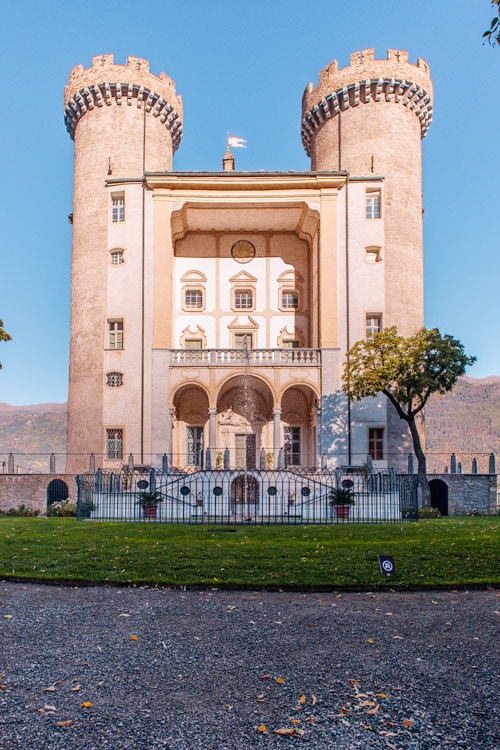
Pont D’aël
Situated only 4 km from the Aymavilles Castle, Pont d’Aël is a Roman aqueduct dating back to 3 BC.
Still visible is an inscription from that era, which says the aqueduct was privately owned and funded by a man named Caius Avillius Caimus from the wealthy Avilli family.
The landmark’s uniqueness becomes even more apparent when you see its surprising location amidst the natural scenery, its upper part, which serves as a bridge, and its covered passageway, which you can buy tickets to walk through (only 5 euros for adults).
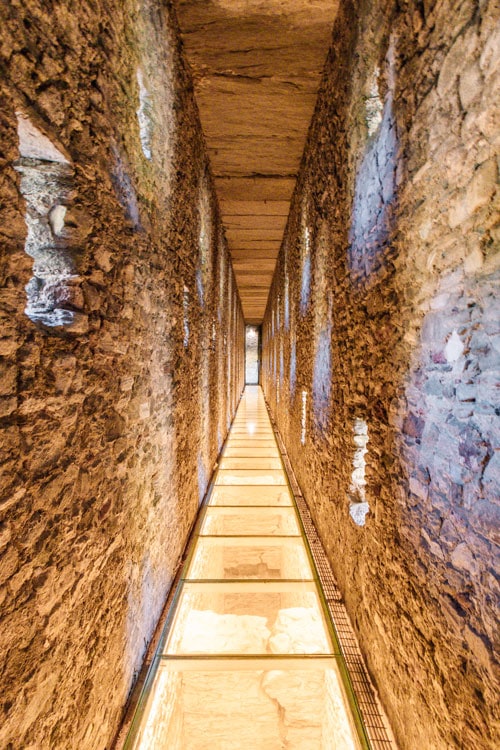
Castle of Baron Gamba (Castello Gamba)
There’s no shortage of castles and fortresses in Aosta Valley, but Castello Gamba is an unusual one, considering it’s not medieval and was only built in the 20th century.
Comissioned by Baron Carlo Gamba, the estate-like castle is surrounded by a vast park you can wander around, and it now houses a museum of modern and contemporary art.
It also offers beautiful views of the valley, so even if you’re not visiting the museum, it’s worth adding a quick stop here.

Passerella Panoramica of Pré-Saint-Didier
The quaint town of Pré-Saint-Didier is known for its natural thermal springs, but did you know it’s also home to a stunning lookout point?
After a 5-minute drive from the center and another 10-minute walk from the parking lot, you’ll get to the Passerella Panoramica, which provides breathtaking views over this part of the valley.

Aosta Valley is famous for producing fontina cheese, and plenty of local dishes allow you to try this amazing local product, including polenta concia , fondue , and risotto alla Valdostana .
Those who want to visit a cheese cellar and buy high-quality fontina can head to the farm and shop of Lo Copafen, located a short drive from the iconic Fenis Castle.
The welcoming owners let you see the cellar for free, but be sure to try and purchase some goods before heading to your next stop.

Read more about Aosta Valley:
- Best places to stay in Aosta Valley
- Reasons to visit Aosta
- Best things to do in Aosta Valley
Hidden Gems in North Italy: Region of Veneto
Bassano del grappa.
By Daniel from Urban Abroad
With so many unique things to do in northern Italy, it can be tricky to know which ones to pick, but if visiting a medieval town located at the foot of Veneto’s Alps sounds hidden enough, then Bassano del Grappa makes the perfect place to see.
Being located just 1 hour and 20 minutes away from Venice, this town can give you a world-apart experience from the city of canals and bridges. It’s known locally for its Ponte Vecchio bridge, which you can walk along and admire the beautiful scenery over the river and the mountains.
You quickly start to realize there is something adorable about this town. When it comes to food to try, you have to sample baccalà mantecato (creamed cod), and during the springtime, the mouthwatering risotto with DOP white asparagus.
Some of the best things to do in Bassano include a stroll around the spirited Italian piazzas , which are elegantly filled with bars and traditional restaurants.
Then there is the Poli museum, where you can discover everything about Grappa, a local fragrant, grape-based Italian brandy.
Also, don’t miss the Sturm Palace, a place where you can get an insight into the ceramic production that is local to the town and famous throughout Italy.
To get to Bassano from Venice, just take the regional, direct train from Venezia Santa Lucia station.

Riviera Del Brenta
By Dhara of It’s Not About the Miles
One of the most unique day trips from Venice you can do is the Brenta River cruise from Venice to Padua . You can do the cruise in the reverse direction as well.
Along the Brenta River, you will find some stunning Venetian villas – there are more than 50 villas along the banks of the river! Many of them were built in the 15th and 16th centuries as holiday homes for wealthy Venetians.
One of the most beautiful villas along this stretch of the river is Villa Pisani in Stra. Today an art museum with an impressive collection, the villa has played host to many royals. Its gardens are renowned, with a well-preserved maze and a swimming pool.
Also in Stra, you can visit the Villa Foscarini Rossi, now a museum of shoes old and new.
The Villa Widmann is an 18th-century home that belonged to a family originally from Persia. The frescoes inside are must-sees, and the gardens are worth strolling as well.
Near Mira, you will find La Malcontenta or the Villa Foscari. Designed by famous Renaissance architect Andrea Palladio, this villa is part of the UNESCO World Heritage Site – “City of Vicenza and the Palladian Villas of the Veneto.” The interior features stunning frescoes.
Borghetto Sul Mincio
Located roughly 14 km (8.7 miles) south of Lake Garda, the riverside village of Borghetto is a Northern Italian hidden gem you cannot miss.
Its medieval landmarks and streets, combined with the surrounding natural scenery, make it irresistibly enchanting.
You’ll be greeted by the 14th-century fortified Ponte Visconteo, charmed by the old water mills dotting the hamlet’s picturesque center and mesmerized by the views of the Mincio River and the entire valley.
You should also check out the Church of San Marco Evangelista, visit the nearby Scaliger Castle, and try local tortellini called Nodo d’Amore (‘The Love Knot’), which, interestingly, are connected to a Romeo-and-Juliet-like love story legend .

Hidden Gems of Northern Italy: Region of Piedmont
Intra, lake maggiore.
Adjacent to the town of Verbania, where many travelers visit the Villa Taranto Botanical Gardens, you’ll find the adorable Intra.
Sitting on the western shore of Lake Maggiore, this town makes a great stop on a road trip when you just want to grab some lunch or gelato and enjoy the lake views.
In a couple of hours, you can walk along its promenade (Lungolago di Intra), admire the Basilica di San Vittore, and roam the colorful alleys and hidden courtyards.

Cannobio, Lake Maggiore
A stone’s throw away from Italy’s border with Switzerland is the medieval lakeside town of Cannobio.
While it’s not a place with a lot of landmarks, it still offers quite a few things to do and see, including its weekly market, several churches, cobbled alleys, and a beautiful promenade overlooking Lake Maggiore.
You can also unwind at the town’s beach, Lido di Cannobio, located a few minutes away from the center. If you want to stay here, the area is home to plenty of camping sites, B&Bs, and hotels.
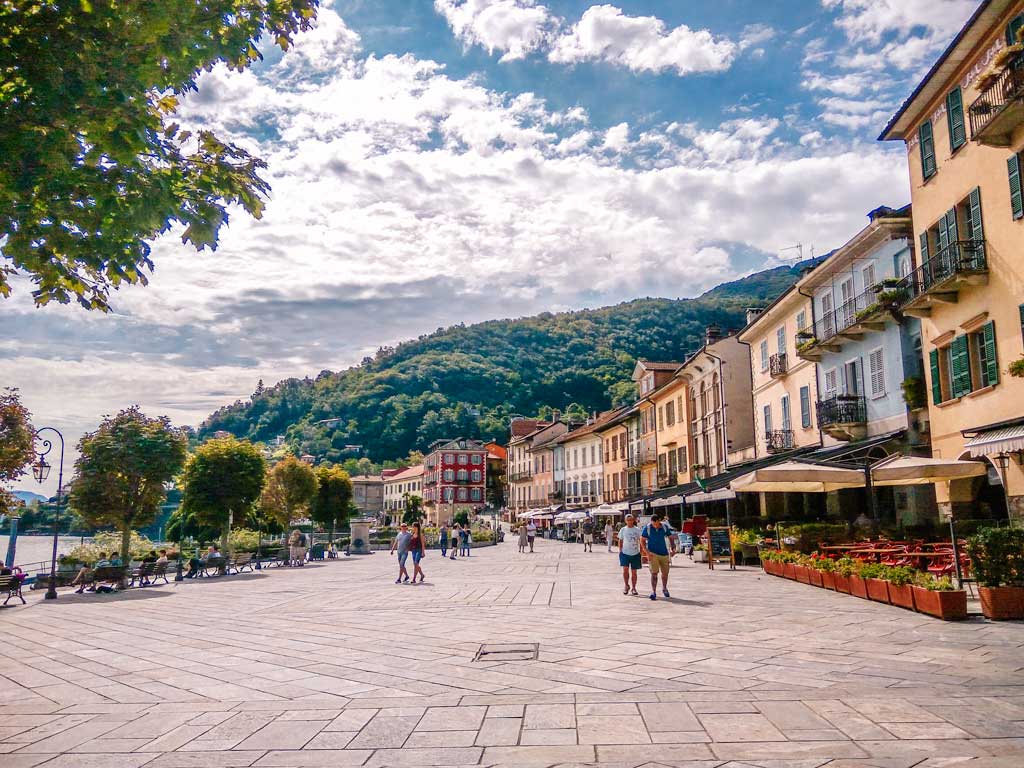
Only half an hour from Turin by car or train, not too far from the famous abbey Sacra di San Michele, is the lovely town of Avigliana, with origins tracing back to the 6th century.
Apart from roaming its tiny yet charming historic center, overlooked by the ruins of its castle, you can also visit the nearby Natural Park of the Lakes of Avigliana.
The two lakes are surrounded by walking and cycling trails, sailing centers, restaurants, and beach bars. Since it’s a natural park, it is also known for its flora and fauna, including different types of birds, frogs, and even turtles.

By Olivia from Livguine
In the heart of the Piedmont wine region is one of the most spectacular hidden towns in Northern Italy – La Morra. Built in the Roman era, this town can be traced back to at least the 12th century.
Nestled up high on a hill, the drive to La Morra is truly beautiful as you pass fields and fields (and fields) of vineyards. This town is one of the most important Nebbiolo growing regions, from which, of course, the famed Barolo wine comes.
When in the heart of Barolo land, wine tasting is a given. There’s a lot of really good wine to be drunk here, and one of the best places to stock up on some affordable bottles is the Cantina Comunale di La Morra.
Other things to do include a stroll through the beautiful winding streets all the way up to the most stunning view over the whole Langhe region from Piazza Martiri!
Plus, don’t miss a walk through the vineyards to discover the Barolo Chapel. Make sure you have your camera, you’re going to want to snap lots of pics!
Enjoy a long lunch or dinner at one of the many excellent restaurants in town and indulge in the local cuisine. Visiting this part of northern Italy in October or November is particularly good for white truffle fans!

Orta San Giulio, Lake Orta
An often-overlooked charming place that will take your Italian lakes road trip to a whole new level is Lake Orta. Although it’s much smaller than Garda, Como, and Maggiore, it’s not going to disappoint.
Amongst the few small towns dotting the lake’s shores are Pella, Omegna, and Ronco, but if there’s one you cannot miss, it’s Orta San Giulio.
From the lovely Piazza Motta to the historic center’s enchanting cobbled alleys to the scenic views seen from the Sacro Monte di Orta, beauty is all around.
It’s also possible to stay at Villa Crespi , a 19th-century villa turned into a 5-star hotel and restaurant.
Last but not least, Orta overlooks a tiny islet, Isola San Giulio (home to the 12th-century Basilica di San Giulio), to which you can take a short boat ride.

Venaria Reale
The small town of Venaria Reale is located roughly 10 km (about 6.2 miles) away from Turin and is one of the best day trips from the Piedmontese capital thanks to the top landmark it’s home to – the Palace of Venaria (Reggia di Venaria Reale).
Along with other magnificent royal residences of the House of Savoy in the region of Piedmont , the 17th-century Baroque palace is a UNESCO World Heritage Site.
Commissioned by Duke Carlo Emanuele II, the palace is a must-see spot that boasts lavish interiors, lovely landscaped gardens, and surrounding Alpine scenery.
One of its most stunning rooms/halls is the Great Gallery, an architectural masterpiece known for its intricately detailed ceiling and strategically placed windows.
If a tour is not enough and you’re looking for a unique experience, opt for a meal at the palace’s Michelin-star restaurant.

Read more about Turin:
- Is Turin worth visiting?
- Things to do in Turin
- 3-day Turin itinerary
- Turin travel tips
- Cafes in Turin
- Turin chocolate guide
- Where to stay in Turin
- Turin in winter
- Hidden gems in Turin
- Turin or Milan
Secret Spots in Northern Italy: Region of Trentino-Alto Adige/Südtirol
By Paul from Paulmarina
Lake Resia , also known as Reschensee, is located in Val Venosta, South Tyrol, in Northern Italy, right next to the Austrian border. What makes it so special is the bell tower in this turquoise lake.
The lakes in the area were turned into a hydroelectric dam, and in the process, the locals were relocated. What was left was the 14th-century bell tower right at the entrance to the new village of Curon (Graun im Vinschgau).
It’s a protected historical monument, and therefore it was left as a reminder, turning the mountain lake and tragic story into a mysterious place.
The backdrop of the snow-capped mountains and peaceful valley also makes it one of the most stunning places for you to visit in the Italian Alps.
The area is also known to be great for summer and winter sports and is famous for its stunning castles, ruins, and medieval abbey.

Antholz Valley
By Lori from Travlinmad
In the South Tyrol region is the stunningly beautiful Antholtz Valley, one of the best places to visit in northern Italy that remains mostly undiscovered.
This hidden gem goes by several names. In Italian, it is the Valle Di Anterselva, but because it’s only 9 kilometers from the Austrian border, you’ll most often hear it referred to in German as Antholzertal.
The lush valley neither looks nor feels like what you’d most often think of as Italy. Surrounded by mountains with the Dolomites nearby, this valley is a mecca for alpine hikers, and in the winter months, for cross-country and downhill skiing.
You won’t find a lot of tourists here. What you will find are charming small villages, dairy farms, and friendly locals who insist they are “Italian in passport only “.
There is much to see and do in the Antholz Valley. You can hike through incredible scenery around Lake Antholtz, hike to the alpine huts during the summer and winter, and visit the World Biathlon Center, where Olympic-class biathletes train.
The Germanic influence here is strong and is reflected in the hearty Alpine-style foods like schnapps, schnitzel, and tummy-filling dumplings.

North of Lake Garda, not too far from the town of Riva del Garda and the Varone Waterfall, a gorgeous lake and a medieval hamlet are waiting to be discovered.
With only 750 meters in length, Lake Tenno is a small yet utterly beautiful must-see spot for nature lovers.
Its vibrant color will surely put a smile on your face, and you can enjoy it by taking a walk around it, having a picnic, and even hopping in for a quick swim.

Borgo Medievale DI Canale DI Tenno
A stone’s throw away, you’ll find Borgo Medievale di Canale di Tenno, a tiny 13th-century village with a whole lot of rural charm that still keeps its original urban layout.
Its narrow cobbled alleys lined with flower-adorned stone houses are a delight to explore, taking you centuries back.
It was abandoned for a few decades after World War I and got the attention it deserved thanks to the artist Giacomo Vittone who immortalized it in his paintings.
Tenno’s Casa degli Artisti (House of Artists) is a museum dedicated to him, hosting exhibitions, workshops, and other events.

By Lyubomira from Bulgarian On The Go
Trento is nestled along the banks of the Adige River, seemingly tucked away from the touristy crowds. It’s one of those hidden gems in Italy that isn’t often on people’s travel lists, but once you come here, its charisma might make you want to come back.
The town is located in the beautiful region of Trentino-Alto Adige. The closest airports are in Verona (about a 1-hour drive), Bergamo (2 hours), and Venice (2 hours). From these places, you could either take a train or a bus to Trento.
An interesting fact is that Trento was awarded the Alpine Town of the Year in 2004. It also often ranks highly among Italian cities for quality of life and standard of living.
Trento is very popular among students who come here to study from all over the country, and it’s also one of Italy’s wealthiest and most prosperous cities.
The beauty of small towns is that they can be easily explored on foot. The same goes for Trento, especially if you’re staying in the town center.
There are so many things you can do in Trento – from wandering around the old town and visiting the beautiful Castel del Buonconsiglio, the most important castle in the region, to taking the cable car to the small town of Sardagna and enjoying the view over Trento from there.
If you’re traveling with kids or just interested in nature and science, here you’ll find MUSE – an interactive museum of science that can keep you occupied for a couple of hours.

By Lyndsay from The Purposely Lost
Easily considered a hidden gem in northern Italy, Bolzano is often overlooked because it’s not located near one of Italy’s main international airports.
However, this small city in the South Tyrol region has a lot to offer visitors who want to explore the Italian countryside.
Located inside the Dolomites mountain range, surrounded by lush green valleys, it has a fantastic city center and a unique blend of Italian and Austrian/German culture.
The region was part of the Holy Roman Empire for about 1,000 years and officially became part of Italy toward the end of World War I.
It’s home to several museums, including the South Tyrol Archeological Museum (Museo Archeologico dell’Alto Adige / Südtiroler Archäologiemuseum), which features artifacts dating back more than 5,000 years, as well as Ötzi , a Neolithic glacier mummy from the Copper Age.
The city is an excellent choice to base yourself on if you want to go hiking, skiing, snowmobiling, or sledding from Bolzano in winter . During Christmastime, it’s home to one of the largest Chriskindlmarkt in Italy.

By Gabi from Under Flowery Sky
Merano is a tranquil and picturesque town lying at the border between Italy and Austria, and its bilingual character speaks about its history. It is a wellness destination with the alluring invite of the South-Tyrolean mountains.
You will also be enticed by the historical attractivity that brought many artists and scientists. Some of them include Franz Kafka, Ezra Pound, and Princess Sissi, the most notable visitor. In the 13th century, Merano was also the capital of the County of Tyrol.
Merano is the botanical paradise where floral sculptures play their tune. You will also adore the pristine charm that belongs to the Summer and Winter Promenade.
The Gilf Promenade gives the torch of beauty to the Tappeiner Promenade, which opens the doors to scenic mountains in the embrace of Mediterranean plants. The cable car to Monte di Merano stands in the middle.
The colorful streets of Merano will bring you unforgettable joy. The historical Kurhaus building holds an elegant venue for congresses, balls, and concerts.
The Gardens of Castle Trauttmansdorf will simply enchant you as it was with Sissi. It was her holiday residence and now the loveliest gardens in Italy. The remote charm of the Meranese hills will give additional value.

Map of Northern Italy’s Hidden Gems
Access the map here .
Tip: After accessing the map, you can also open it on your Google Maps app. Simply open your app, tap the ‘saved’ icon at the bottom, scroll down and tap the ‘maps’ icon, and choose the MyMaps map you want to see (you can do the same on your computer).
Other Italy Guides
Read more about Italy:
- Hidden gems in southern Italy
- Hidden gems in Milan
- 4 days in Milan
- Road trips from Milan
- Things to do in Milan in the rain
- Day trips from Milan in winter
- Best places to visit in central Italy
- 7-day Rome-Florence-Venice itinerary
- Best Italian road trips
- Travel quotes about Italy
- Romance novels set in Italy
- Gifts for Italy lovers
Were you inspired by North Italy’s hidden gems? Read:
- Madrid off the beaten path
- Barcelona off the beaten path
- Valencia off the beaten path
- Mallorca off the beaten path
- Spain off the beaten path
- Portugal off the beaten path
- Budapest off the beaten path
- Puglia off the beaten path
About Or Amir
Hey, I'm Or! I'm a passionate traveler with a severe coffee, chocolate, and pastry addiction (or any other carb for that matter). I'm always planning my next trip to Spain, Italy, or any other country in Europe, and my goal is to help you make the most of each destination.
*Your emil address will not be published. By using this form you agree with the storage and handling of your data by this website
Leave a Comment Cancel reply
Save my name, email, and website in this browser for the next time I comment.
Hi, I'm Or!
I'm a passionate traveler obsessed with traveling in Europe and discovering hidden gems in each place I visit. For me, it's not about ticking destinations off the bucket list but experiencing each one of them to the fullest. Read more about me and my story.


Wealth of Geeks
Explore the Wonders of the Northern Italy
Posted: January 1, 2024 | Last updated: January 1, 2024

When we think of Italy, most of us probably picture the Colosseum or the Amalfi Coast, but what if I told you that this beautiful country has much more to offer? Take a chance at a new location the next time you plan a visit to Italy.
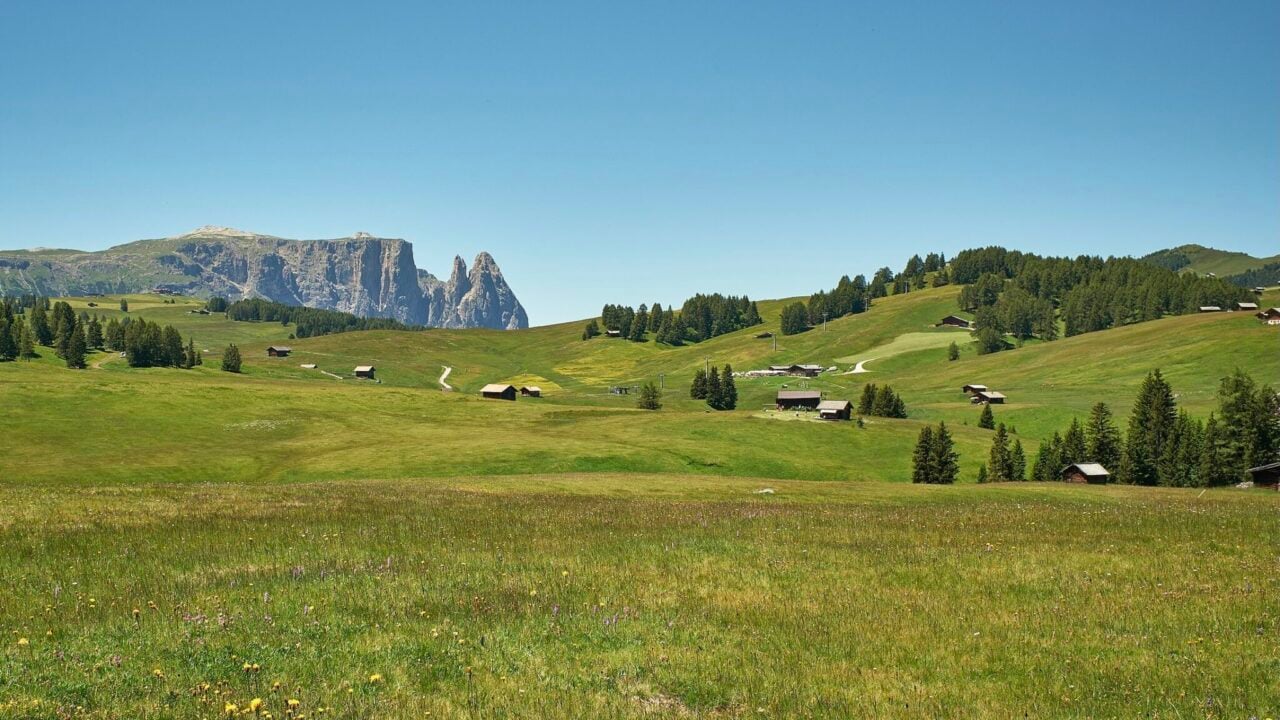
Northern Italy Has Much To Offer
Our focus today is on Northern Italy. It is a place that seems to be straight out of a fairytale. No one likes to travel without a plan, and we are here to help. We have devised a list of the best things to do while visiting the mesmerizing Italian North.
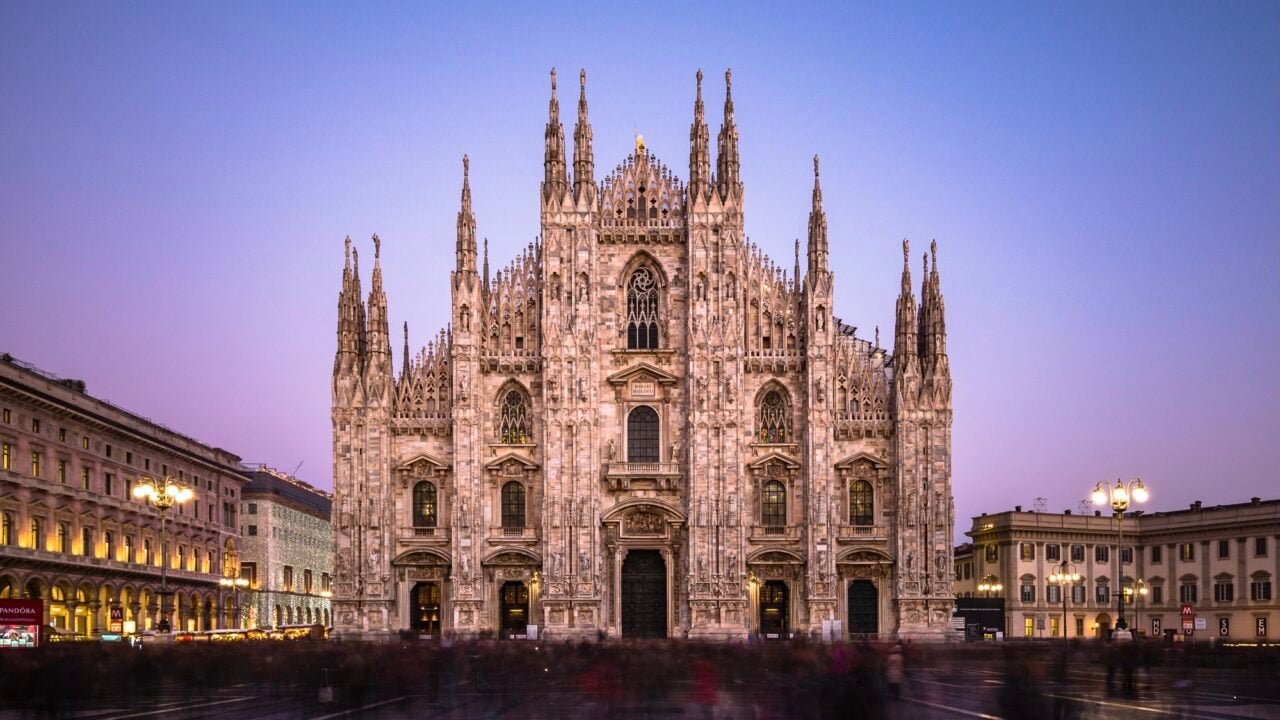
1. Admire the Magnificent Duomo Cathedral, Milan
Milan is a city of fashion. Recognized as the most influential fashion city in Europe, it is packed with stores of big brands in the luxury district known as the Quadrialtero della Moda. The district is made of four streets. The city is absolutely adorable and slightly different from other Italian cities because it follows modern trends more than any other city. There are many things to see in Milan apart from the obvious Duomo Cathedral .
The city center is built around the Duomo, representing a historical city center. Duomo di Milano is an architectural masterpiece built in the fourteenth century and is one of the three biggest Cathedrals in the world. The Duomo is the most famous icon of Gothic architecture and is widely considered a city symbol. Apart from Duomo, we recommend seeing Da Vinci’s Last Supper, visiting the Navigli District, and watching soccer at San Siro/Giuseppe Meazza Stadium.

2. See the Breathtaking Lake Como
Lake Como, better known as Lago di Como among the Italians, is an idyllic place to see. The beauties of the lake are hardly described in words, but we will give our best shot. We are confident that Lago di Como is one of the most beautiful sights in northern Italy . The lake is widely recognized as a celebrity retreat spot, so along its coast, you will see the most beautiful villas, one of which is owned by no other than George Clooney . This place offers you so much to do apart from its unique nature, which is enough for itself. Taking a boat tour must be on your to-do list. Como is surrounded by surreal-looking towns such as Bellagio and Nesso. While at it, you should try the world-famous Italian cuisine, and the lake’s districts are filled with amazing restaurants.
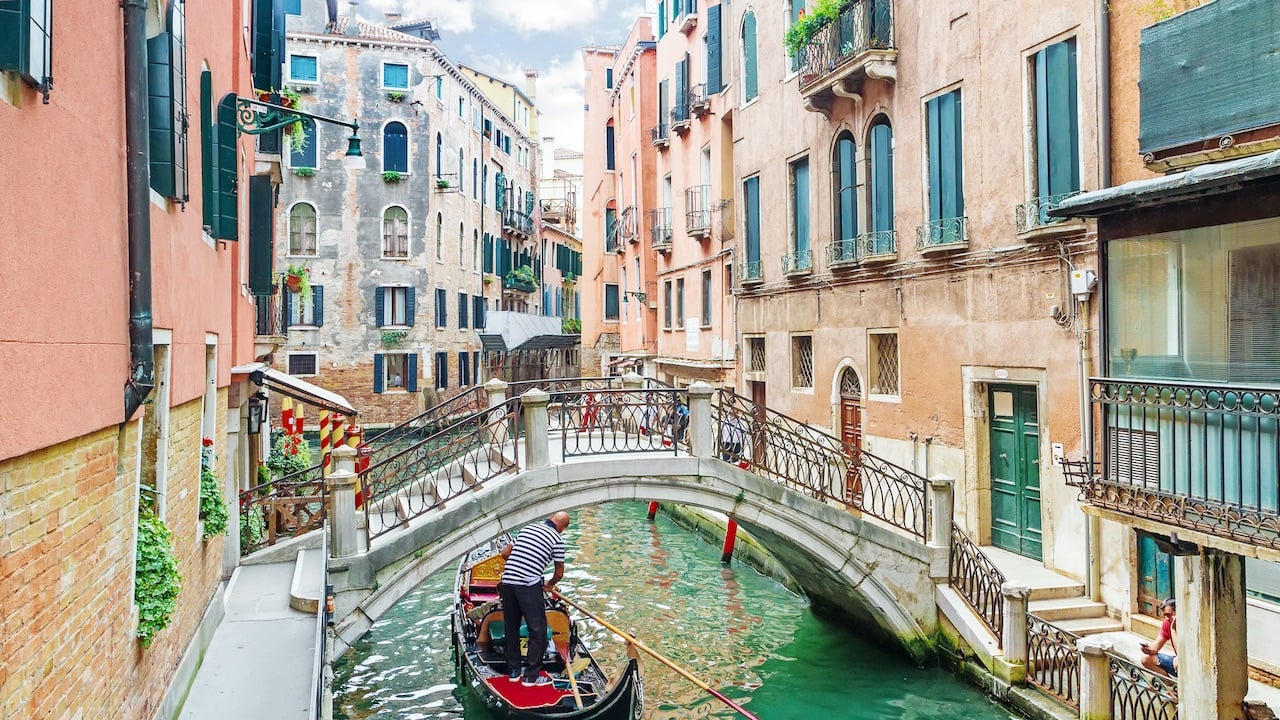
3. Ride the Canals, Venice
A fairytale world of narrow canals and breathtaking cathedrals proved to be an iconic place long ago, with legends like William Shakespeare dedicating one of his novels to the city. Coming to Venice on a boat will and seeing the city from afar will leave you thinking that the whole city is floating on water. You can’t describe Venice simply by writing or reading words about it, so we encourage you to visit it while you can. This is due to Venice sinking and rising ocean levels; the experts say it won’t be around for much longer.
While we still have it, we suggest several items for your must-do list in Venice. A gondola ride through narrow canals is one of the town’s symbols; if you miss out on this one, it will be as if you were not there. Enjoy a romantic ride with a gondolier and take picturesque views like no other. The second thing on a must-do list should be visiting St. Mark’s Square, the heart of town.
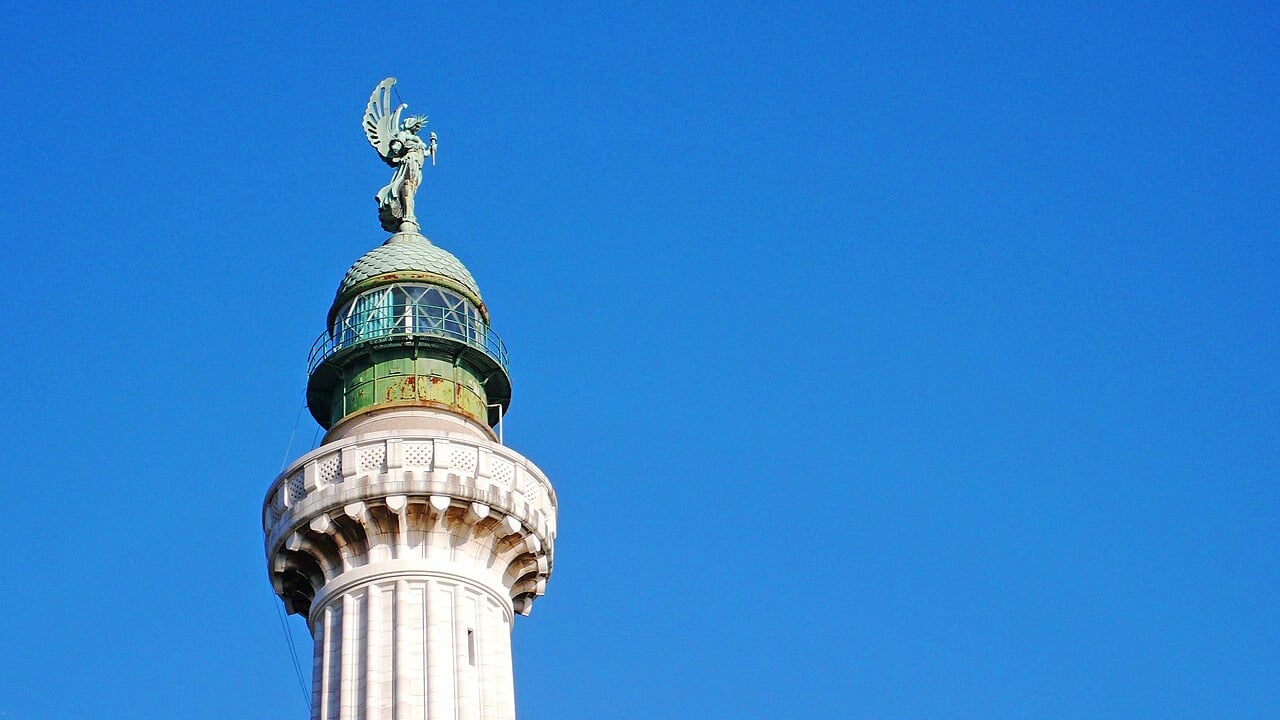
4. See the Vittoria Lighthouse, Trieste
Vittoria Light, also known as the Victory Lighthouse, is located in a small town on the eastern point of northern Italy. The town in question is Trieste. This beautiful little town is the closest town to the Croatian border. The symbol of the town is the lighthouse. This radiant stone tower is among the tallest in the world, with a height of 223 feet.
This tower represents victory in WWI. The site of the lighthouse is open for tourists two days a week. Coming to the top of the tower requires climbing 285 steps, and it’s a bit challenging, which makes this experience much more unique, as you get an incredible sense of accomplishment. The view from the top of the tower is spectacular, so we highly recommend this one.
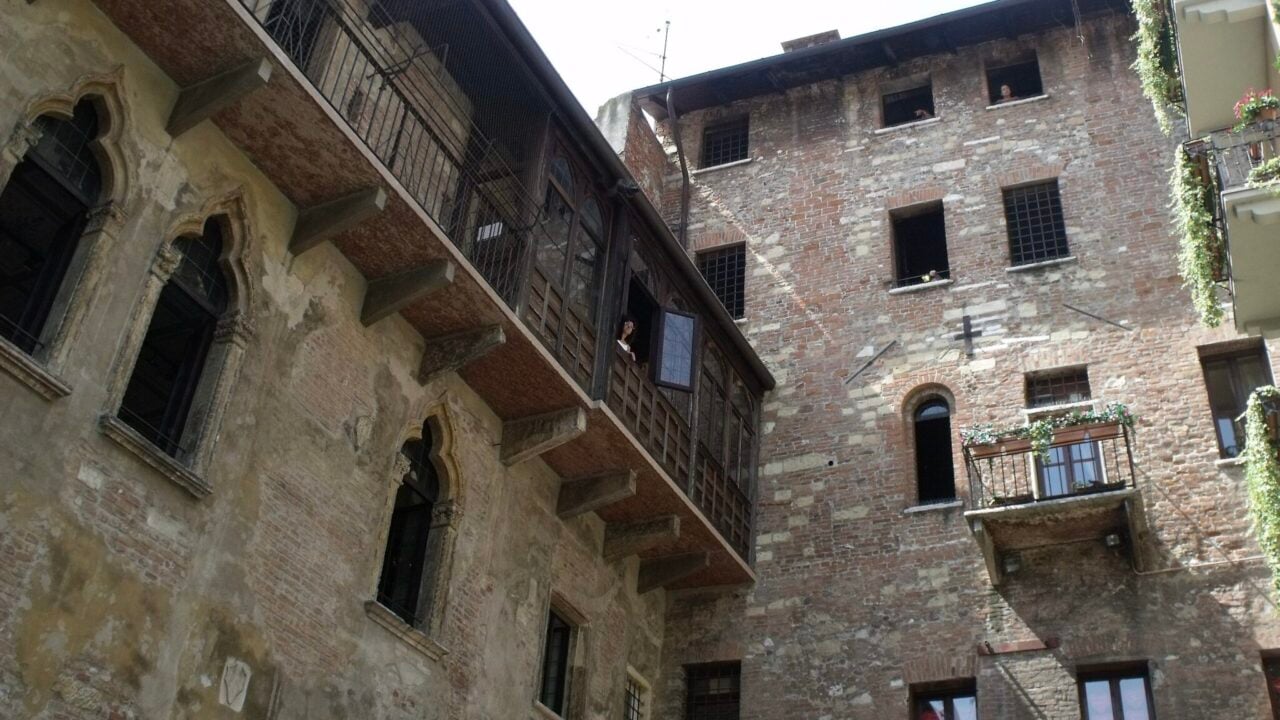
5. Romeo and Juliet House, Verona
We come back to Shakespeare and his famous play Romeo and Juliet . Verona bears the epithet of a romantic city, as it really is. Walking around the city, you will feel like the light is sparkling and everything around you is reminiscent of a Disney movie. We highly recommend visiting this place if you are on an anniversary or a honeymoon. There is no better place for romantic souls than Verona. You should take a picture on the famous Juliet balcony, write a romantic letter, and stick it on the wall of the house. We also recommend checking out the ancient Roman amphitheater Verona Arena.
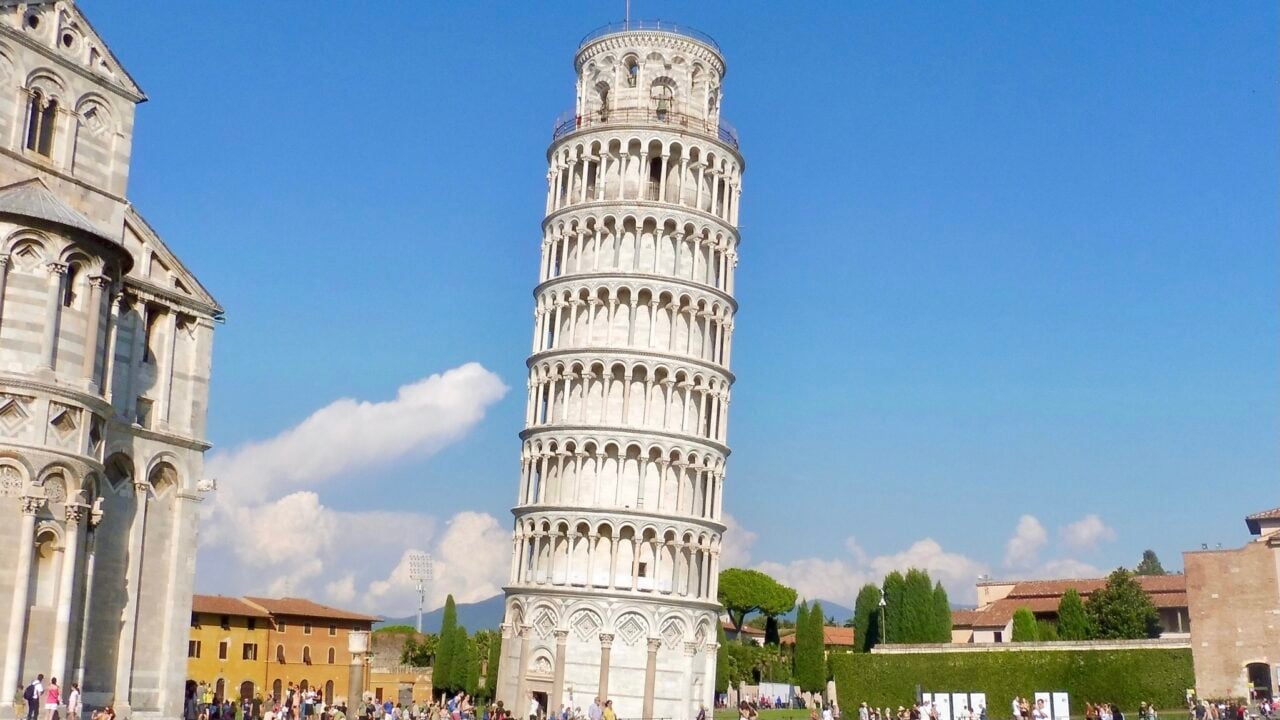
6. Take a Photo Next to the Leaning Tower, Pisa
This iconic tower of Pisa is a global landmark. This leaning phenomenon happened during the 12th century due to the tower’s weak foundations and the soft soil that couldn’t support the tower’s weight. The lean makes this 183-foot-tall tower one of a kind. Apart from this phenomenon, the architecture of this tower is beautiful and exciting.
You should also take a walk through town as it represents the authentic atmosphere of a small Italian town with great restaurants and monuments. The tower is located on a soothing green field where you can sit and take a break as you drink your espresso and enjoy a splendid view.
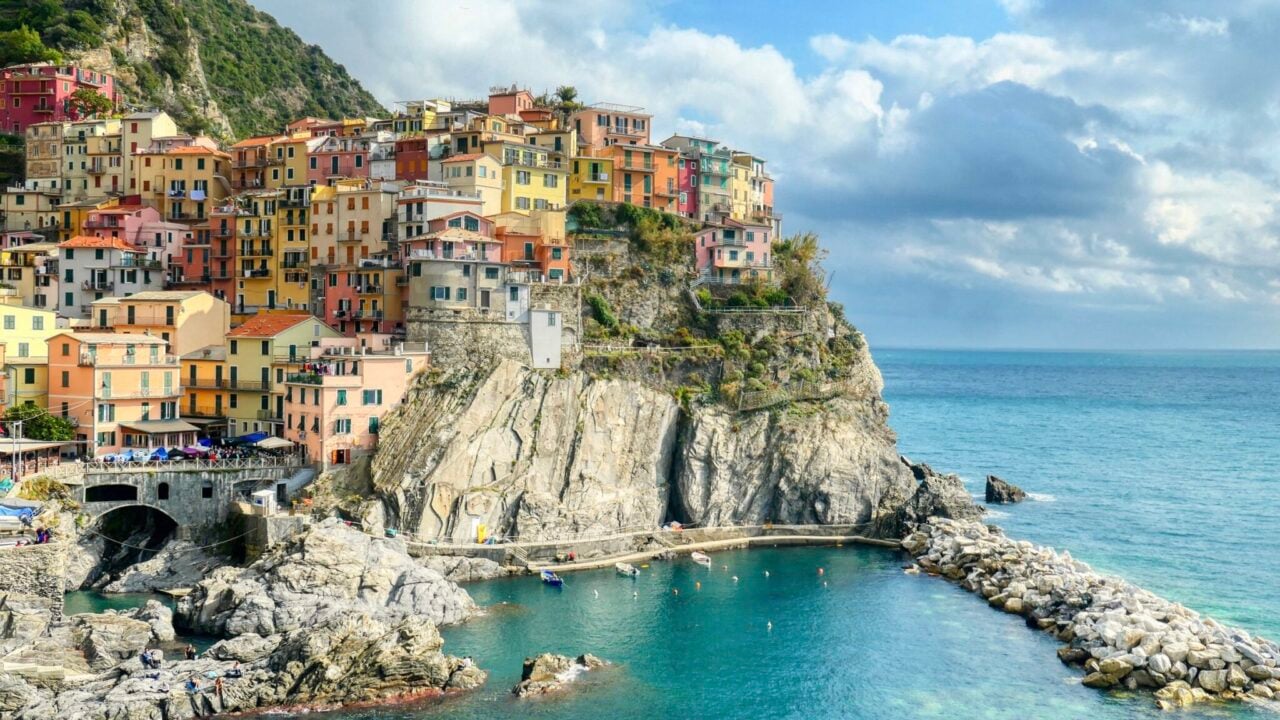
7. See the Villages, Cinque Terre
Cinque Terre is a coastal area comprised of five magnificent villages nestled on the cliffs of the Mediterranian Riviera. Five villages are Monterosso al Mare, Vernazza, Corniglia, Riomaggiore, and Manarola. This charming and picturesque area offers breathtaking views and insight into Italian traditional coastal life. We assure you that this is one of the most beautiful places to be in Europe.
Taking a boat tour will give you a million-dollar view of the villages. You shouldn’t miss out on this hiking tour connecting villages Riomaggiore and Manarola. The delightful colors of Vernazza are not to be missed as climbing the stairs through town and tasting the local seafood.
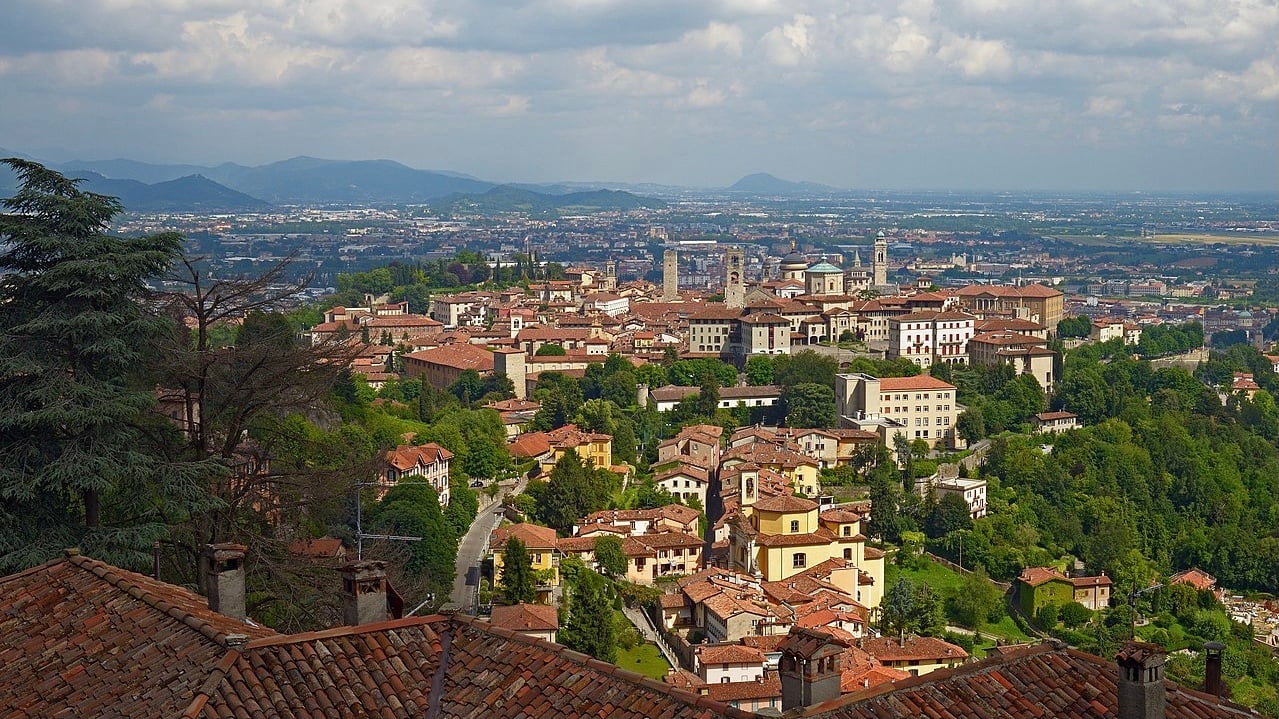
8. Visit the Fabulous Bergamo
This charming medieval city is located in the Italian Alps, just over 24 miles from Milano. Bergamo is a hidden jewel of northern Italy. Famous for its towers, churches, historical villages, funicular railways, walls, stairs, and much more, Bergamo truly has everything that a medieval city should offer. The city is divided into two parts; Citta Alta, which is a historic part of the town, and the modern part, Citta Bassa, with boulevards, squares, and fashion shops.
Along with visiting the city’s museums and exploring the narrow streets of Bergamo, you won’t regret hiking in the city’s surrounding area. This surrounding area is known for its tasty domestic wine, so if you are a wine lover, this is a place you should visit.
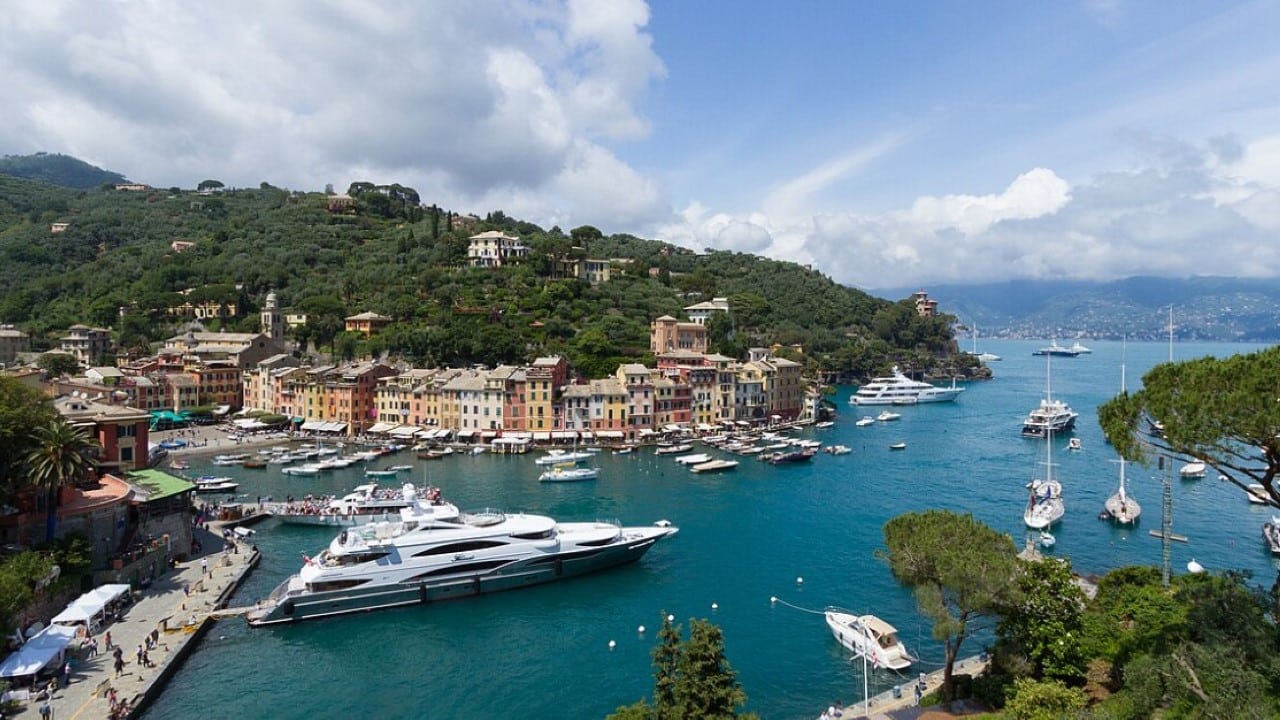
9. Portofino
A fishing village with breathtaking views and picturesque colorful buildings is a stop you must take on your voyage. Here, you can take a walk through Portofino Harbour and admire luxury yachts docked in it. Apart from that, Portofino has some history to offer as well. Visiting the historic Castello Brown should be on your list, too, as it contains beautiful gardens you shouldn’t miss out on.
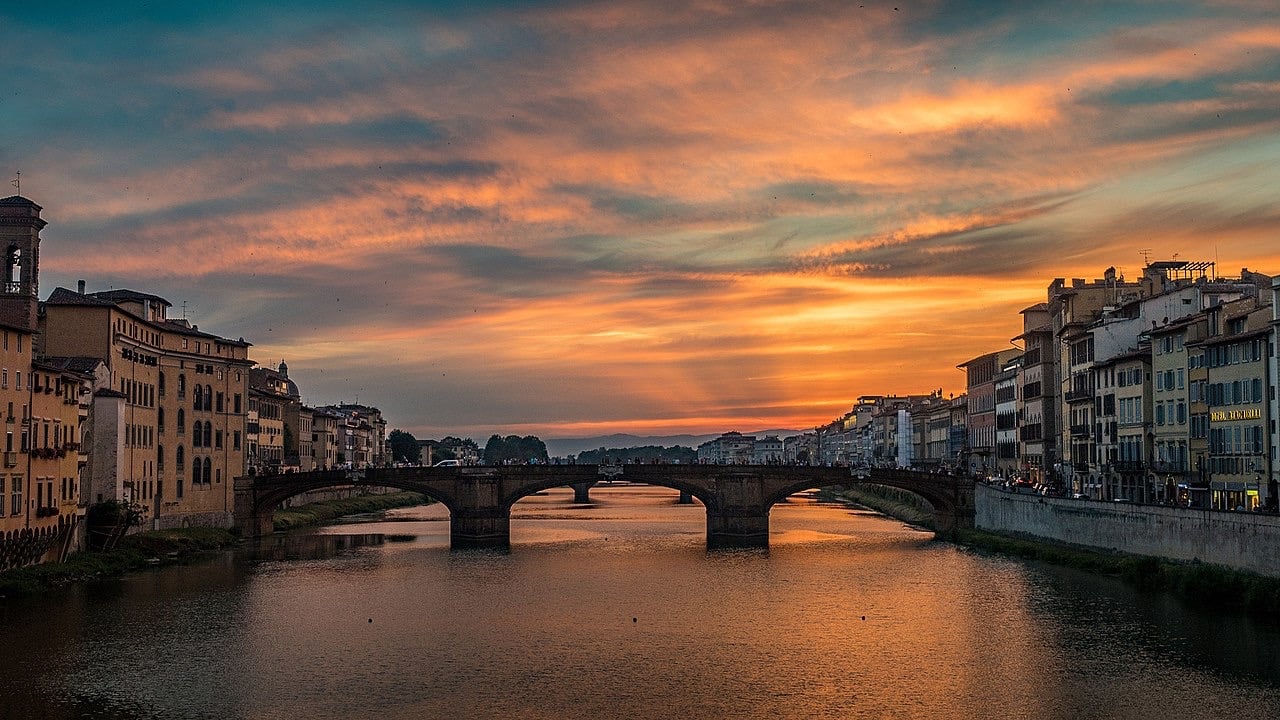
10. Travel Back in Time to Florence
The birthplace of the Italian Renaissance, Florence, once one of Europe’s wealthiest places. Arguably one of the most beautiful Italian cities and one of the most unique ones. Taking a stroll through the city, you’ll feel that you are walking through a museum. Coming across Duomo di Firenze, a famous gothic building from the 13th century with incredible mosaics and frescoes, and Piazza Della Signora, you will feel that someone put you in history books.
Visiting Accademia Gallery, the home of Michelangelo’s statue of David, but also loads of different artwork by Michelangelo, Leonardo, and many more Italian artists is a thing that should be on your must-do list. Apart from that, you shouldn’t miss out on one of the most famous landmarks of Florence and Italy in general, the famous Ponte Vecchio, the medieval stone bridge across the Arno River. Boboli Gardens and Palazzo Pitti confirm just how much variety you can see here as it fully matches expectations.
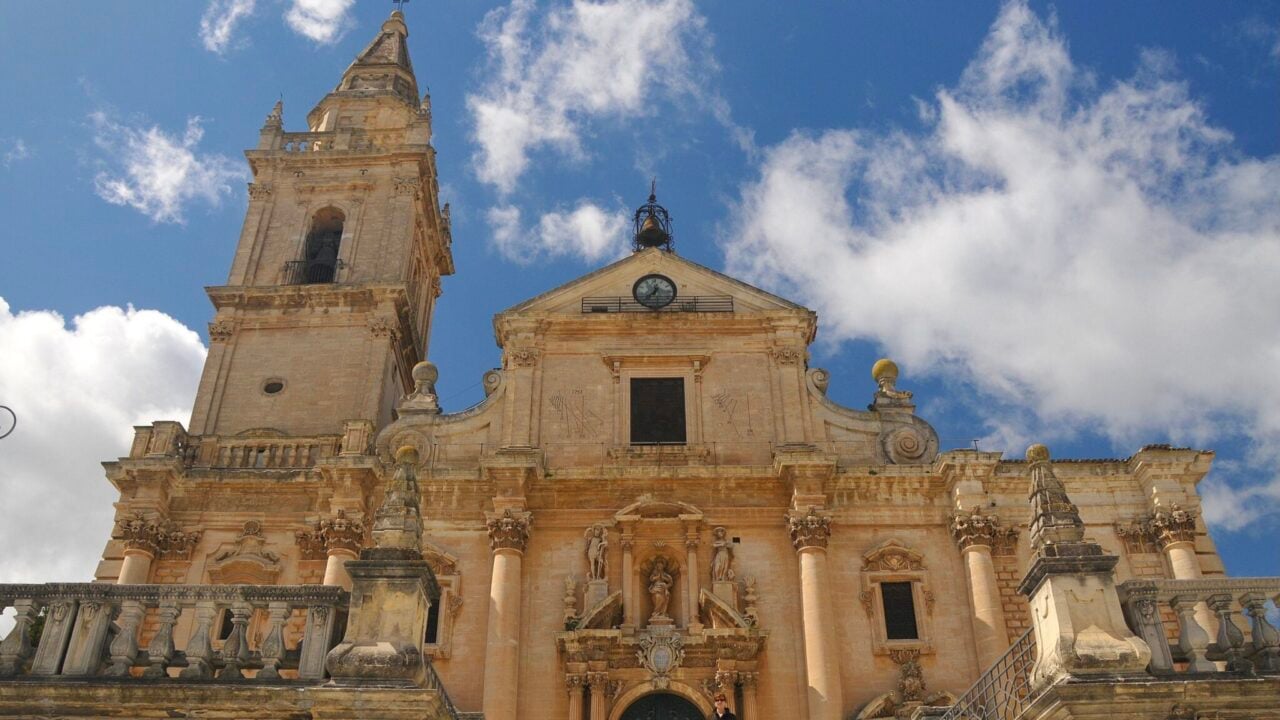
11. Blend in With High Class in Turin
The country’s most important business and cultural center is slightly different compared to the others but in a positive way. The capital of northern Italy is the country’s wealthiest and most organized city. It offers a feeling of a modern European city and a strong historical background. Like the rest of Italy, Turin is filled with beautiful squares like Piazza San Carlo, cathedrals like Cattedrale di San Giovanni Battista, churches, and museums. This former capital of Italy is associated with the Italian royal family.
Apart from that, there is one thing this city is also recognized for, and that is the car industry. We highly recommend you check out “Museo Dell Automobili.” Here, you will see a collection of over 200 cars from 80 different brands, from modern-day cars to steam cars. It’s a very rare collection of vehicles you won’t see in many places.
More from Wealth of Geeks
- 15 Books You Should Read Before Visiting Europe
- The Best Things to Do in Stockholm

Read More From Wealth of Geeks
- Best Countries To Live In Across the World
12 Record-Breaking Roller Coasters Across the Globe
More for You
Brett Kavanaugh's Questioning of January 6 Charges Sparks Fury
TikTok star Kyle Marisa Roth dies at 36
'American Idol' recap: First platinum ticket singer sent home during Top 14 reveal
This type of supplement may increase heart disease risk, new study finds
A Closer Look at Nike's Olympic Uniforms for Track and Field Paris 2024 Games, Photos
The 16 worst-paying college majors, five years after graduation
What Is the Most Poisonous Spider in the World?
Eerie footage inside sunken passenger plane mistaken for missing MH370
Sprinkle This On Your Lawn Soil To Keep Ticks At Bay
29 Ridiculous Lies That Hollywood Has Managed to Mainstream
You Should Buy Stamps Now Before USPS Increases Its Prices. What to Know
Stop thinking your expensive watch is an investment, says Rolex boss
Copenhagen fights the last pockets of a fire that destroyed a 400-year-old landmark
New packaging guidelines for melatonin proposed after spike in ER visits among children
Coast Guard evacuates U.S. passenger from Disney cruise ship 180 miles northwest of Puerto Rico
How to Get Rid of Snakes
Gavin Newsom Has a California Parent Problem
50 classic slang terms only people born before 2000 will get
Major Steakhouse Chain Closes 41 Locations
Frescoes buried by volcano uncovered in ancient dining room in Pompeii
To Duke Alumni homepage
Northern italy, from the alps to the adriatic.
View other trips

Date: Sat, May 3, 2025 - Sat, May 17, 2025
Trip Status: Waiting for the brochure
Price: From $6,174, per person including air
Activity Level: Moderate
Region: Europe
Arrangements: Odysseys Unlimited
This leisurely 15-day exploration of Italy’s varied northern regions offers your small group a refreshing perspective on a well-known land. Experience the Lake District with a relaxing three-night stay on Lake Maggiore, visiting charming Orta San Giulio and cruising to the beautiful island of Isola Bella. Sample the “king of wines” at a Barolo winery. A three-night sojourn in an Italian Riviera town, Santa Margherita, follows, with a boat trip to renowned Portofino and an excursion to the spectacular Cinque Terre. Journeying to beloved Tuscany, stop in atmospheric Lucca then explore wondrous Florence, Tuscany’s crown jewel, during a three-night stay. Discover exquisite Siena and storied Verona and spend two nights in Bolzano, gateway to the magnificent Dolomites. Two nights in treasured Venice, with touring of iconic St. Mark’s Square and independent exploration, conclude the journey. Savor more time in this most beautiful of cities with an optional 3-day/2-night post-tour extension.
Reservations and Information
To reserve, complete a registration form in the brochure and mail to Duke Travels, Box 90572, Durham, NC 27708, or call (919) 684-2988 to reserve conveniently over the phone and let us know you are mailing your reservation form to hold your space. To learn more about our travel program or any of our upcoming trips, please contact us at [email protected] or 919-684-2988
Duke Leaders

Mode of Travel
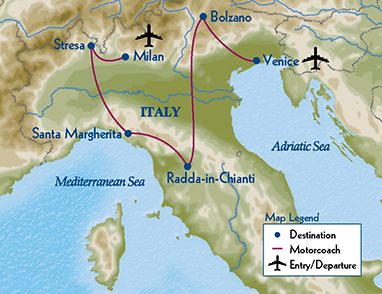
Money latest: Tourist tax warning - here are 10 cities in Europe where you'll need to pay
The latest official data on inflation has been released - read all the reaction and analysis on what the numbers could mean for interest rates in the Money blog. Listen to the latest Sky News Daily podcast about inflation as you scroll.
Wednesday 17 April 2024 21:14, UK
- Inflation falls to lowest level since 2021 - but less than predicted
- Ian King analysis: Why an interest rate cut may not come as soon as you think
- Basically... What is inflation - and how can it affect interest rates?
- Spending calculator: Use our tool to see which prices have gone up or down
- Tourist tax warning - here are 10 cities where you'll need to pay
Essential reads
- Spotlight on unpaid carers: 'I feel isolated, lonely and guilty': Daughter caring for mother with motor neurone disease alone
- How to improve your credit score
- Most expensive street in London revealed
- Money Problem: My boss ruined end of maternity leave with ultimatum - what are my rights?
The day began with the release of the latest inflation figures by the Office for National Statistics at 7am.
Inflation fell to 3.2%, though economists had predicted it would ease further, to 3.1%.
We've dug into the ONS data, which shows that food prices were among the biggest drivers of the inflation drop in March.
This chart, updated with figures released today, shows food and non-alcoholic drinks fell by 0.11 percentage points last month.
"Once again, food prices were the main reason for the fall, with prices rising by less than we saw a year ago," Grant Fitzner, chief economist at the ONS, said.
This helped bring inflation to its lowest rate for two-and-a-half years.
Other big downwards drivers included furniture and household goods, and clothing and footwear.
At the other end of the scale, the largest upward contributions came from communication and transport.
By Mickey Carroll , science and technology reporter
"I had just woken up and I got an email that said, 'We're going to have a company-wide meeting'. I knew right away."
James (not his real name) was visiting his family earlier this year when he saw the message.
"I started thinking about everything I was set to lose."
He had worked as a game designer at one of the UK's biggest video game studios for nearly a decade. It was a job he loved and had dreamt of since he was nine years old. But recently he had been worried.
All around him, friends in the gaming industry were being let go.
"My mind was racing, what could I do? I wasn't going to be the only one job-seeking at the moment because there were so many layoffs. They all happened at the same time."
He went to the meeting, where his worst fears were confirmed. The company's chief executive said around 25% of people at the studio would be cut. James was one of them.
Gaming is an anxious world right now. There's been more than 8,000 jobs cut globally since the start of this year and in March, the number of available jobs in the UK hit a record low, according to the report Games Jobs Live.
But in London, as the BAFTA Games Awards 2024 rolled around last week, gamers could just enjoy themselves.
Read the full story here ...
B&M has said it will open at least 45 stores across the UK in the next year.
It comes after the discount chain recorded a 10.1% revenue increase in its 2023/24 financial year, with its UK arm seeing sales rise by 8.5% to £4.4bn.
The company currently trades from 741 stores in the UK under the B&M brand, 335 stores under the Heron Foods and B&M Express brands, and from 124 stores in France.
Chief executive Alex Russo said the group's "relentless focus on everyday low prices, great product ranges and excellence in operational standards" had chimed with customers.
Miss getting a Tango Ice Blast at the cinema? Well, its creator has announced it's releasing limited edition drinks in their iconic flavours.
The fizzy frozen treat has slowly been disappearing from cinemas since 2019 when Cineworld stopped selling it, and opted to replace it with the Icee product created by Vimto.
Fans have been disappointed by the decision since then and it seems its owner Britvic has finally produced a drink to satiate their taste buds.
The drinks company has unveiled its new Tango Raspberry Blast and Cherry Blast drinks, which will be sold exclusively in convenience stores.
The on-the-go, vegan friendly soft drink will be available from 22 April.
"Tango's latest launch will look to engage Gen Z shoppers with its bold flavours, striking colours and eye-catching packaging," Britvic said.
"We expect the launch to appeal to fans of the brand who have come to expect something bold and different from Tango, while attracting new shoppers too."
Some drivers are being charged nearly 40% APR when paying for their car insurance monthly, according to Which?.
The consumer champion asked 39 car insurers what APRs were being applied to monthly payments and, while many didn't respond, it found several that were charging similar interest rates to credit cards.
Among those that did respond, Which? found that 1st Central charges between 5% and 39.11%.
It gives customers a personal interest rate after a credit risk assessment, Which? said.
1st Central said: "We understand it is important to customers that we keep the price of insurance as low as possible - and benchmarking tells us that we are competitive for both annual premiums and for those that wish to pay monthly through a credit arrangement.
"We offer a range of APRs from 5% to enable us to provide credit to as many customers wishing to pay monthly as possible, including those with low or poor credit scores. Over the past quarter less than 2% of customers paid our highest APR."
The average rate offered by insurers was found to be 23.37%.
Only two car insurers asked - NFU Mutual and Hiscox - said they do not charge interest on monthly repayments.
What about home insurance?
Which? also looked into the rates being charged on home insurance and found some insurers were charging nearly 35% APR on monthly payments.
The highest rate in the study was from Co-op Insurance, which charges between 31.31% to 34.75% APR on monthly payments.
The average across the providers that charge a rate and disclosed it was 23%.
Co-op Insurance works with partners to provide insurance cover - and it said it is looking to reduce rates where possible. It added that it chose to share its rates with Which? as it is committed to transparency.
Fifteen home insurance providers surveyed said they do not charge interest: Bank of Scotland, Halifax, Hiscox, HSBC, Lloyds Bank, MBNA, M&S Bank, Nationwide Building Society, NFU Mutual, SAGIC, Sainsbury's Bank, Santander, TSB, Urban Jungle and Yorkshire Building Society.
Nearly one in five first-time buyers are now in their 40s, data from Santander has shown.
Around 6,000 agreement in principles were completed for people aged 40-49 by Santander in 2024 alone, its homeownership report found.
The oldest person to get their foot on the property ladder was 67 - nearly double the average first time buyer age of 36.
Graham Sellar, head of business development, mortgages at Santander, said there were a number of reasons more people were opting to rent or live with their families until later in life.
"At Santander, we know it can be challenging to save for a deposit and get onto the property ladder, especially for those also juggling rental payments," he said.
"However, we are here to help our customers in whatever ways we can - at whatever stage of life."
Every Wednesday we get Michelin chefs, top bloggers or critics to pick their favourite cheap eats where they live and at home.
This week we've got the popular food blogger Pam Gilmour, better known as Glasgowfoodgeek, who has more than 57,000 followers on Instagram.
Can you tell us your favourite places in Glasgow where you can get a meal for two for less than £40?
Ramen Dayo - if you're looking for cheap but delicious eats, you can't go wrong with a filling ramen, and Ramen Dayo is the best in the city.
Owner Paul lived in Japan for years, so he knows great ramen.
With massive bowls of soup coming in at around £13 I know I'm going to leave stuffed but so happy.
La Pastina - no one stuffs a sub like La Pastina, which makes sandwiches so big that you can keep half for dinner.
Packed with layers of cold cuts and toppings, this Italian sandwich shop is a great stop if you're looking for a to-go lunch.
The Bordain is a masterpiece, and definitely buy one of their made-in-house cakes.
El Perro Negro - if you're looking for the best burger in Glasgow you won't go far wrong visiting award-winning El Perro Negro, where you can enjoy a classic burger and side of fries for just £13.
The flavour and quality will absolutely blow your socks off. My favourite is the signature juicy Top Dog burger.
Read all our Cheap Eats recommendations around the UK here ...
Some Scottish Power customers are set to receive refunds and compensation payments after the energy firm was found to have overcharged them at the height of the energy crisis.
The energy firm charged 1,699 direct debit customers a higher rate between 2015 and 2023 - across 11 price cap periods.
The rate should only have applied to those who pay by standard credit, or on receiving a bill.
On average, each customer paid an extra £149 more than they should have.
Energy regulator Ofgem said Scottish Power was paying a total of £250,000 in direct refunds to affected customers as well as another £250,000 in goodwill payments.
This equates to an average of £294 per customer, and all payments will be made automatically.
Ofgem said Scottish Power reported itself to the regulator last summer, when it discovered that operational errors had led to the mistake.
Scottish Power has also agreed to pay £1m to Ofgem's Energy Industry Voluntary Redress Fund, which benefits charities and community projects that help vulnerable customers with energy-related support.
Travellers have been warned trips abroad will cost more this year as cities across Europe increase tourist taxes.
Tourism taxes range anywhere between less than €1 to almost €15 and can be charged per person per night.
People looking to book a trip abroad are being encouraged to incorporate additional costs into their holiday budget to avoid being left out of pocket.
Travel insurance expert Tiffany Mealiff said the fees allow cities to fund measures to attract more visitors, support local infrastructure and prevent problems caused by overtourism.
"If you’re taking a trip to any city in Europe this year, you must be aware of the potential additional costs to your holiday – which are often not obvious beforehand and normally due for payment when you check out of your accommodation," Ms Mealiff, from Quotezone.co.uk, said.
Here are some of the charges in popular European destinations:
Tourists visiting Venice for the day will have to pay a €5 (£4.27) entry fee to enter the city between the hours of 8.30am and 4.00pm. The scheme is currently going through a trial period, but it is expected to come fully into force in next year.
Manchester
The city introduced a £1 per room per night tourist tax across 73 hotels to fund improvement measures to attract more tourists.
A recent increase to the existing tourist fee means visitors now pay €3.25 (£2.78), up from €2.75 (£2.35), to stay in some accommodation.
The Portuguese capital enforces a €2 (£1.71) per person fee for every night tourists stay but it is only applied for a maximum of seven nights.
Tourist tax in Athens varies depending on the hotel category and the time of year, ranging anywhere from €0.50 (43p) - €10 (£8.54) per room per night.
Visitors to Dubrovnik must pay €2.65 (£2.26) per person per night throughout April to September. The Croatian government has temporarily reduced this fee to €1.86 (£1.59) for the rest of this year.
France charges visitors a tourist tax, which varies depending on the type of accommodation. The most expensive charge is €14.95 (£12.77). Those staying in a typical four-star hotel are charged around €8 (£6.83).
For visitors to Prague, tourist tax has increased from 21 to 50 CZK each day (71p - £1.69).
Tourists staying in Budapest are charged an additional 4% each night, which is calculated based on the price of the room.
Tourists must now pay 5% of the room price, excluding VAT and service fees.
Prices in March were 3.2% higher than prices at the same time last year, putting pressure on already stretched household budgets.
This figure, the lowest since 2021, is inching closer to the Bank of England's 2% target.
Food prices rising by less than they did last year was the biggest driver of March's overall inflation rate fall. That was partly offset by fuel prices rising this year when they were falling in March 2023.
A fall in inflation doesn't mean prices are coming down, but that they're rising less quickly.
Use our calculator to see how much your groceries, clothing and leisure activities have increased in cost.
Be the first to get Breaking News
Install the Sky News app for free

- Weird But True
- Sex & Relationships
- Viral Trends
- Human Interest
- Fashion & Beauty
- Food & Drink
trending now in Lifestyle

I'm 61 but have the body of a 38-year-old — here's how I...

I can't stop having sex with my friends' wives — cuckolding...

My husband's groomsman gave us the most disgusting wedding gift...

Brazilian woman brazenly wheels elderly man's corpse into bank to...

Popular snacks could be banned in certain states over cancer fears

Ozempic use appears to be changing people's personalities...

Lack of sleep could be a factor in a 'silent epidemic,' shares...

I’m a dietitian — here’s the secret to intermittent fasting
This restaurant gives a free bottle of wine — but you have to give up your phone.
- View Author Archive
- Email the Author
- Follow on Twitter
- Get author RSS feed
Contact The Author
Thanks for contacting us. We've received your submission.
Thanks for contacting us. We've received your submission.
Parting ways with your cellphone actually pays off at this restaurant in Italy .
Al Condominio, which opened in the northern city of Verona in March, offers a free bottle of wine to customers who hand in their phones before meals.
@leca.ursachi Al condominio 📍Verona, Italia. The restaurant where they offer you a wine bottle if you don’t use your phone. #restaurant #wine #italia #italy #verona #alcondominio #techfree ♬ original sound – Dexter Carr
“We wanted to open a restaurant that was different from the others,” owner Angelo Lella told the Guardian on Monday. “So we picked this format — customers can choose to renounce technology while enjoying a convivial moment together.”
He added: “Technology is becoming a problem — there is no need to look at your phone every five seconds, but for many people it is like a drug … This way they have an opportunity to put it aside and drink some good wine.”

Upon arrival, diners can place their phones in a box, under lock and key, at the entrance.
To claim their free bottle of wine, all they have to do is show the key to the waiter.
That’s not the only perk customers can get for locking up their mobile devices.
They can also choose to review their meal, leaving the missive in the same box their phone was in.
The person who writes the most glowing review, singing the highest praises, will be offered a free meal during their next visit.

“The response has been very positive. Ninety percent of customers have opted to leave aside their phones in exchange for wine,” Lella shared.
“It really is a beautiful thing to see people embracing it,” he continued. They are talking to each other rather than looking at photos or responding to messages on their phone.”
The Guardian reports that another restaurant in Italy, Separè 1968, offers vouchers to diners who relinquish their phones.
Share this article:

Advertisement

COMMENTS
7. Bologna. Kyle Kroeger / ViaTravelers. One of the largest and the best places to visit in Northern Italy, Bologna is the capital of the Emilia Romagna region. It is popular for its strong economic presence in the financial industry. Bologna is known as the city of towers with several historical high-rise structures.
It's easily one of the best cities in northern Italy to visit. Bellagio is the most popular town on Lake Como and is nicknamed the "Pearl of the Lake.". It's also the area that the famous Las Vegas resort was designed after. To get to Lake Como, first take a train from Milan to Varenna, another lakeside town.
Let's have a look at the best places to visit in Northern Italy: 1. Milan. Source: Boris Stroujko / shutterstock. Milan. Milan is one of the largest cities in Italy and is renowned for its culture, history, economy and also its plethora of high-end designer shopping outlets.
Tip #2 - Take Advantage Of Free Attractions In Big Cities. Sforzesco Castle in Milan. Northern Italy is one of the most expensive regions in Italy and one of the most expensive places to backpack in Europe. The average travel cost is 70 € to 150 € per day depending on the season.
The Cinque Terre (Five Lands) — Riomaggiore, Vernazza, Manarola, Monterosso, and Corniglia — are a cluster of postcard-perfect coastal villages in Liguria. They are designated a UNESCO World Heritage site, and the region is one of the best places to visit in Northern Italy!
Encompassing Italy's wealthiest provinces, Northern Italy is a premier destination when it comes to luxury resorts and upscale shopping too. Whether sampling fine wine and dining on world-class cuisine or exploring ancient castles, cathedrals and churches, the region offers all the memorable travel experiences visitors want from a holiday in ...
Northern Italy is as topographically diverse as it is beautiful: spectacular mountain vistas in the Dolomites and the Alps, vast crystalline lakes, undulating, vineyard-covered hills, dramatic coastlines, enchanting historical cities and architecture. Get inspired with this introductory list of some of the most stunning locations in the region.
When it comes to exploring Italy, each of its regions offers something unique and captivating.In this comprehensive northern Italy itinerary guide, we'll cast a spotlight on the enchanting northern part of the country. Whether you're struggling to narrow down your travel options or starting from scratch in search of inspiration, this post is designed to help you craft the perfect itinerary ...
Cinque Terre, meaning "Five Lands," is a charming, must-see UNESCO destination located in Liguria's capital city, La Spezia, off the Mediterranean coast in Northern Italy. Listed north to south, these beautiful coastal towns are Monterosso al Mare, Vernazza, Corniglia, Manarola, and Riomaggiore.
Day 9 - Genoa. The final destination for this particular 10-day Northern Italy itinerary should end in the Ligurian capital of Genoa. This seaside city is absolutely beautiful and full of interesting things to do - in fact, plan to spend 2 days in Genoa to round out your trip to the north of Italy.
Nearest Airports: Verona Valerio Catullo Airport and Innsbruck Airport (Austria) Bolzano is a Great Day Trip from: Verona, Vicenza, Trento, and Rovereto. Further Information about Bolzano in Trentino/Alto Adige, Northern Italy: Runkelstein or Roncolo - The Castle With Two Names in Bolzano, Italy. 10.
When is the best time to visit Northern Italy? As a resident of northern Italy, I can share with certainty that the best time to visit is either June or September. In these two months you get the best weather, the very beginning or the tail end of the busy summer tourist season and, if you book ahead, you can get great deals on reservations for rental cars and accommodation.
If you enjoy visiting villas or are visiting northern Italy in the summer and love water activities, Lake Como is worth at least a two-day trip. 3. Venice. Venice is a beautiful city that's world-famous for its intricate networks of canals, gondola rides, and romantic ambiance. Venice's small canals.
Yet, you will find great pistes in Asiago and Monte Baldo in Veneto, Val Camonica and Val Trompia in Lombardy and many more Northern Italian destinations. 10. Northern Italy's Excellent Shopping. Northern Italy is a great place to visit if you like to shop.
01. Varenna. Varenna is a small, yet very picturesque destination on the famous Lake Como. It's also a great location to stay overnight if you want to catch the Bernina Express panoramic train from Tirano to St. Moritz in the morning. Since in my experience, Trenord Trains (the regional service in Northern Italy) often have delays, taking an ...
This Italy travel itinerary includes in a lot of variety. You'll visit two of Italy's best culinary regions, Emilia-Romagna and Piemonte; you'll marvel at Italy's most picturesque mountains in Trentino and Alto Adige; and you'll visit four lakes: Garda, Como, Orta, and Maggiore. You'll spend time in the quiet but very pretty city of ...
Pisa. Day 9. Cinque Terre - Genoa - Parma. Parma. Day 10. Milan. Milan. With the Northern Italy Highlights - 10 days itinerary you'll cross the most important highlights, cities and landmarks in the northern part of Italy. In the next part, you'll find step by step itineraries where we explain the best stops, famous landmarks, and ...
4548. Last Updated on 28th February 2024 by Sophie Nadeau. Here's a one week in Northern Italy Travel Itinerary you'll want to follow. Highlights include time in the beautiful cities of Bergamo and Turin, a visit to the most beautiful monastery in Europe and a glimpse of the most iconic cathedral in the world (seriously!)
This northern Italy itinerary makes for a classic European travel route, combining epic mountain scenery, shimmering lakes, and cities steeped in history, Having an excellent rail network, this part of Italy is also perfectly explored by train. Read on for my exact travel route and practical tips for travelling around Italy by rail.
photo credit - Together In Switzerland Trento - a medieval UNESCO world heritage site. South of the Dolomite Mountains in Northern Italy and a hop, skip and jump from Italy's more well-known landmark - Lake Garda, you will find Trento, which is in the district of Trentino.Trento's old-world charm makes this a must for an Italian hidden gem list.
The Best Small Towns and Hidden Places in Northern Italy. Michela Italy Tours 16. If you plan to visit Northern Italy and avoid the crowds, there are hundreds of lesser-known yet beautiful places worth adding to your itinerary. If you visit Italy for the first time, all your favourite cities like Rome, Florence, Milan, and Venice will surely be ...
Moltrasio, Lake Como. By Zoe from Together In Switzerland. For a beautiful hidden gem in Northern Italy, take your time near Lake Como to visit Moltrasio. Located on the western side of the lake, this commune is officially part of the Lombardy region of Italy, close to the border of Switzerland.. There are a few significant historical places in Moltrasio, such as the Church and Piazza San ...
Story by Aleksa Markovic. • 3mo. 1 / 14. Explore the Wonders of the Northern Italy ©Provided by Wealth of Geeks. When we think of Italy, most of us probably picture the Colosseum or the Amalfi ...
This leisurely 15-day exploration of Italy's varied northern regions offers your small group a refreshing perspective on a well-known land. Experience the Lake District with a relaxing three-night stay on Lake Maggiore, visiting charming Orta San Giulio and cruising to the beautiful island of Isola Bella. Sample the "king of wines" at a Barolo winery. A three-night sojourn in an Italian ...
Thanks for continuing to inspire all of us! Europe - Please review my itinerary for Northern Italy in May 2025 - Hello everyone! My husband and I are planning a month long trip to Northern Italy ...
France charges visitors a tourist tax, which varies depending on the type of accommodation. The most expensive charge is €14.95 (£12.77). Those staying in a typical four-star hotel are charged ...
Al Condominio, which opened in the northern city of Verona in March, offers a free bottle of wine to customers who hand in their phones before meals. TikTok/@leca.ursachi. 3. To claim their free ...